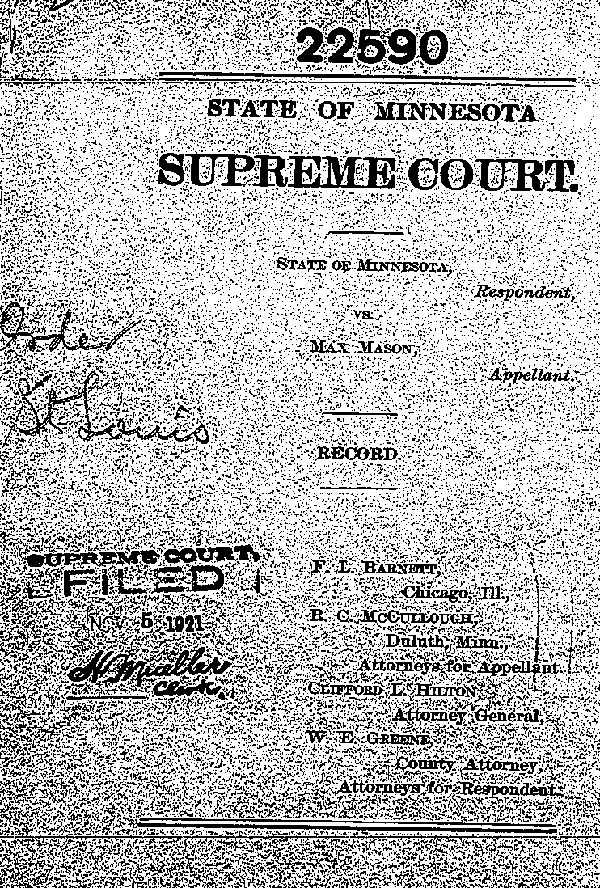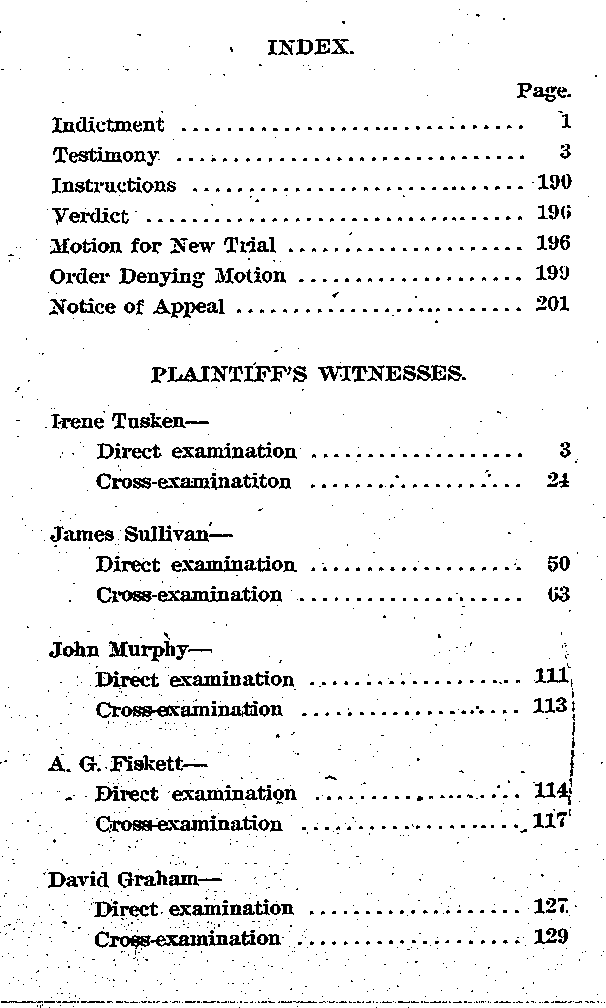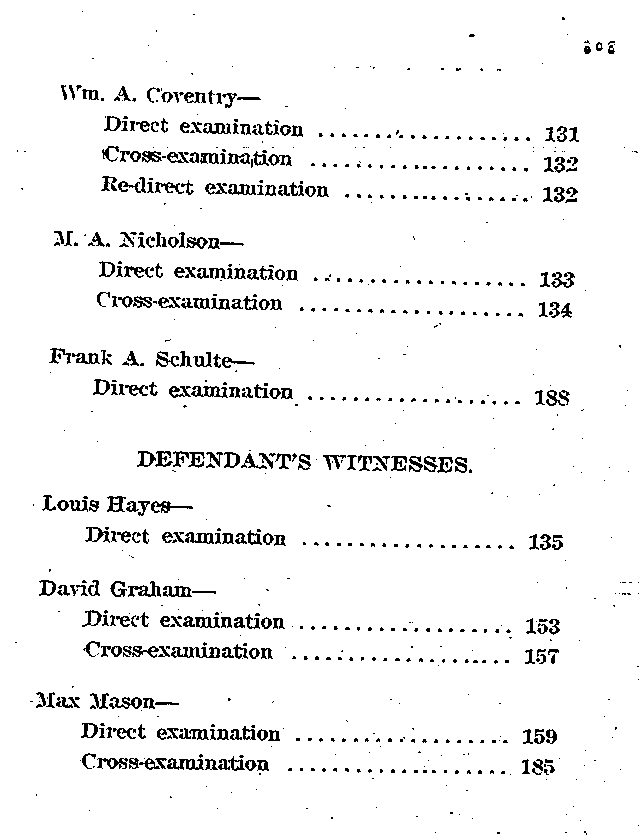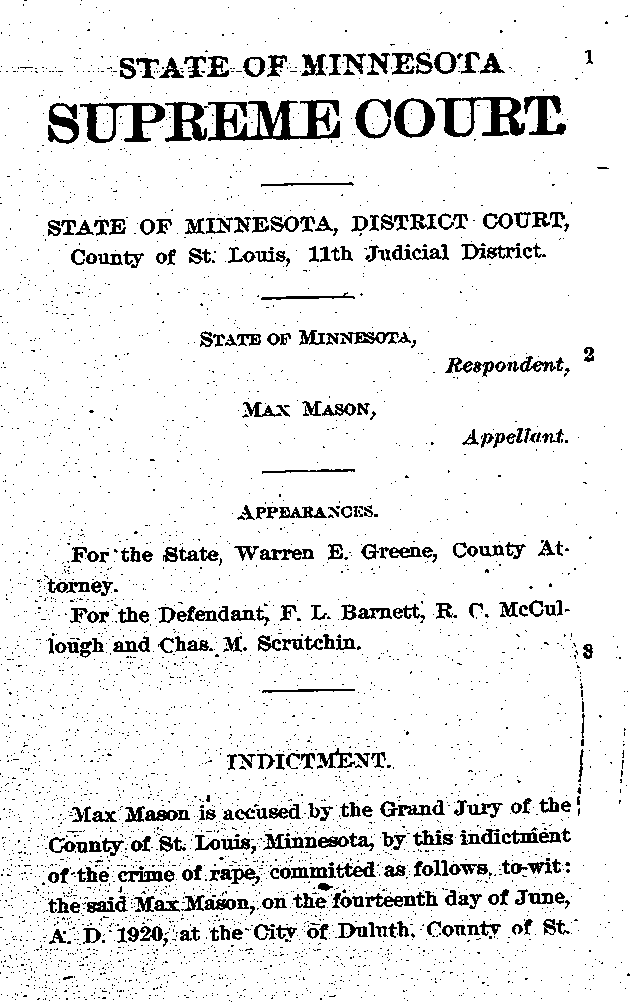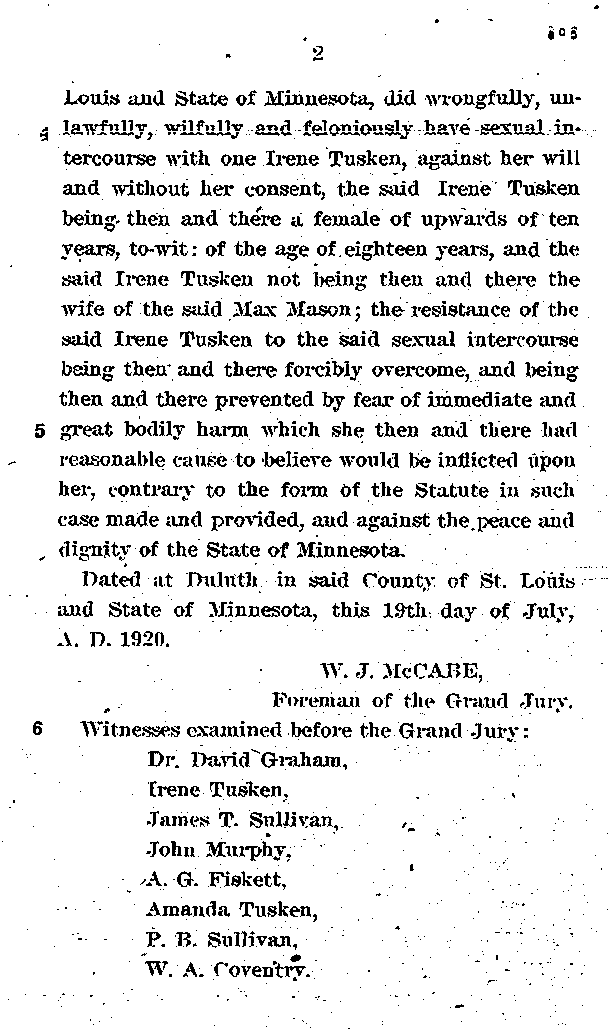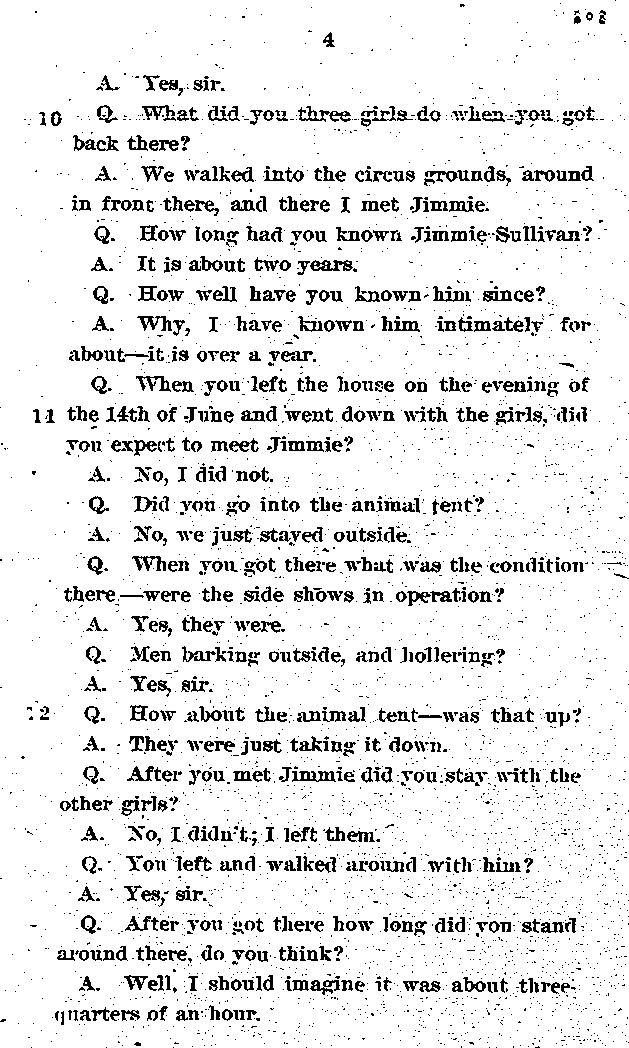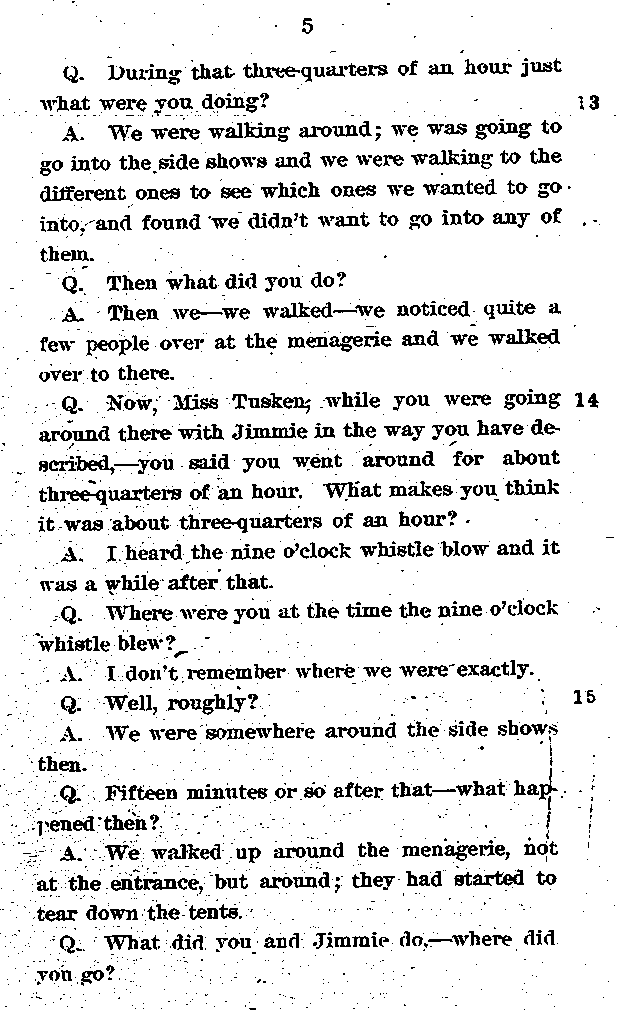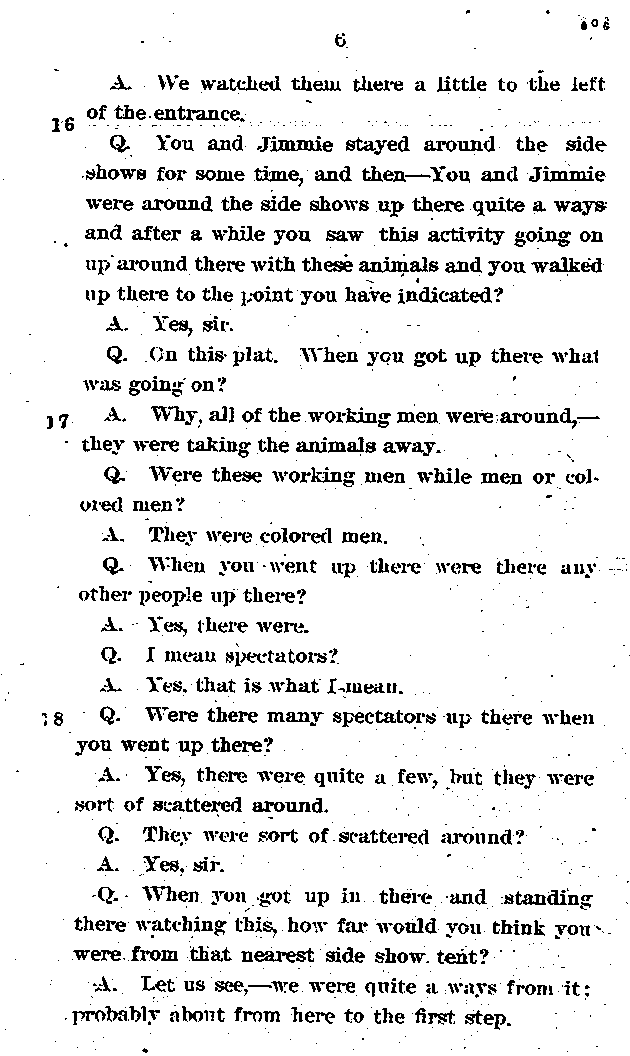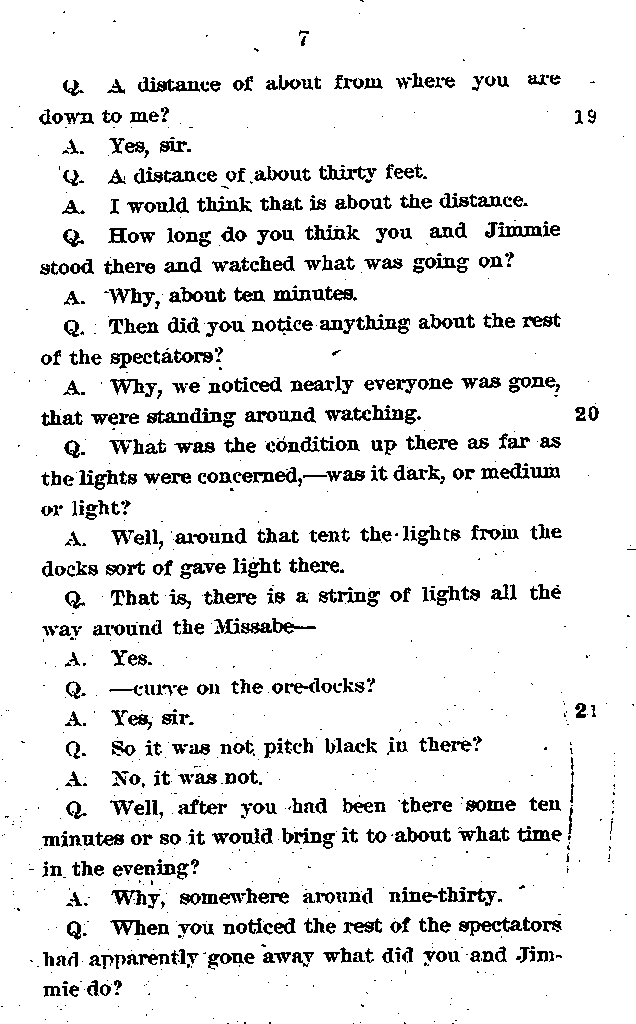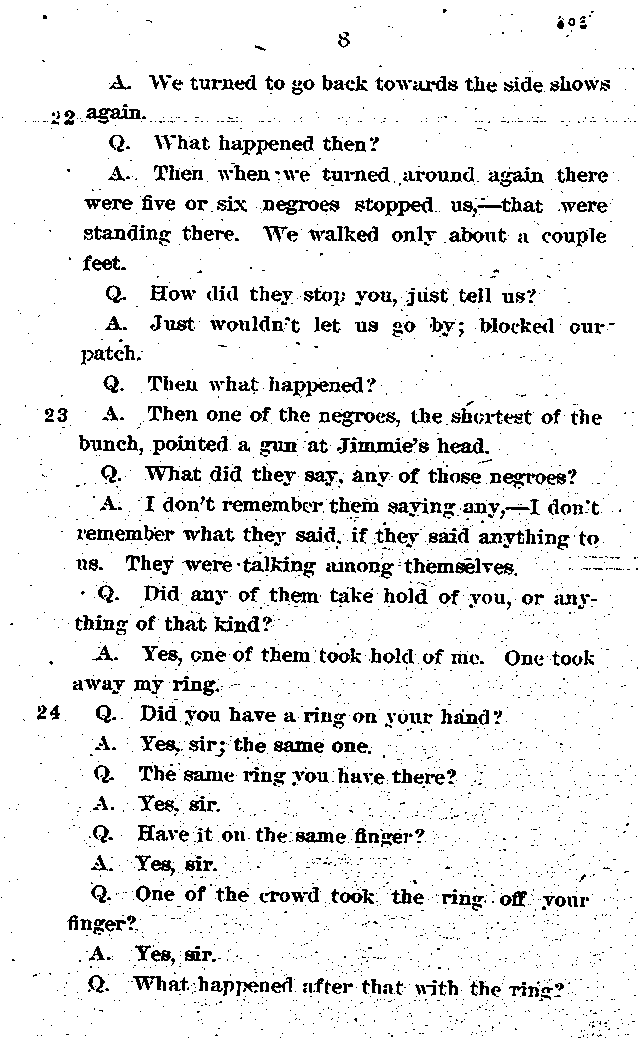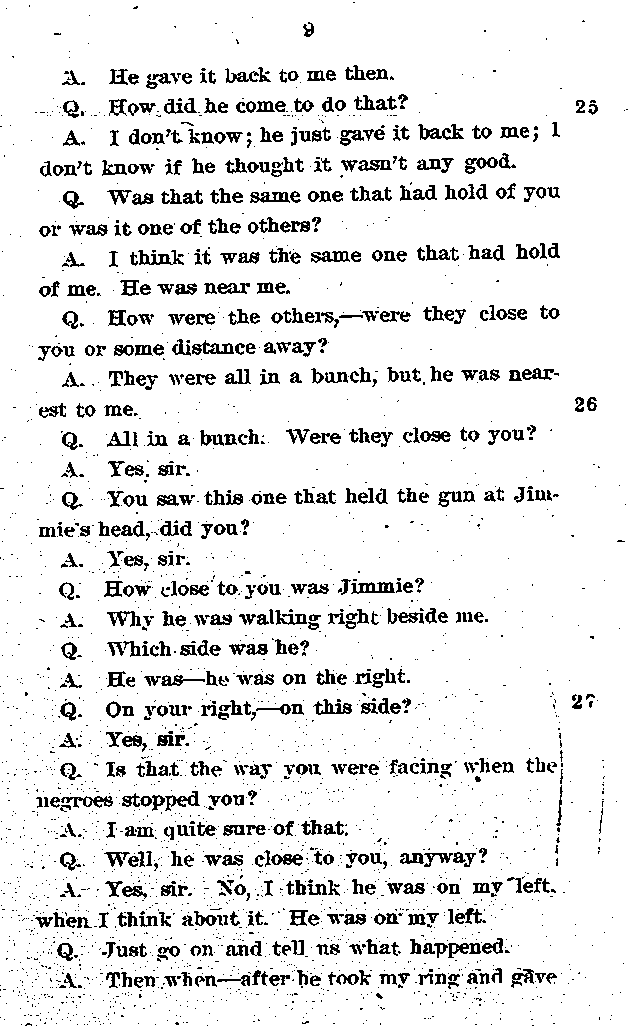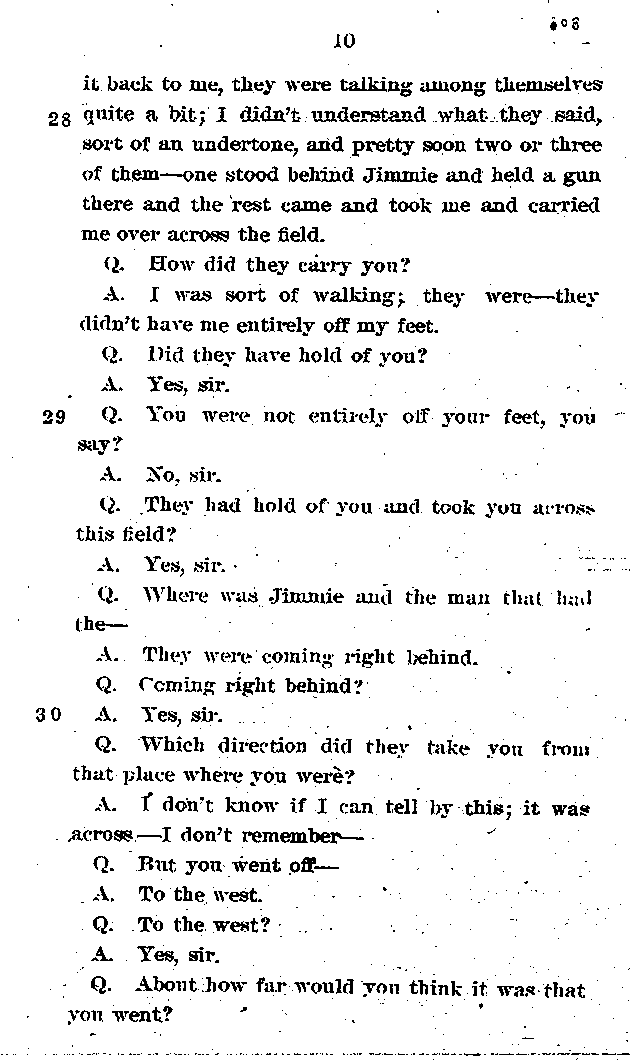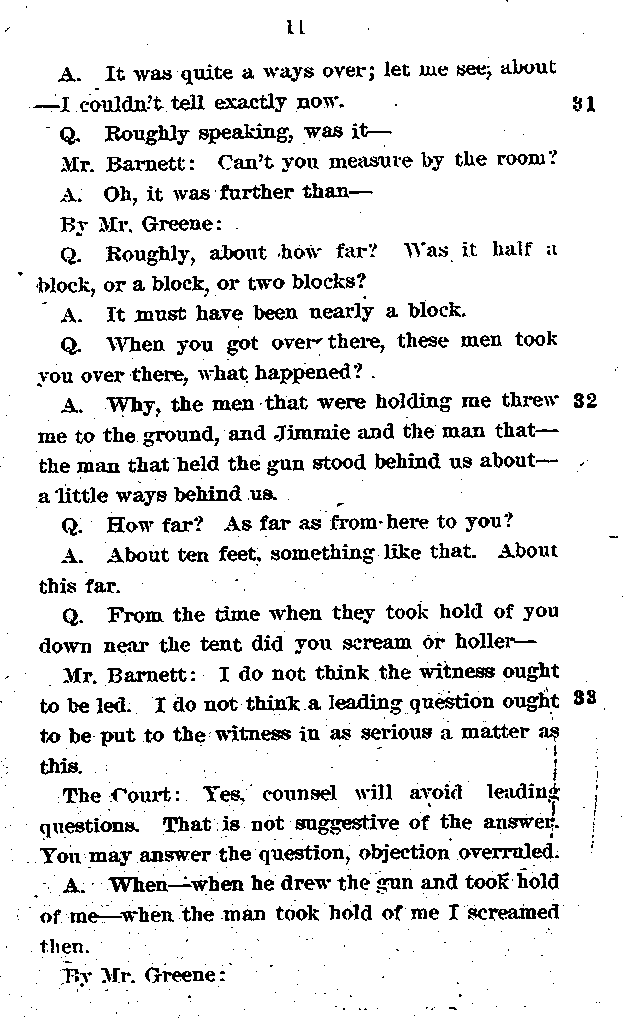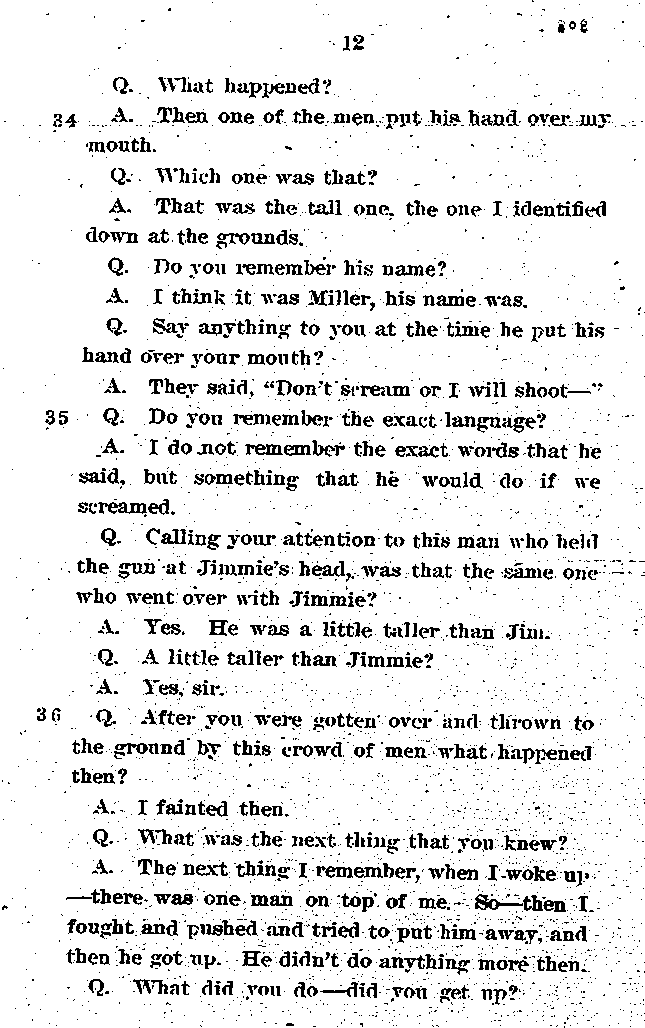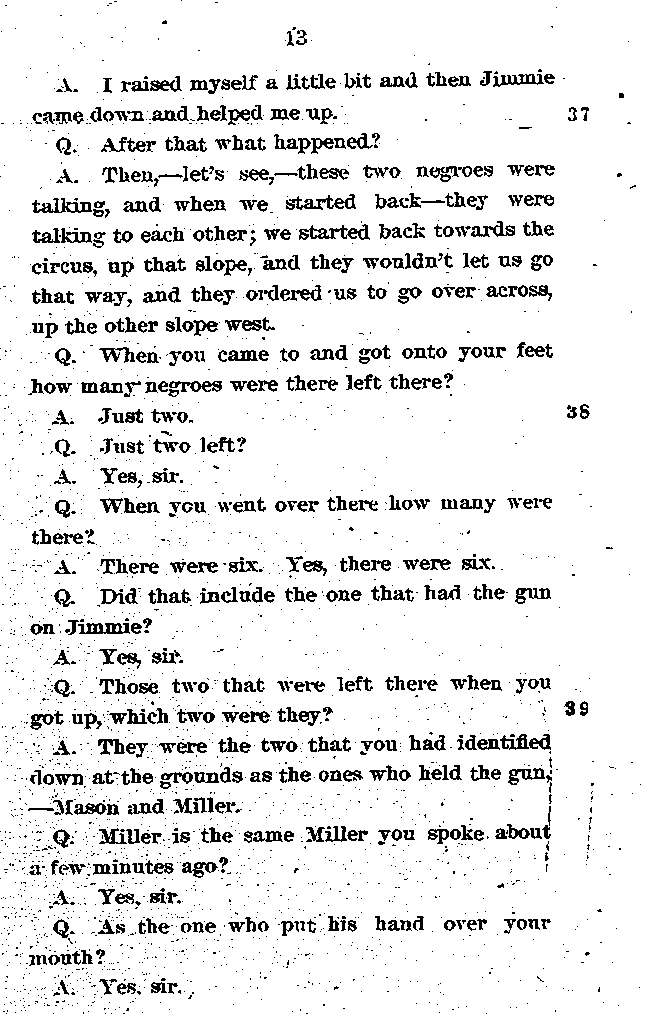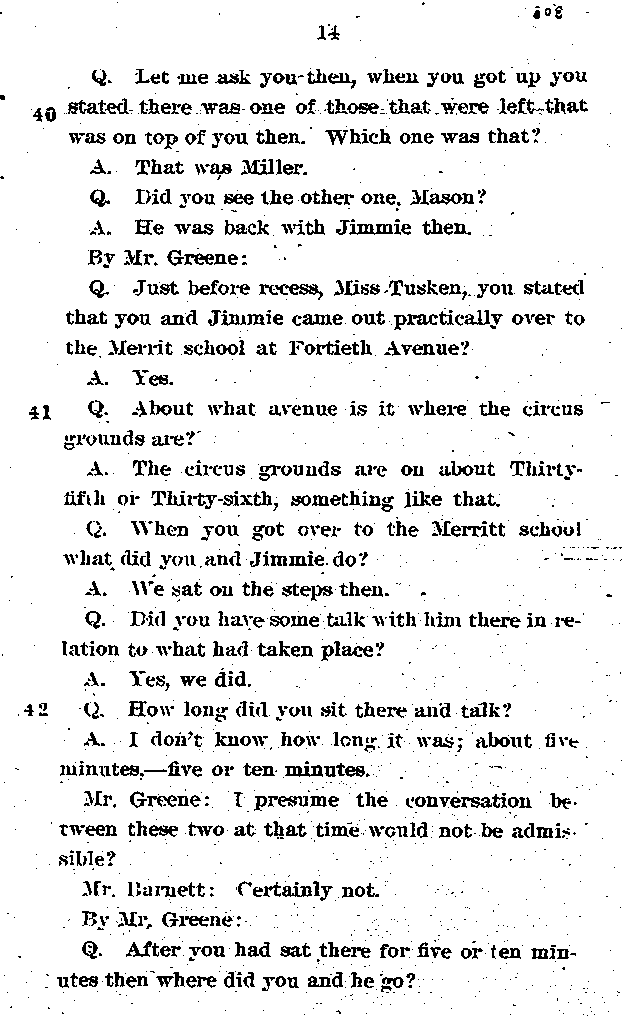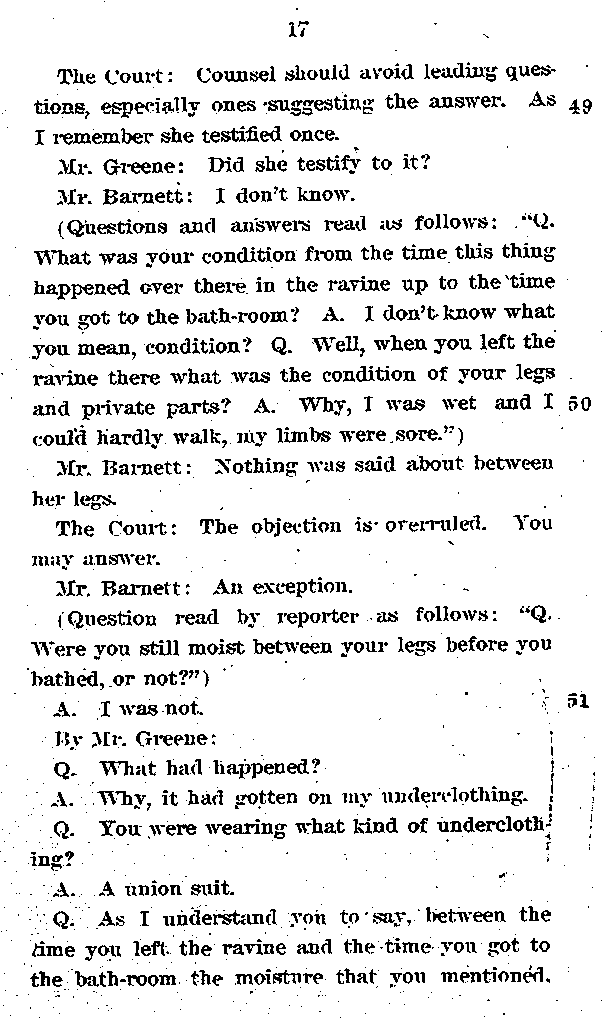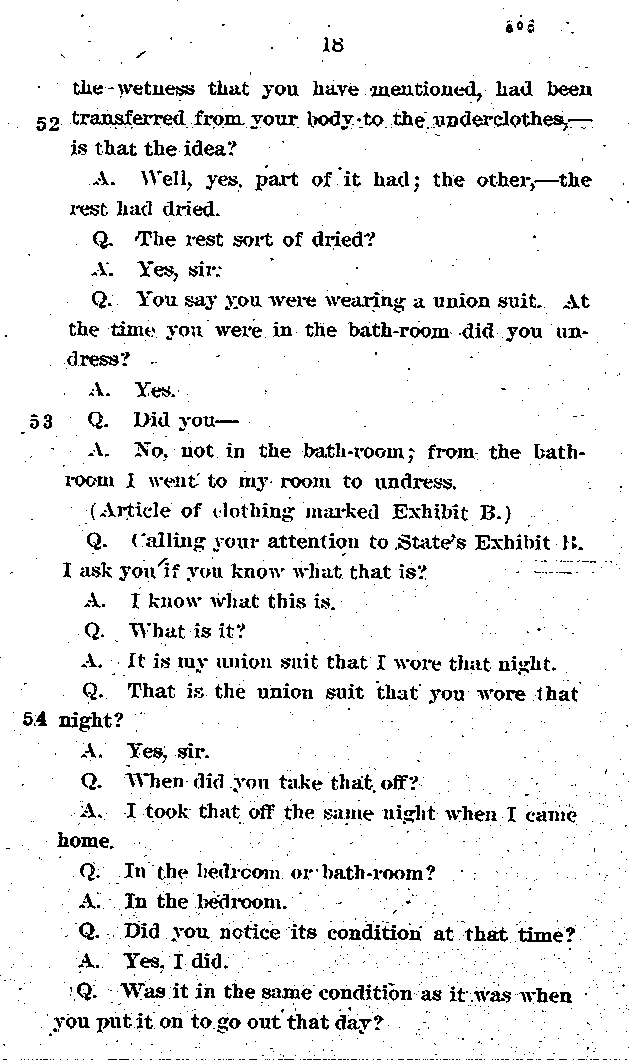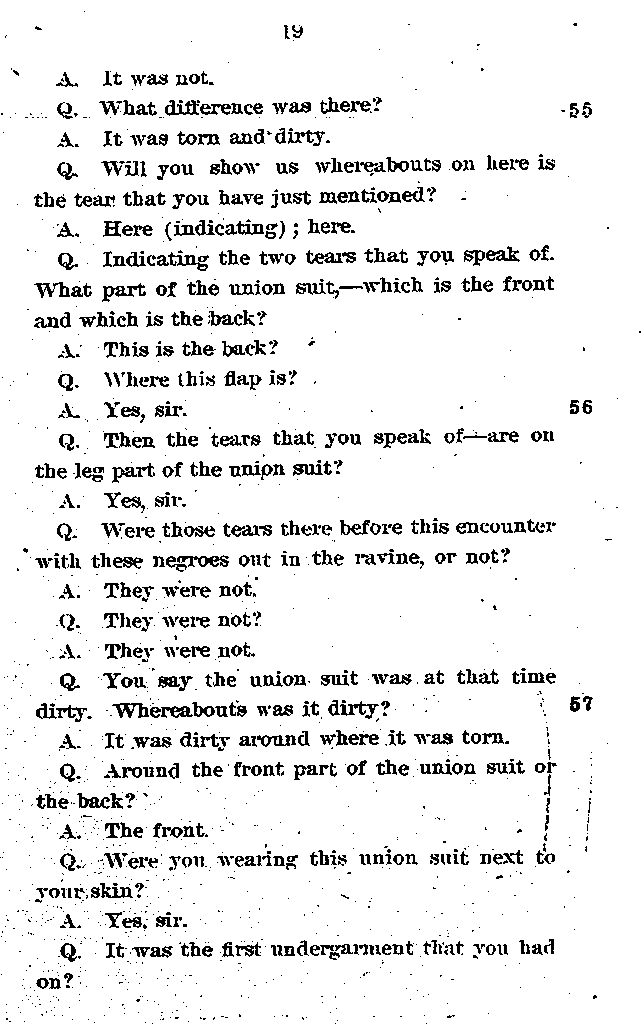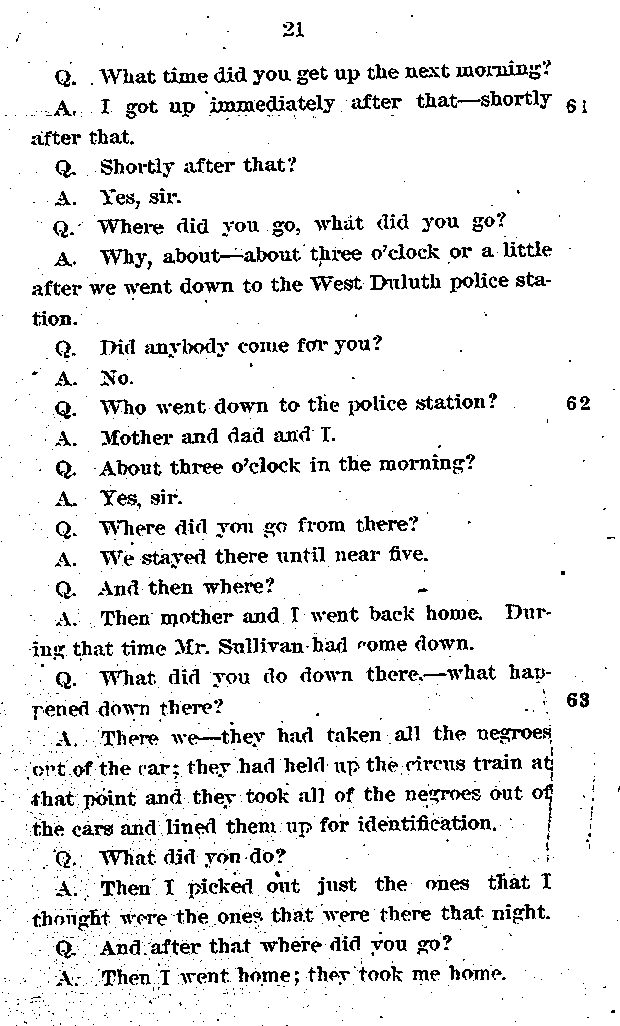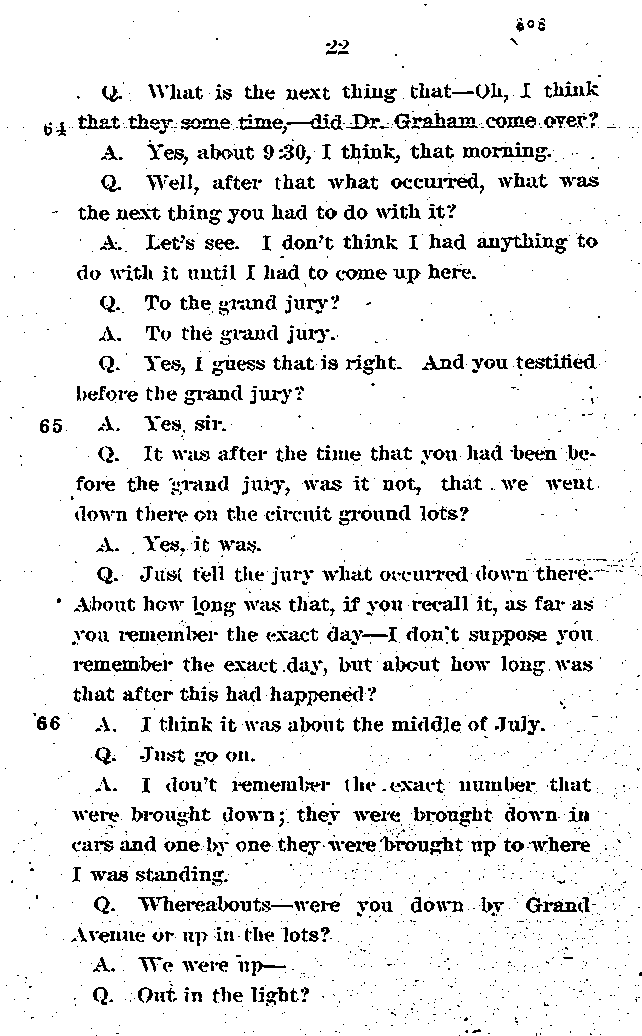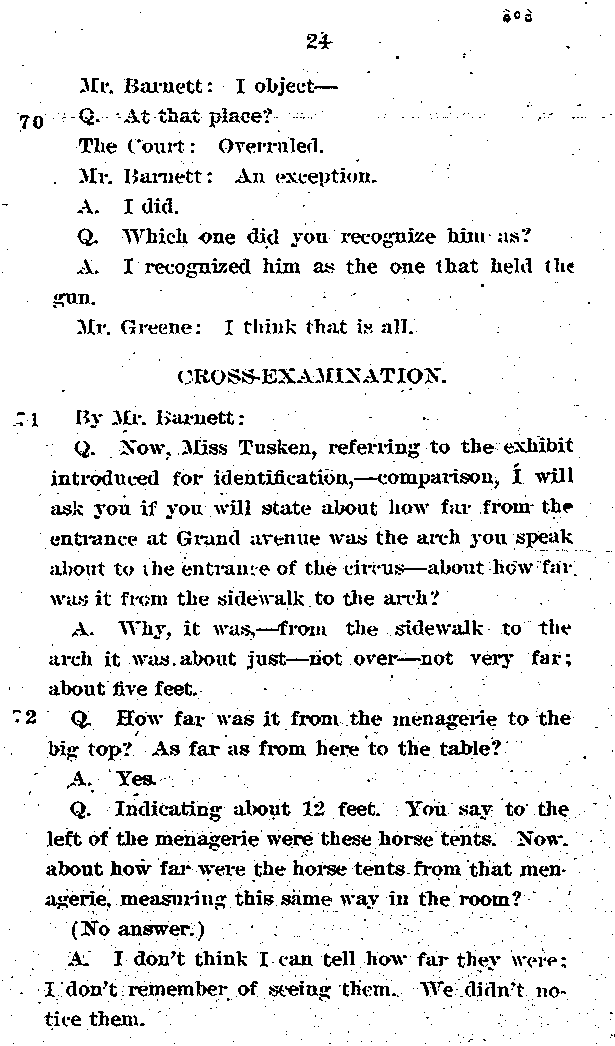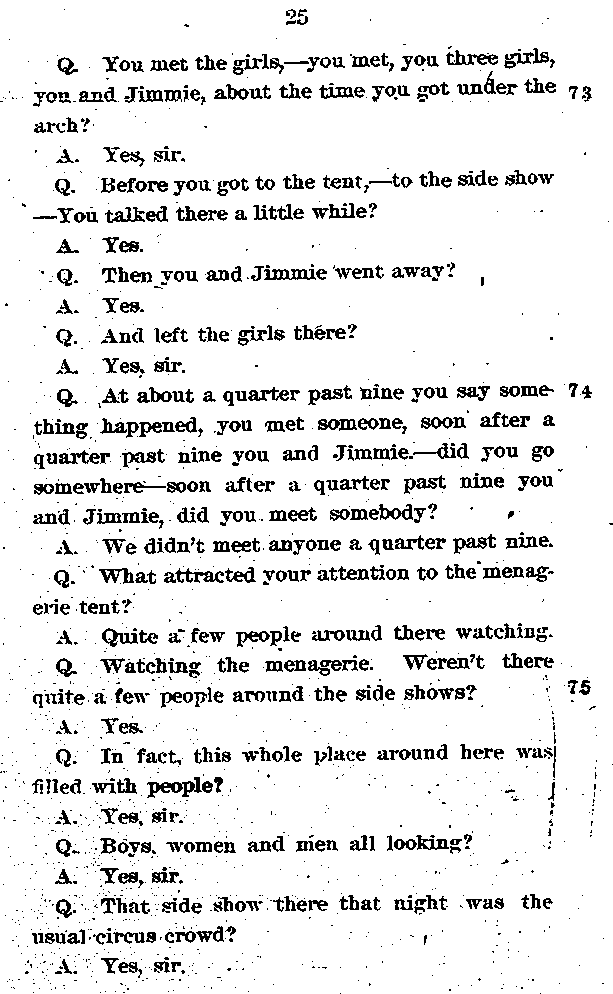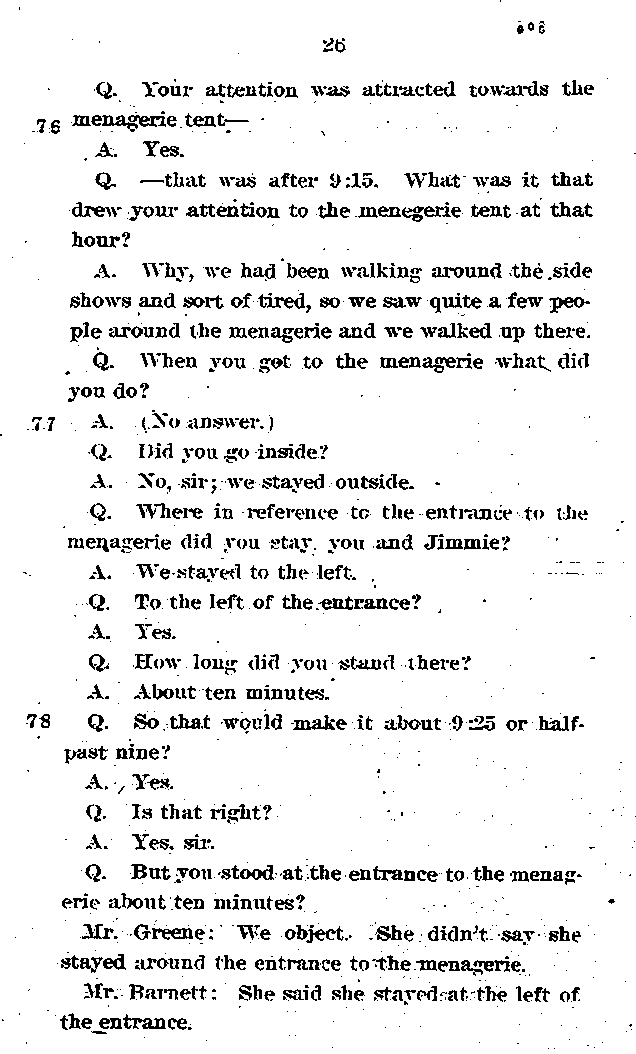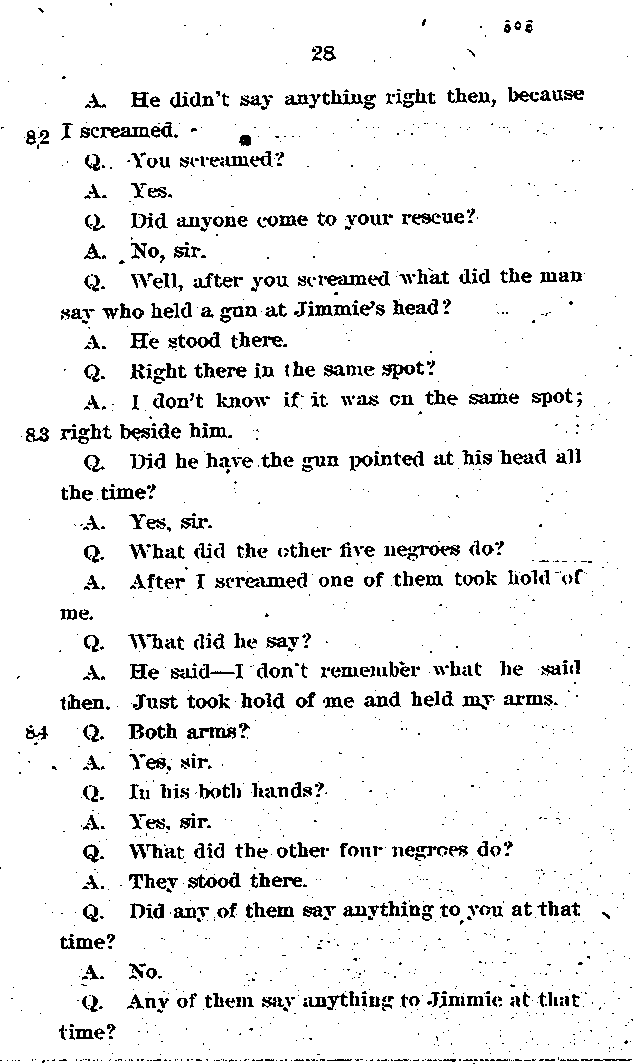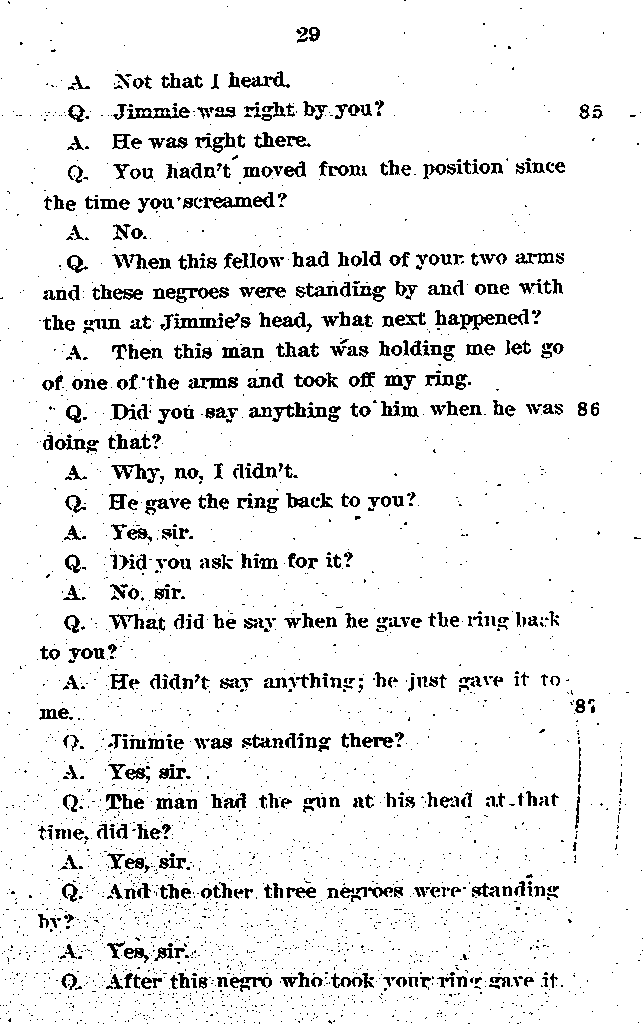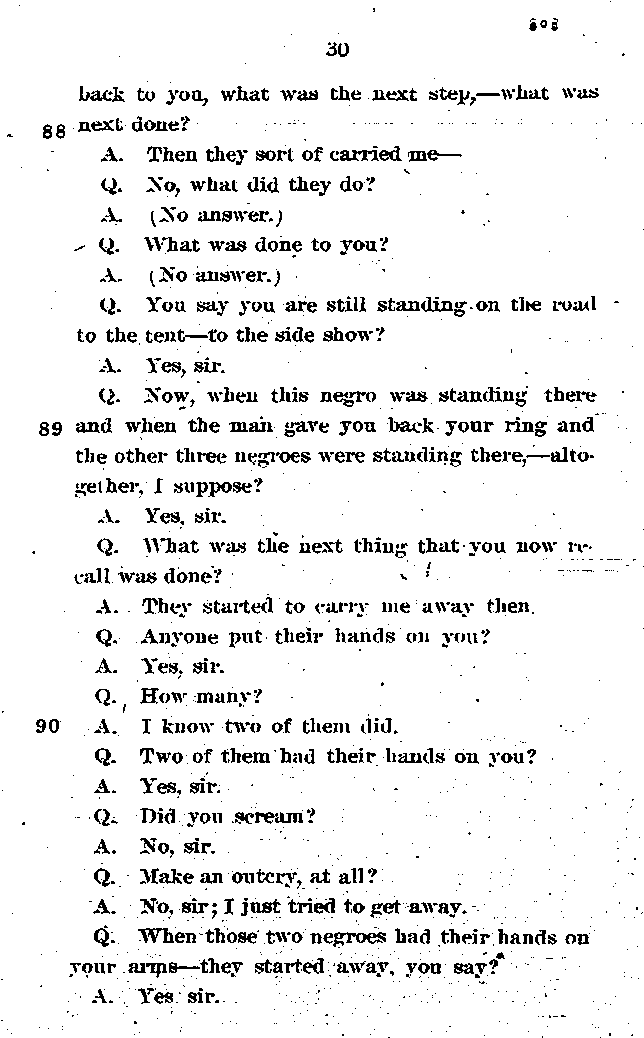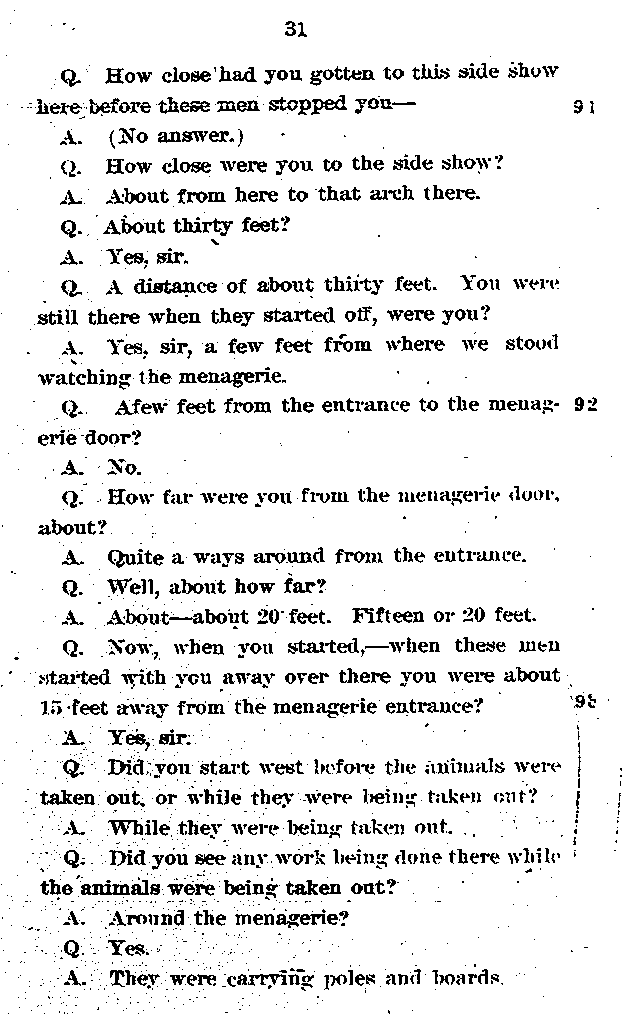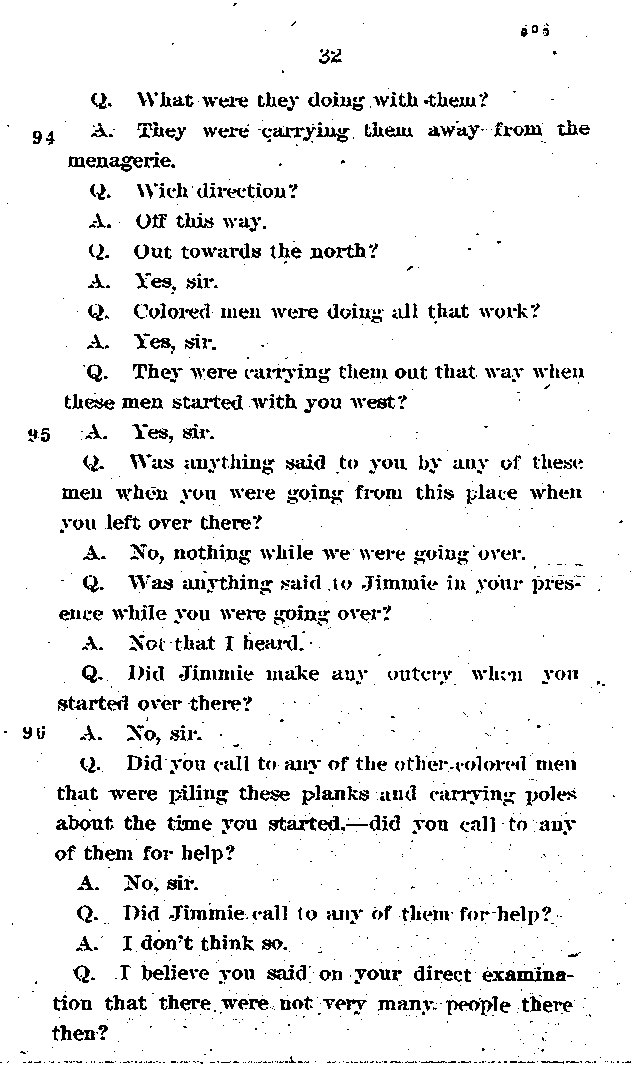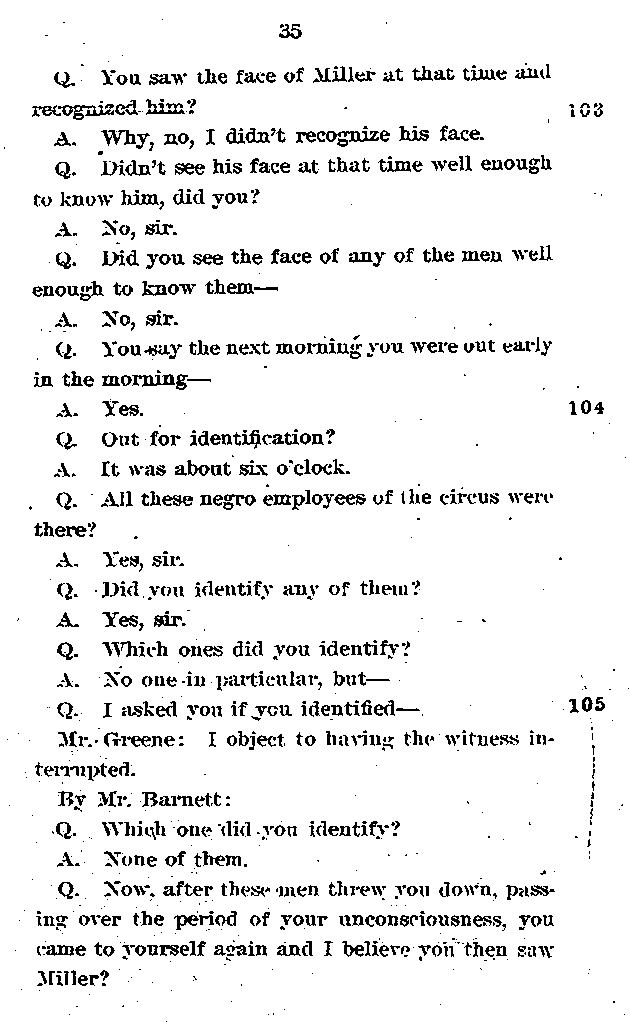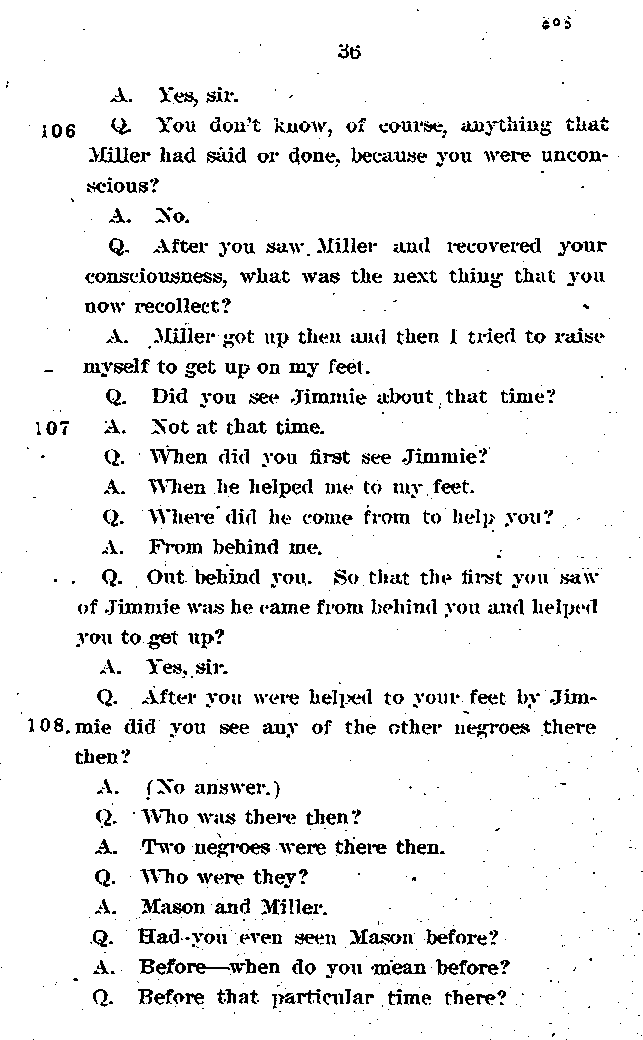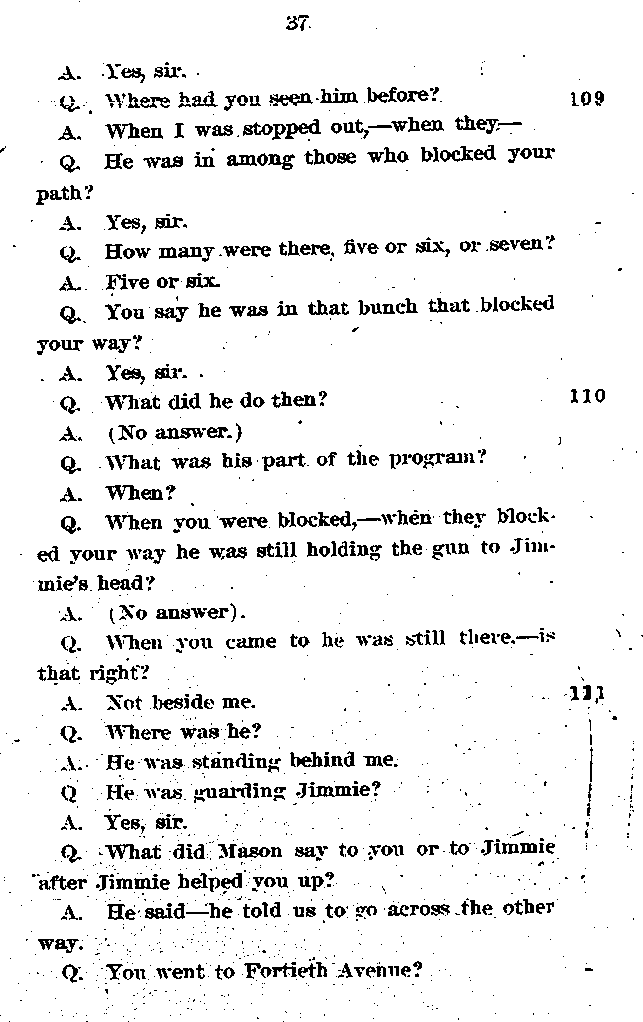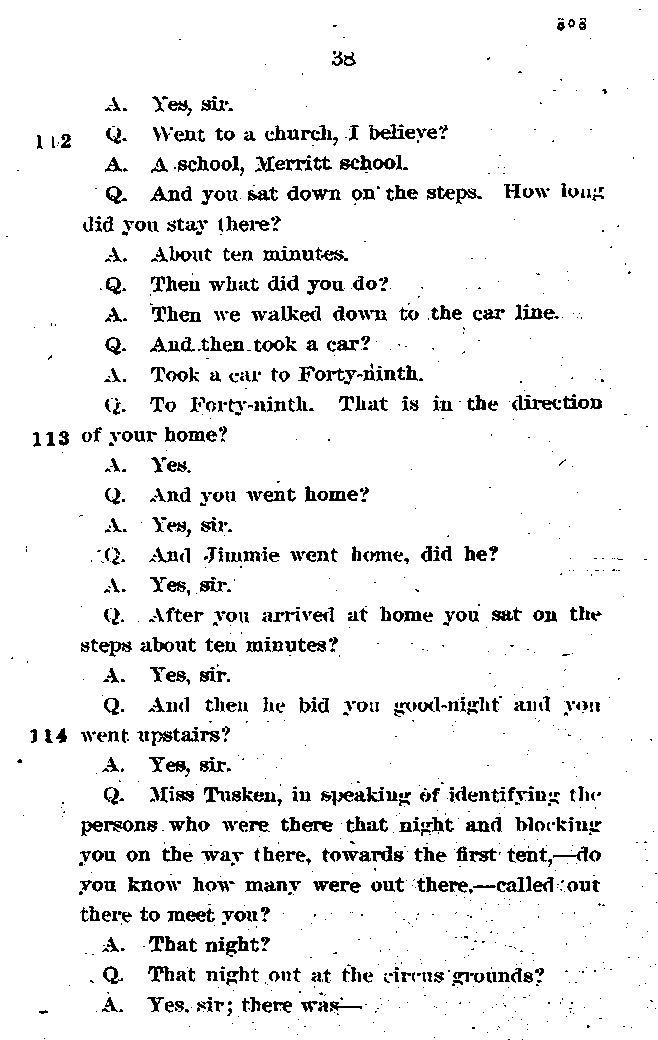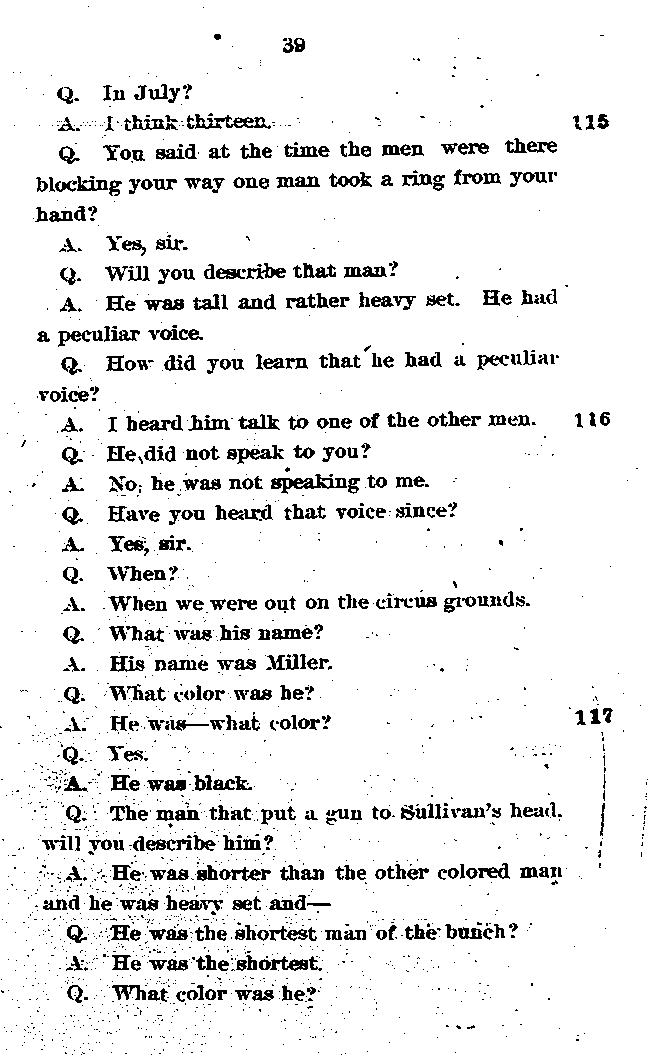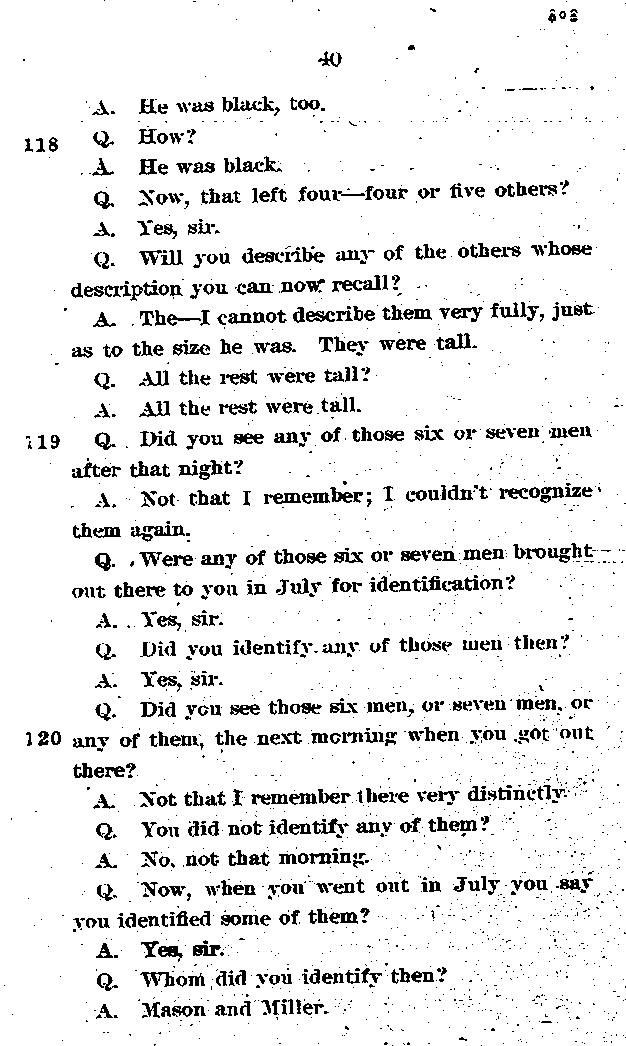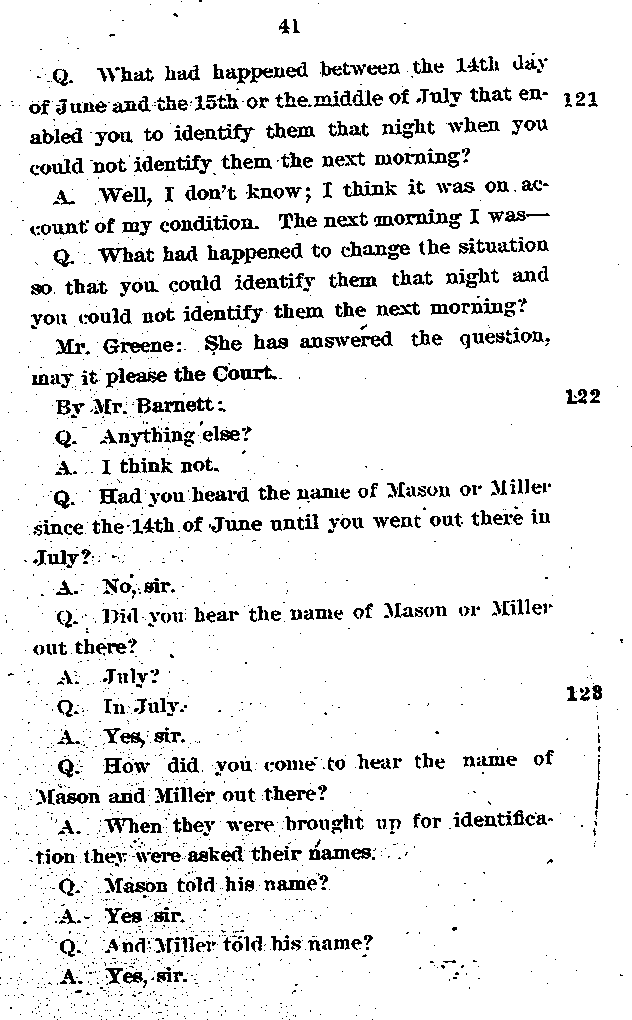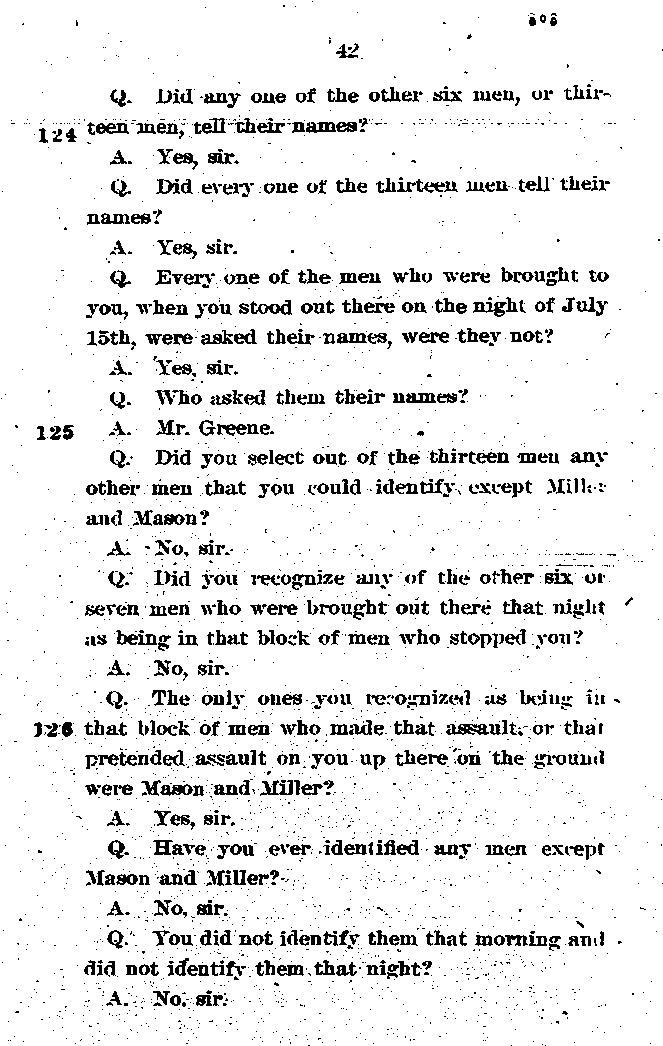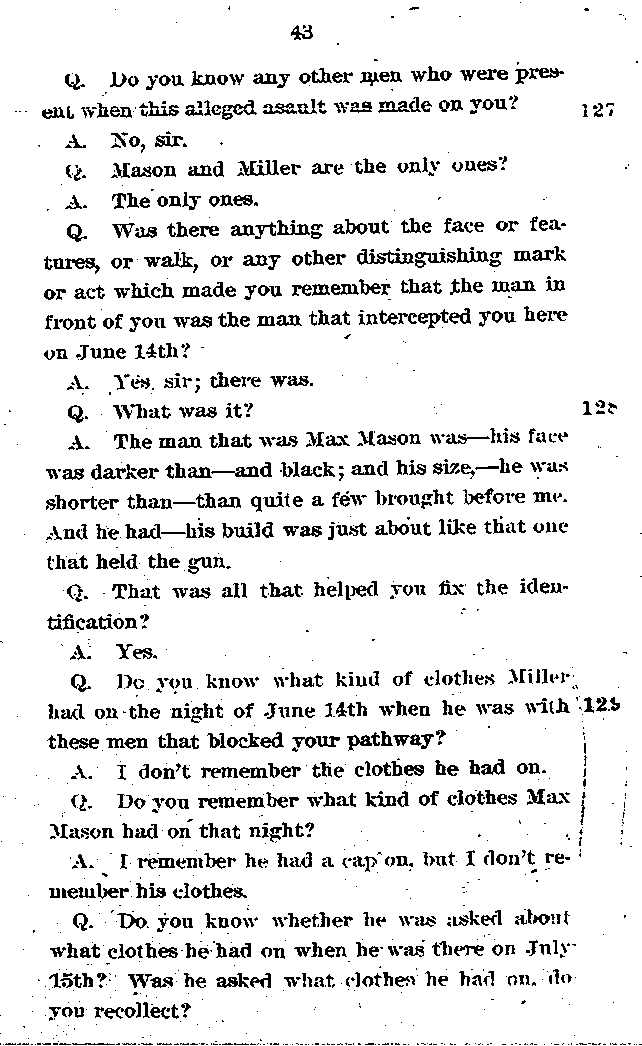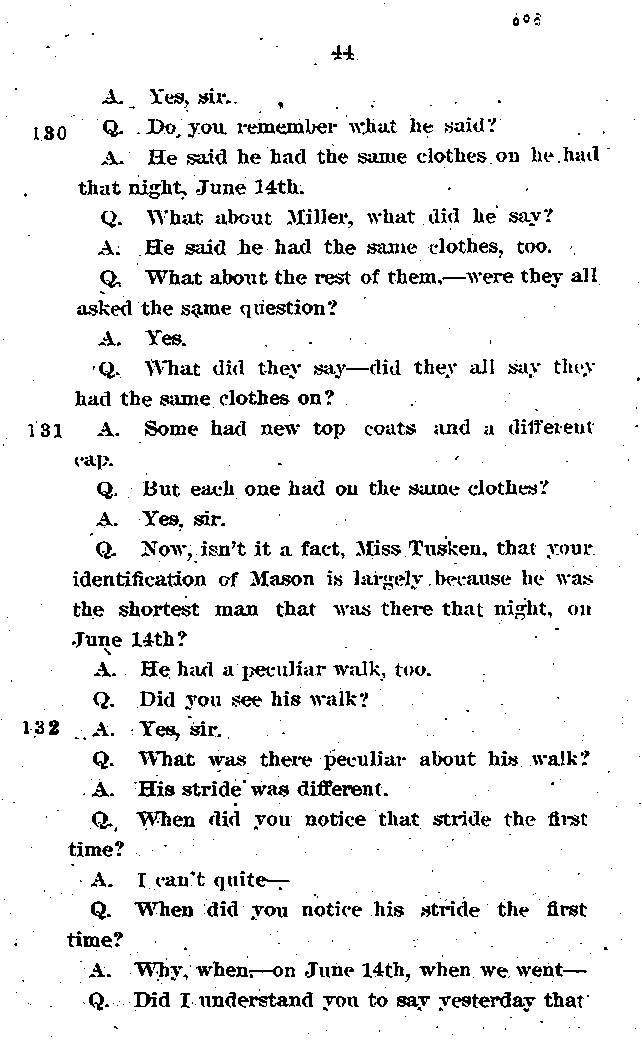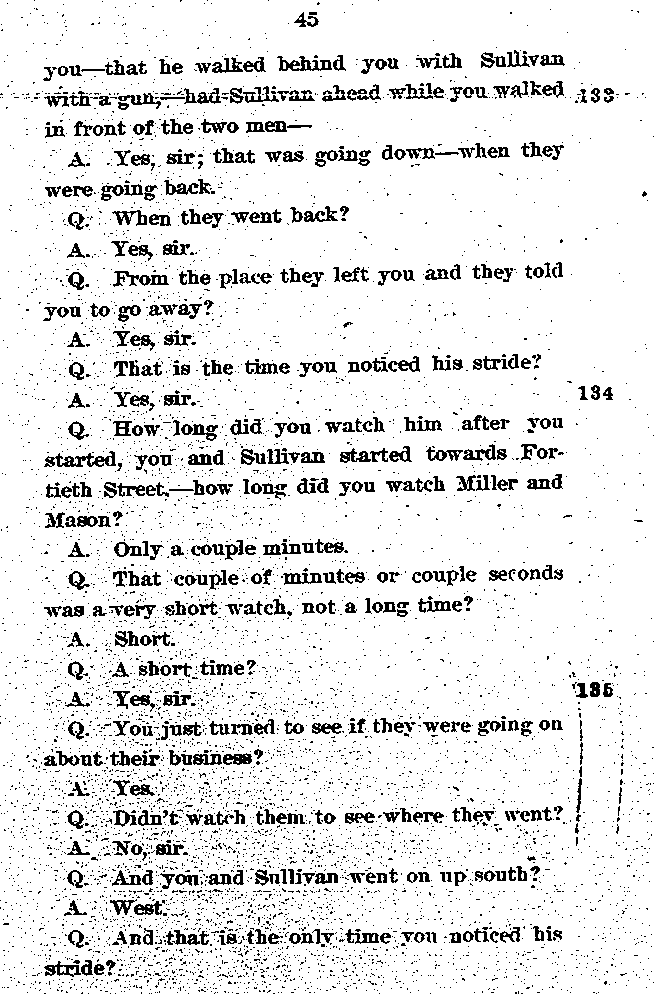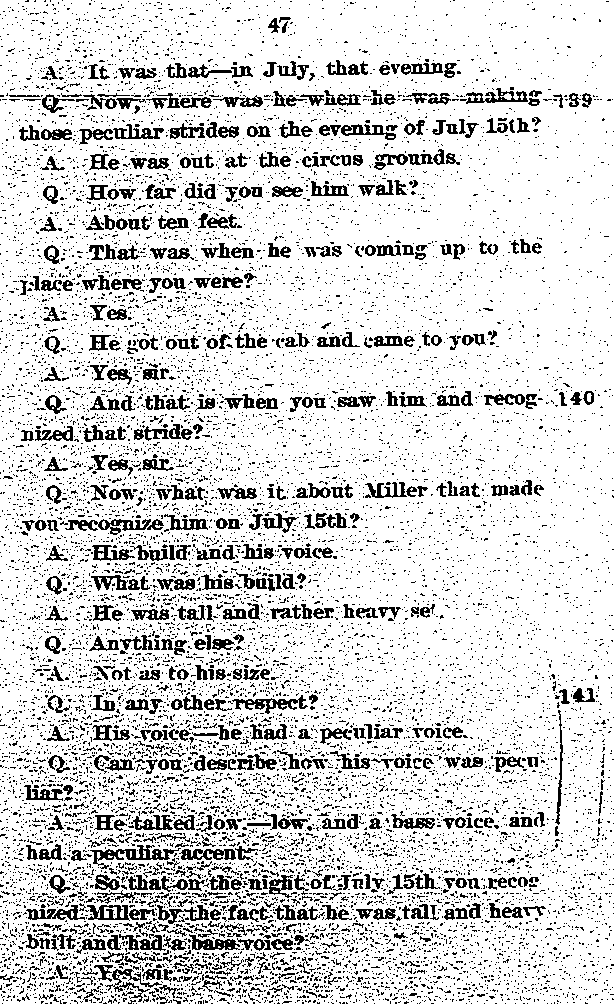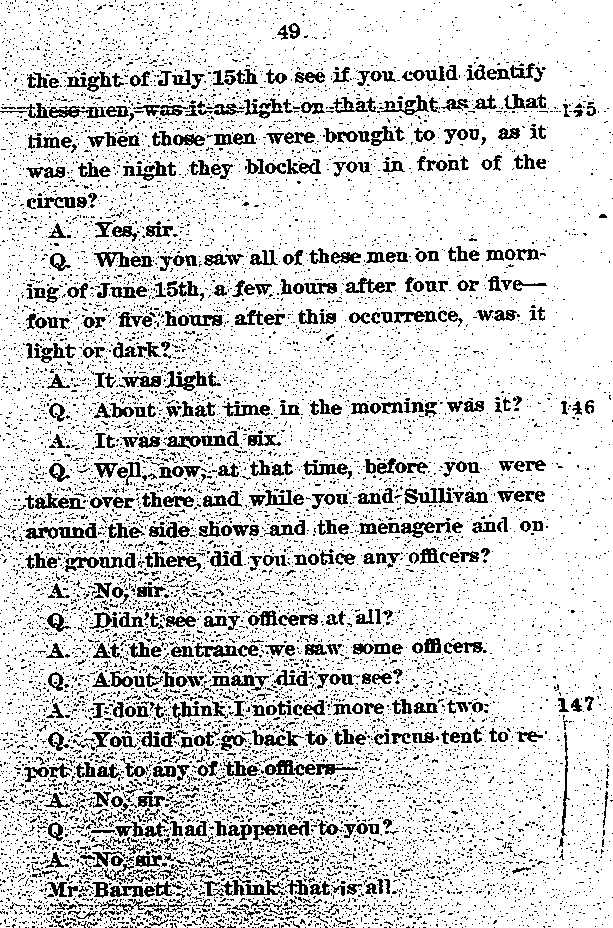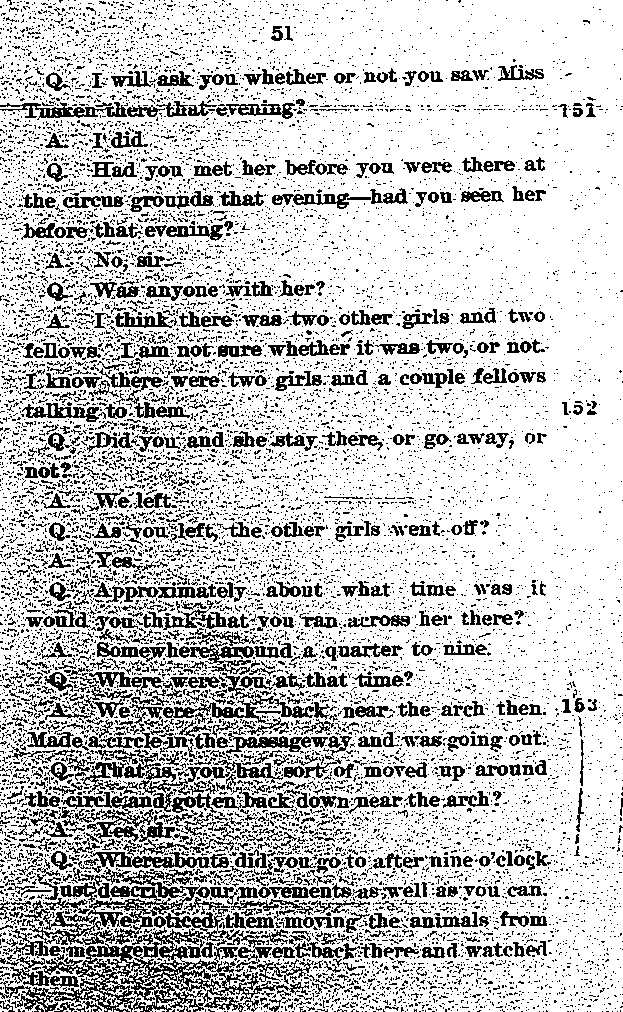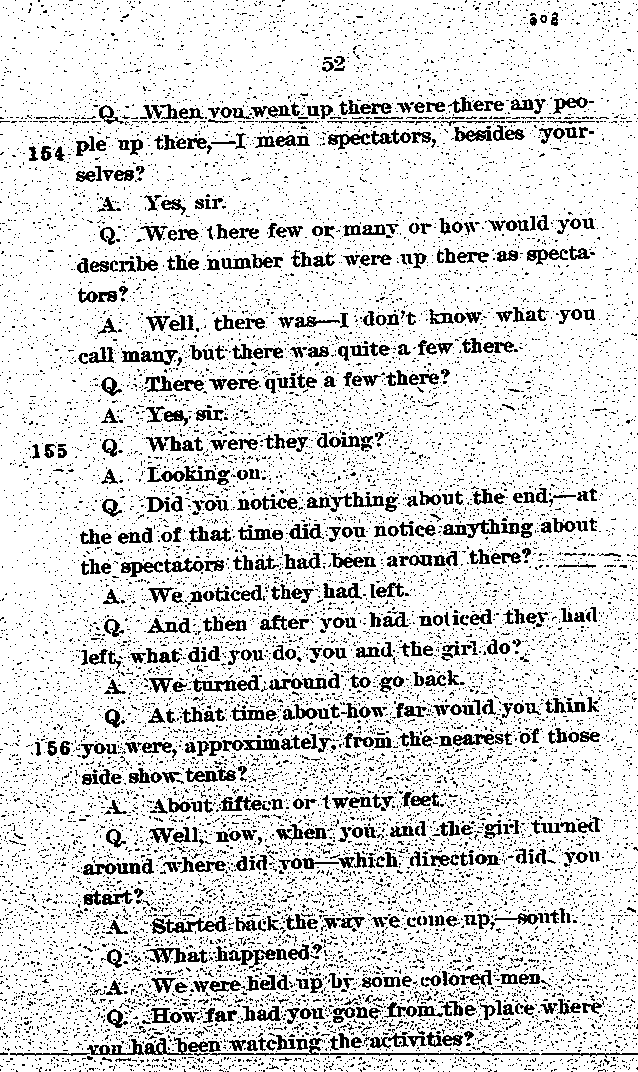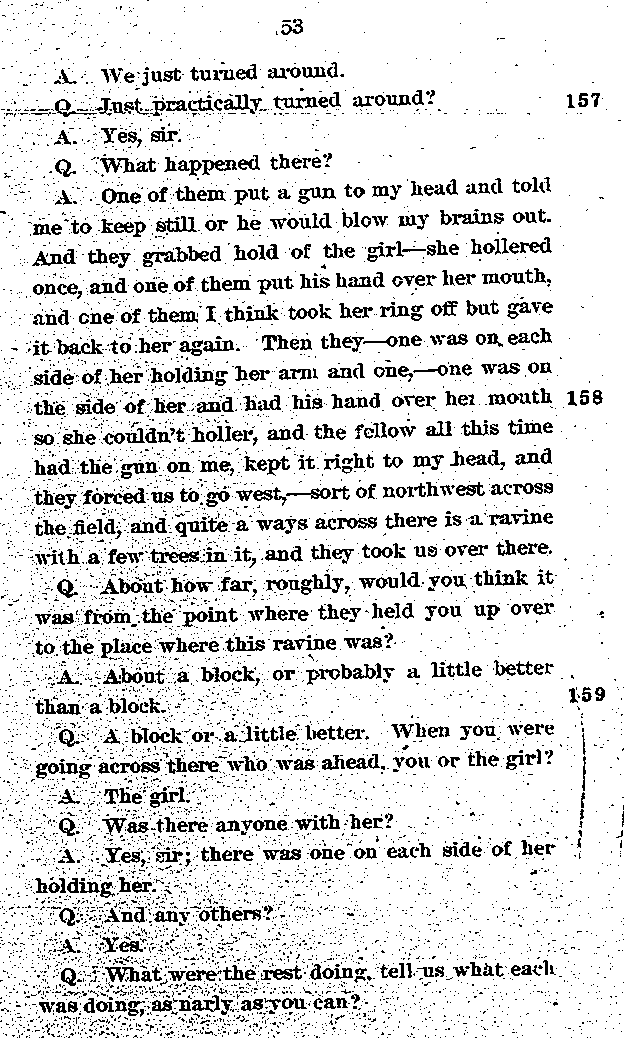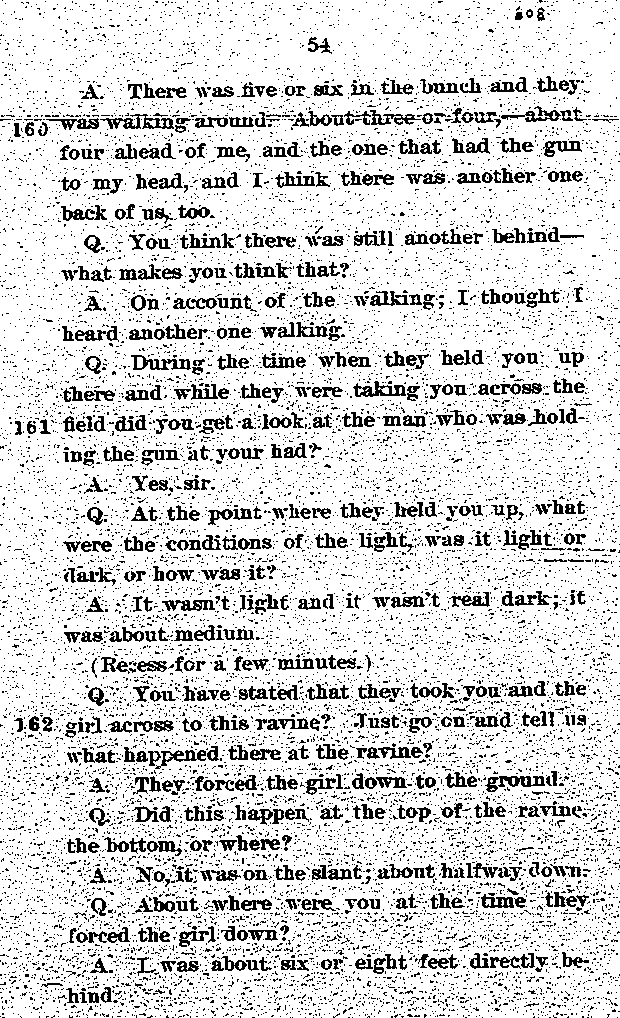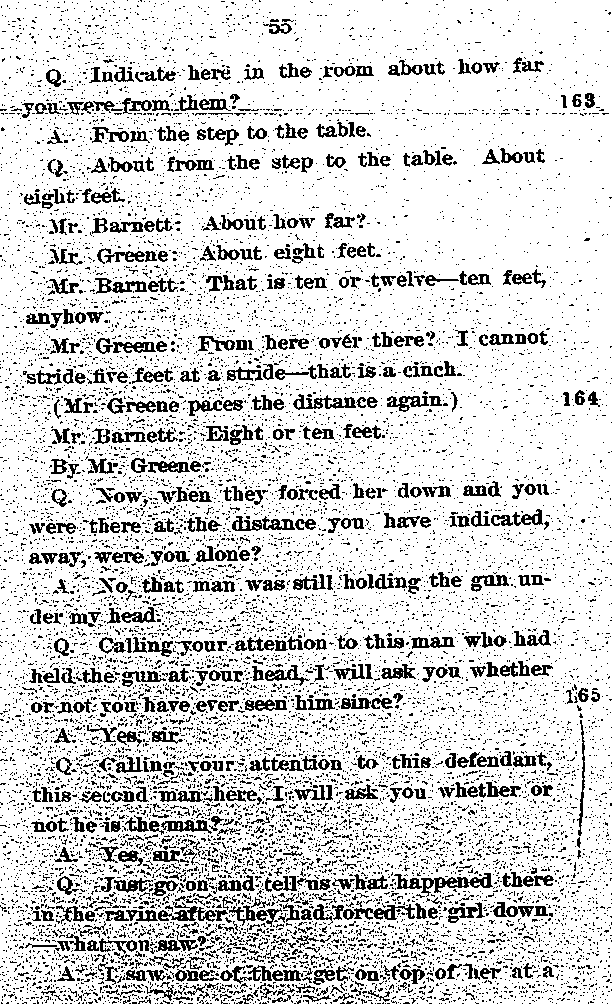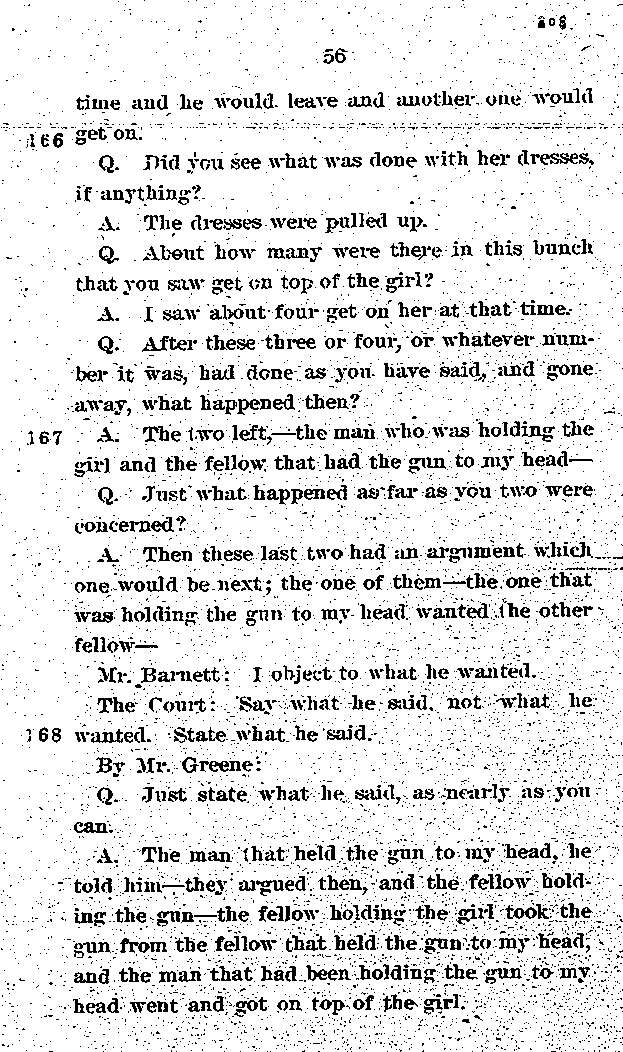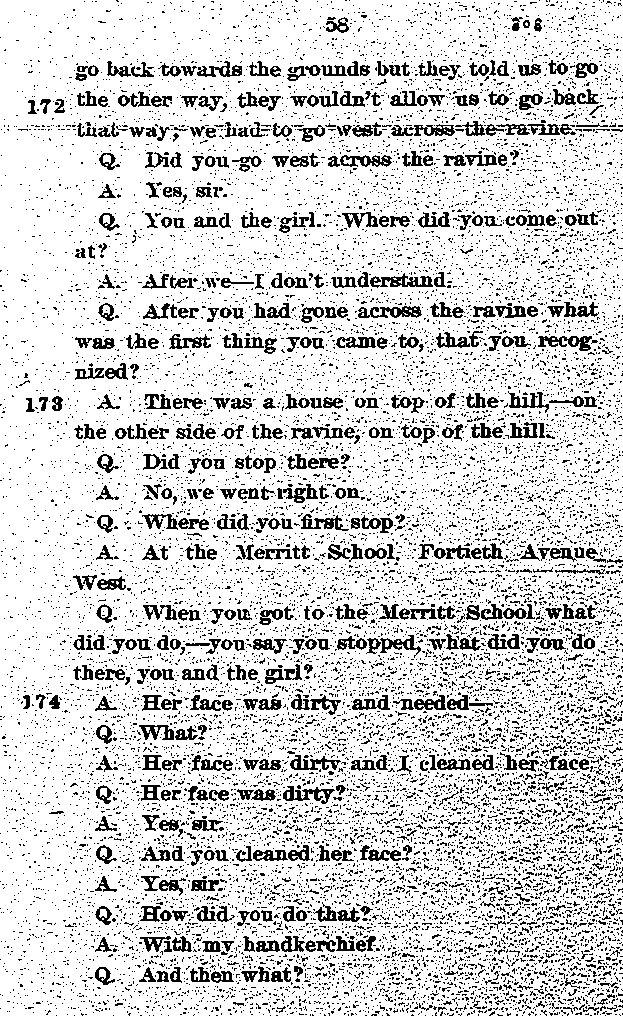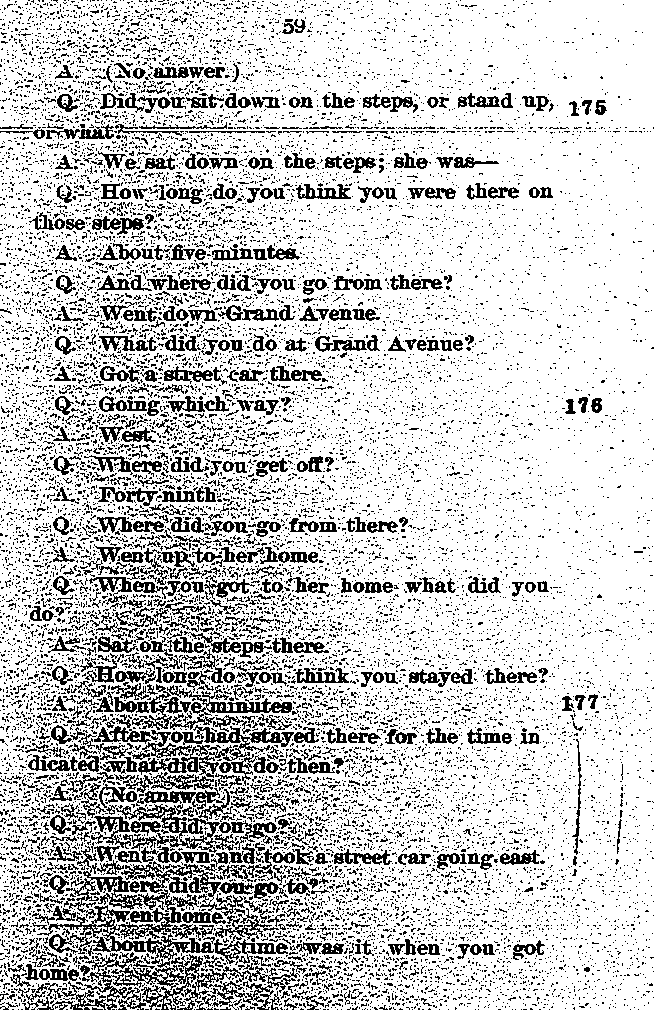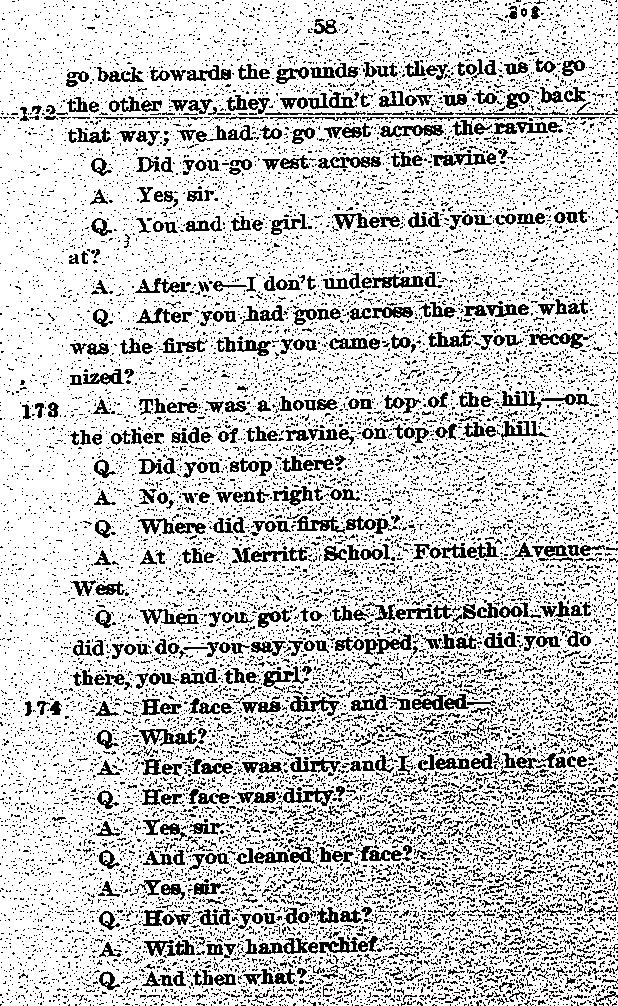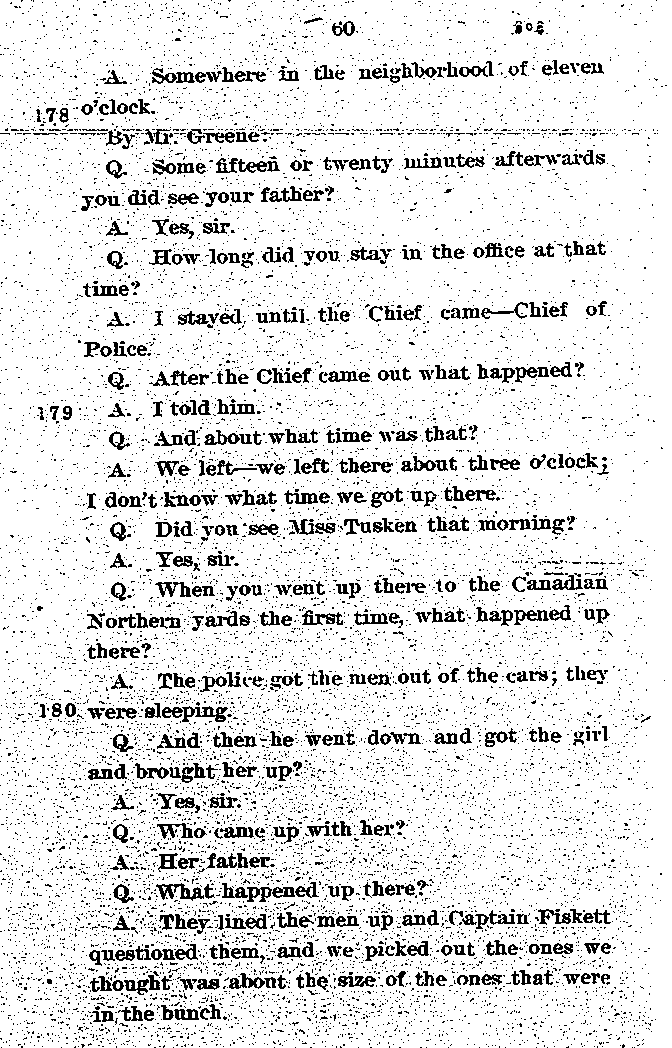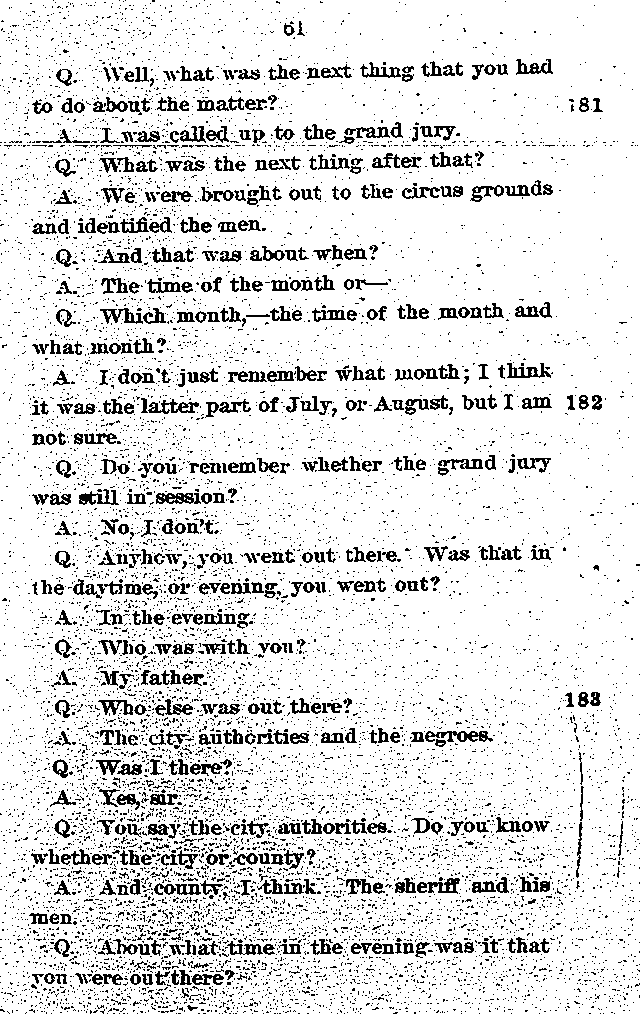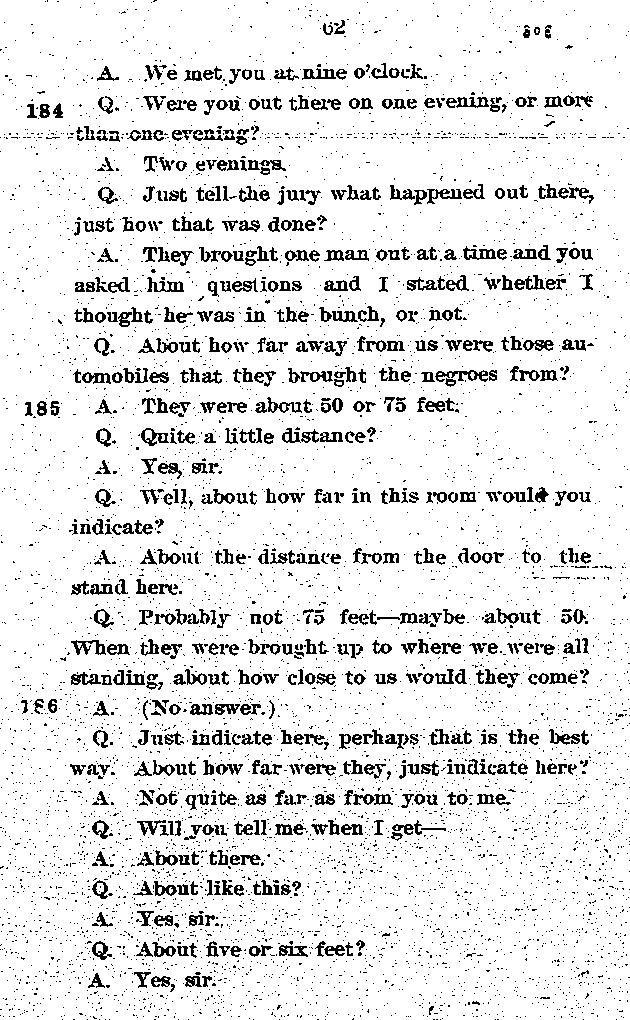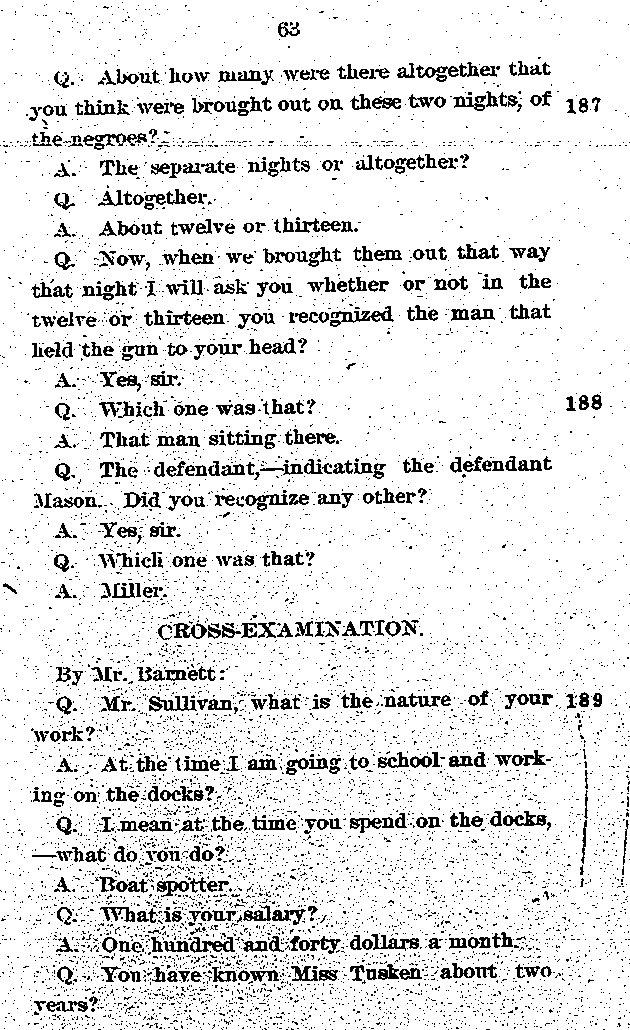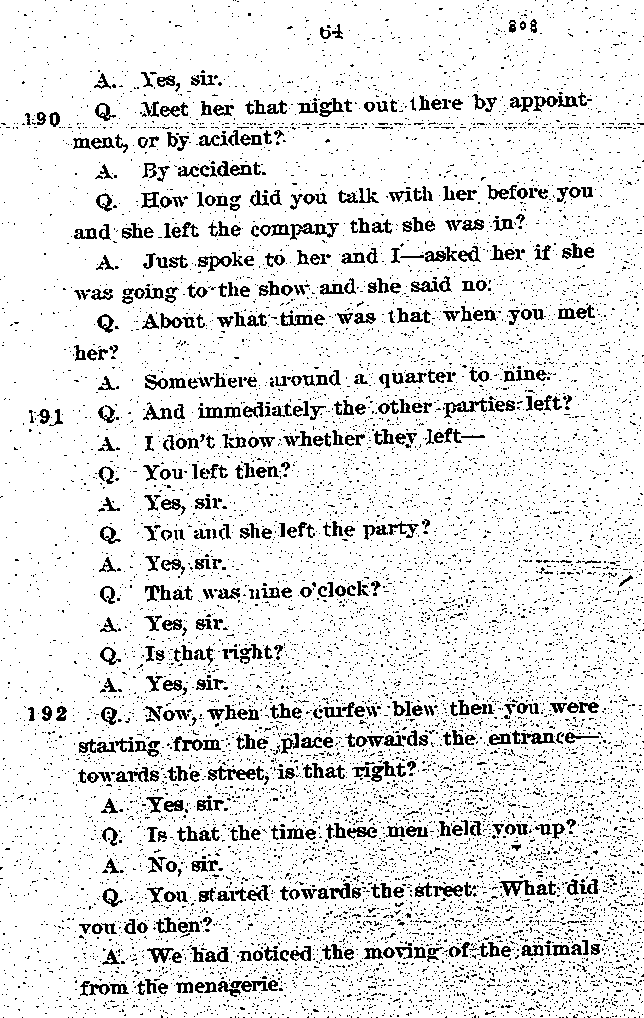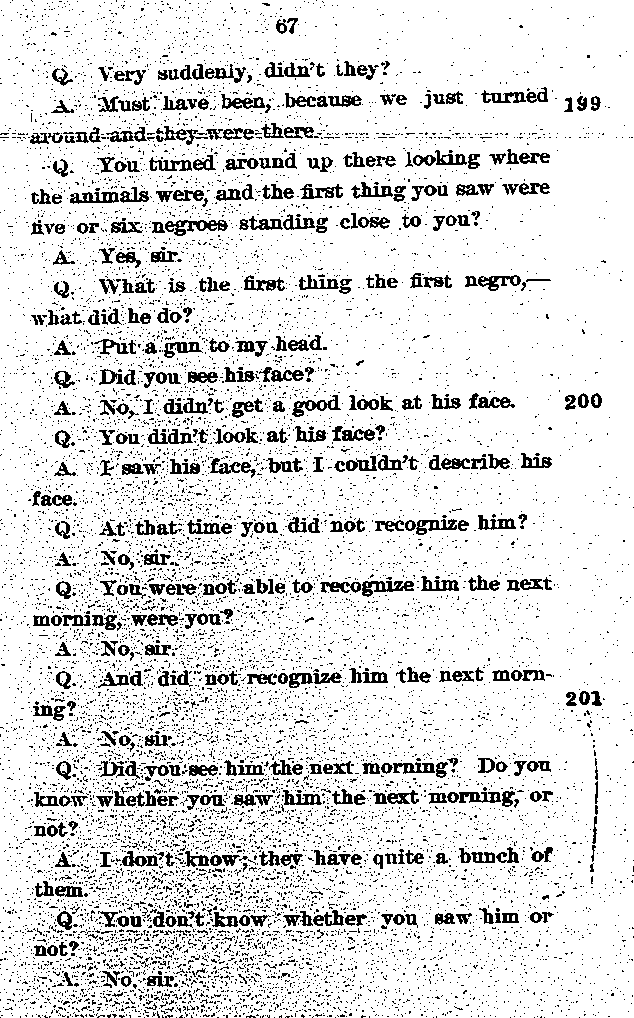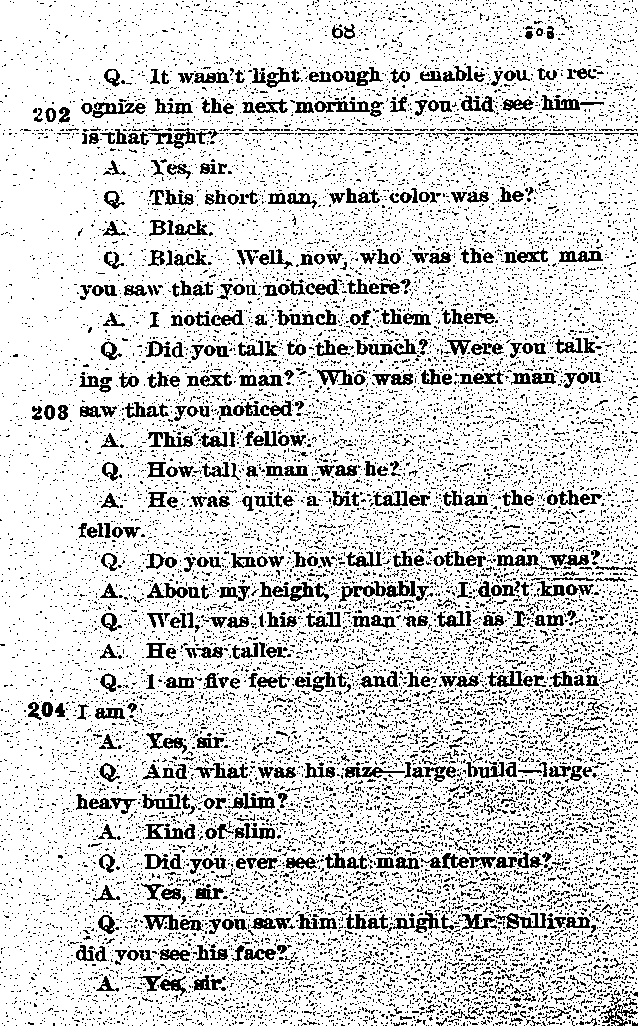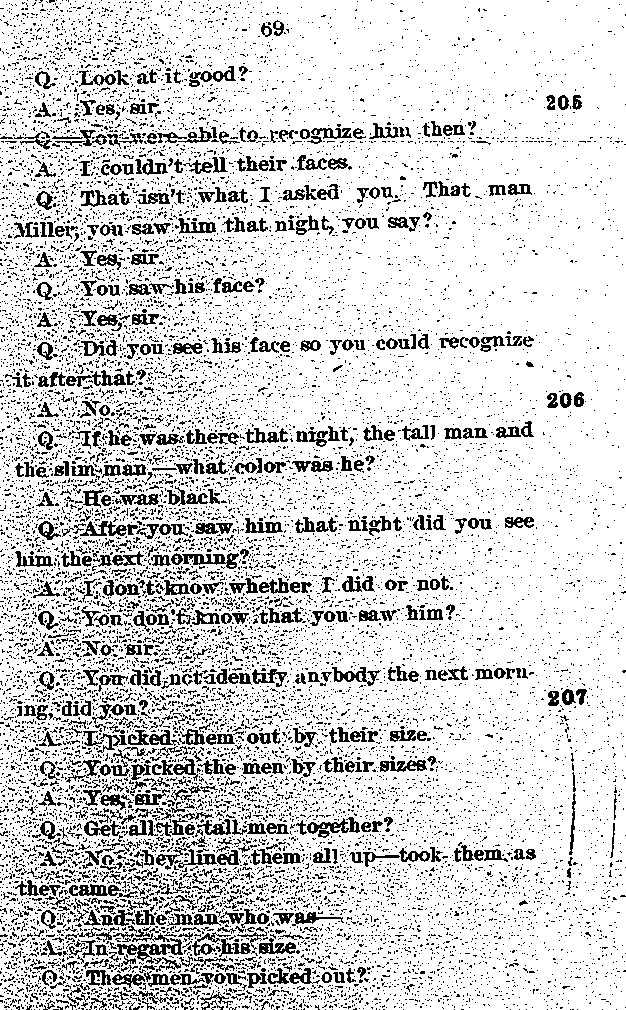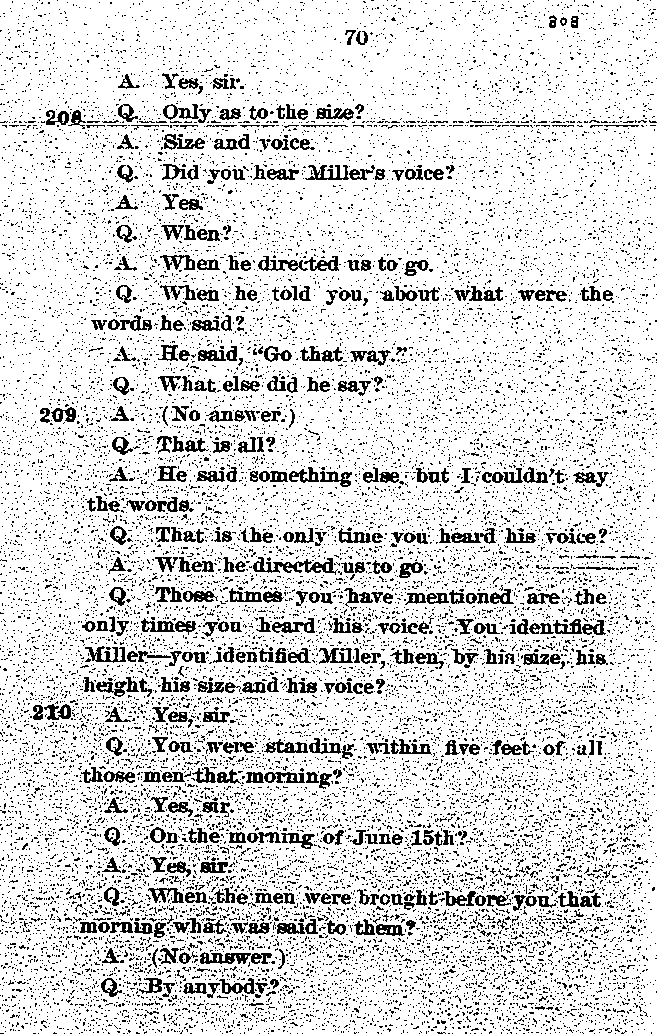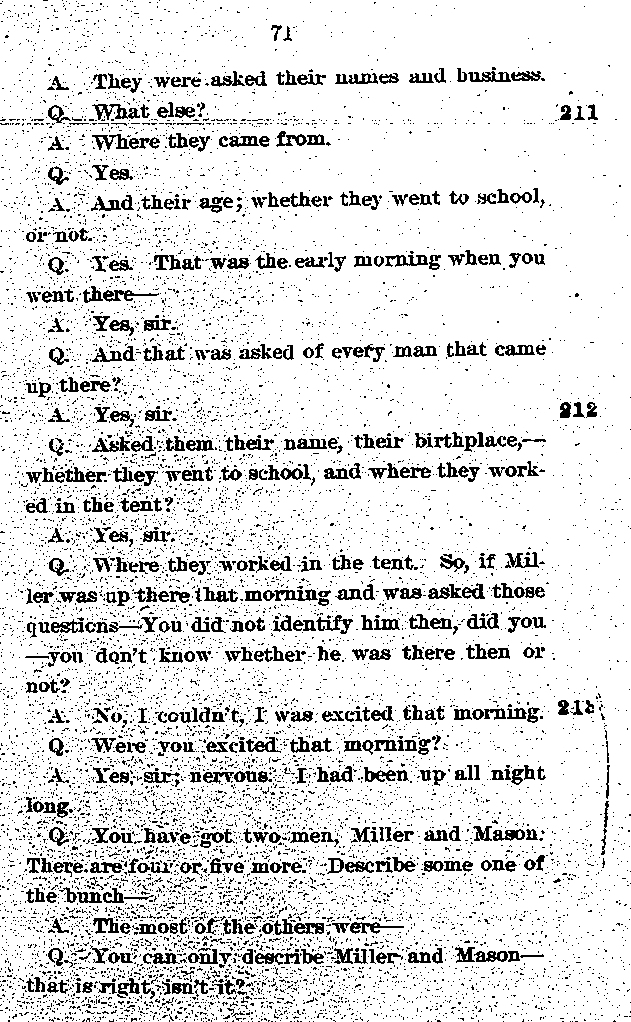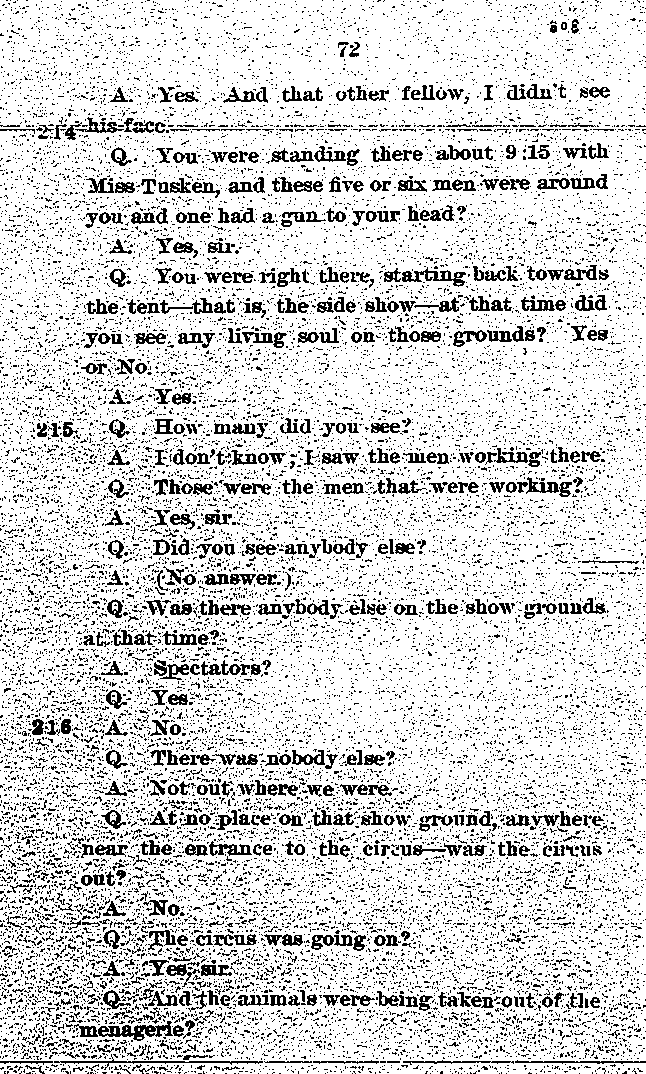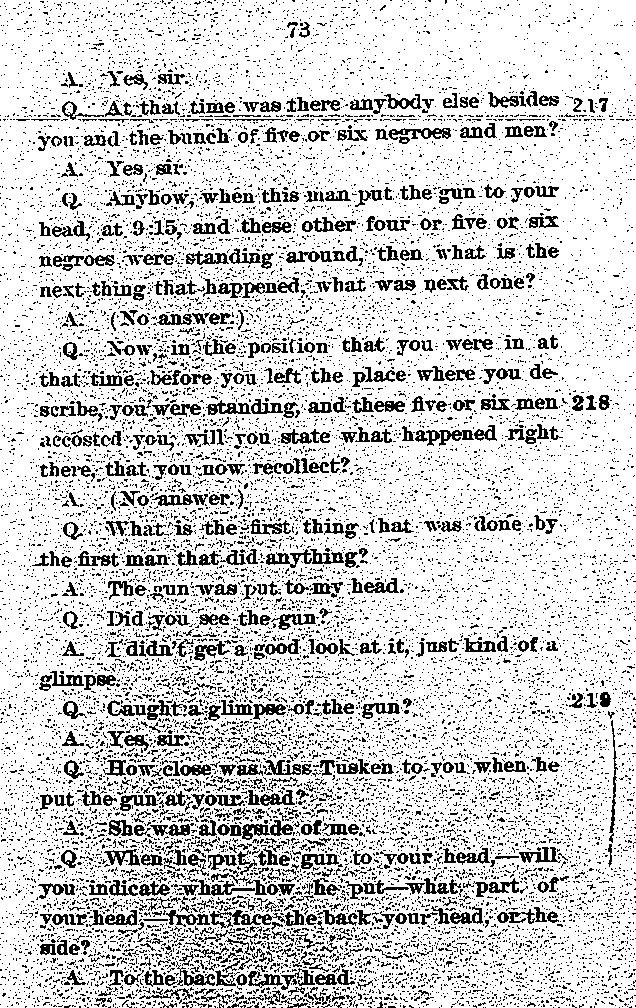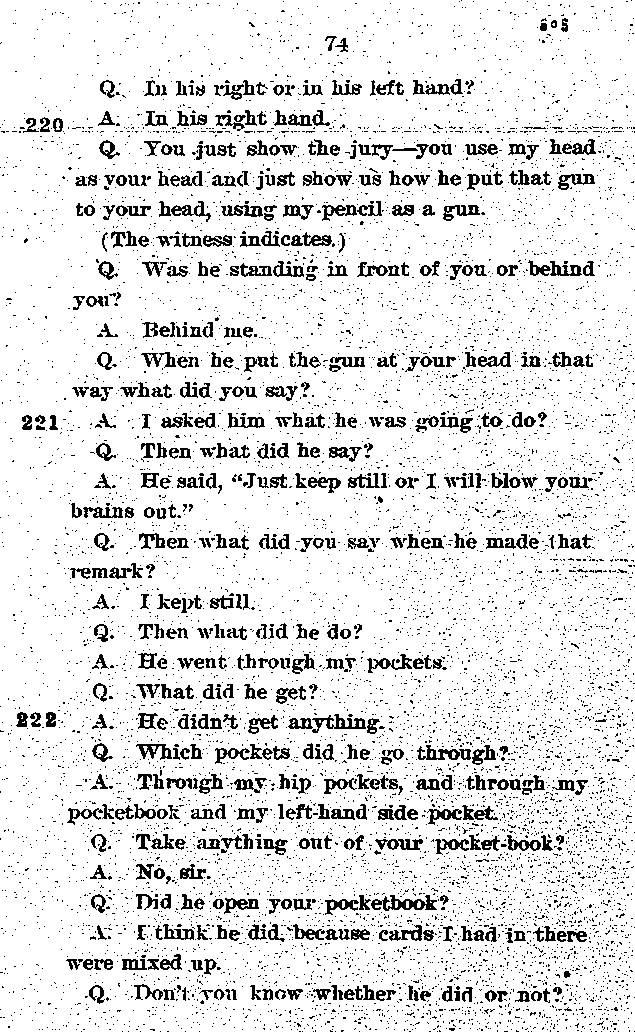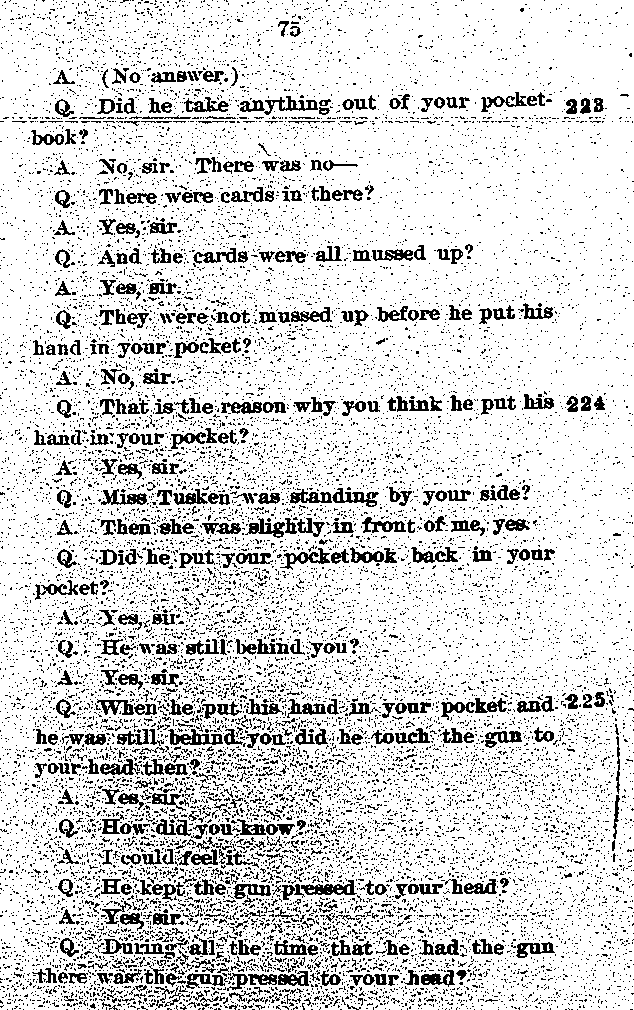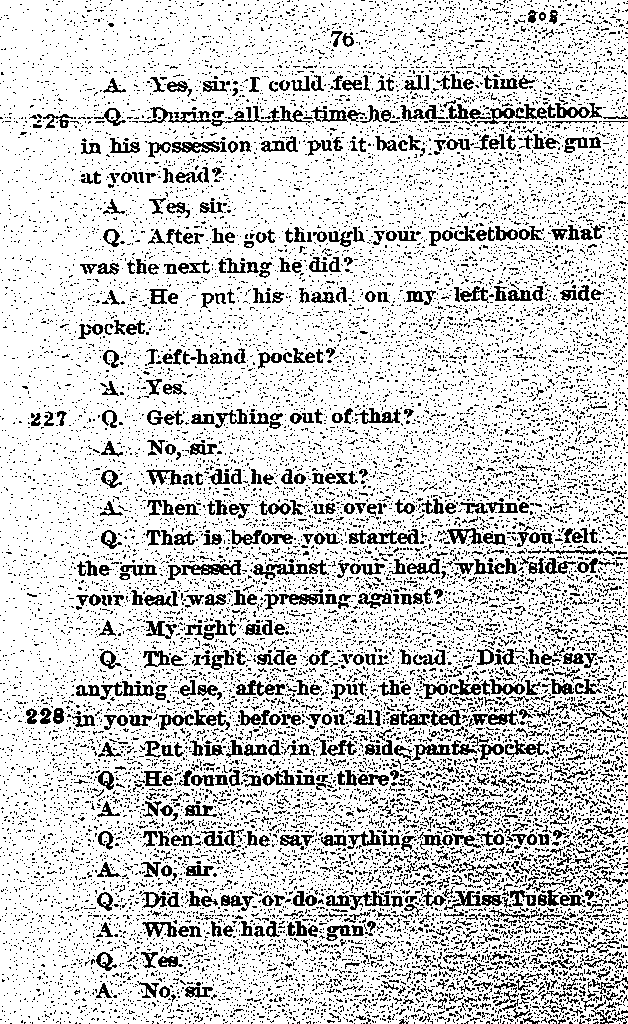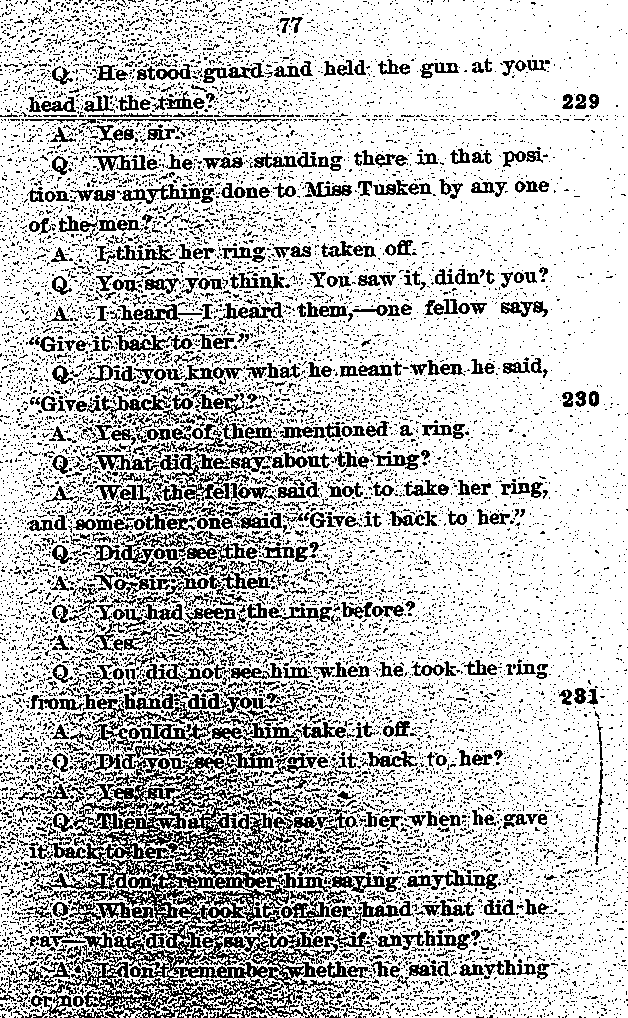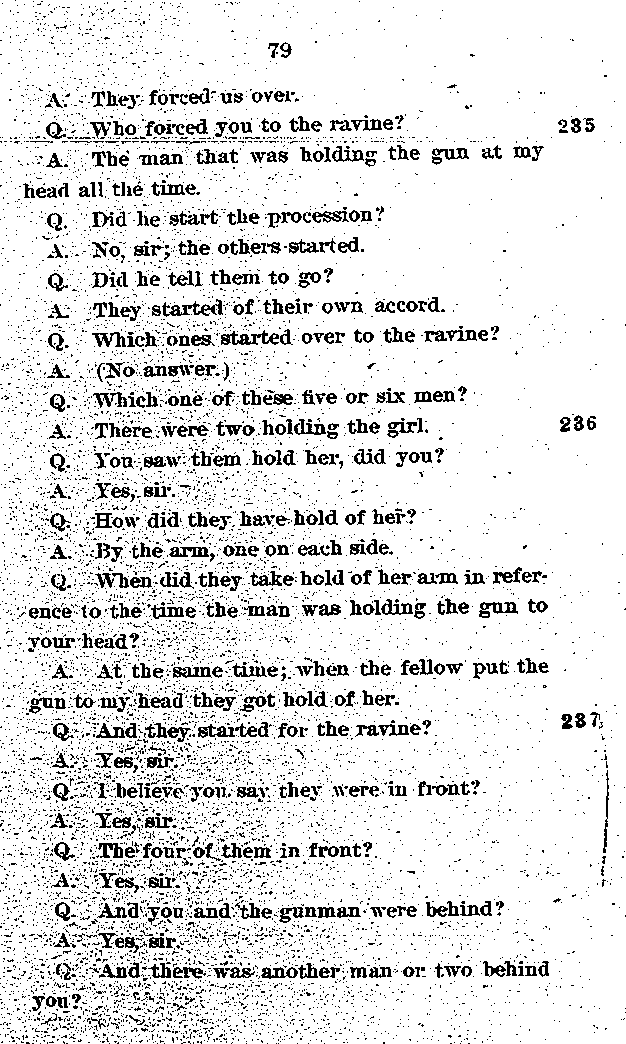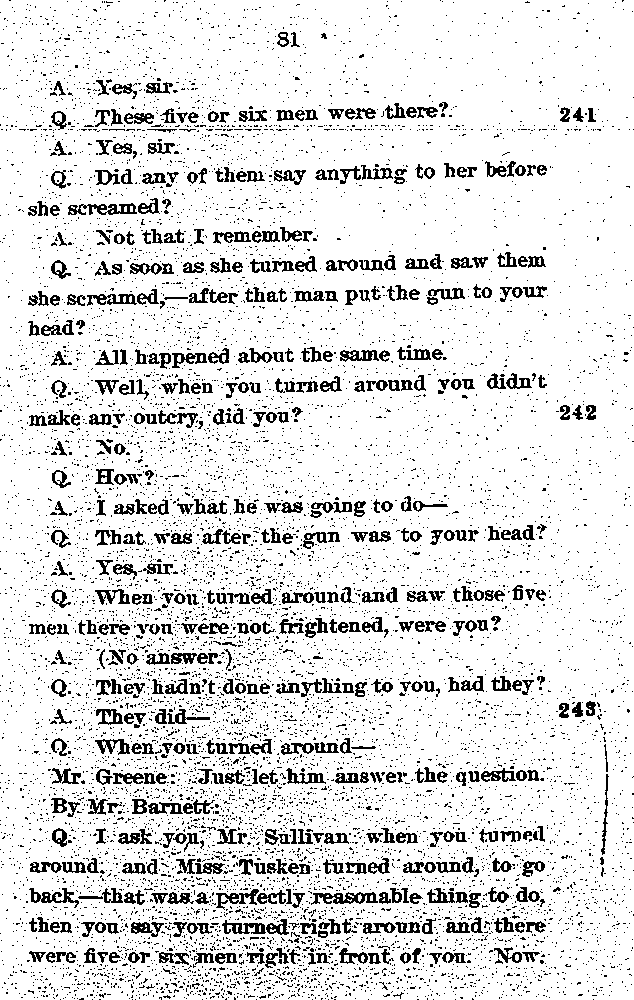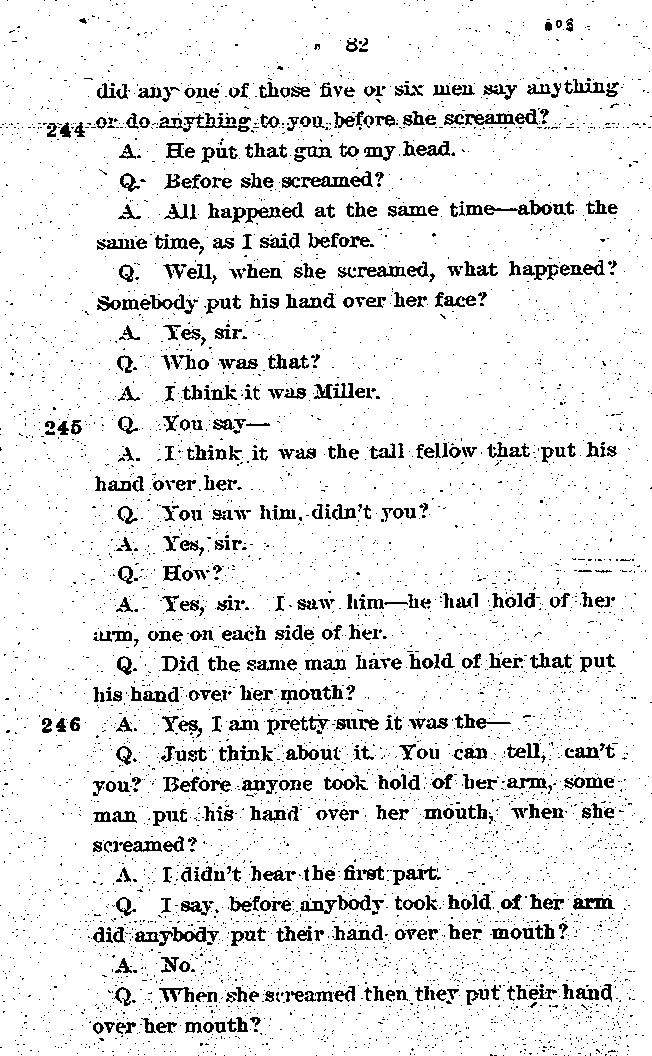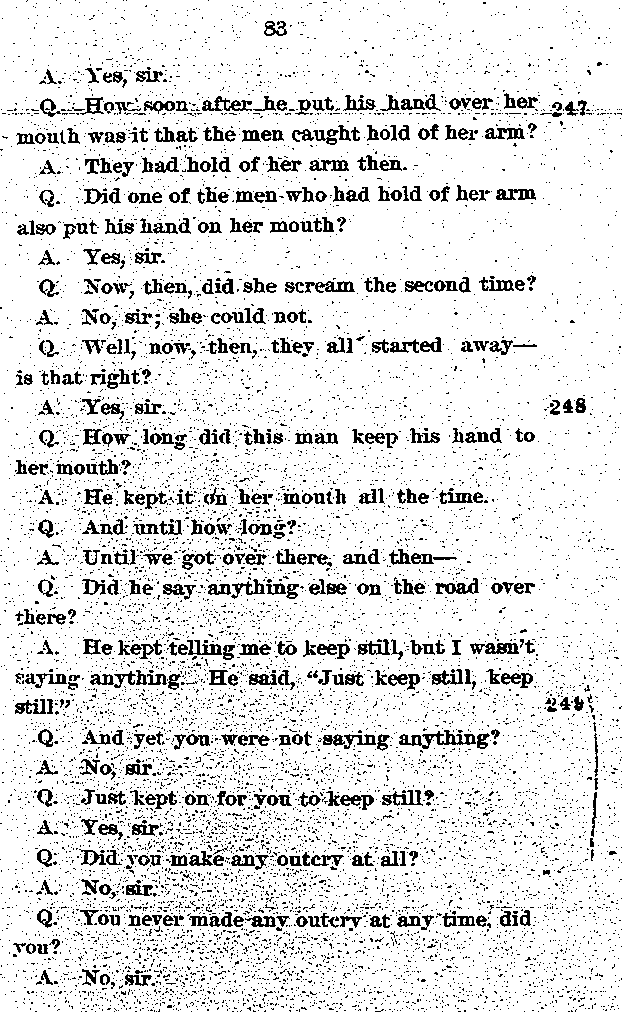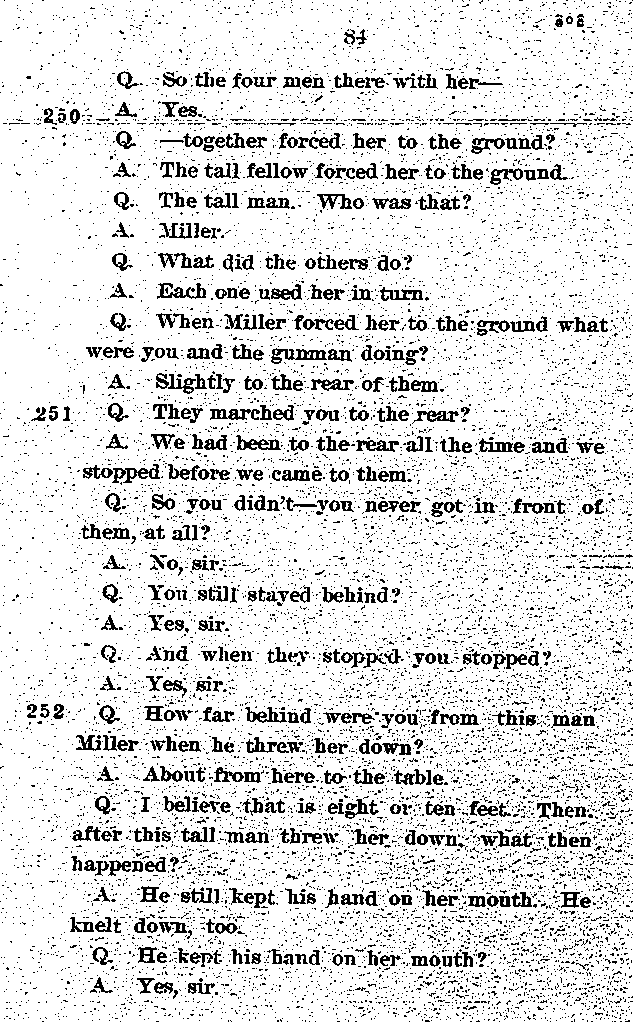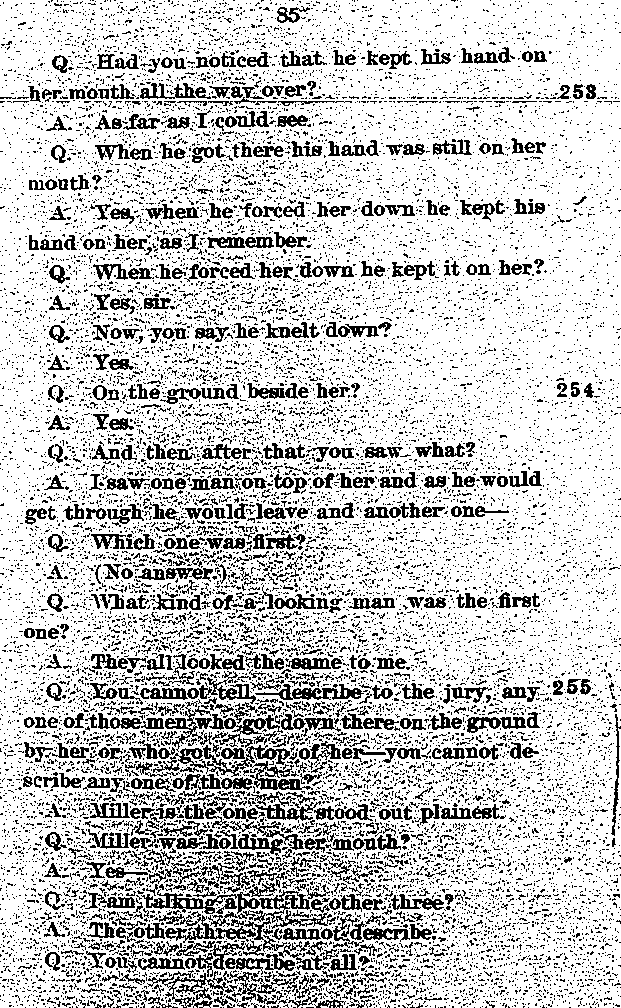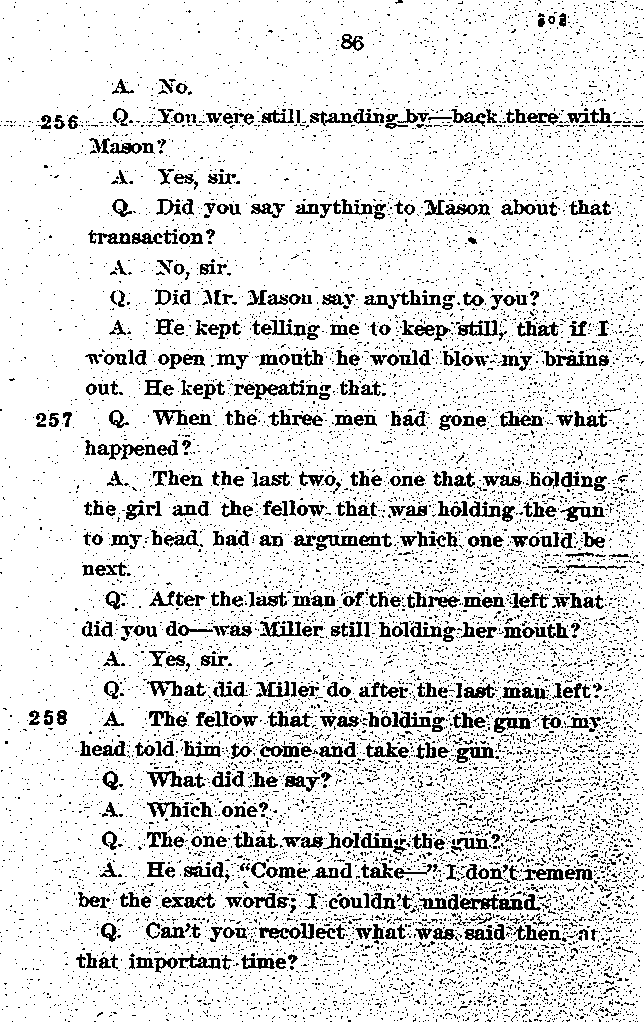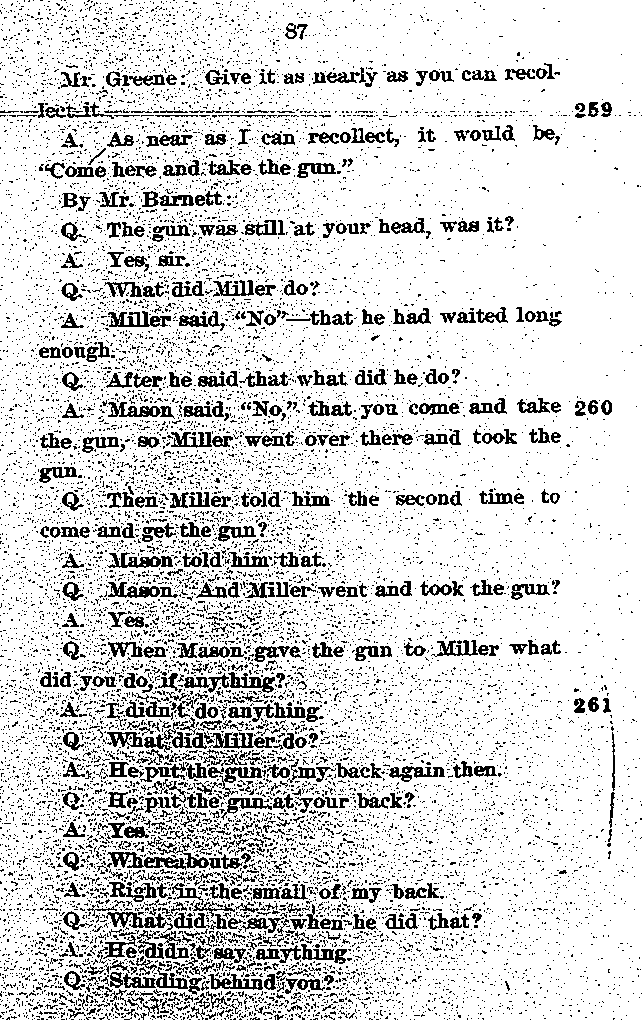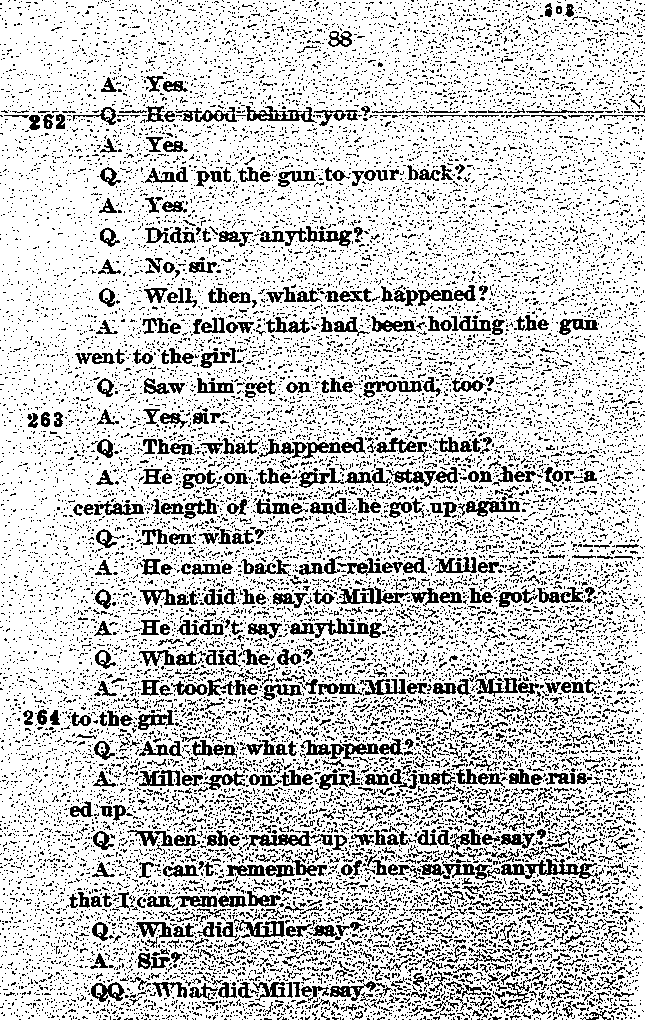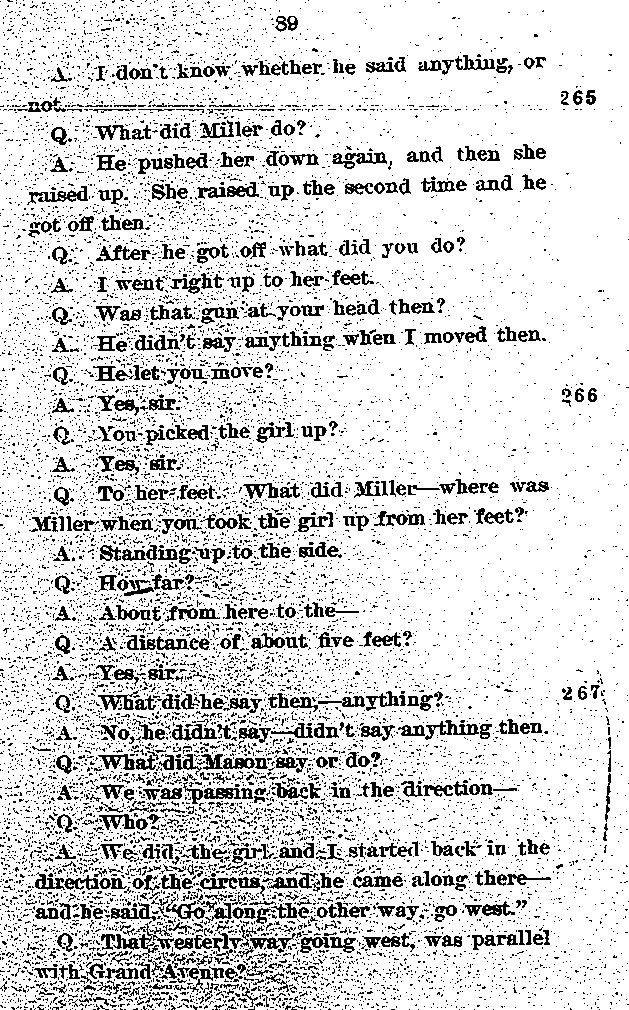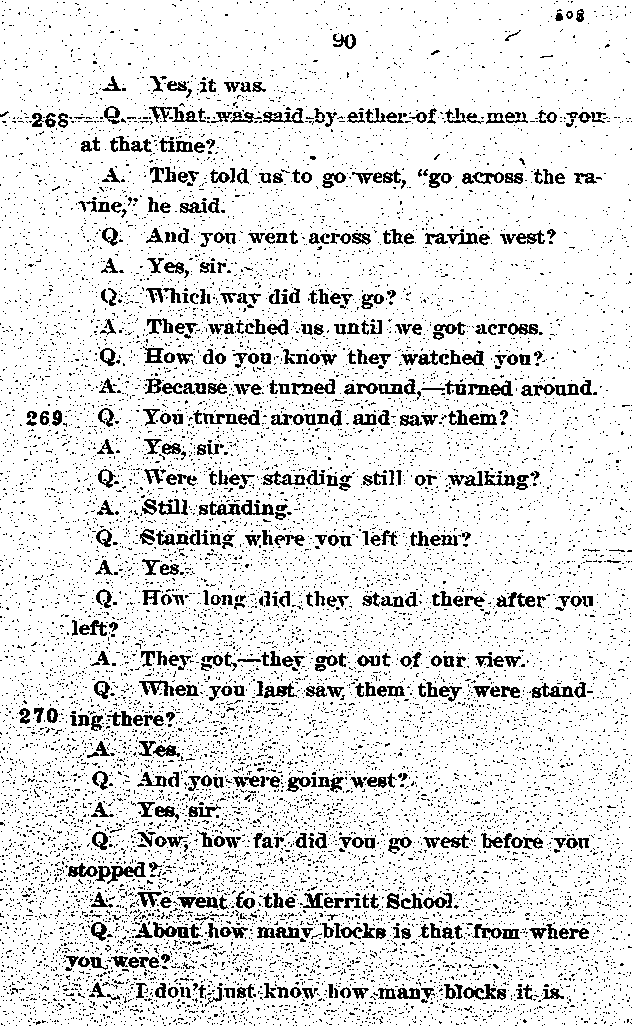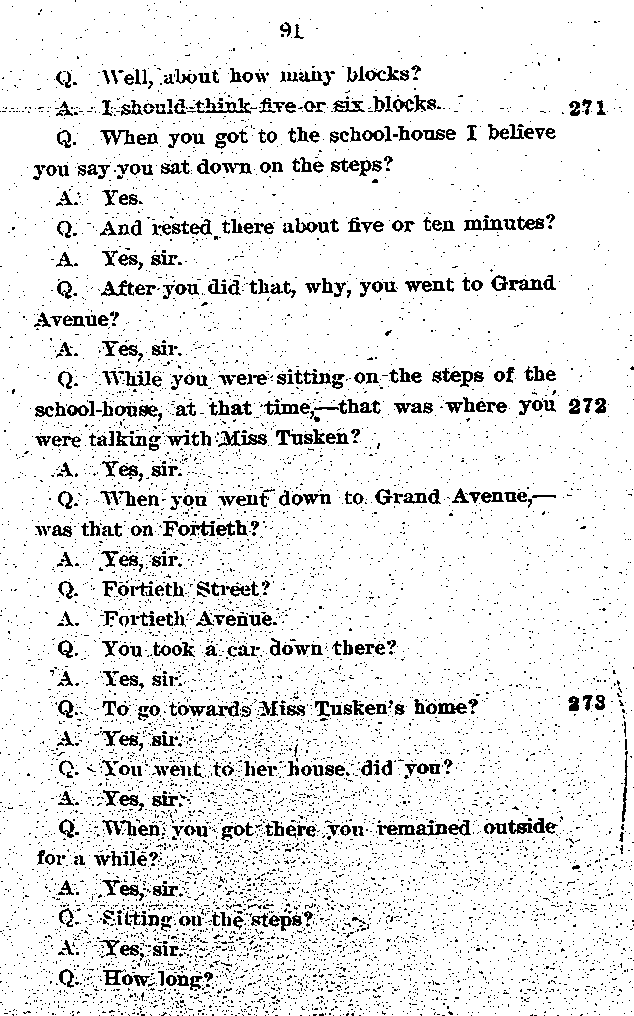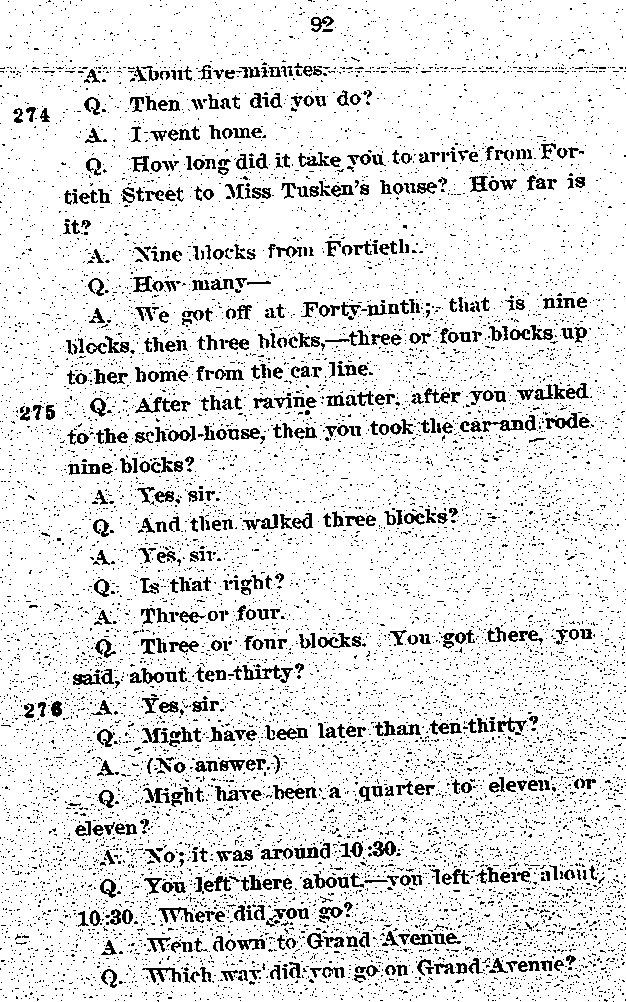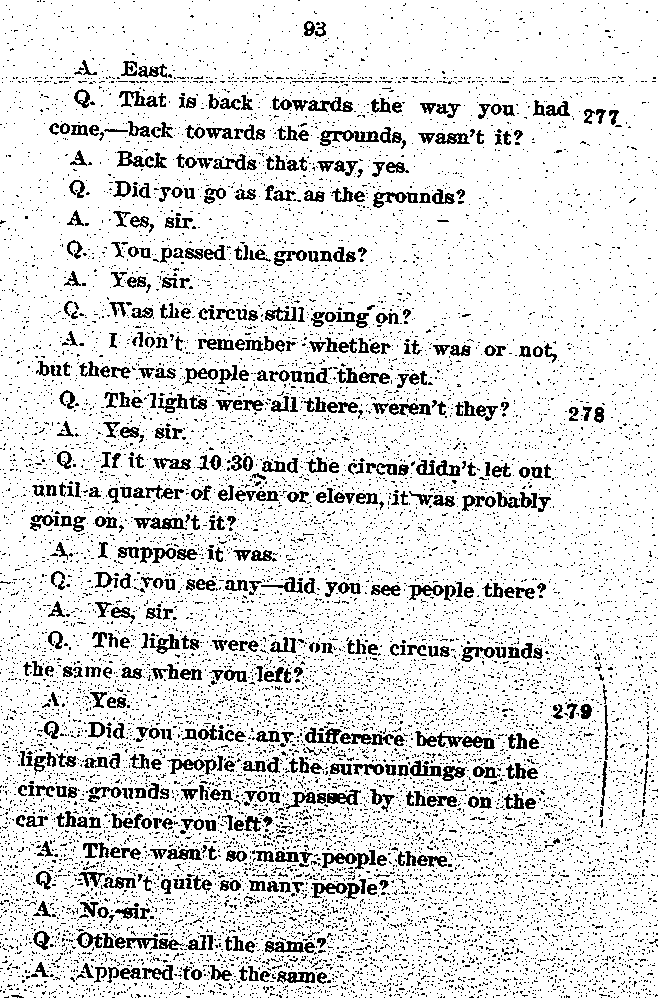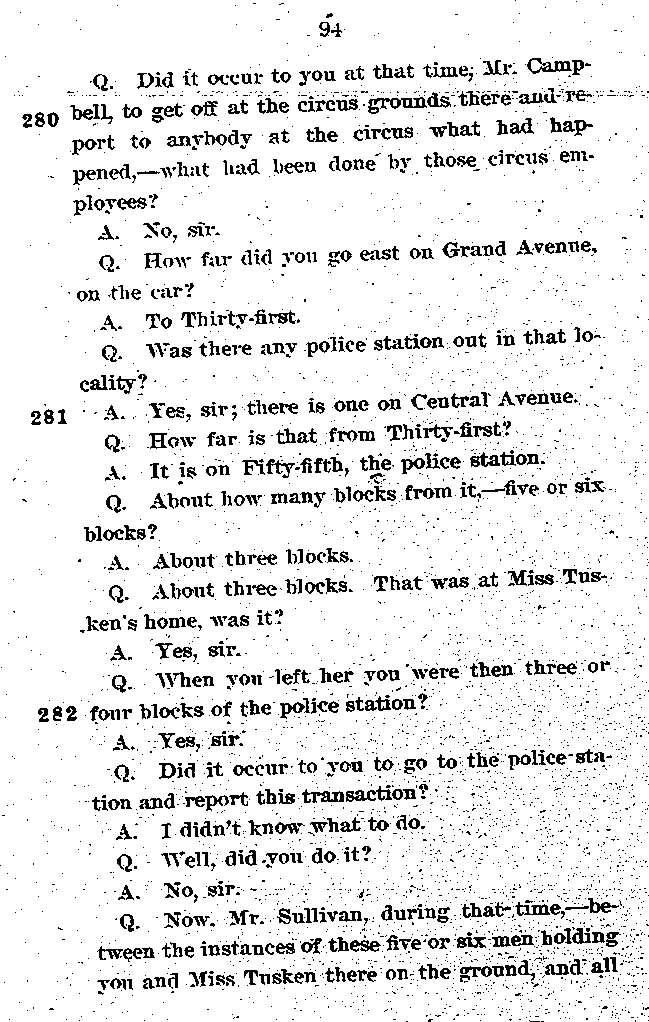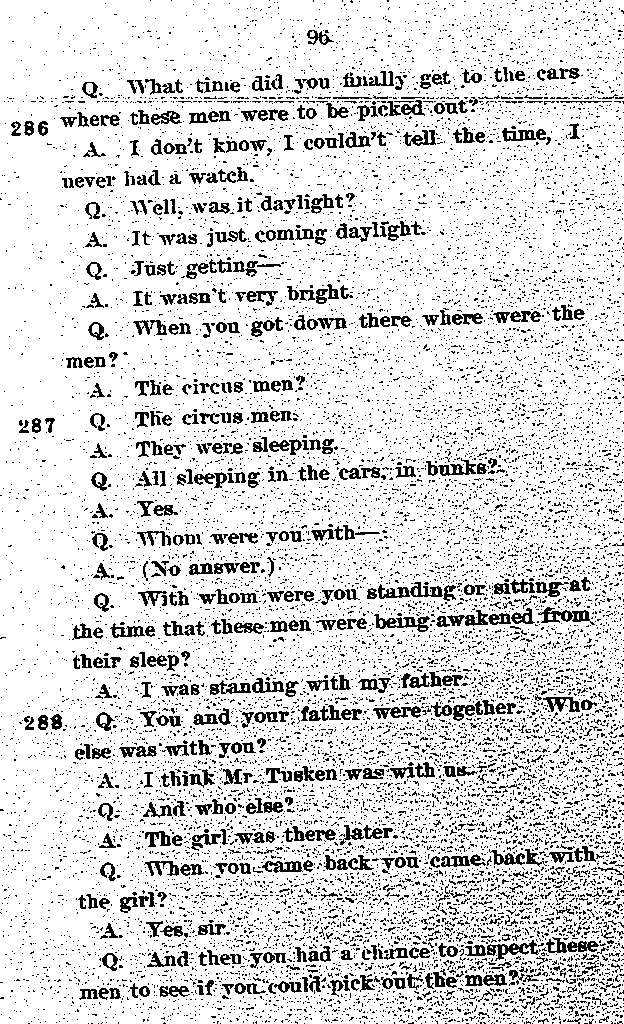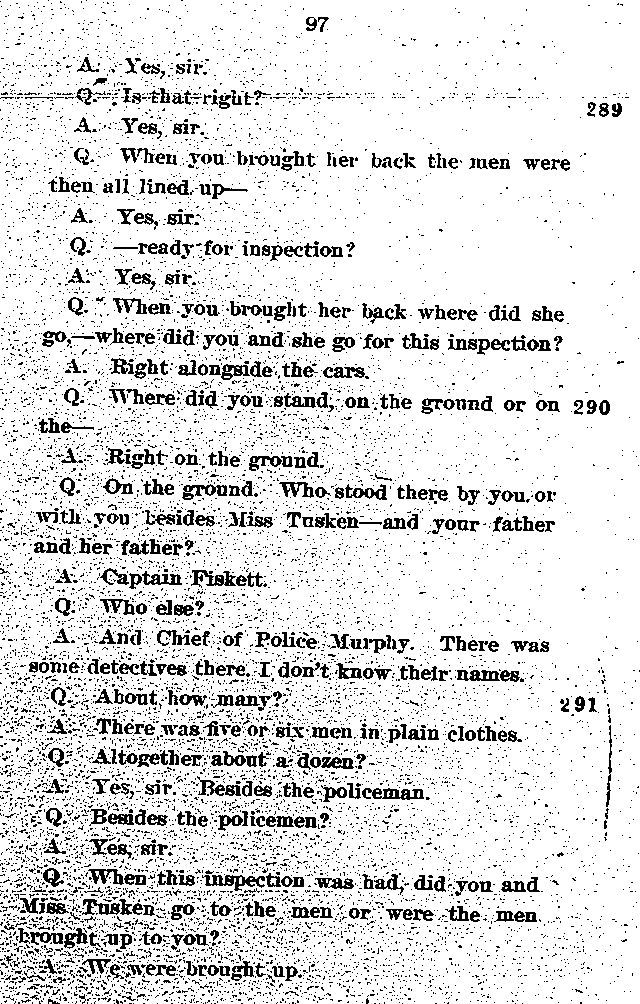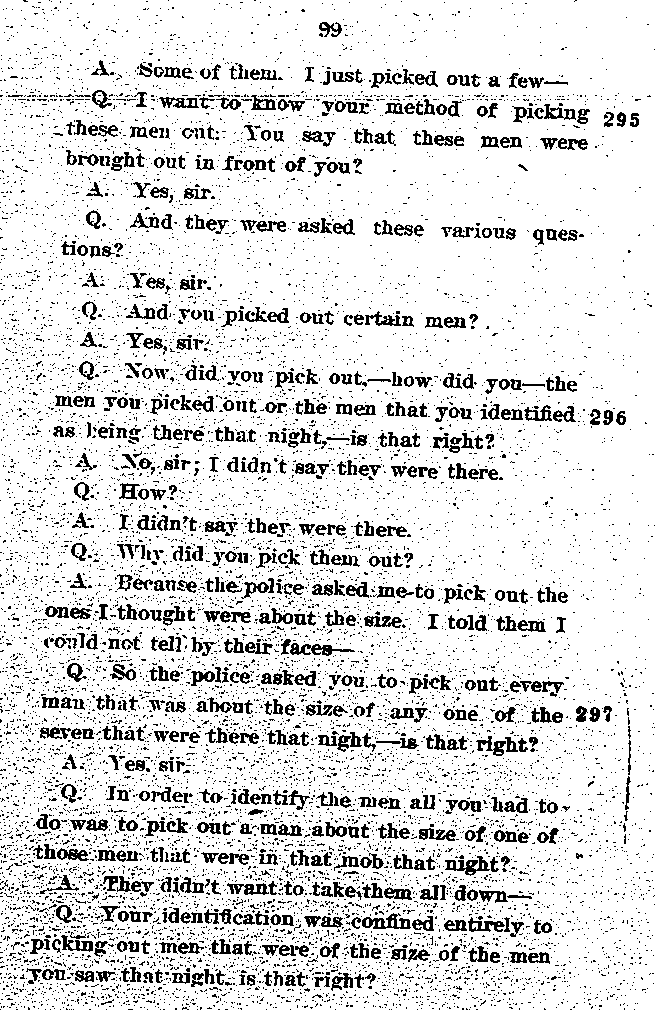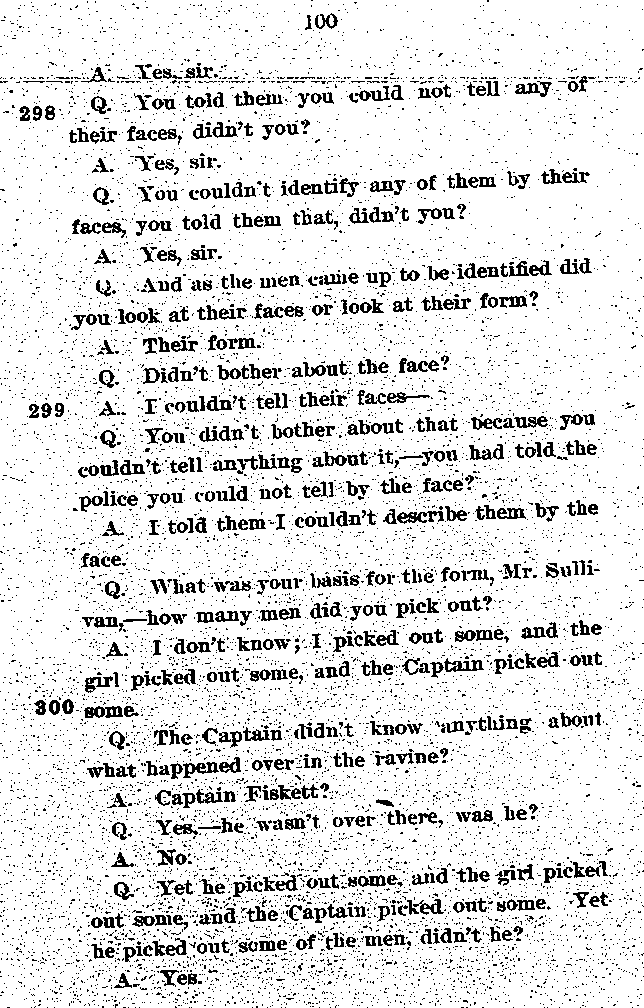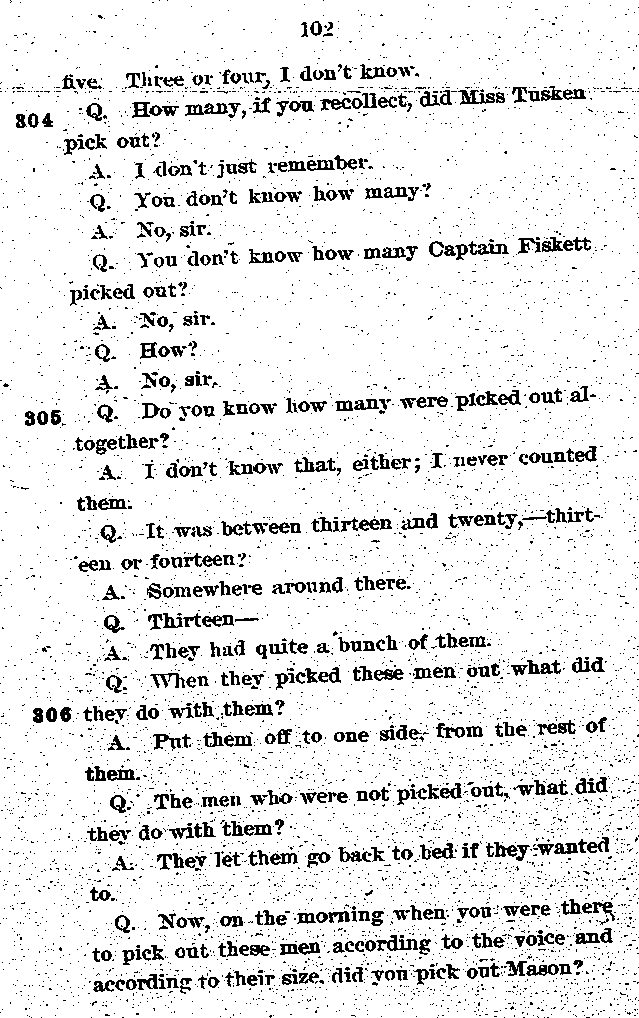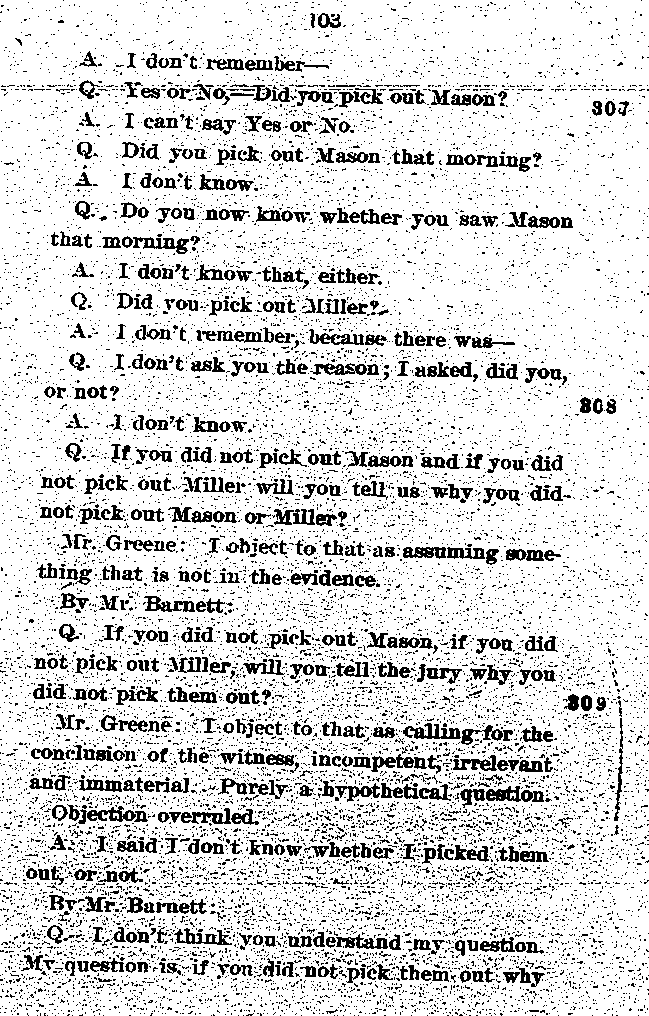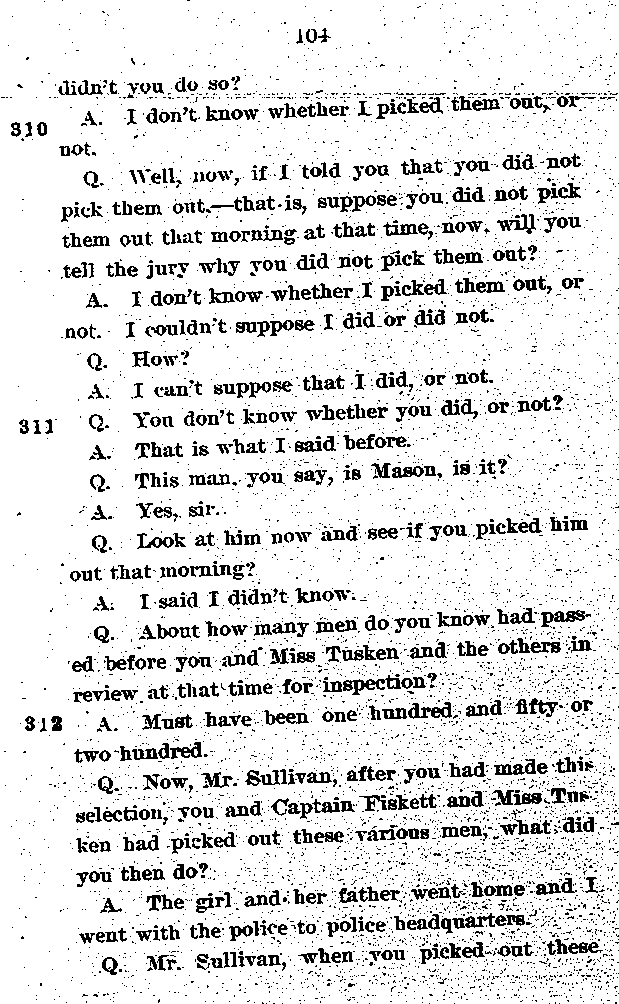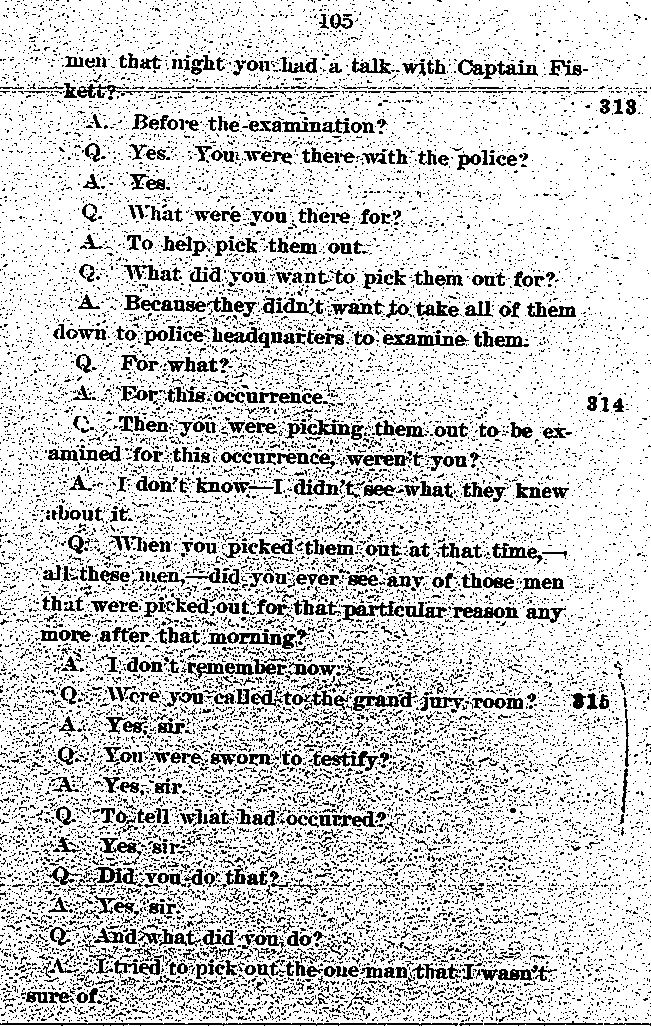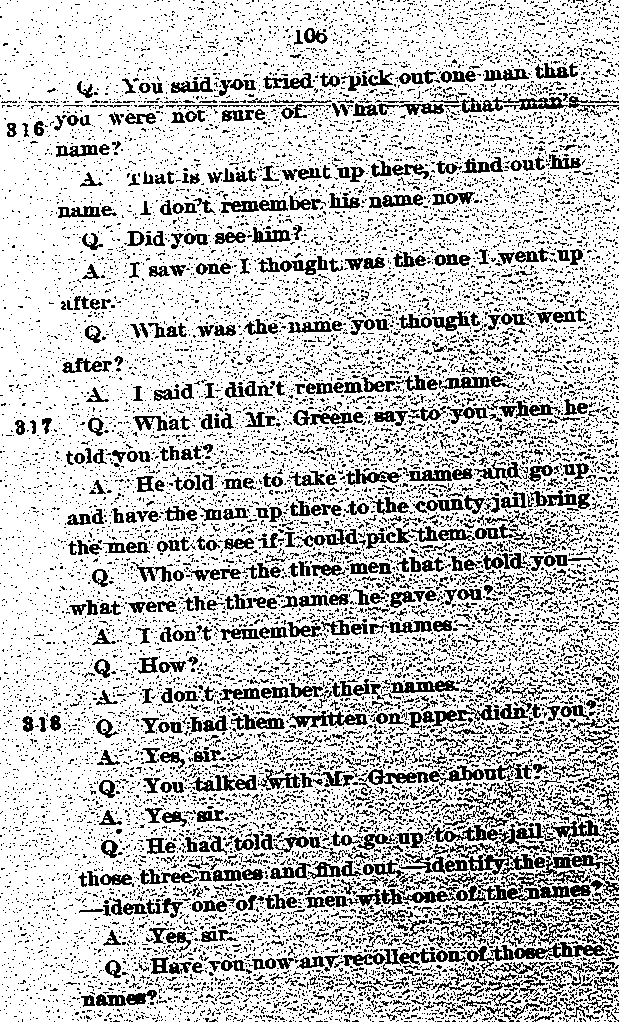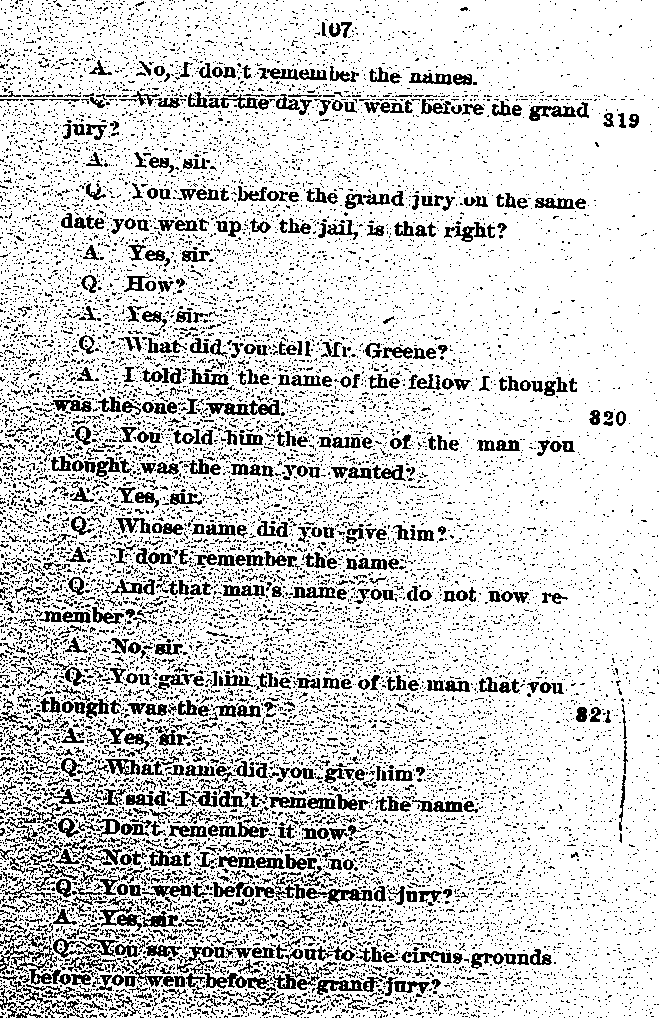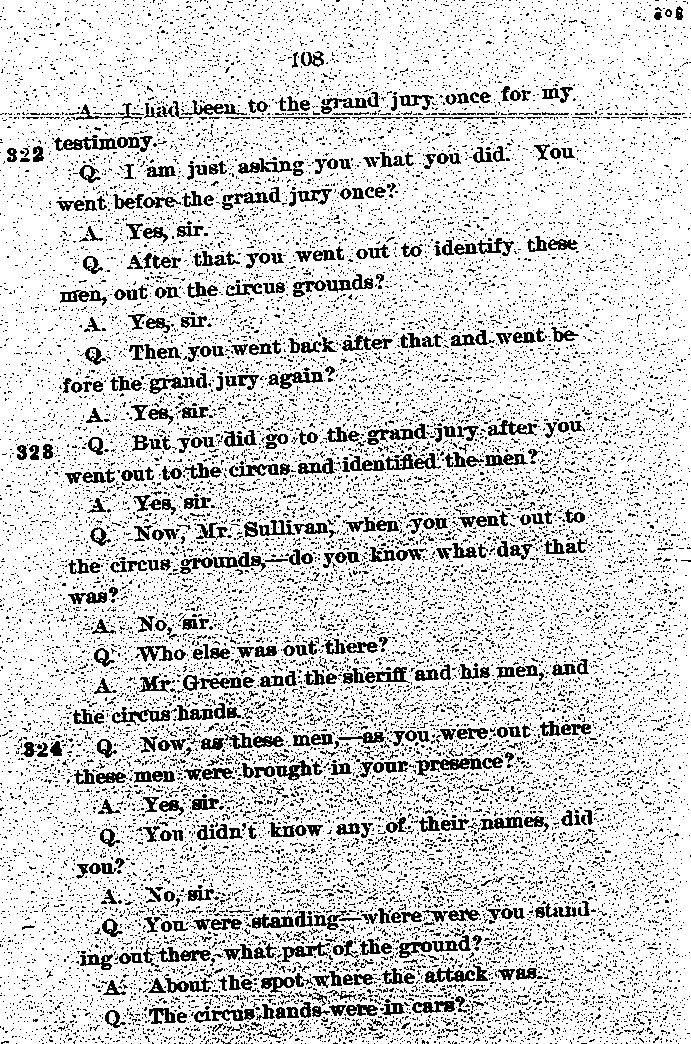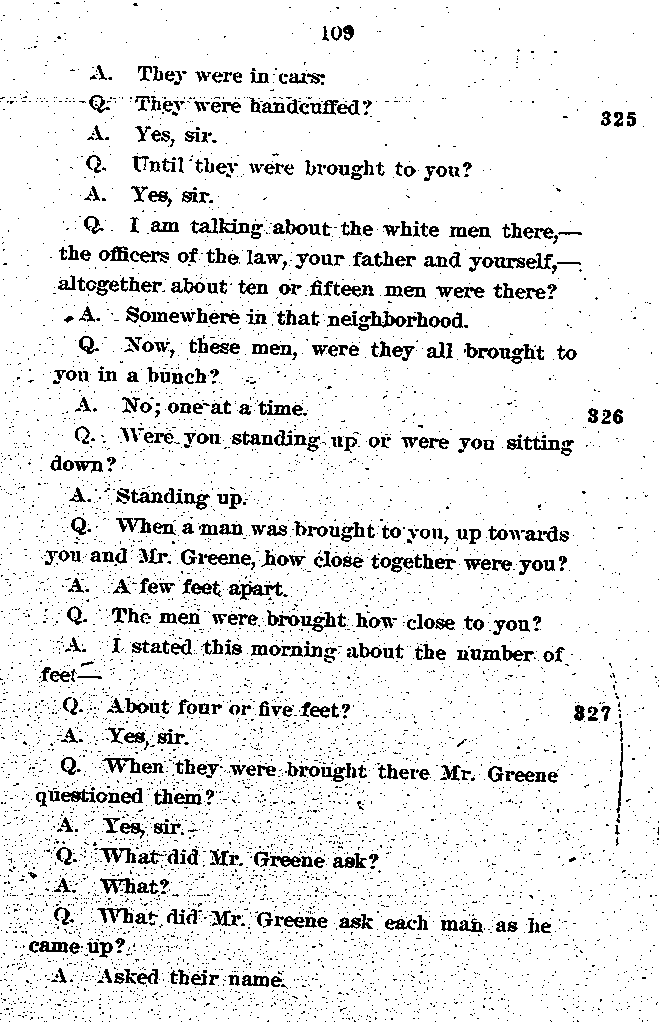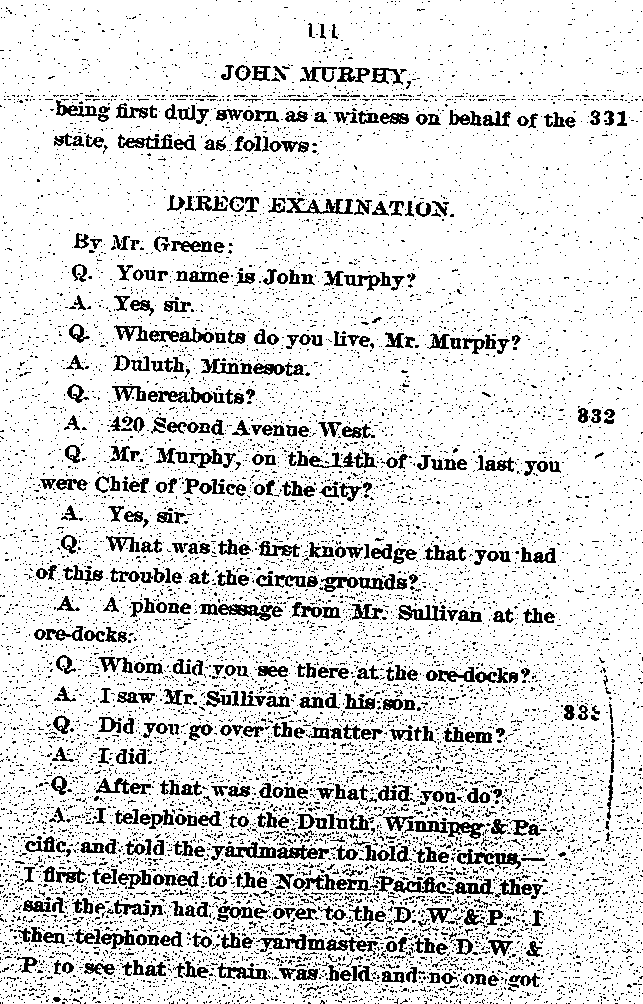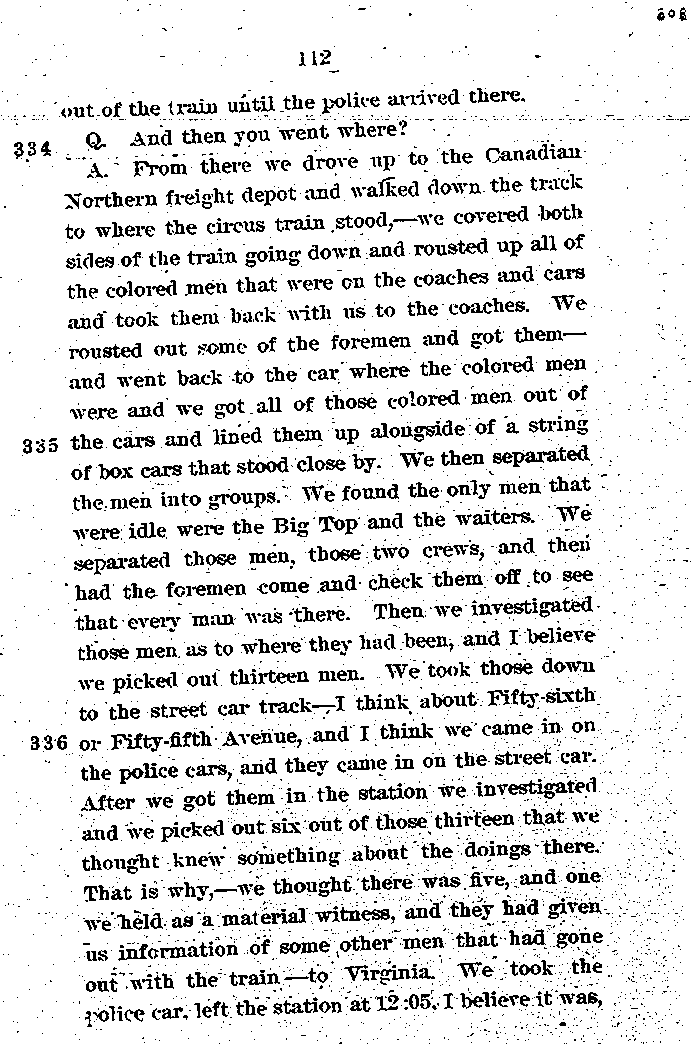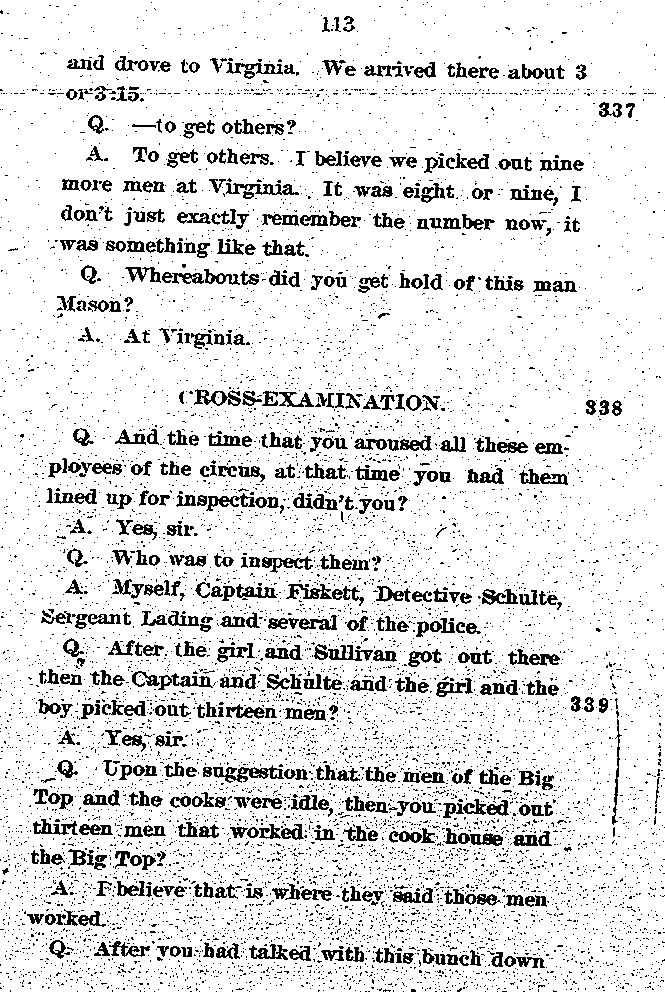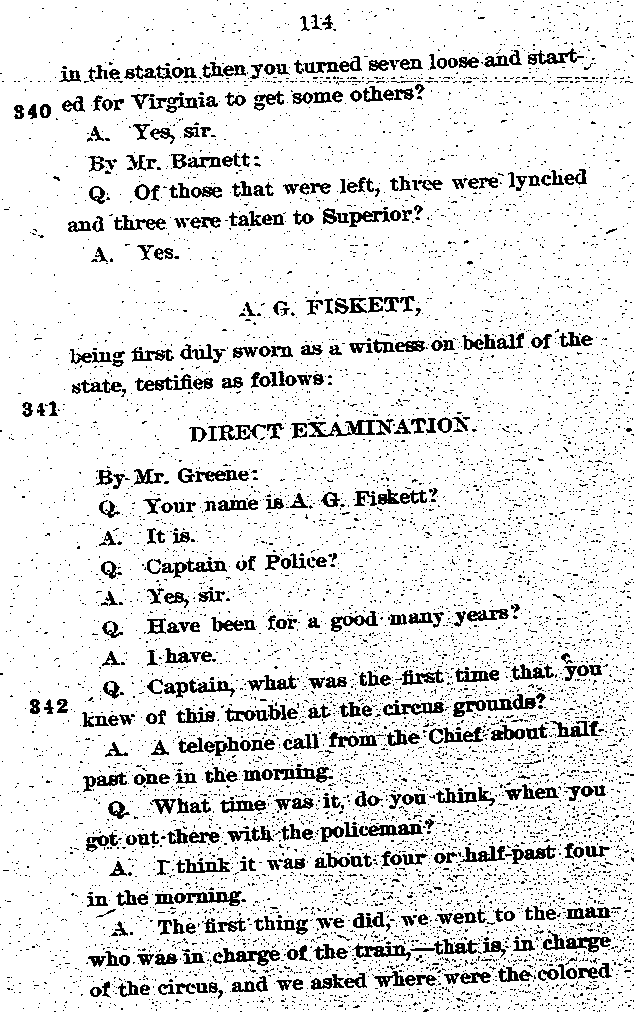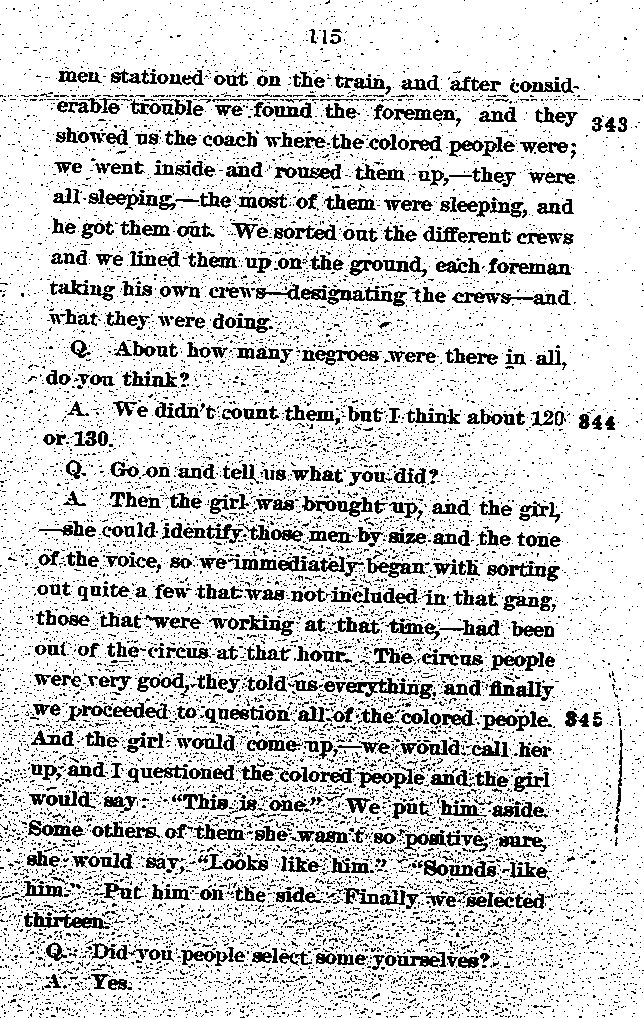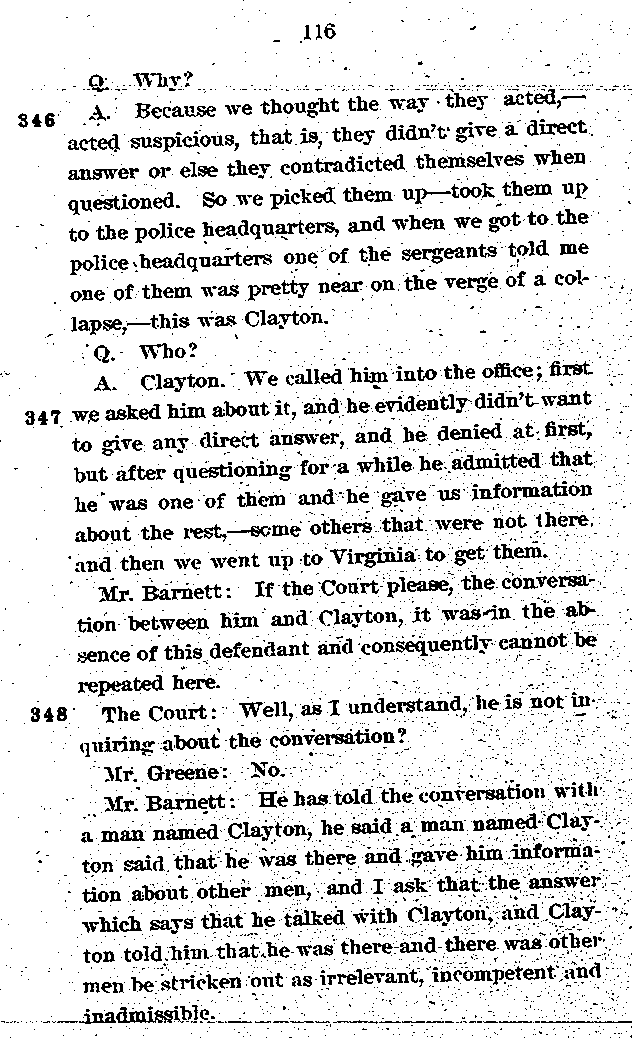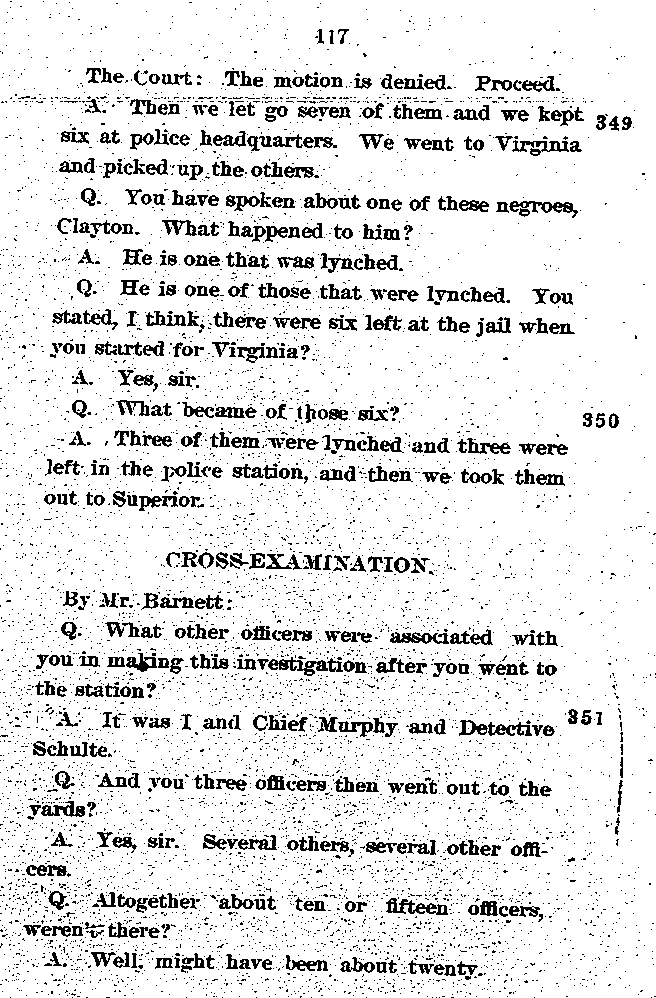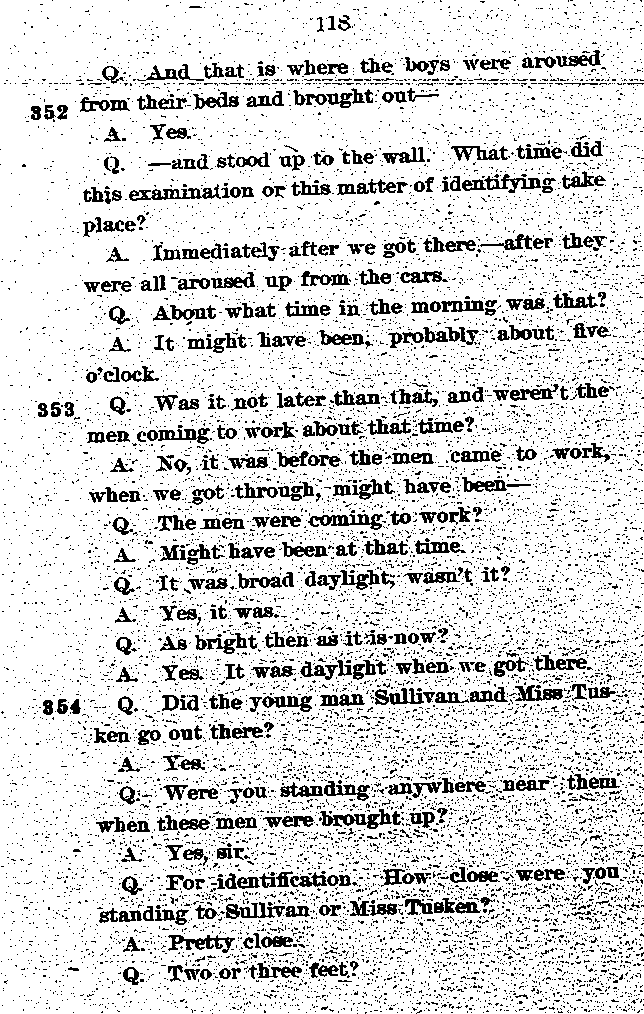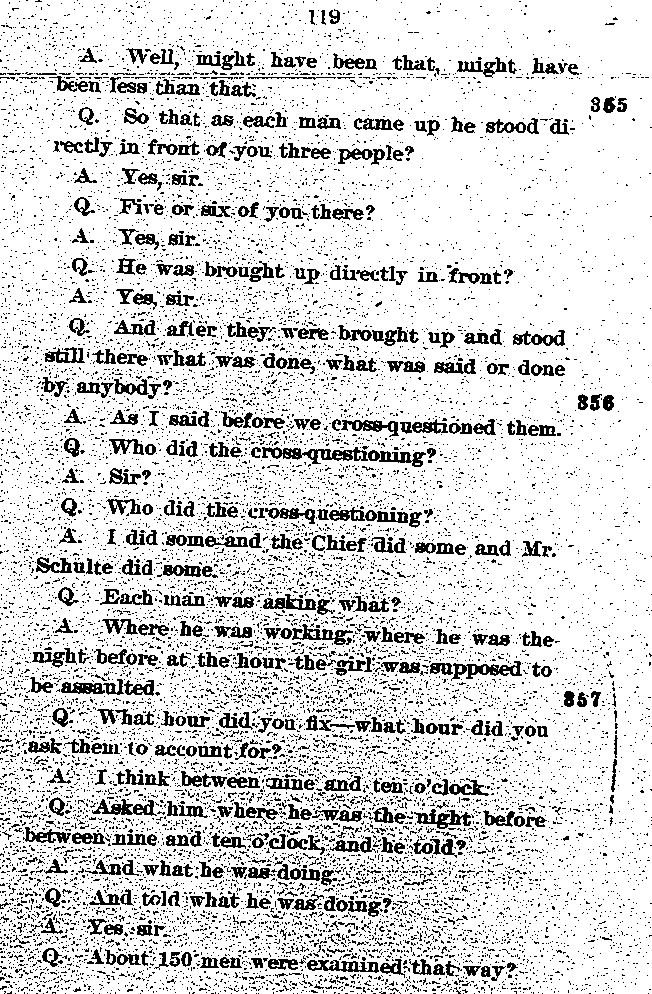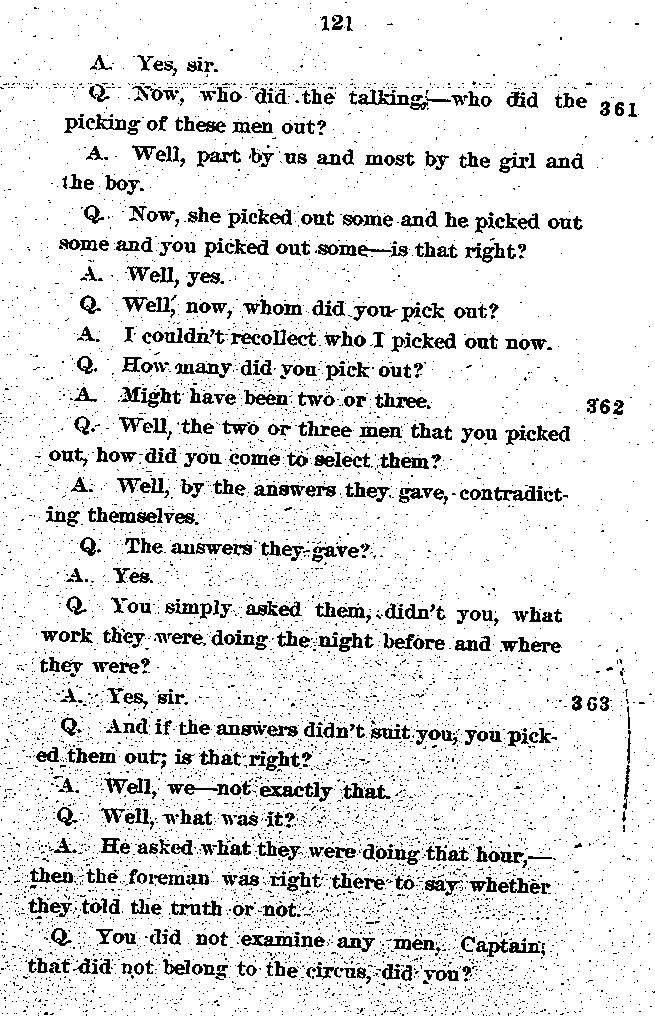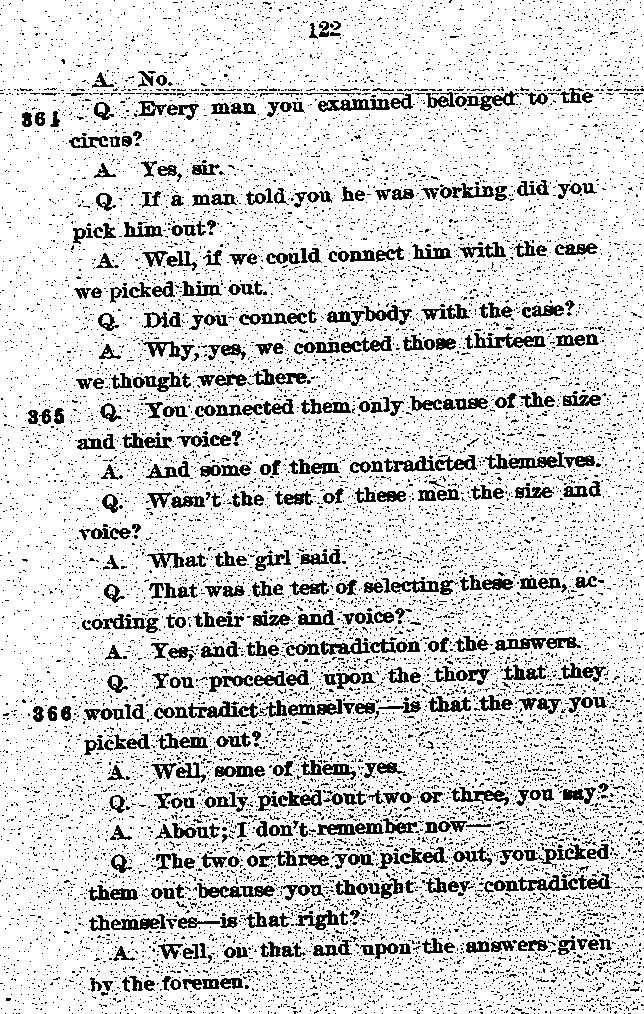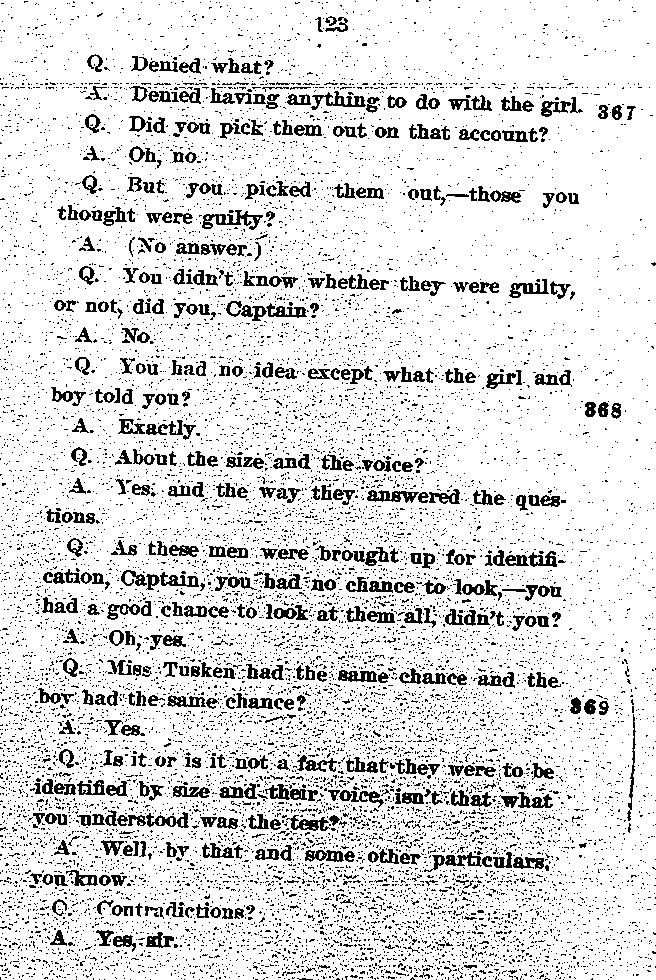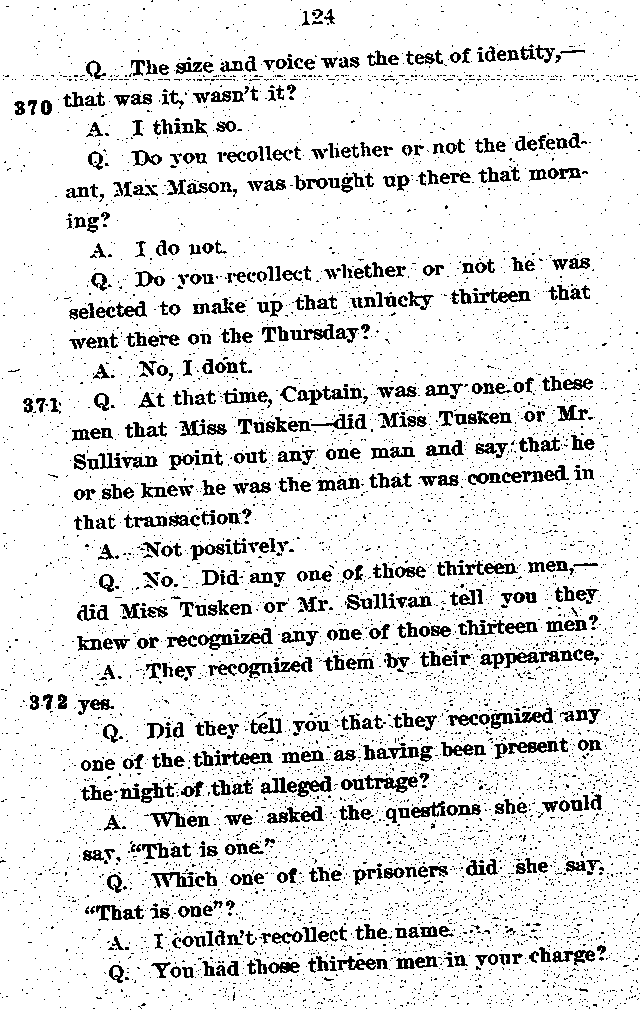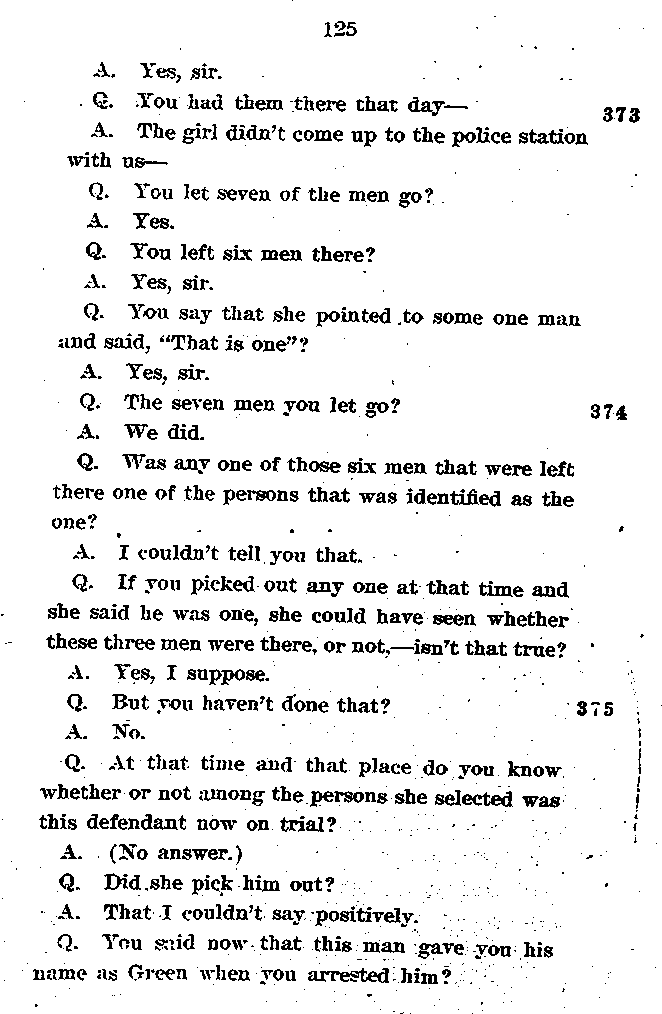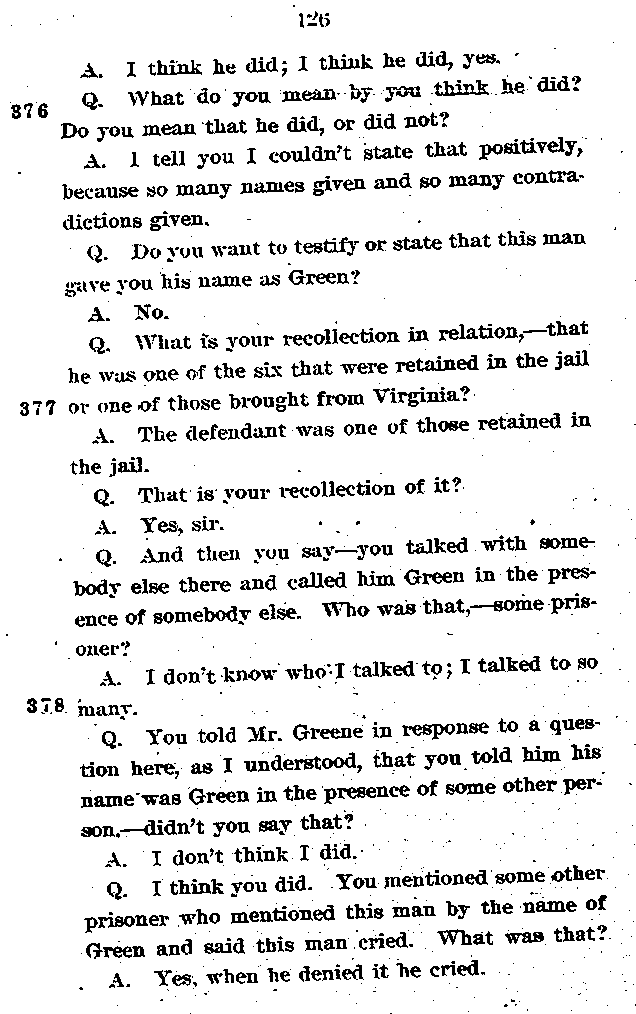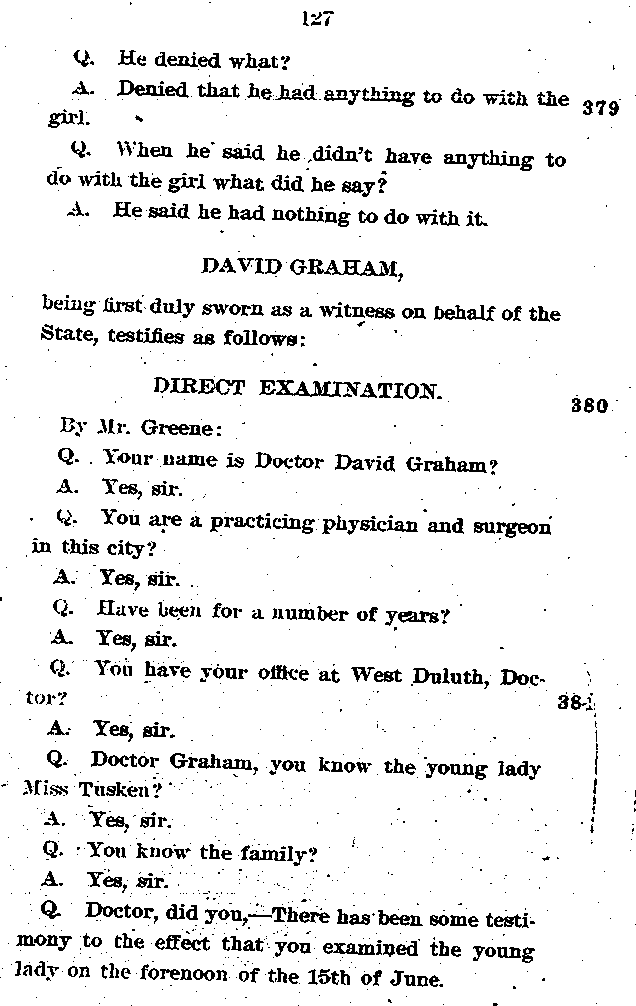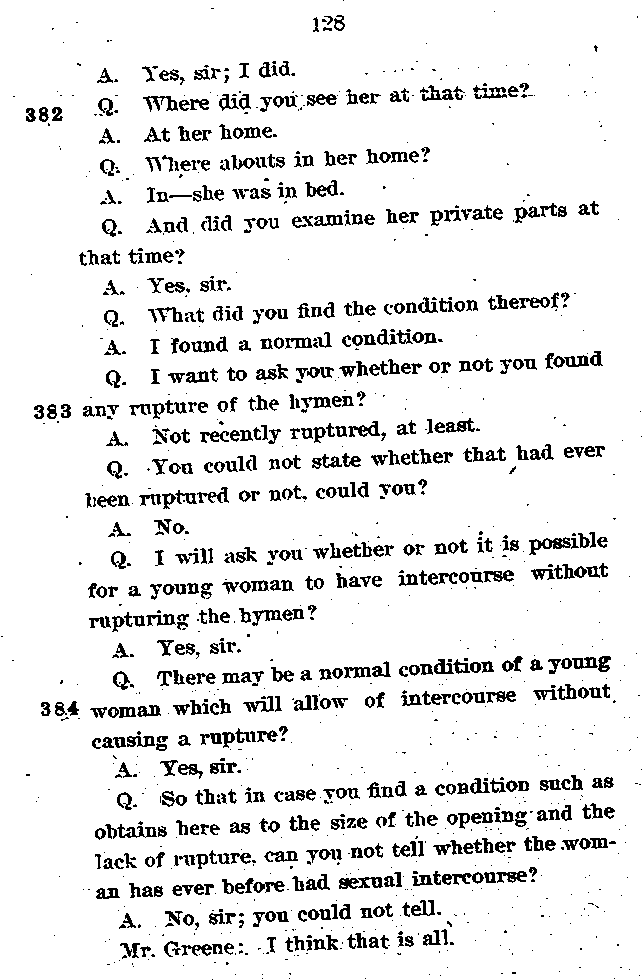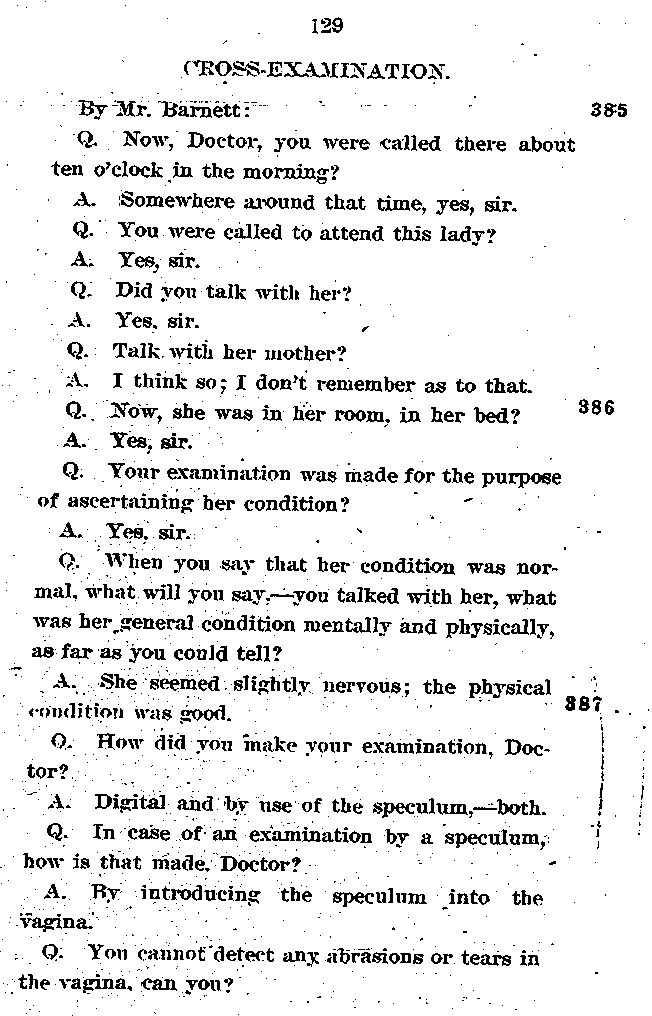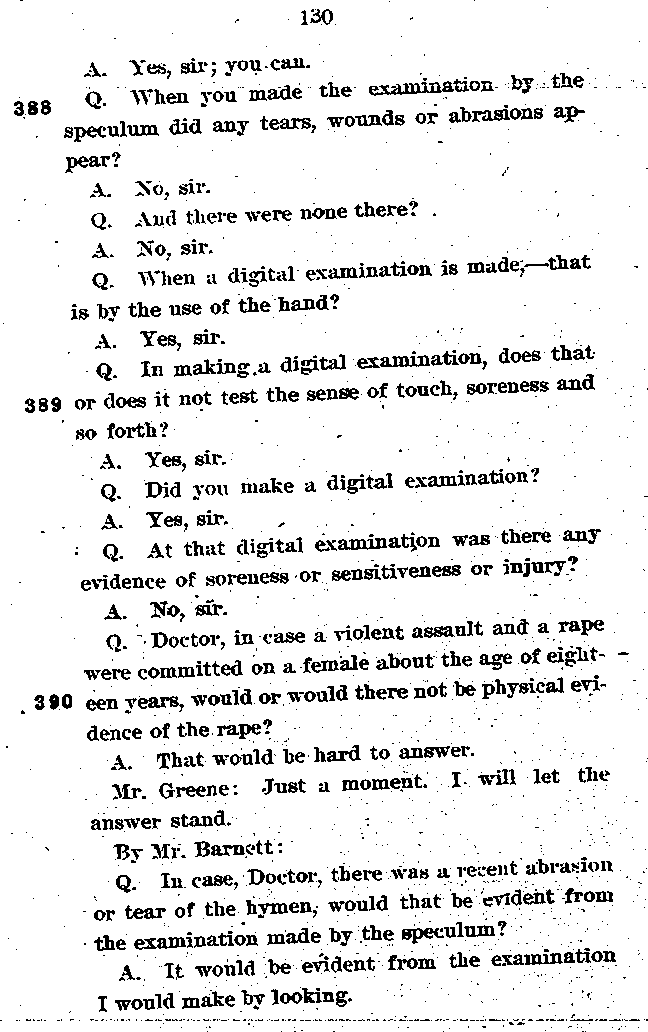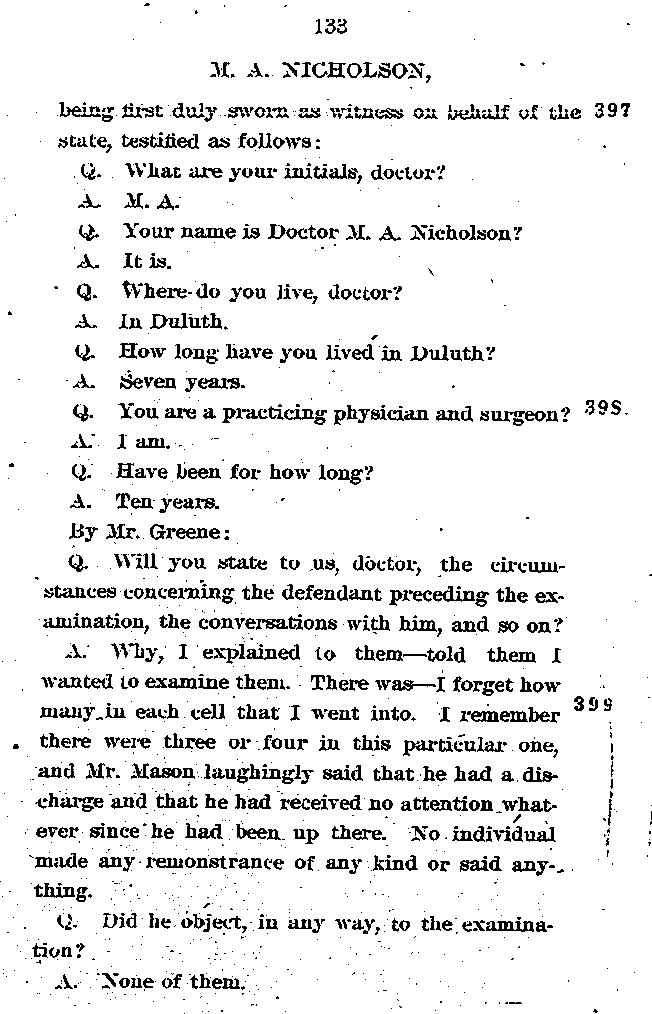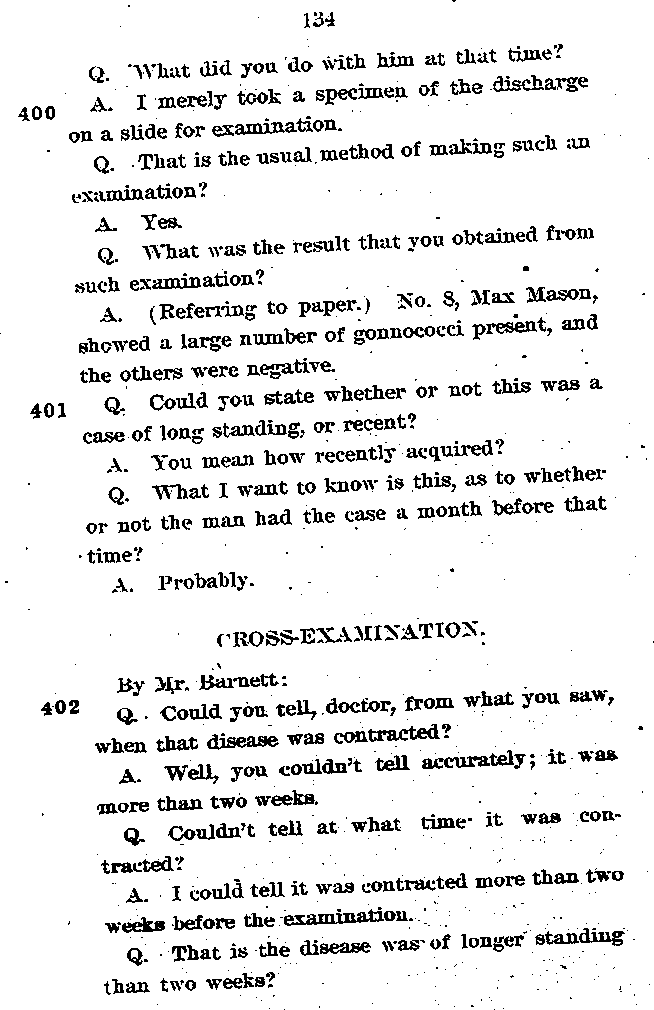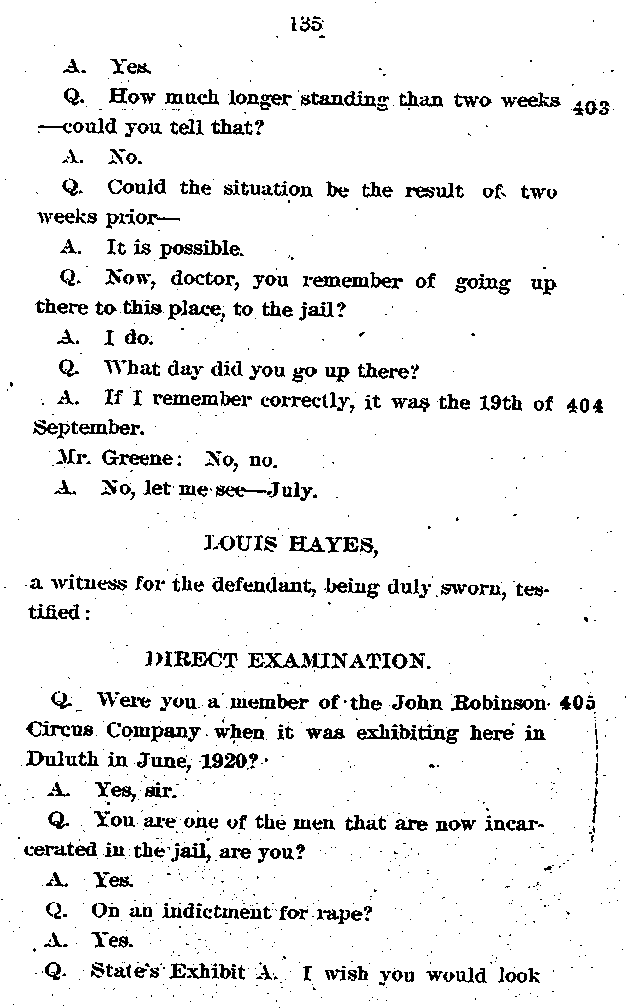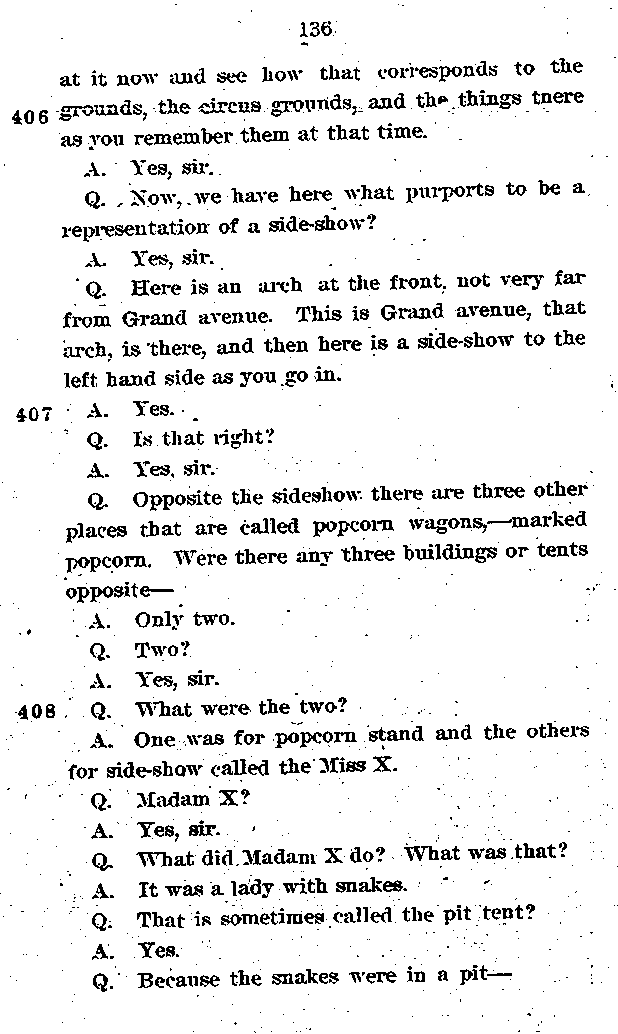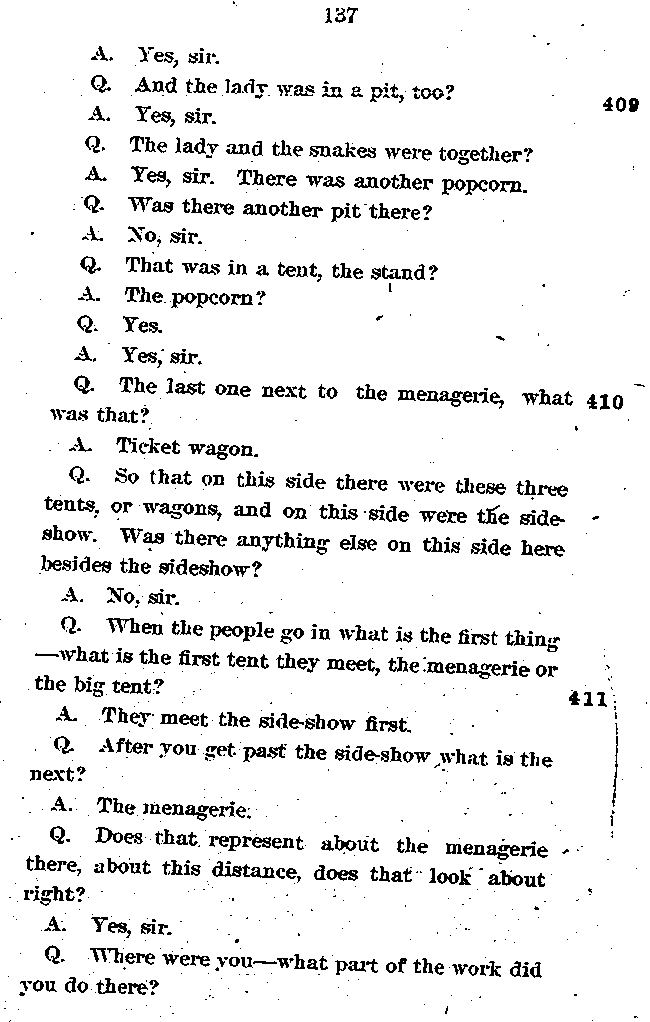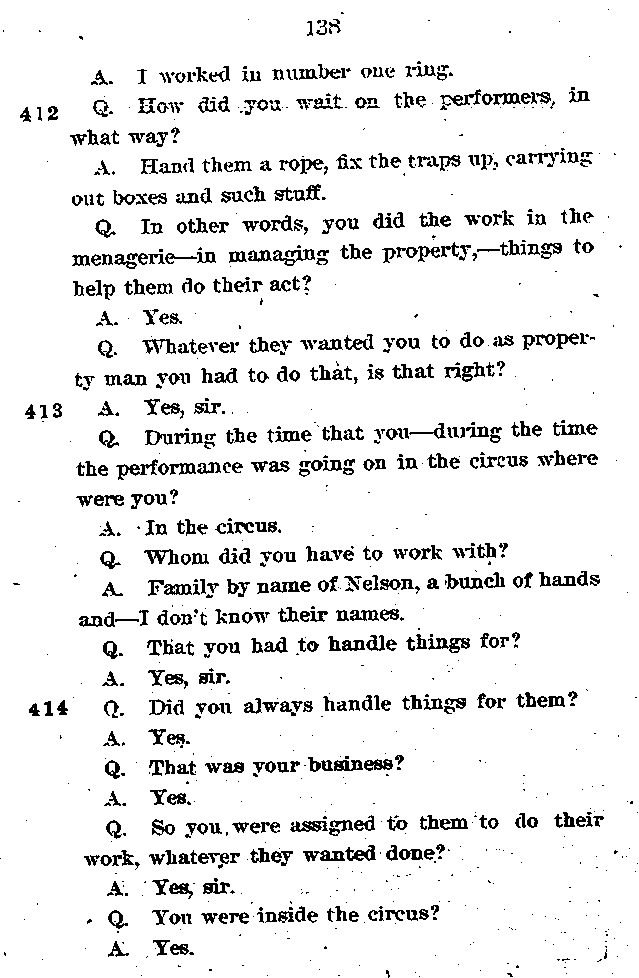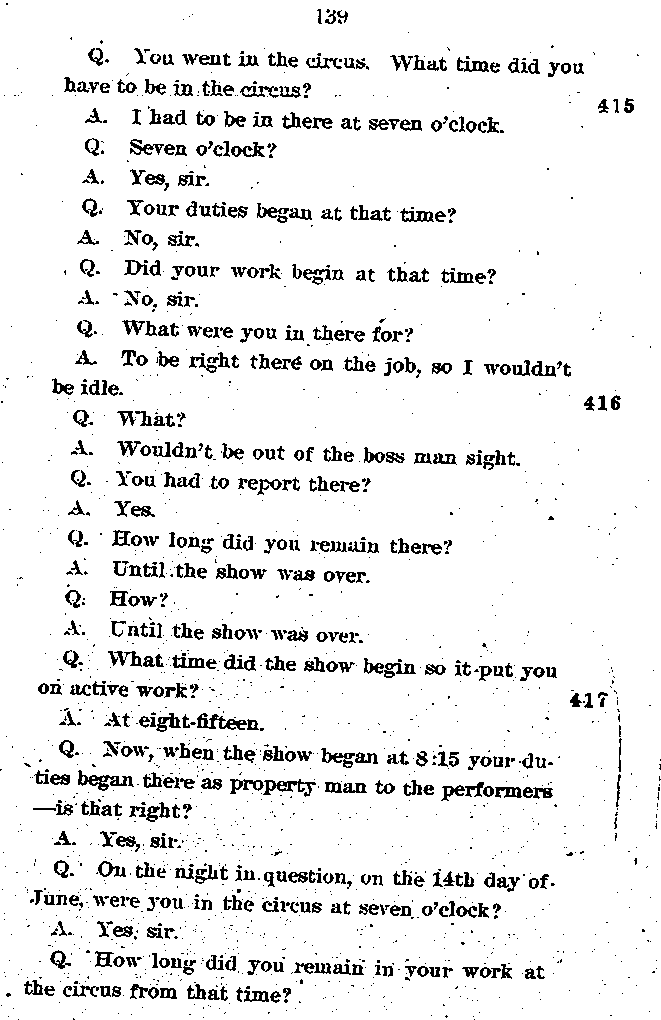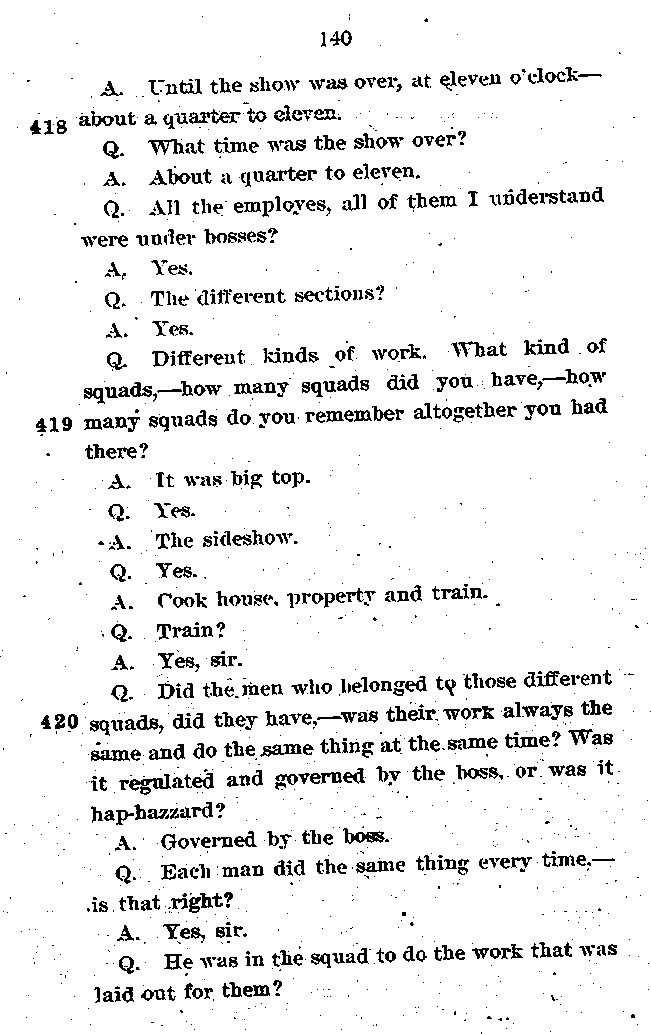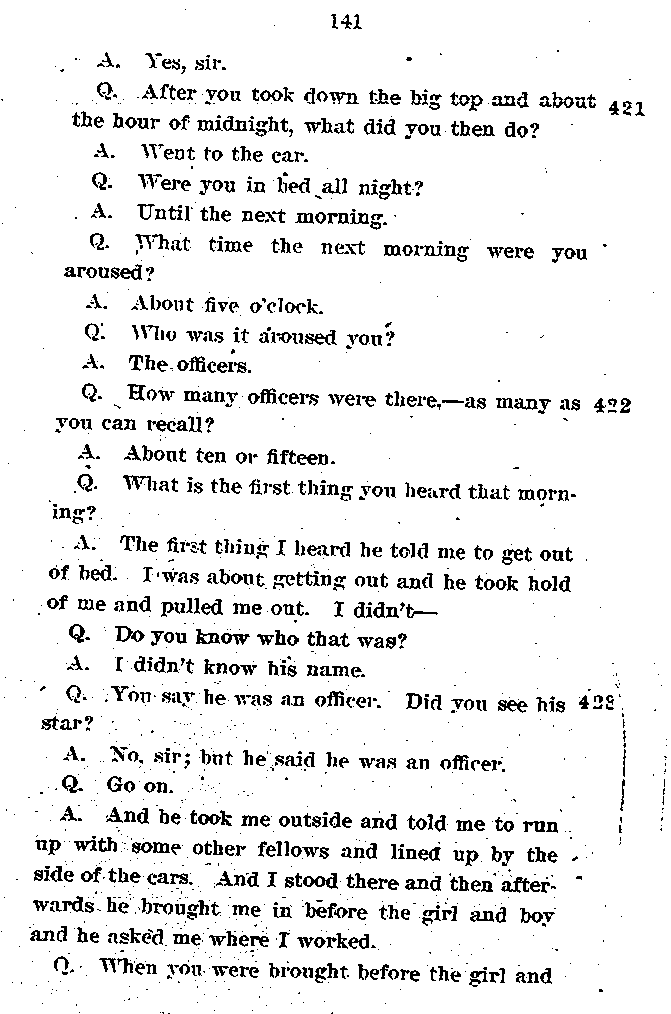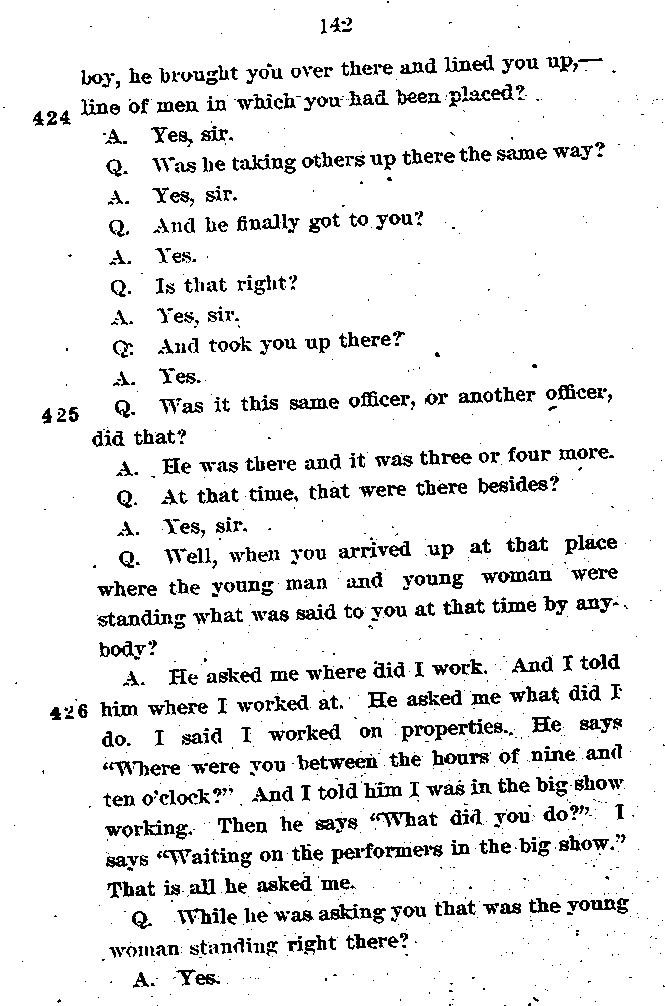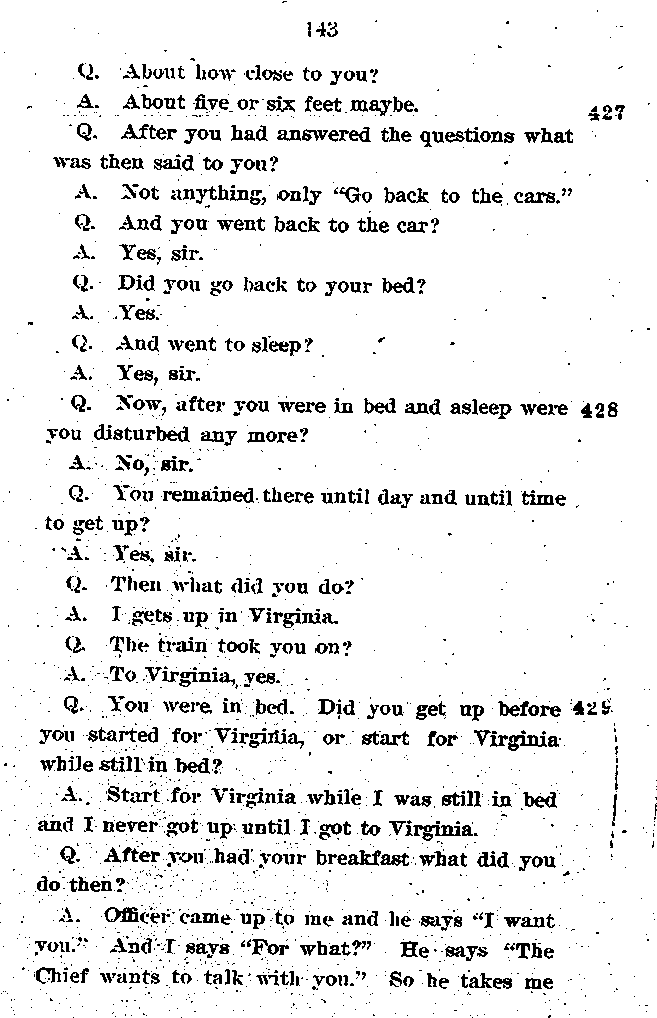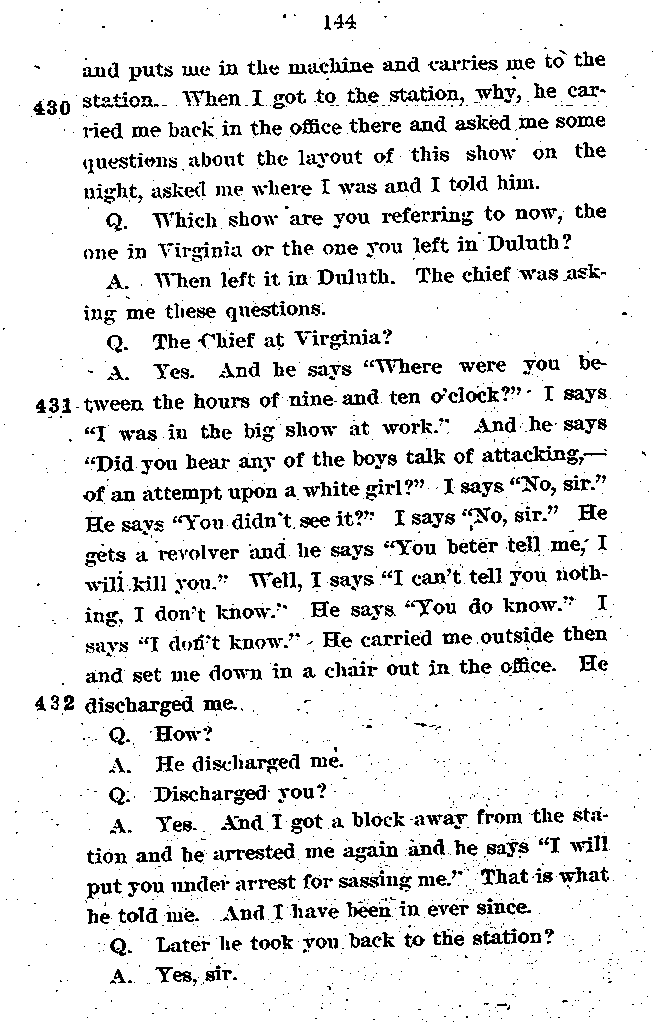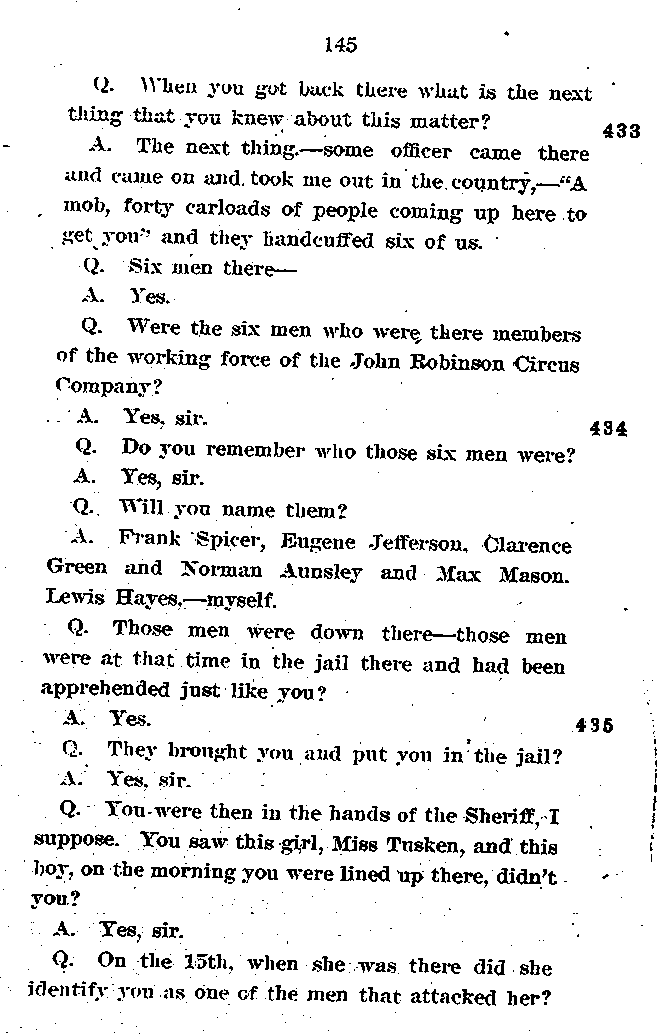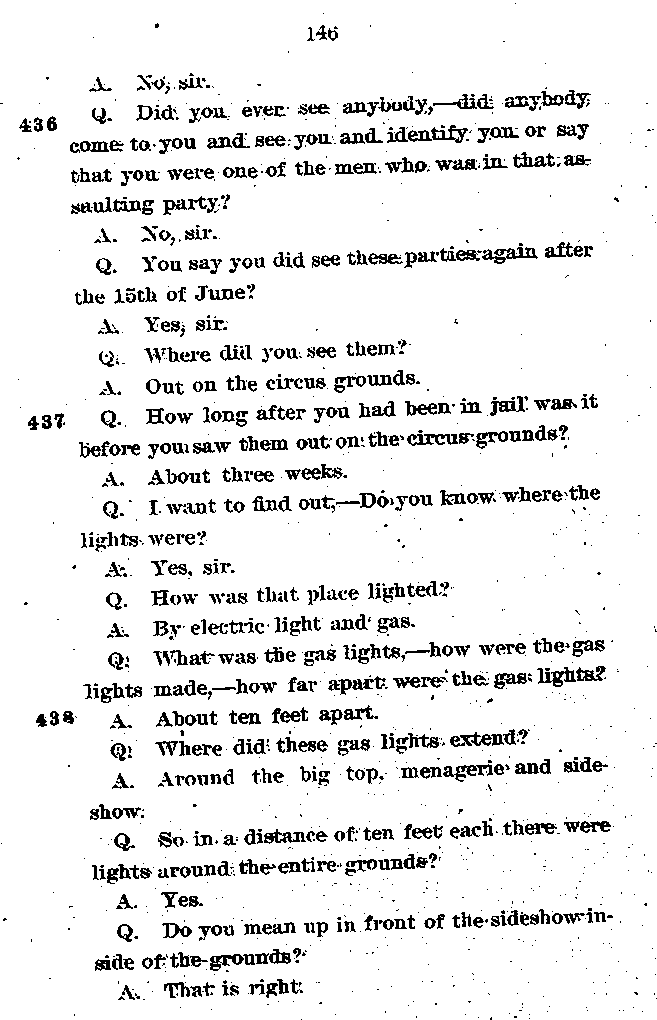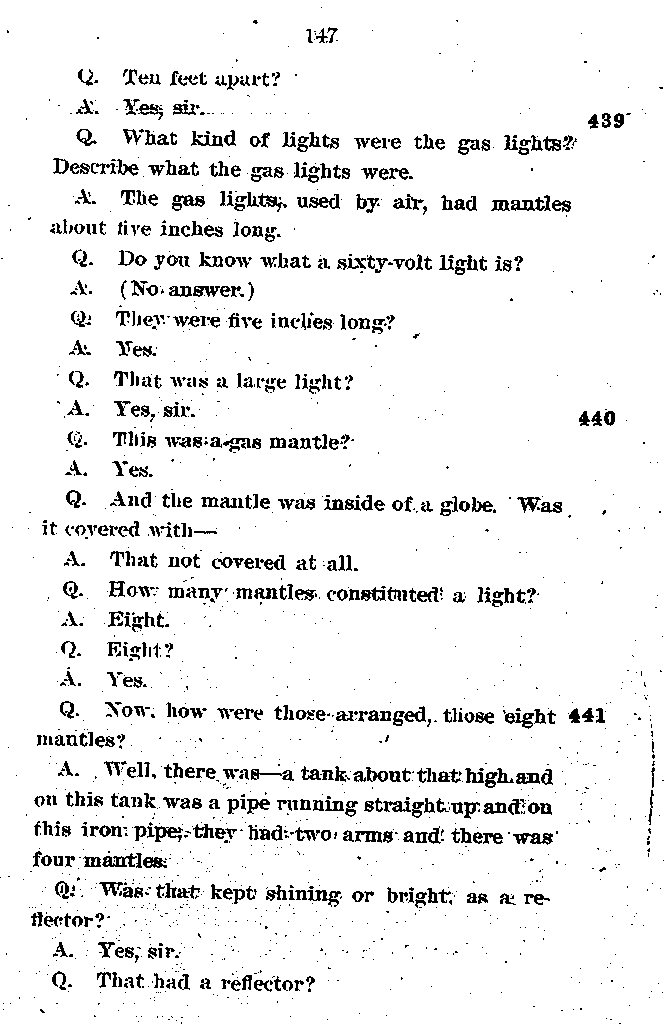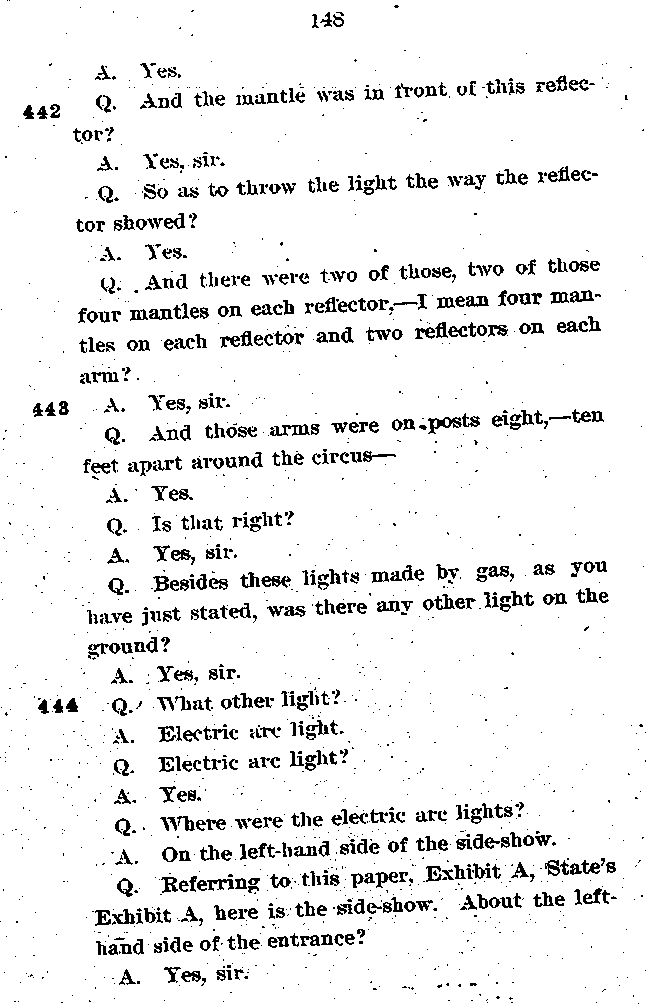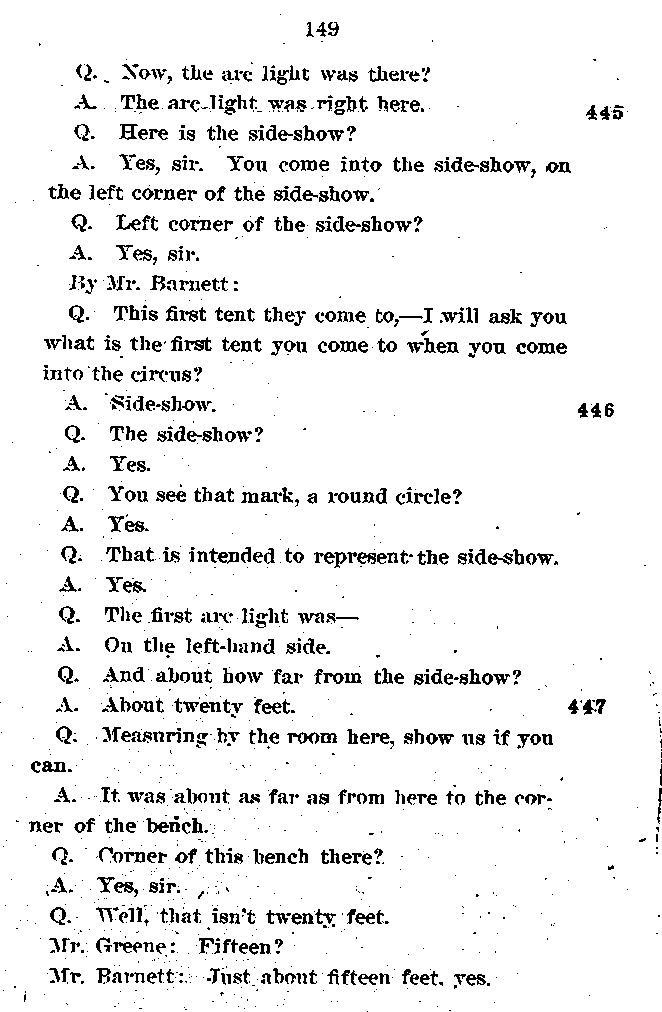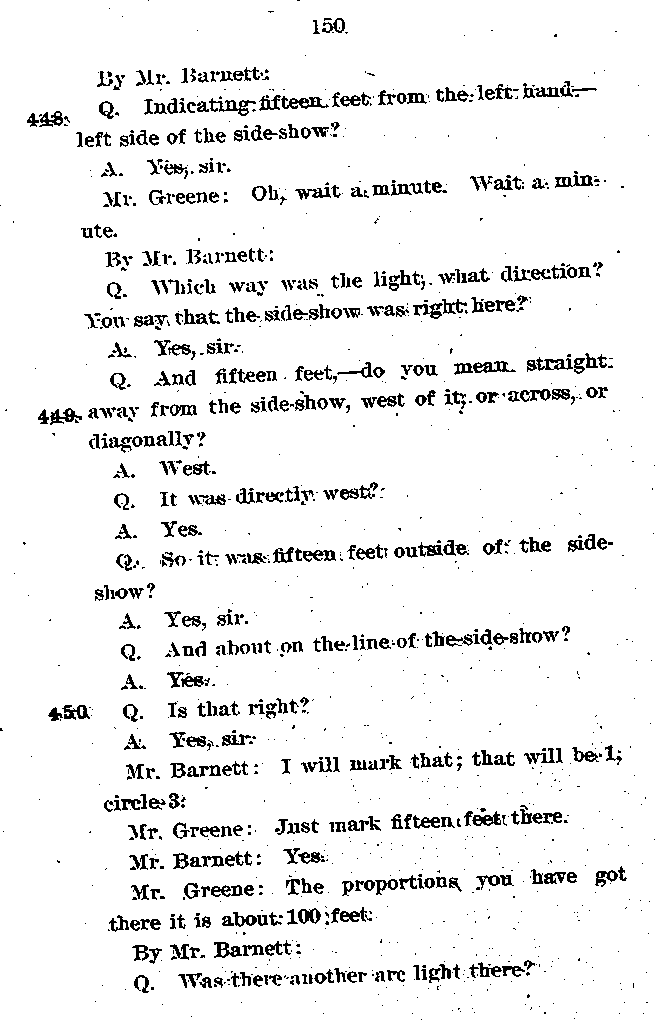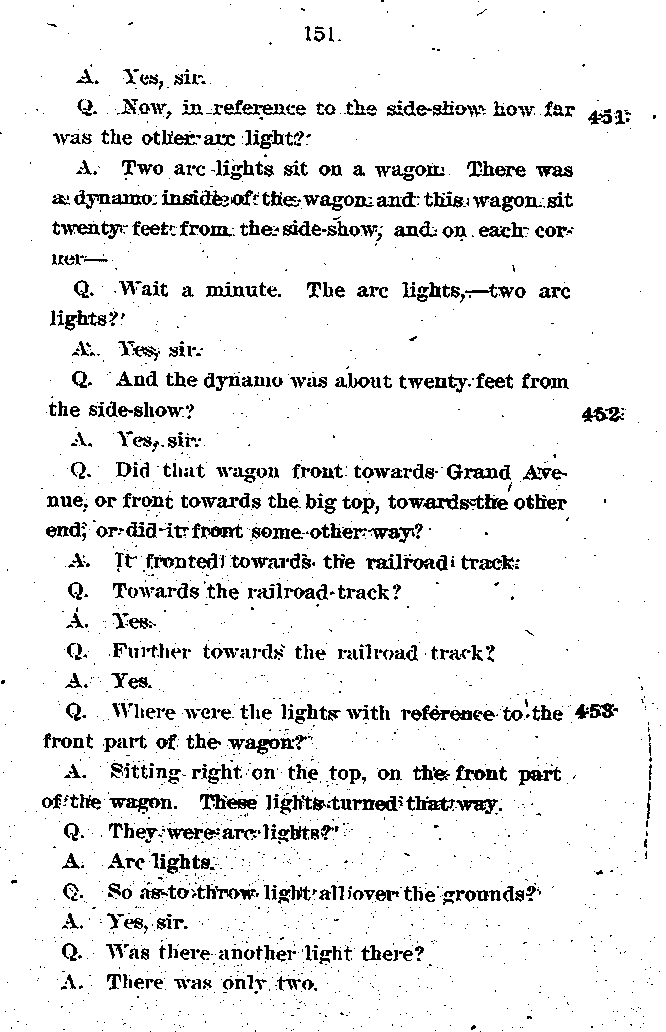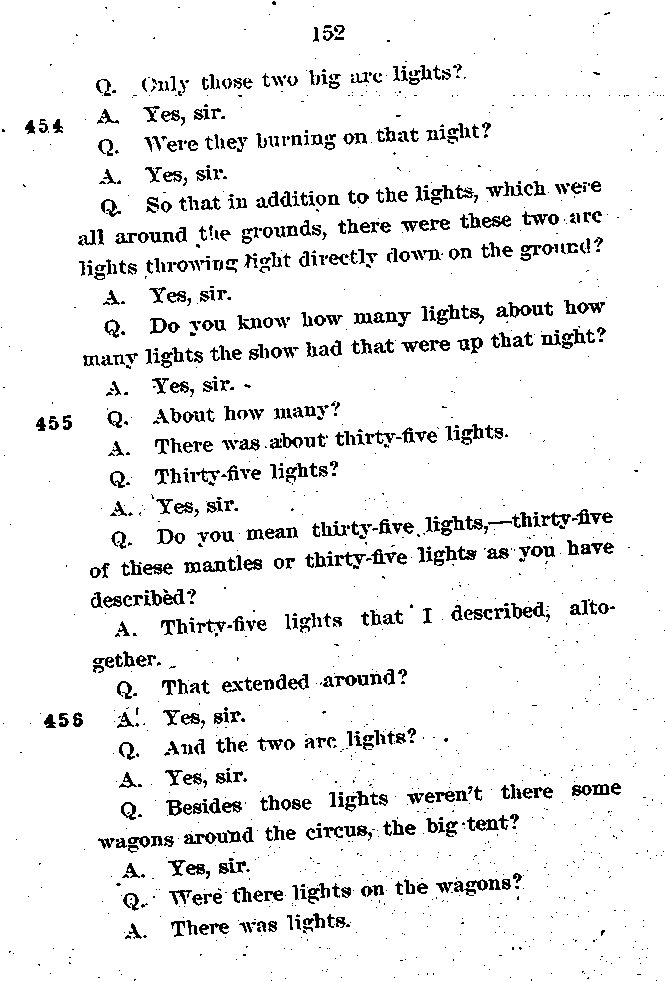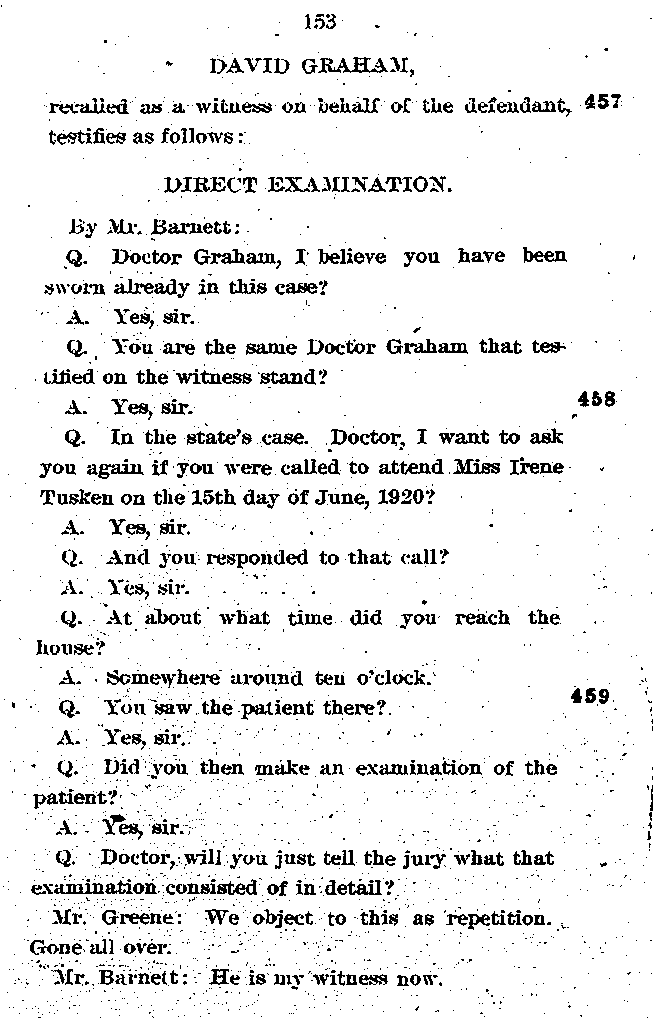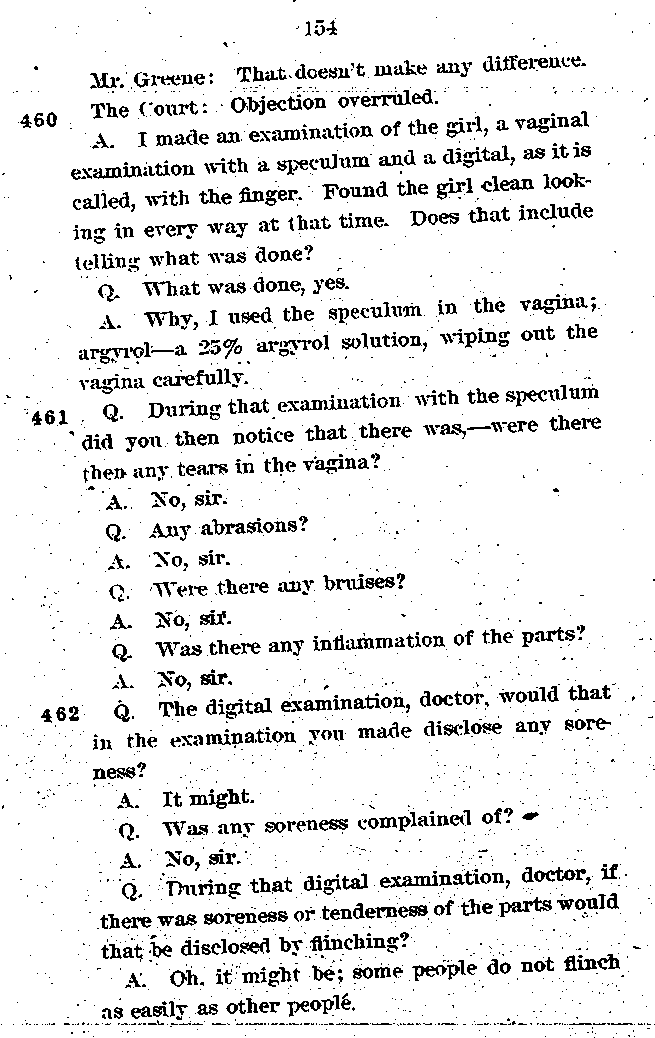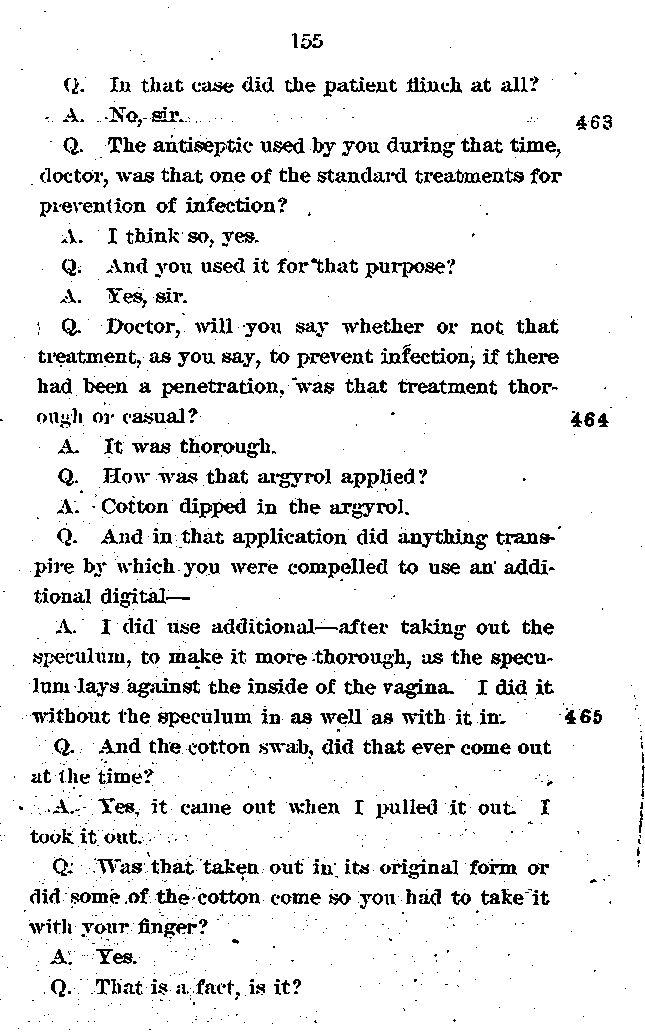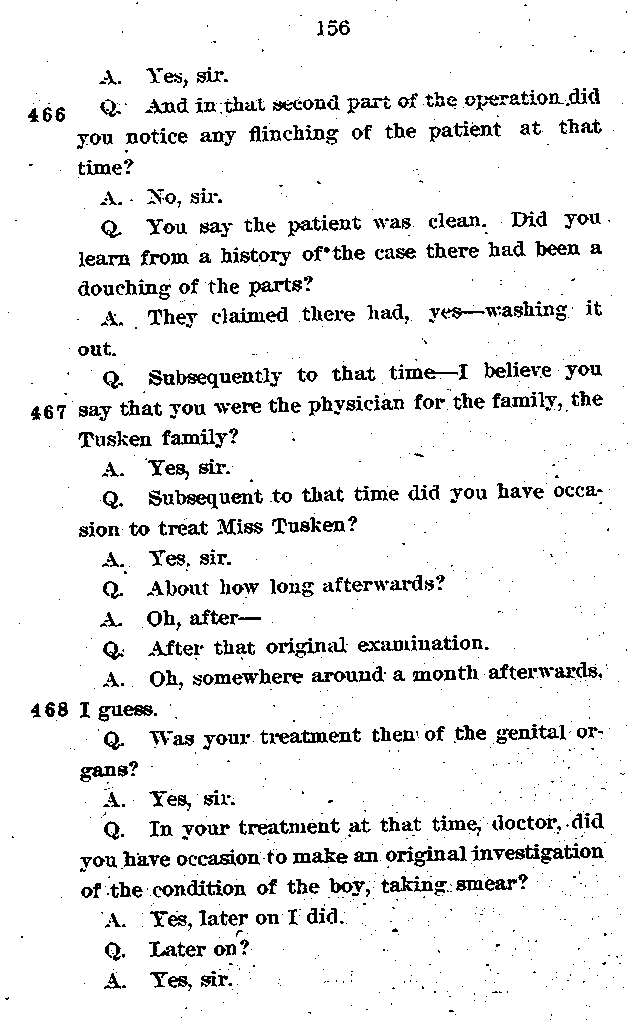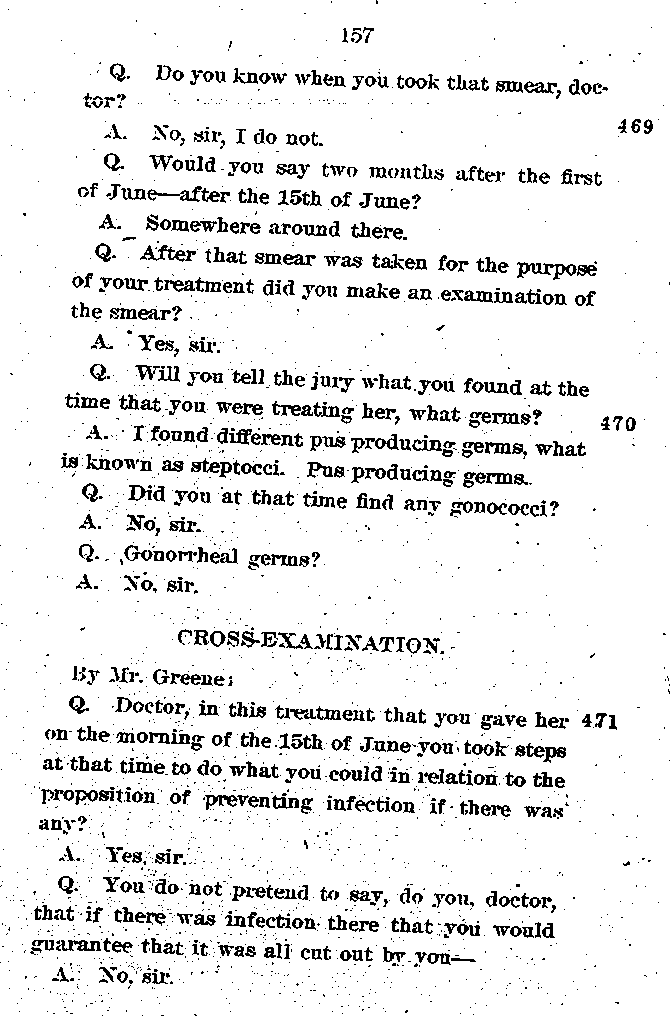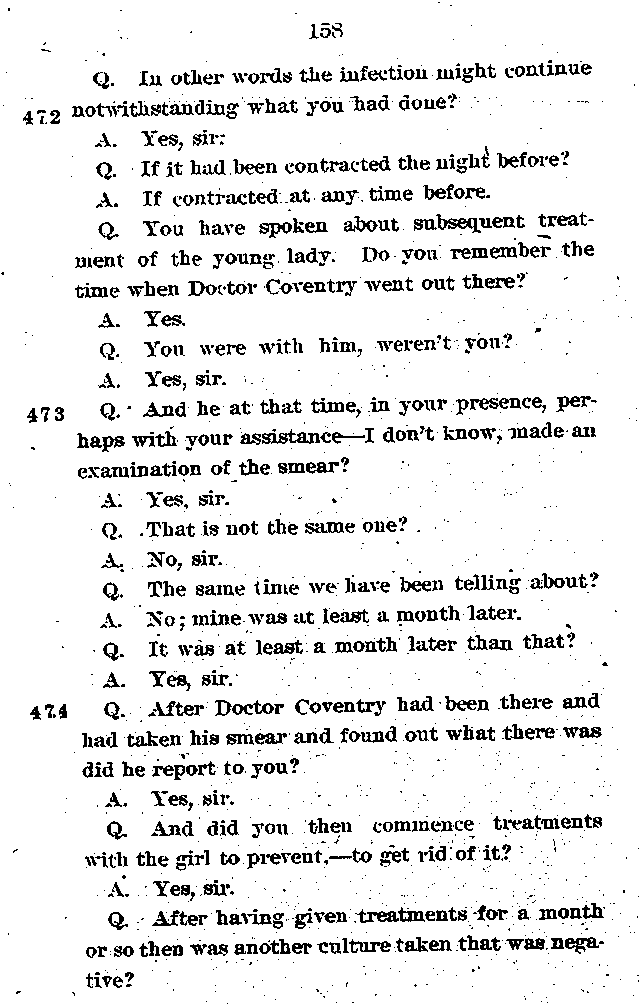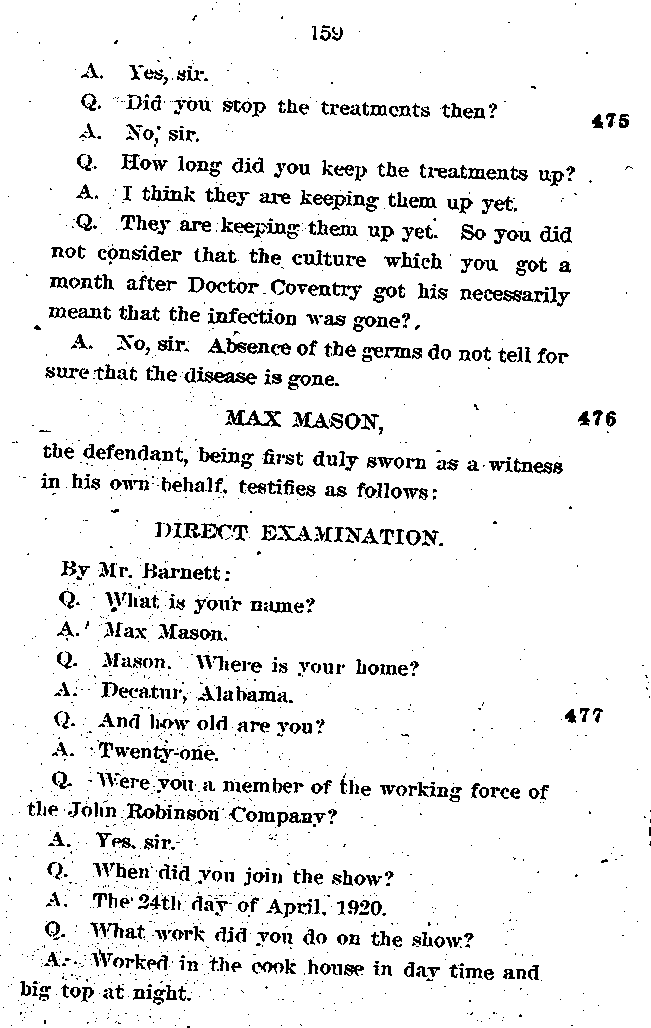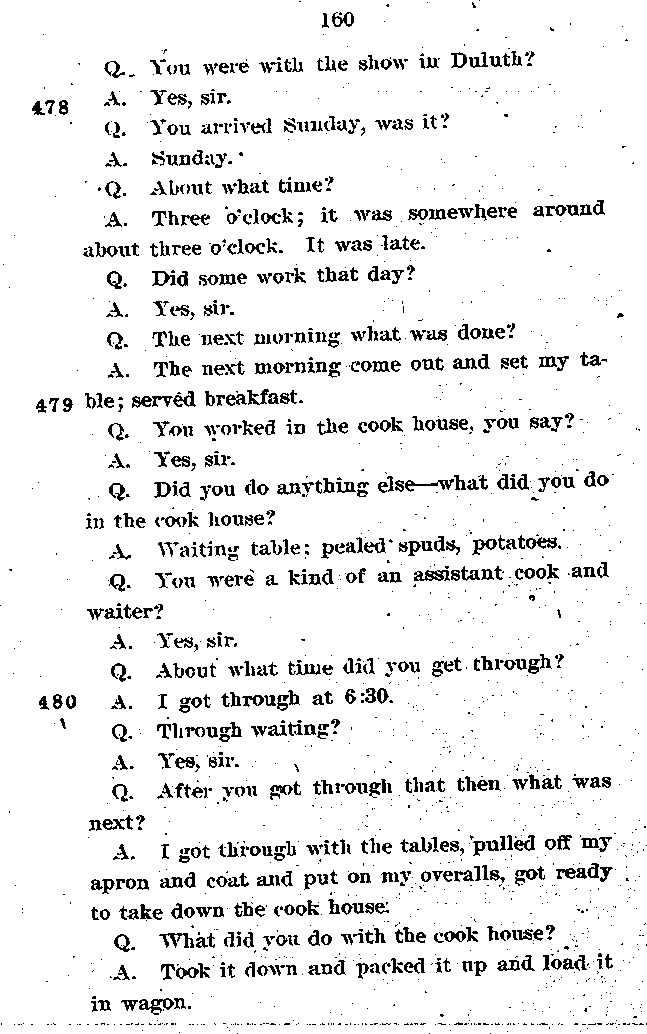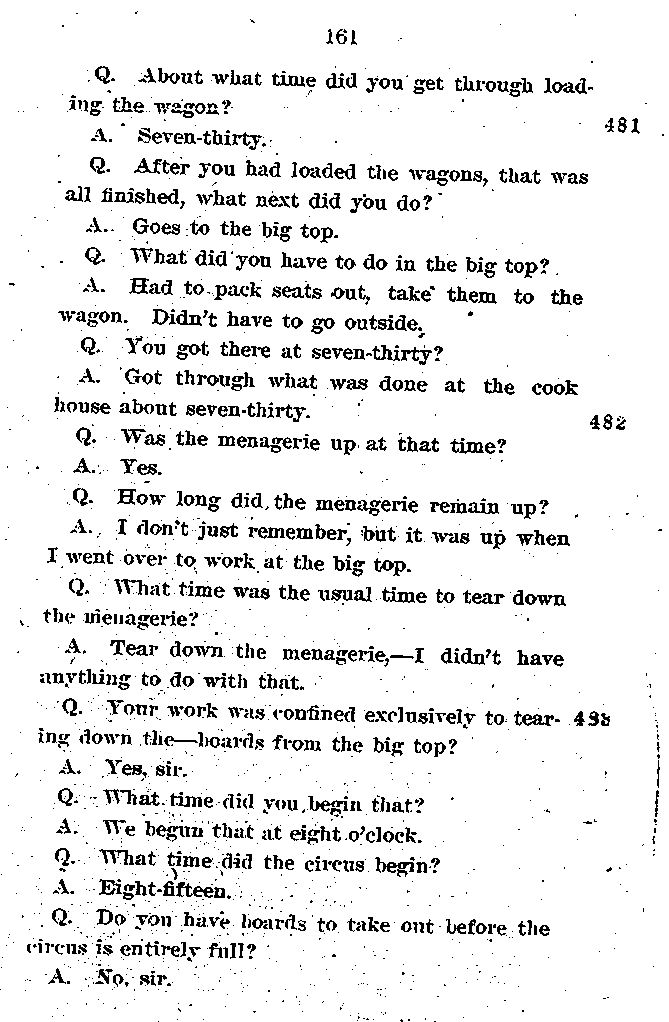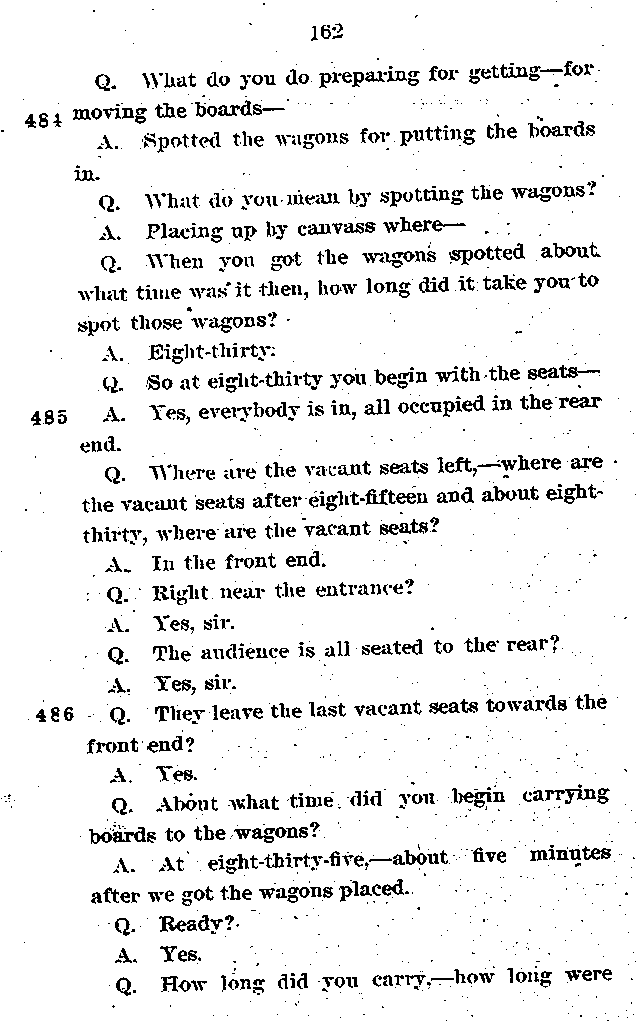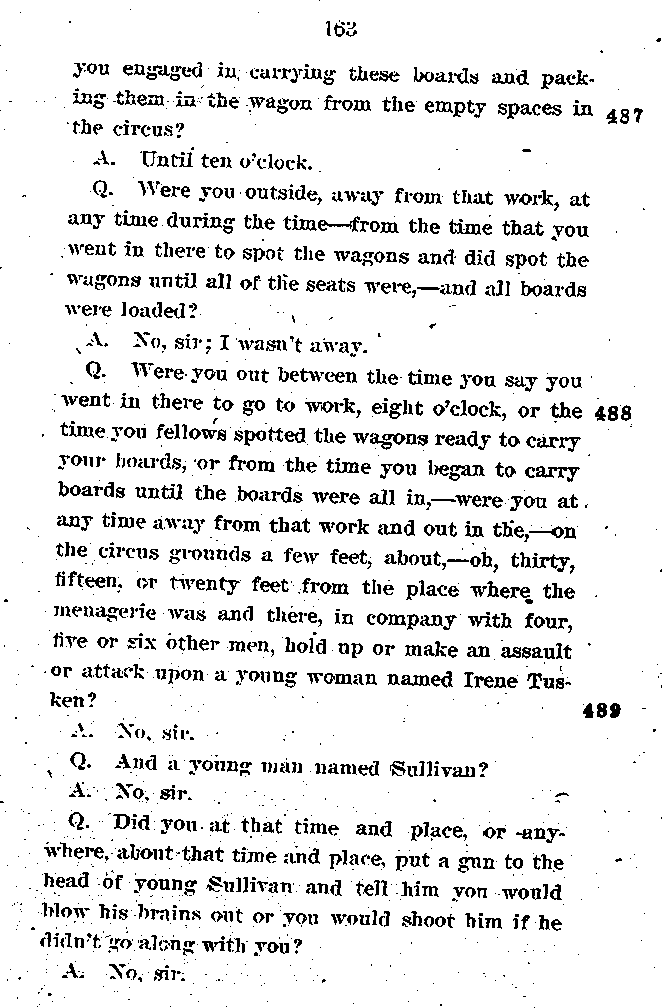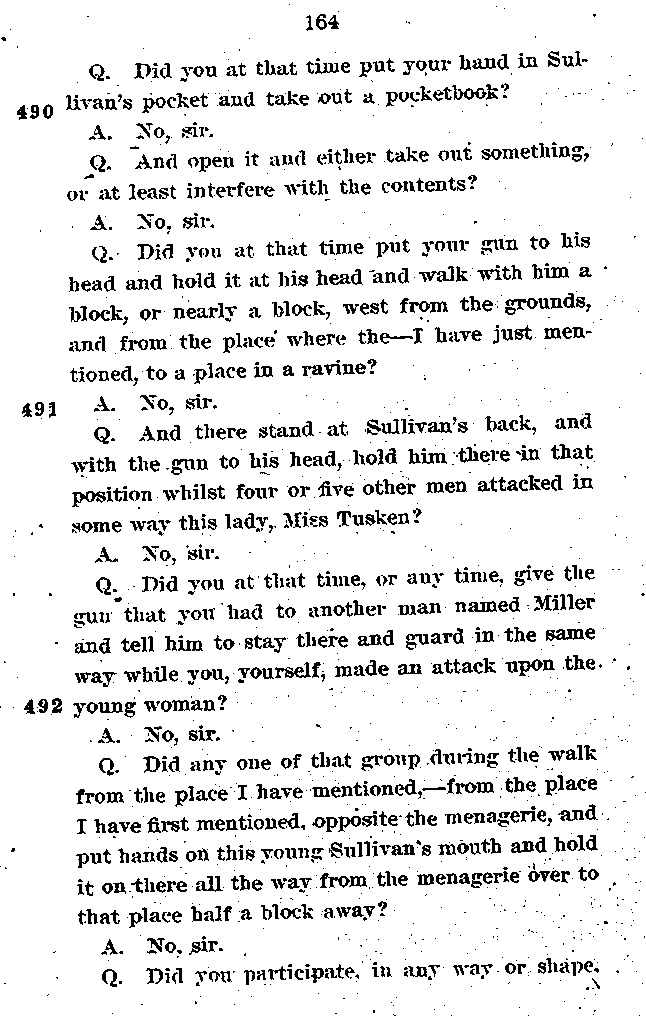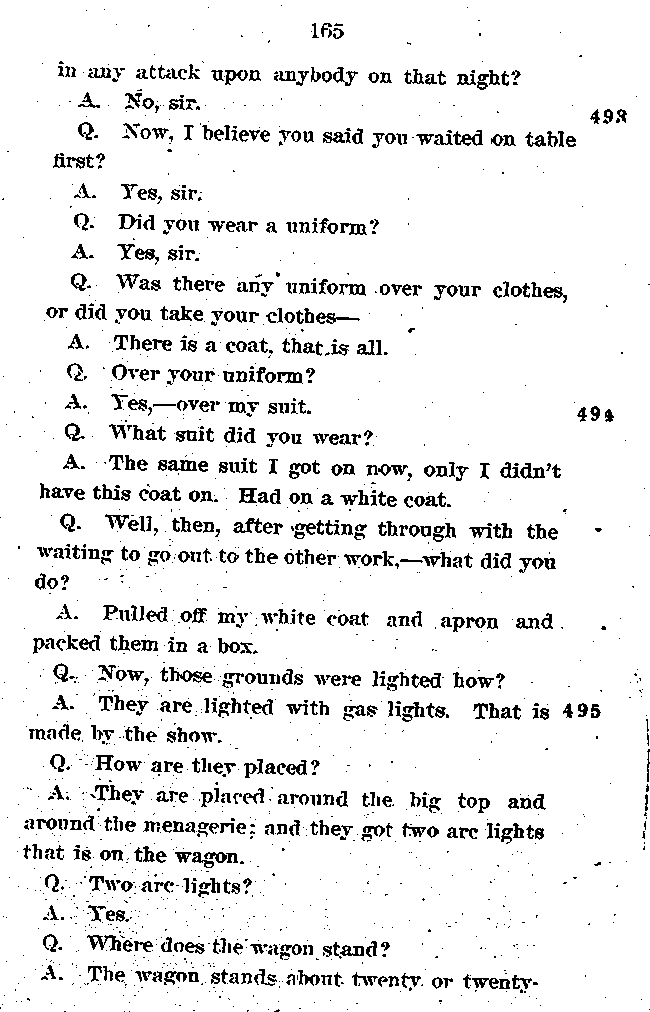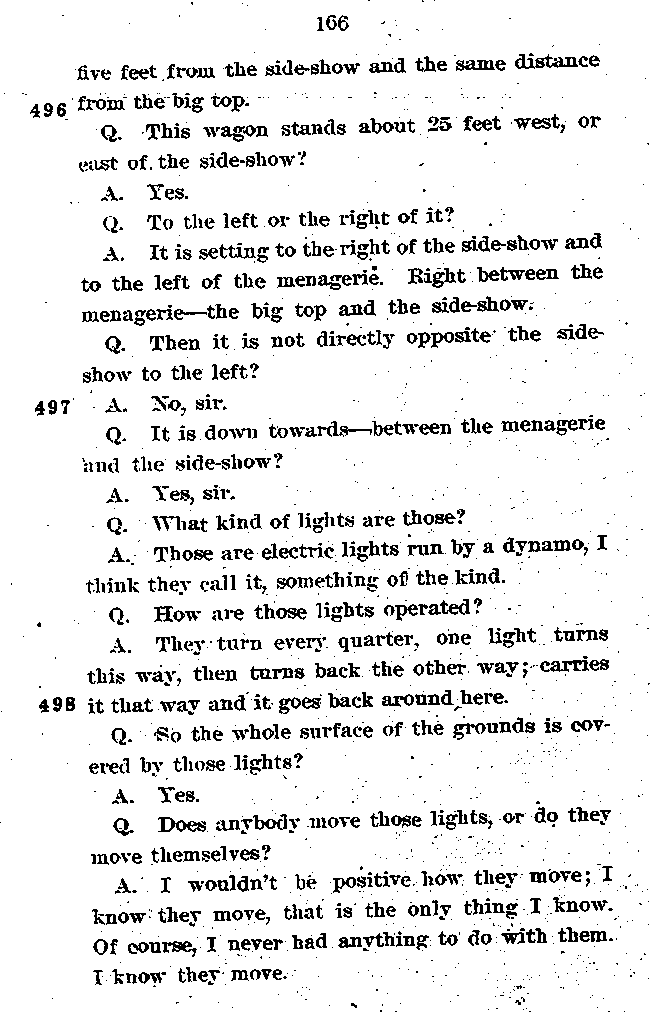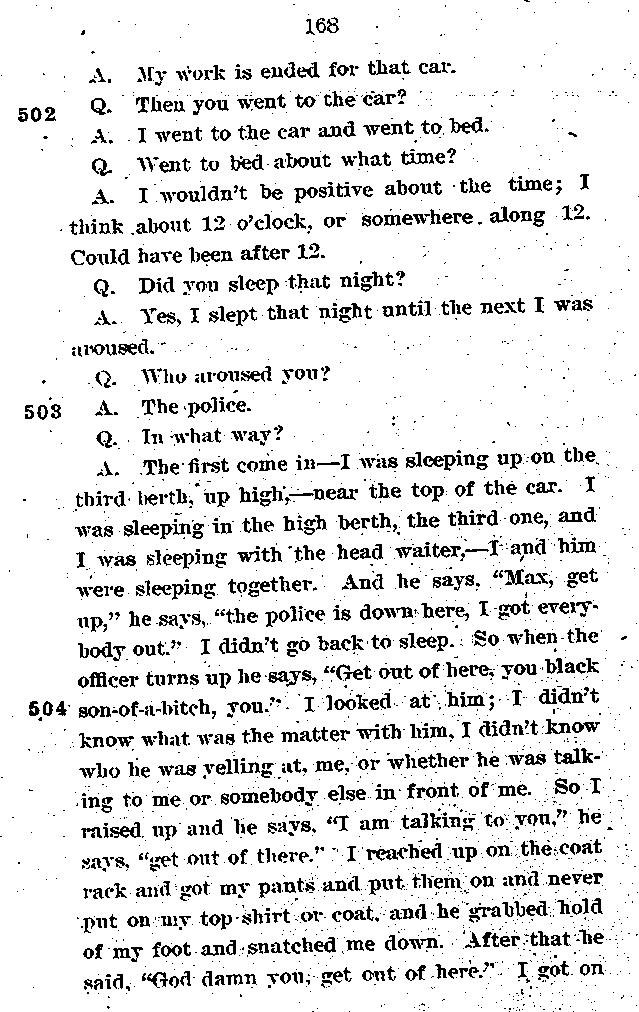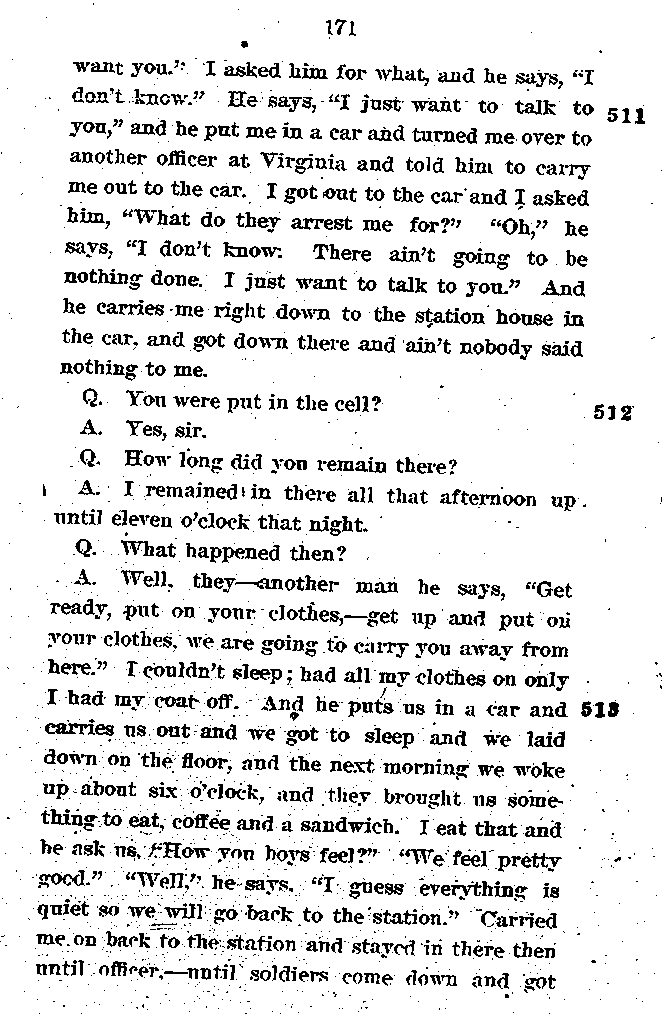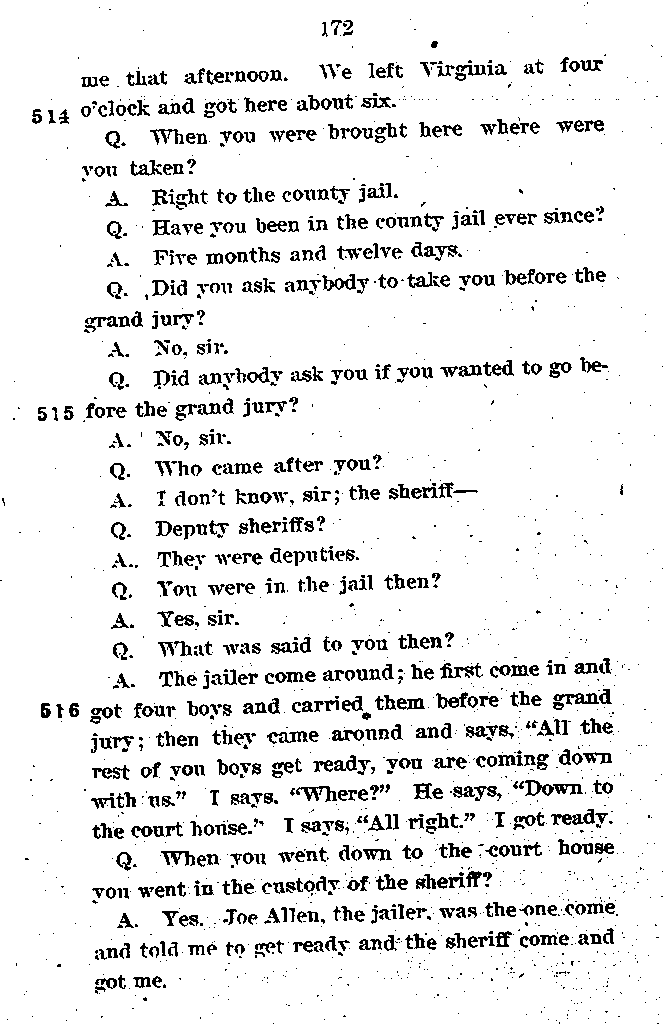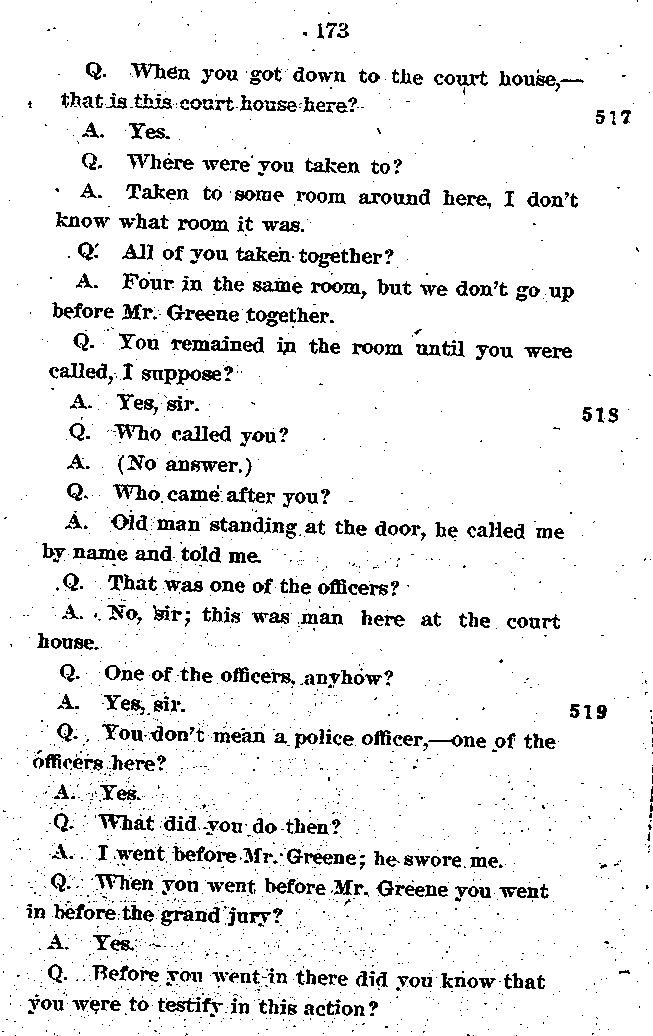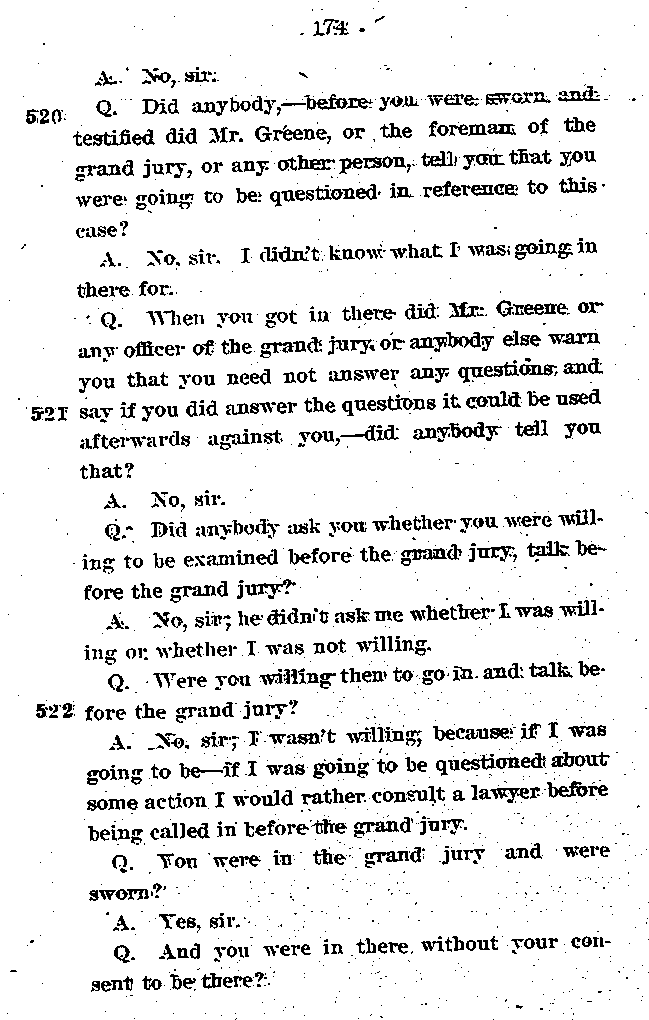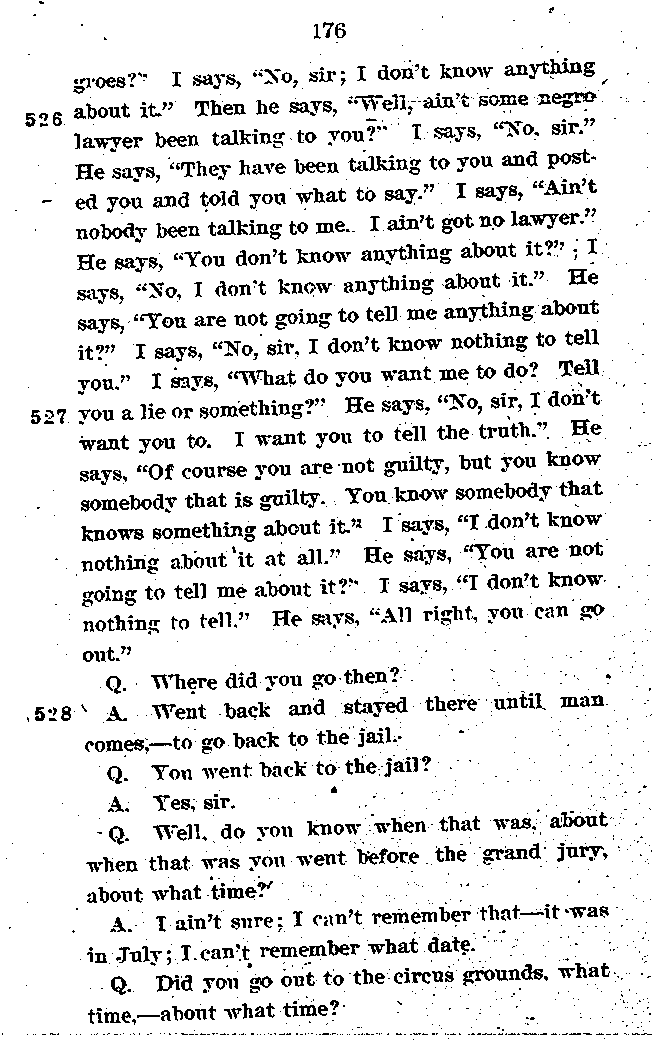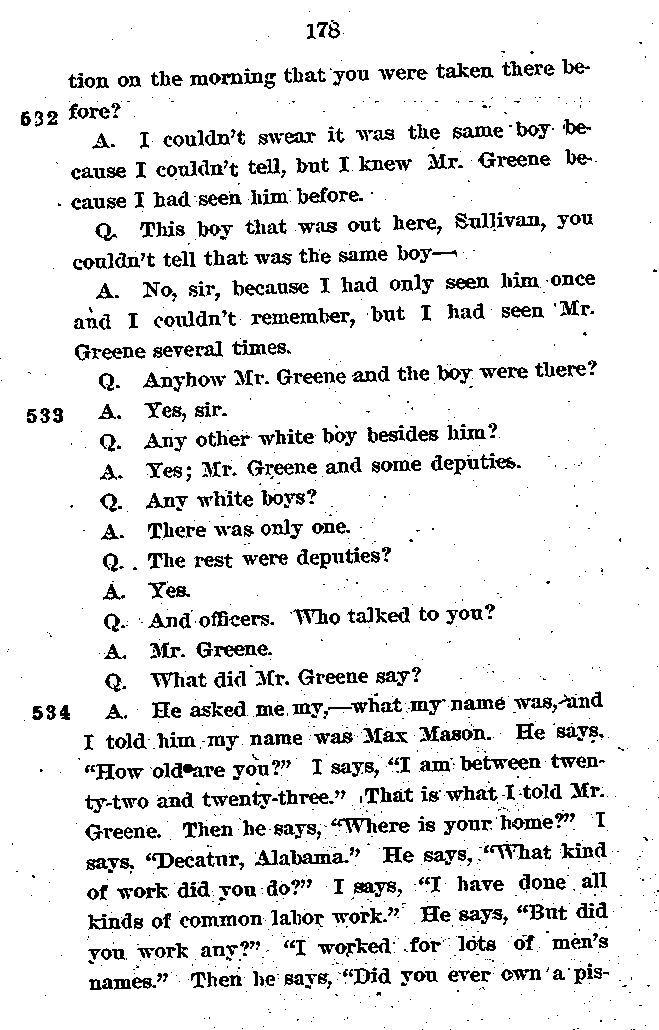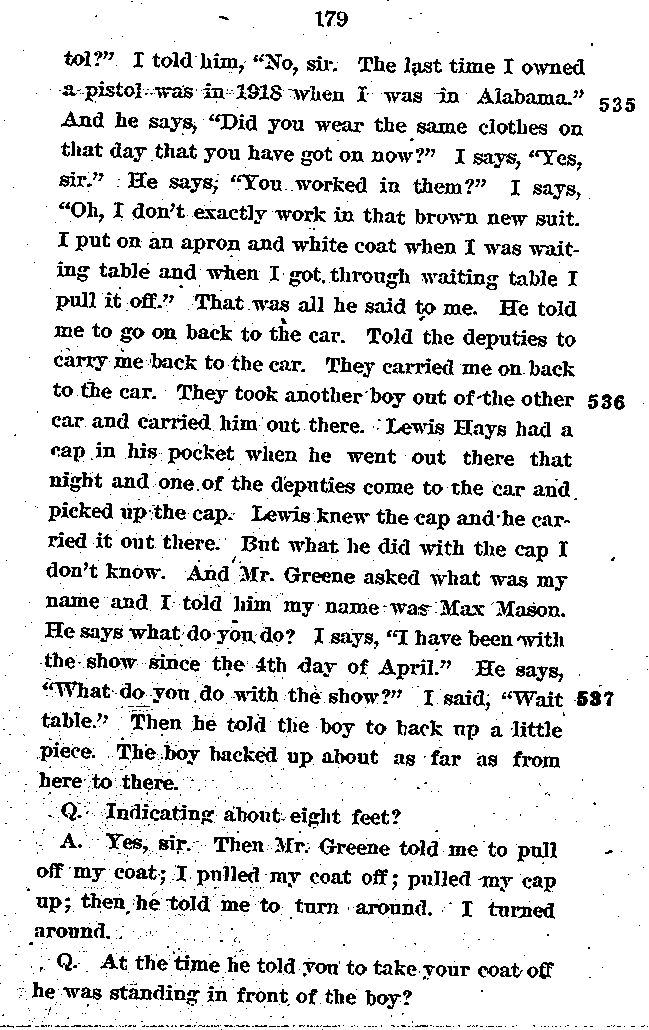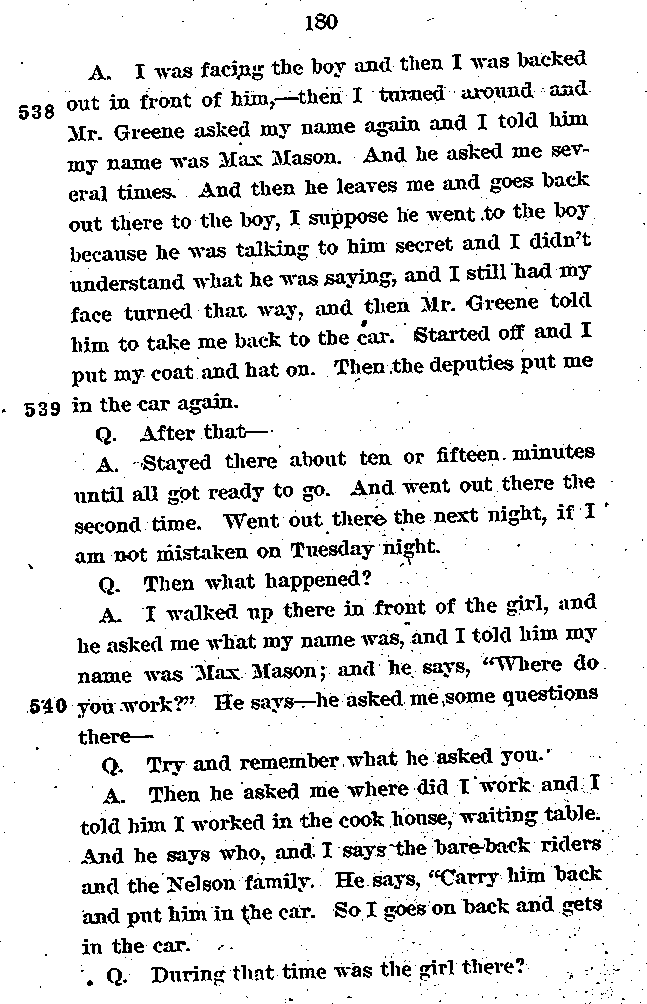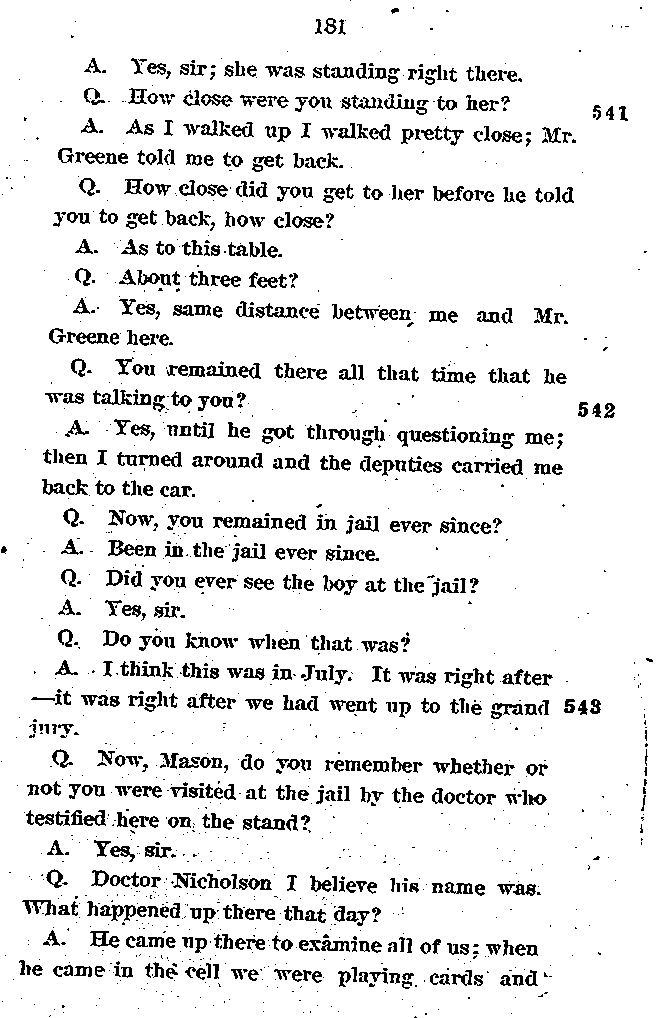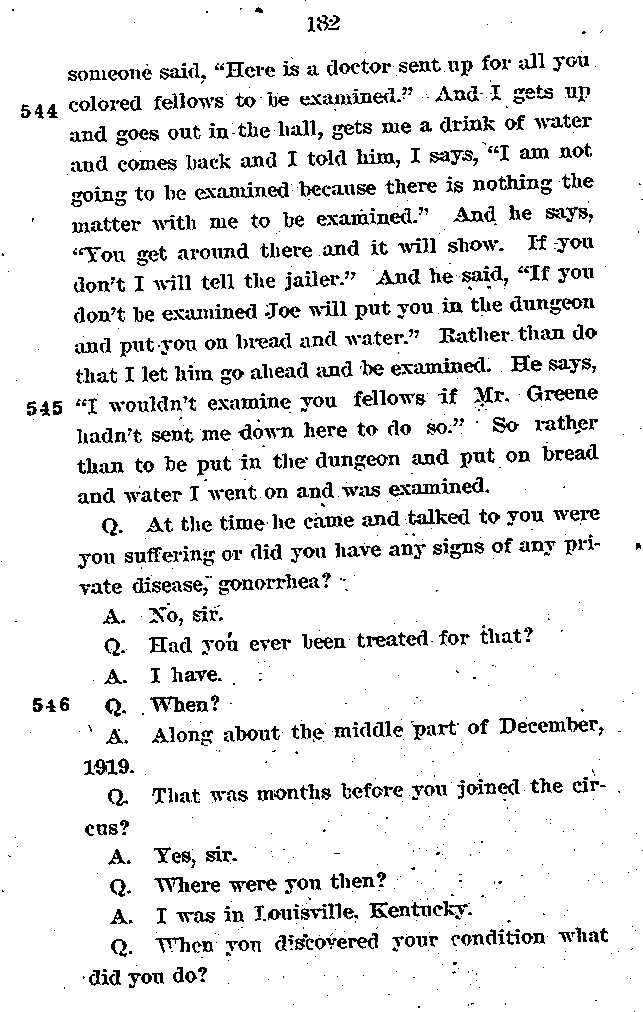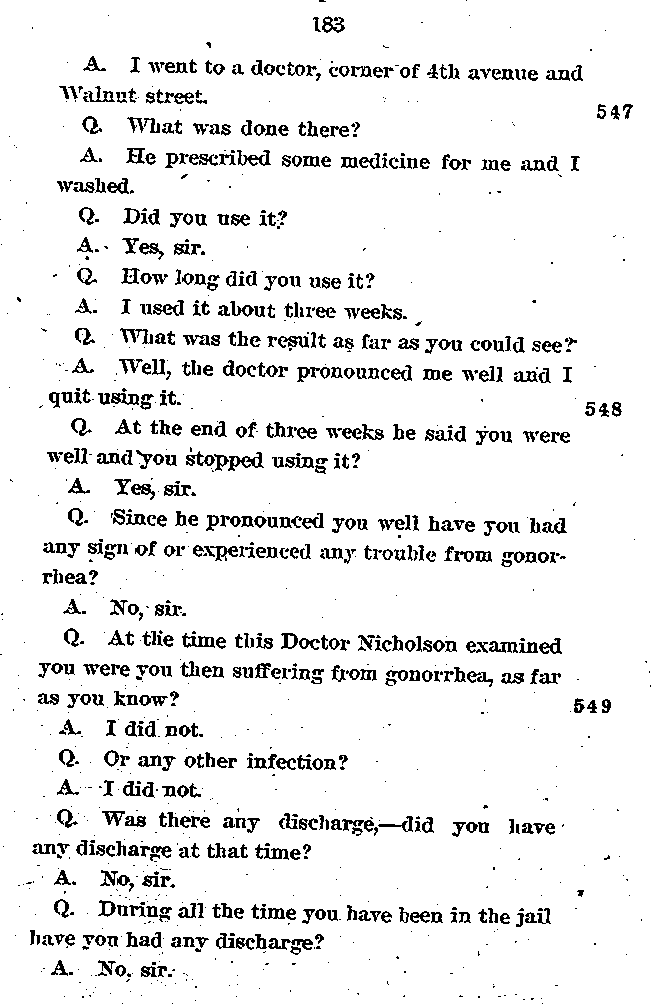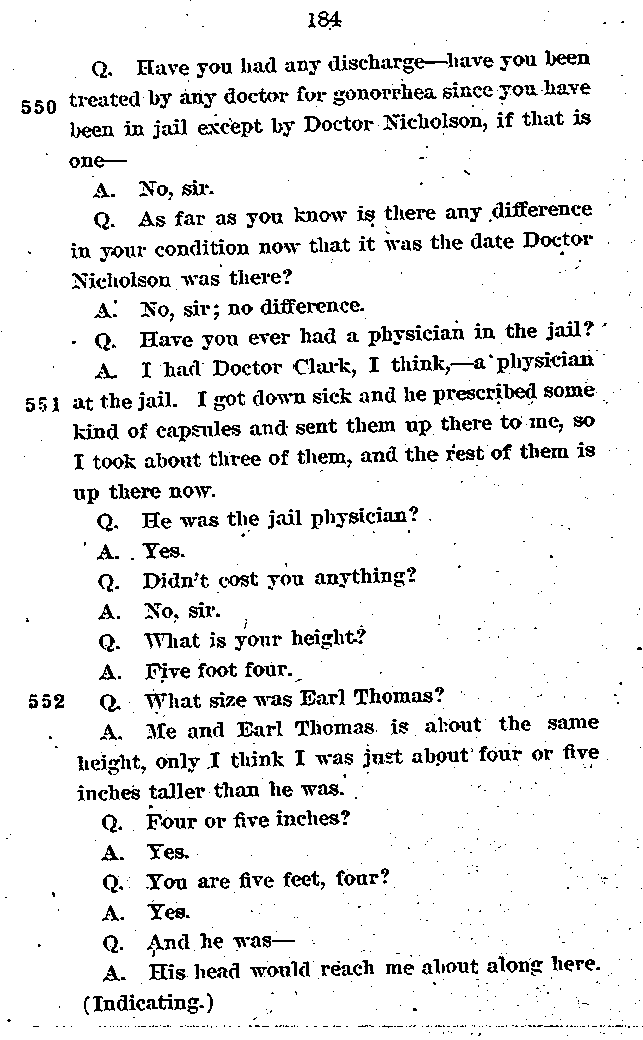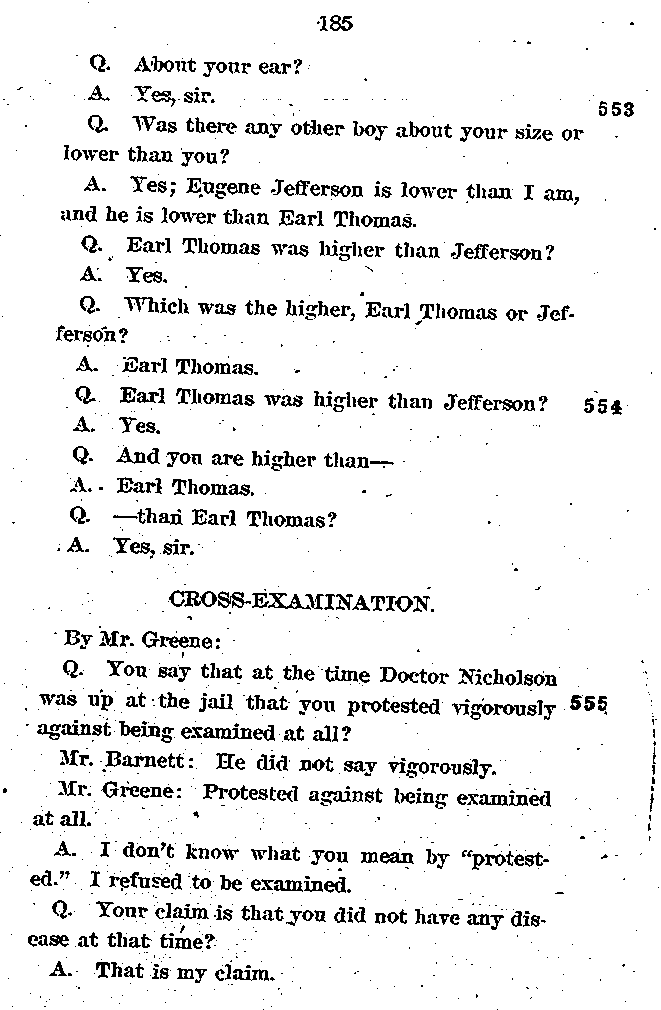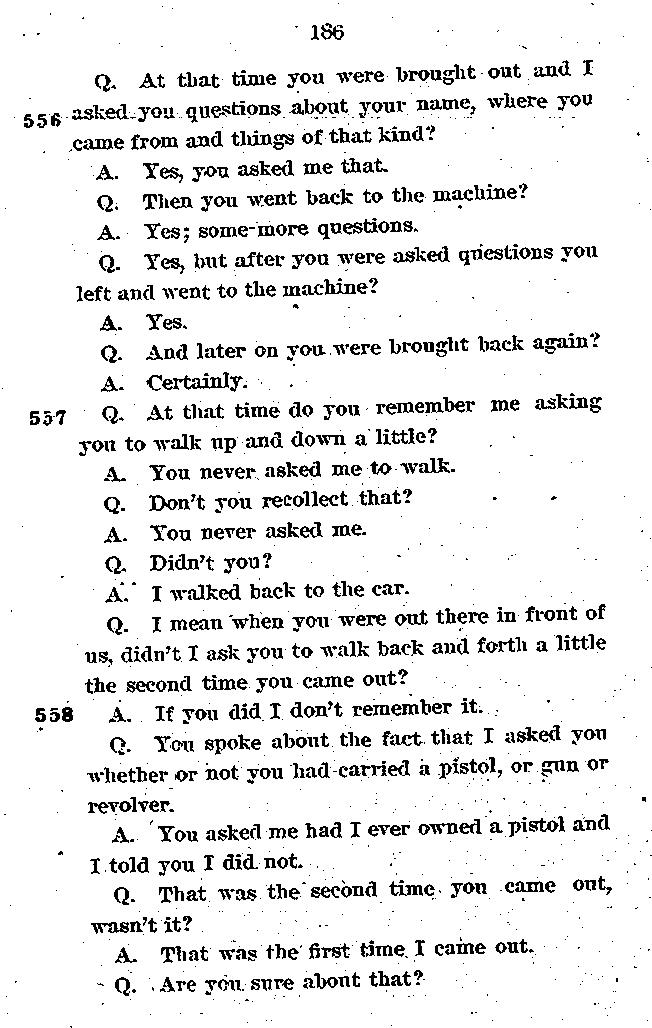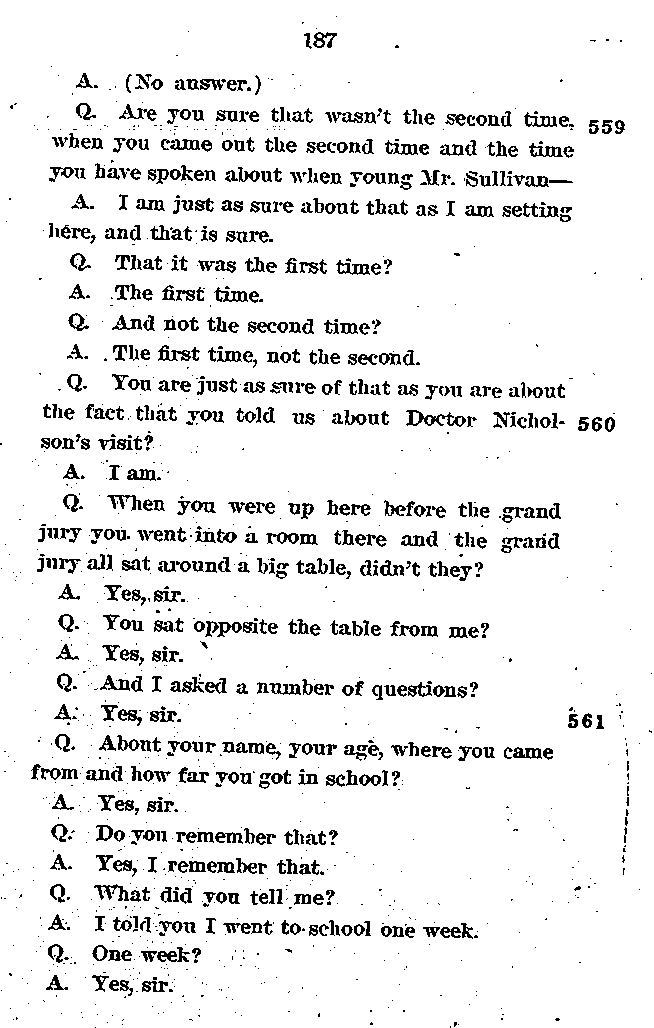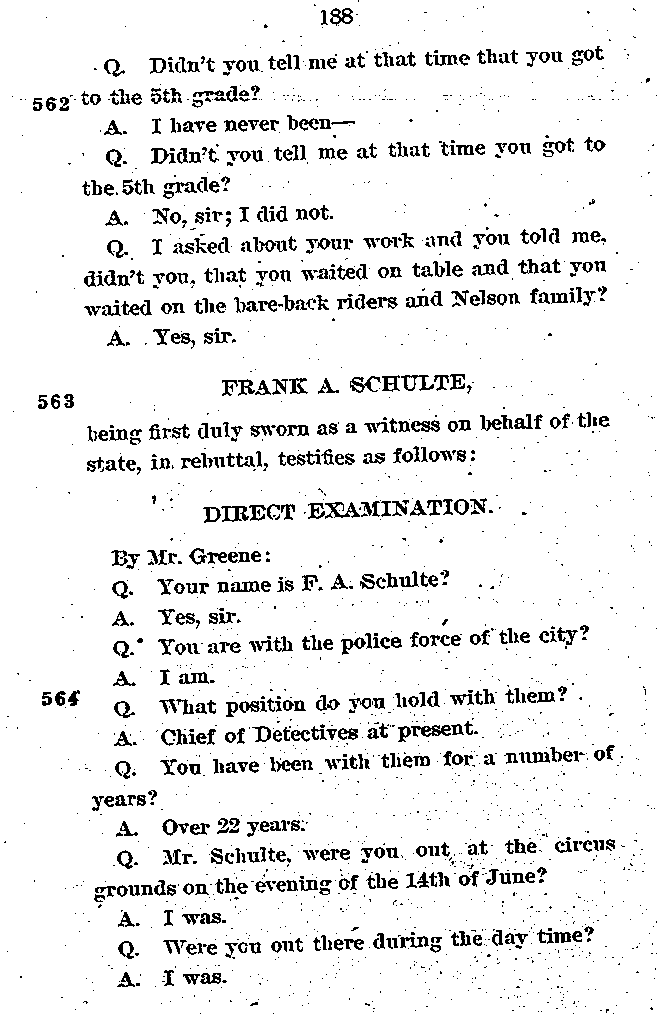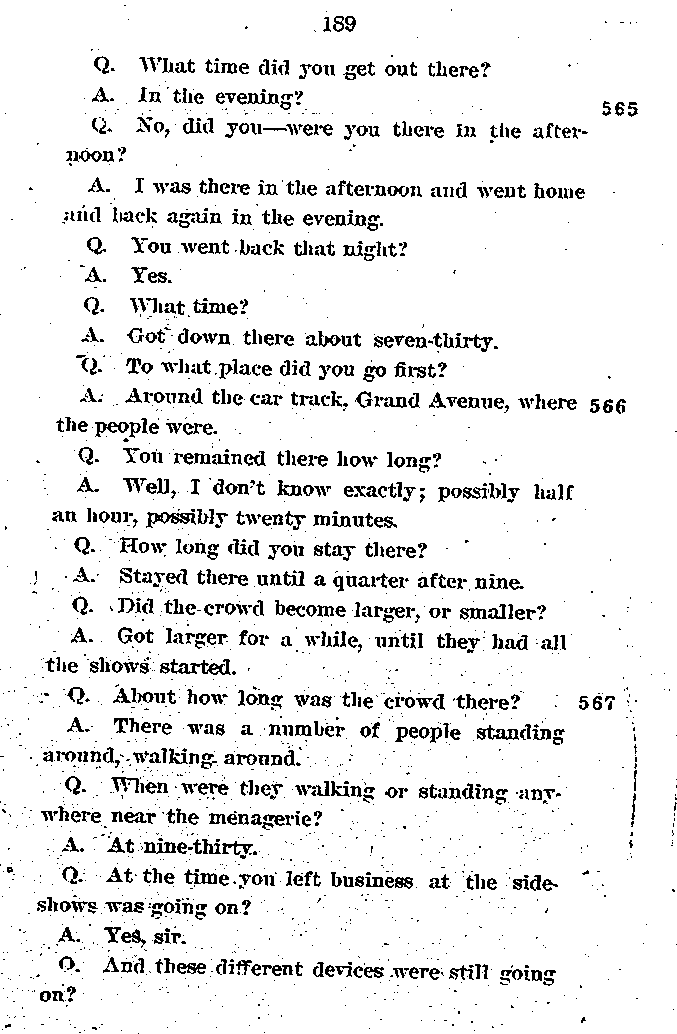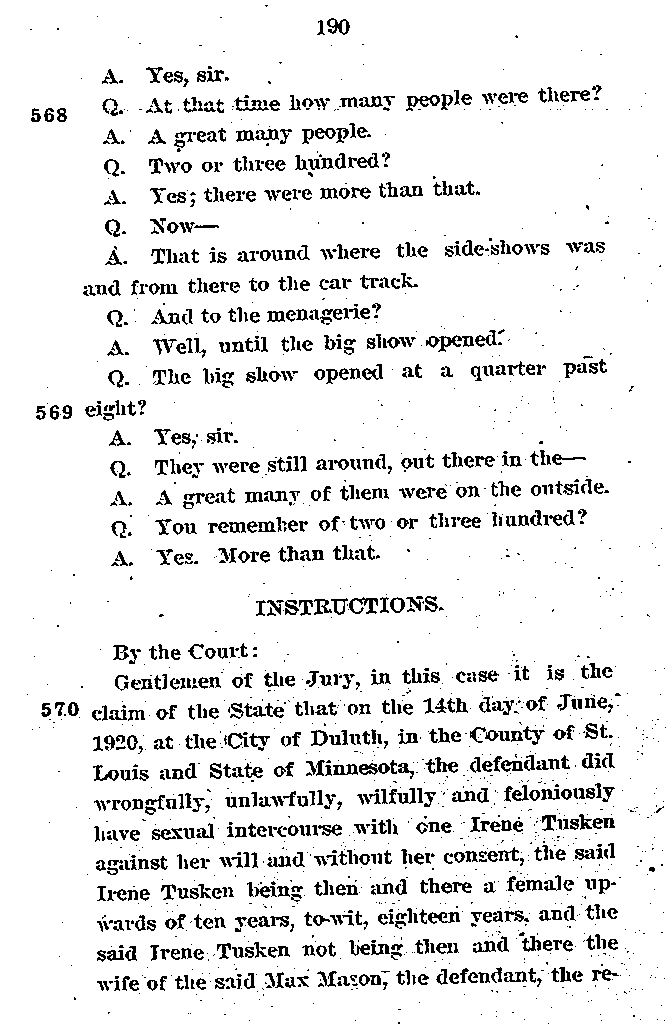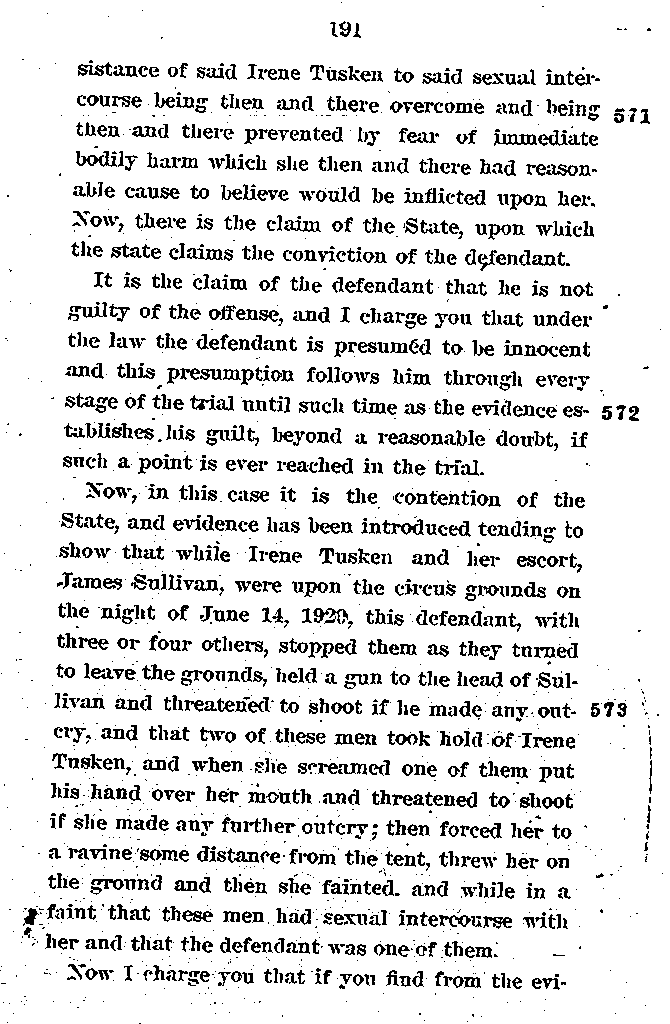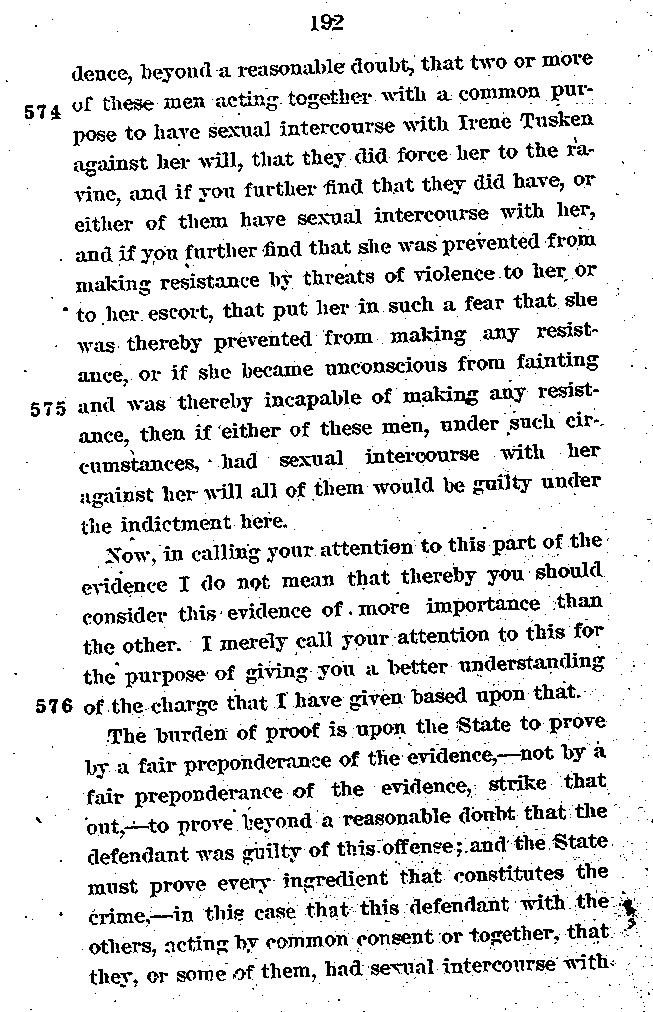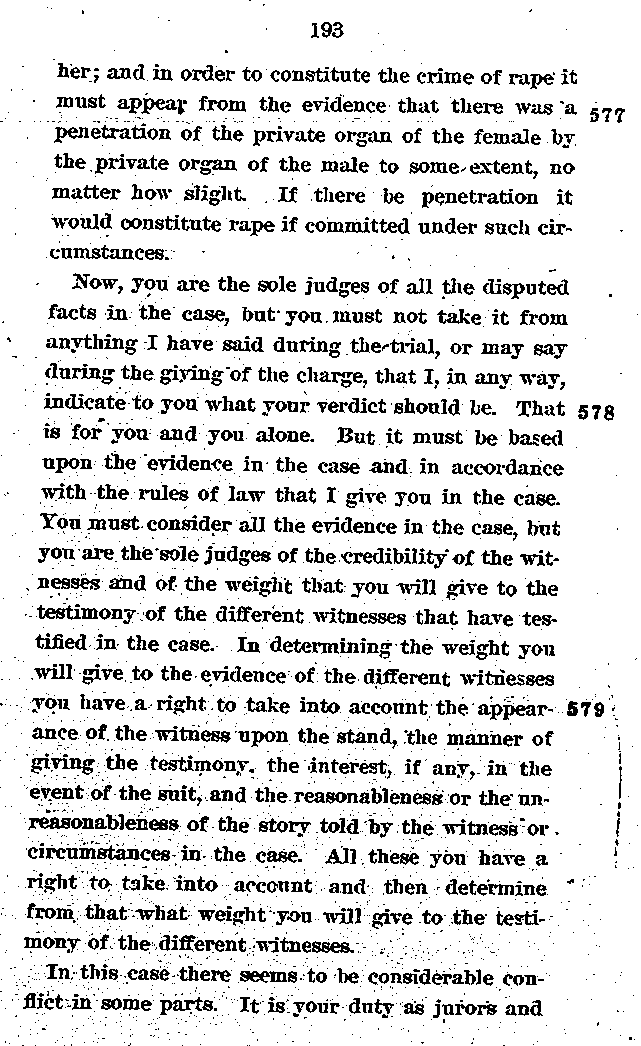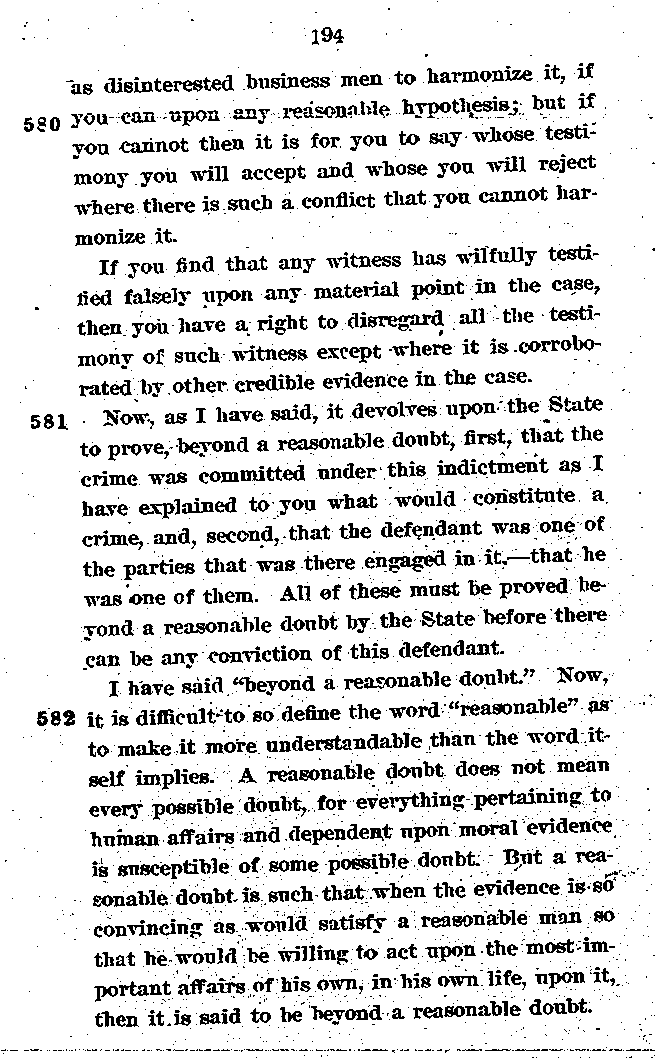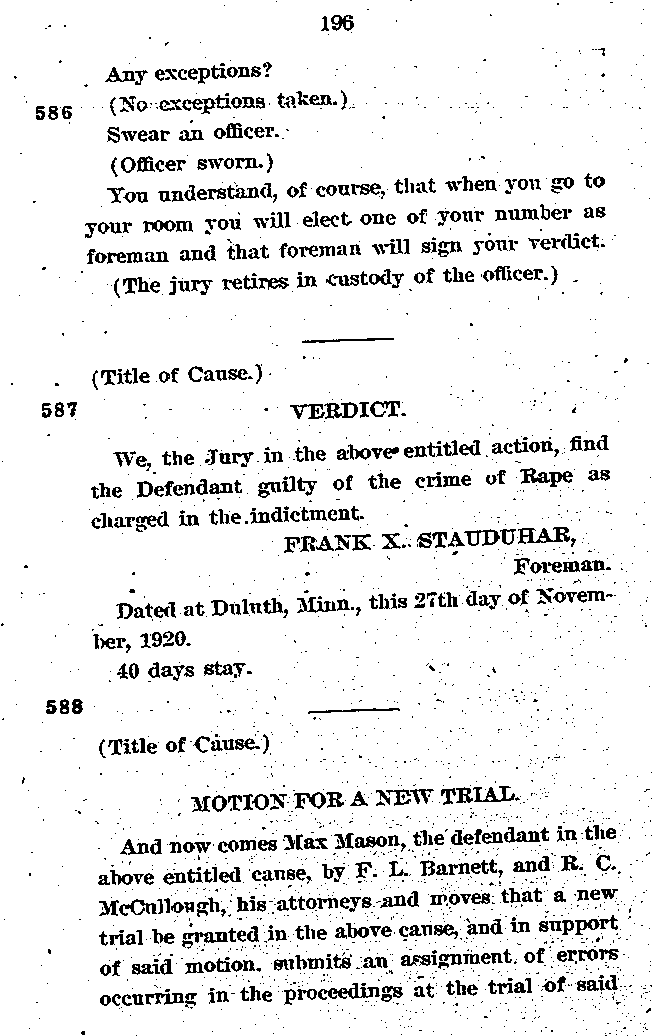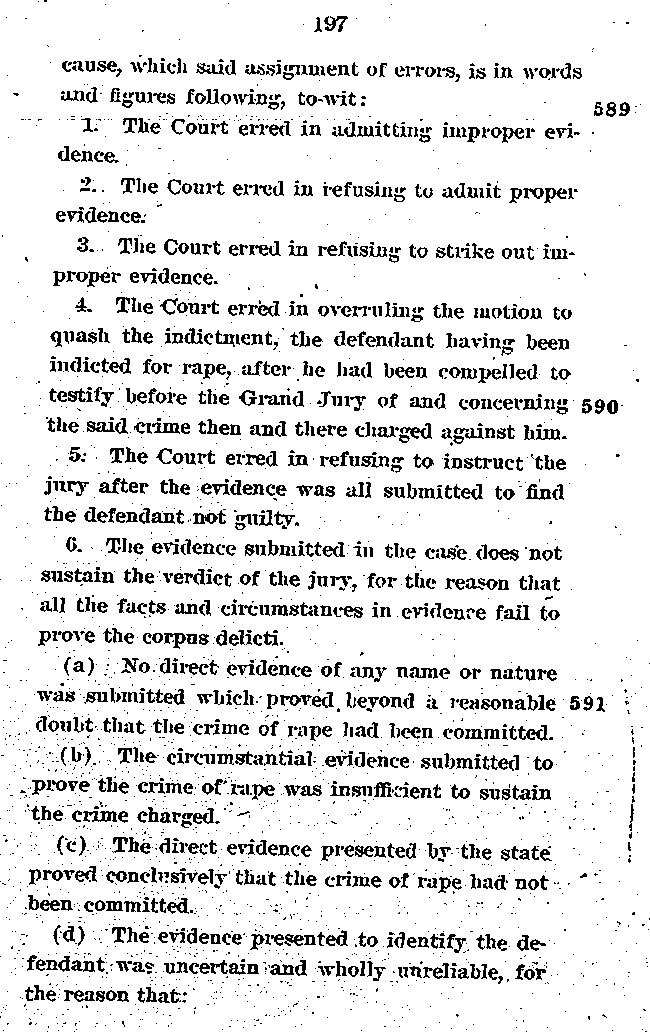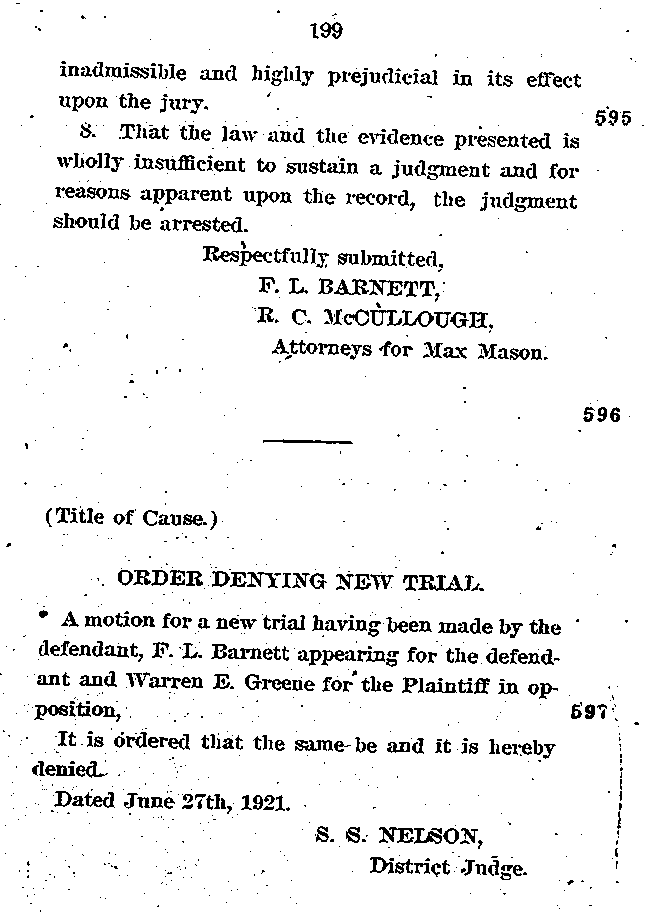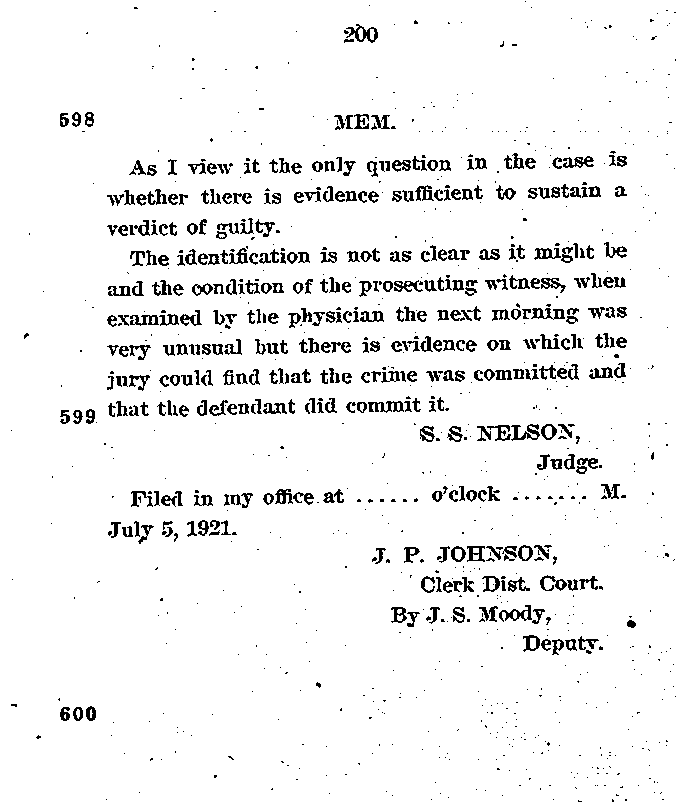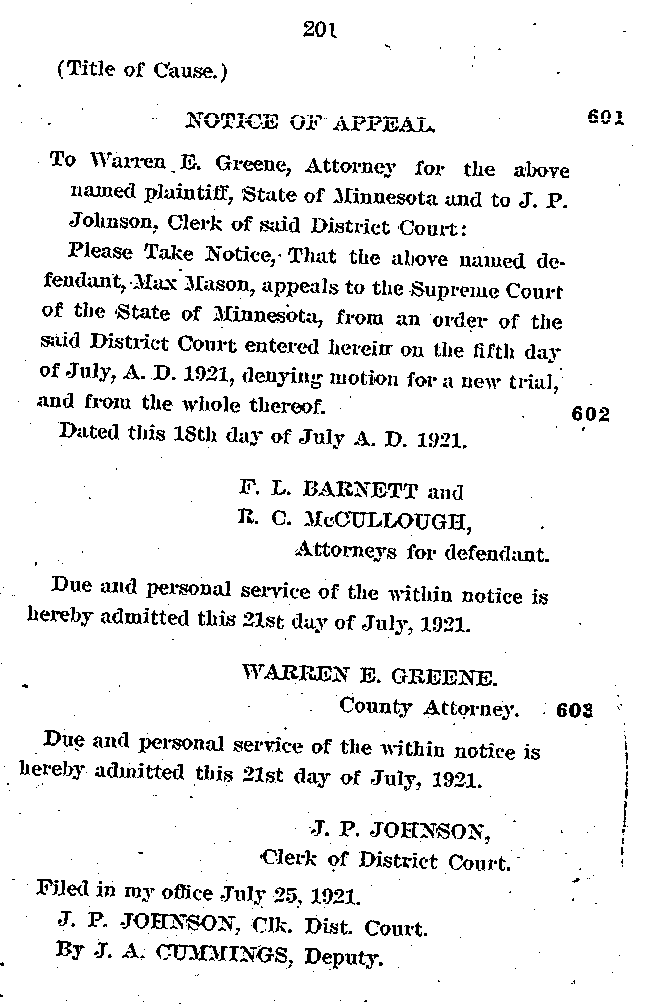State of Minnesota vs. Max Mason. Case No. 22590. 1921-1922. Supreme Court Record.
Type of event: Legal Proceedings
Location: Minnesota; United States
Document date:
Document type: Gov't Record(s)
Document subtype: Supreme Court Record
Documents: State of Minnesota vs. Max Mason. Case No. 22590. 1921-1922. Supreme Court Record.
Citation:
Minnesota. Supreme Court.
Case Files.
No. 22590 (State of Minnesota vs. Max Mason), 1921-1922.
Supreme Court Record.
Image text
22590
STATE OF MINNESOTA
SUPREME COURT.
_________
STATE OF MINNESOTA
Respondent
vs.
MAX MASON,
Appellant
_________
RECORD
_________
F. L. BARNETT
Chicago, ILL,
R. C. McCULLOUGH
Duluth, Minn.,
Attorneys for Appellant
CLIFFORD L. HILTON
Attorney General
W. E. GREENE,
County Attorney
Attorneys for Respondent
INDEX
Indictment........................................... 1
Testimony........................................... 3
Instructions......................................... 190
Verdict............................................... 196
Motion for New Trial.............................. 196
Order Denying Motion ........................... 199
Notice of Appeal .................................. 201
PLAINTIFF’S WITNESSES.
Irene Tusken –
Direct examination .......................... 3
Cross-examination .......................... 24
James Sullivan –
Direct examination .......................... 50
Cross-examination .......................... 63
John Murphy
Direct examination .......................... 111
Cross-examination .......................... 113
A. G. Fiskett –
Direct examination .......................... 114
Cross-examination .......................... 117
David Graham –
Direct examination .......................... 127
Cross-examination .......................... 129
Wm. A. Coventry –
Direct examination .......................... 131
Cross-examination .......................... 132
Re-direct examination ...................... 132
M. A. Nicholson –
Direct examination .......................... 133
Cross-examination .......................... 134
Frank A. Schulte –
Direct examination .......................... 188
DEFENDANT’S WITNESS.
Louis Hayes –
Direct examination .......................... 135
David Graham –
Direct examination .......................... 153
Cross-examination .......................... 157
Max Mason –
Direct examination .......................... 159
Cross-examination .......................... 185
STATE OF MINNESOTA
SUPREME COURT
__________
STATE OF MINNESOTA, DISTRICT COURT,
County of St. Louis, 11th Judicial District.
State of Minnesota
Respondent, 2
MAX MASON,
Appellant.
__________
APPEARANCES
For the State, Warren E. Greene, County Attorney
For the Defendant, F. L. Barnett, R. C. McCullough
and Chas M. Scrutchin.
____________
INDICTMENT.
Max Mason is accused by the Grand Jury of the
County of St. Louis, Minnesota, by this indictment
of the crime of rape, committed as follows, to-wit:
the said Max Mason, on the fourteenth day of June,
A. D. 1920, at the city of Duluth. County of St.
Louis and State of Minnesota, did wrongfully, un-
4 lawfully, willfully and feloniously have sexual in-
tercourse with one Irene Tusken, against her will and without her consent, the said Irene Tusken being then a there a female of upwards of ten years, to-wit: of the age of eighteen years, and the said Irene Tusken not being then and there the wife of the said Max Mason; the resistance of the said Irene Tusken to the said sexual intercourse being then and there forcibly overcome, and being then and there prevented by fear of immediate and
5 great bodily harm which she then and there had reasonable cause to believe would be inflicted upon her, contrary to the form of the Statute in such case made and provided, and against the peace and dignity of State of Minnesota.
Dated at the Duluth in said County of St. Louis and State of Minnesota, this 19th day of July, A. D. 1920.
W. J. McCABE,
Foreman of the Grand Jury.
6 Witnesses examined before the Grand Jury:
Dr. David Graham,
Irene Tusken
James T. Sullivan,
John Murphy
A. G. Fiskett,
Amanda Tusken,
P. B. Sullivan,
W. A. Coventry
TESTIMONY
__________
IRENE TUSKEN,
being first duty sworn as a witness on behalf of the State, testifies as follows:
DIRECT EXAMINATION.
By Mr. Greene:
Q. Your name is Irene Tusken?
A. Yes, sir.
Q. How old are you?
A. Nineteen.
Q. Now, Miss Tusken, on the 14th of June last were you living at the same place that you live now?
A. Yes, sir.
Q. That evening were you at home or did you come up town?
A. I was at home until about eight o’clock.
Q. How did you come to go away?
A. Why, two girls came after me to go. We were not very definite where we would go.
Q. When you left the house you took the street car?
A. Yes. We walked down to Central.
Q. Walked down to Central. Got a Grand Avenue car?
A. Yes, sir.
Q. You three girls got off the car at Vernon Street and you say you walked
back?
A. Yes, sir.
10 Q. What did you three girls do when you got back there?
A. We walked into the circus grounds, around in front there, and there I met Jimmie.
Q. How long had you know Jimmie Sullivan?
A. It is about two years.
Q. How well have you know him since?
A. Why, I have known him intimately for about—it is over a year.
Q. When you left the house on the evening of the
11 14th of June and went down with the girls, did you expect to meet Jimmie?
A. No, I did not.
Q. Did you go into the animal tent?
A. No, we just stayed outside.
Q. When you got there what was the condition there—were the side shows in operation?
A. Yes, they were.
Q. Men barking outside, and hollering?
A. Yes, sir.
12 Q. How about the animal tent—was that up?
A. They were just taking it down.
Q. After you met Jimmie did you stay with the other girls?
A. No, I didn’t; I left them.
Q. You left and walked around with him?
A. Yes, sir.
Q. After you got there how long did you stand around there, do you think?
A. Well, I should imagine it was about three quarters of an hour.
13 Q. During that three quarters of an hour just what were you doing?
A. We were walking around; we was going to go into the side shows and we were walking to the different ones to see which ones we wanted to go into, and found we didn’t want to go into any of them.
Q. Then what did you do?
A. Then we—we walked—we noticed quite a few people over at the menagerie and we walked over to there.
14 Q. Now, Miss Tusken, while you were going around there with Jimmie in the way you have described,—you said you went around for about three quarters of an hour. What makes you think it was about three quarters of an hour?
A. I heard the nine o’clock whistle blow and it was a while after that.
Q. Where were you at the time the nine o’clock whistle blew?
A. I don’t remember where we were exactly.
15 Q. Well, roughly?
A. We were somewhere around the side shows then.
Q. Fifteen minutes or so after that—what hap-pended then?
A. We walked up around the menagerie, not at the entrance, but around; they had started to tear down the tents.
Q. What did you and Jimmie do,—where did you go?
A. We watched them there a little to the left of the entrance.
16 Q. You and Jimmie stayed around the side shows for some time, and then—You and Jimmie were around the side shows up there quite a ways and after a while you saw this activity going on up around there with these animals and you walked up there to the joint you have indicated?
A. Yes, sir.
Q. On this plat. When you got up there what was going on?
17 A. Why all of the working men were around,—they were taking the animals away.
Q. Were these working men white men or colored men?
A. They were colored men.
Q. When you went up there were there any other people up there?
A. Yes, there were.
Q. I mean spectators?
A. Yes, that is what I mean.
18 Q. Were there many spectators up there when you went up there?
A. Yes, there were quite a few, but they were sort of scattered around.
Q. They were sort of scattered around?
A. Yes, sir.
Q. When you got up in there and standing there watching this, how far would you think you were from the nearest side show tent?
A Let us see—we were quite a ways from it; probably about from here to the first step.
19 Q. A distance of about from where you are down to me?
A. Yes, sir.
Q. A distance of about thirty feet.
A. I would think that is about the distance.
Q. How long do you think you and Jimmie stood there and watched what was going on?
A. Why, about ten minutes.
Q. Then did you notice anything about the rest of the spectators?
20 A. Why, we noticed nearly everyone was gone that were standing around watching.
Q. What was the condition up there as far as the lights were concerned,—was it dark, or medium or light?
A. Well, around that tent the lights from the docks sort of gave light there.
Q. That is, there is a string of lights all the way around the Missabe—
A. Yes.
Q. —curve on the ore-docks?
21 A. Yes, sir.
Q. So it was not pitch black in there?
A. No, it was not.
Q. Well, after you had been there some ten minutes or so it would bring it to about what time in the evening?
A. Why, somewhere around nine-thirty.
Q. When you notice the rest of the spectators had apparently gone away what
did you and Jimmie do?
22 A. We turned to go back towards the side shows again.
Q. What happened then?
A. Then when we turned around again there were five or six Negroes stopped us,—that were standing there. We walked only about a couple feet.
Q. How did they stop you, just tell us?
A. Just wouldn’t let us go by; blocked our patch.
Q. Then what happened?
23 A. Then one of the Negroes, the shortest of the bunch, pointed a gun at Jimmie’s head.
Q. What did they say, any of those Negroes?
A. I don’t remember them saying any,—I don’t remember what they said, if they said anything to us. They were talking among themselves.
Q. Did any of them take hold of you, or anything of that kind?
A. Yes, one of them took hold of me. One took away my ring.
24 Q. Did you have a ring on your hand?
A. Yes, sir; the same one.
Q. The same ring you have there?
A. Yes, sir.
Q. Have it on the same finger?
A. Yes, sir.
Q. One of the crowd took the ring off your finger?
A. Yes, sir.
Q. What happened after that with the ring?
A. He gave it back to me then.
Q. How did he come to do that?
25 A. I don’t know; he just gave it back to me; I don’t know if he thought it wasn’t any good.
Q. Was that the same one that had hold of you or was it one of the others?
A. I think it was the same one that had hold of me. He was near me.
Q. How were the others,—were they close to you or some distance away?
26 A. They were all in a bunch; but he was nearest to me.
Q. All in a bunch. Were they close to you?
A. Yes, sir.
Q. You saw this one that held the gun at Jimmie’s head, did you?
A. Yes, sir.
Q. How close to you was Jimmie?
A. Why he was walking right beside me.
Q. Which side was he?
A. He was—he was on the right.
27 Q. On your right,—on this side?
A. Yes, sir.
Q. Is that the way you were facing when the negroes stopped you?
A. I am quite sure of that.
Q. Well, he was close to you, anyway?
A. Yes, sir. No, I think he was on my left when I think about it. He was on my left.
Q. Just go on and tell us what happened.
A. Then when—after he took my ring and gave
It back to me, they were talking among
28 themselves quite a bit; I didn’t understand what they said, sort of an undertone, and pretty soon two or three of them—one stood behind Jimmie and held a gun there and the rest came and took me and carried me over across the field.
Q. How did they carry you?
A. I was sort of walking; they were—they didn’t have me entirely off my feet.
Q. Did they have hold of you?
A. Yes, sir.
29 Q. You were not entirely off your feet, you say?
A. No, sir.
Q. They had hold of you and took you across this field?
A. Yes, sir.
Q. Where was Jimmie and the man that had the—
A. They were coming right behind.
Q. Coming right behind?
30 A. Yes, sir.
Q. Which direction did they take you from that place where you were?
A. I don’t know if I can tell by this; it was across—I don’t remember—
Q. But you went off—
A. To the west.
Q. To the west?
A. Yes, sir.
Q. About how far would you think it was that you went?
31 A. It was quite a ways over; let me see; about I couldn’t tell exactly now.
Q. Roughly speaking, was it—
Mr. Barnett: Can’t you measure by the room?
A. Oh, it was further than—
By Mr. Greene:
Q. Roughly, about how far? Was it half a block, or a block, or two blocks?
A. It must have been nearly a block.
Q. When you got over there, these men took you over there, what happened?
32 A. Why, the men that were holding me threw me to the ground, and Jimmie and the man that—the man that held the gun stood behind us about—a little ways behind us.
Q. How far? As far as from here to you?
A. About ten feet, something like that. About this far.
Q. From the time when they took hold of you down near the tent did you scream or holler—
Mr. Barnett: I do not think the witness ought to be
33 led. I do not think a leading question ought to be put to the witness in as serious a matter as this.
The Court: Yes, counsel will avoid leading questions. That is not suggestive of the answer. You may answer the question, objection overruled.
A. When—when be drew the gun and took hold of me—when the man took hold of me I screamed then.
By Mr. Greene:
Q. What happened?
34 A. Then one of the men put his hand over my mouth.
Q. Which one was that?
A. That was the tall one, the one I identified down at the grounds.
Q. Do you remember his name?
A. I think it was Miller, his name was.
Q. Say anything to you at the time be put his hand over your mouth?
A. They said, “Don’t scream or I will shoot—“
35 Q. Do you remember the exact language?
A. I do not remember the exact words that he said, but something that he would do if we screamed.
Q. Calling your attention to this man who held the gun at Jimmie’s head, was that the same one who went over with Jimmie?
A. Yes. He was a little taller than Jim.
Q. A little taller than Jimmie?
A. Yes, sir.
36 Q. After you were gotten over and thrown to the ground by this crowd of men what happened then?
A. I fainted then.
Q. What was the next thing that you knew?
A. The next thing I remember, when I woke up—there was one man on top of me. So—then I fought and pushed and tried to put him away, and then he got up. He didn’t do anything more then.
Q. What did you do—did you get up?
37 A. I raised myself a little bit and then Jimmie came down and helped me up.
Q. After that what happened?
A. Then,—let’s see,—these two negroes were talking, and when we started back—they were talking to each other; we started back towards the circus, up that slope, and they wouldn’t let us go that way and they ordered us to go over across, up the other slope west.
Q. When you came to and got onto your feet how many negroes were there left there?
38 A. Just two.
Q. Just two left?
A. Yes, sir.
Q. When you went over there how many were there?
A. There were six. Yes, there were six.
Q. Did that include the one that had the gun on Jimmie?
A. Yes, sir.
39 Q. Those two that were left there when you got up, which two were they?
A. They were the two that you had identified down at the grounds as the ones who held the gun,—Mason and Miller.
Q. Miller is the same Miller you spoke about a few minutes ago?
A. Yes, sir.
Q. As the one who put his hand over your mouth?
A. Yes, sir.
Q. Let me ask you then, when you got up you
40 stated there was one of those that were left that
was on top of you then. Which one was that?
A. That was Miller.
Q. Did you see the other one Mason?
A. He was back with Jimmie then.
By Mr. Greene:
Q. Just before recess, Miss Tusken, you stated that you and Jimmie came out practically over to the Merrit school at Fortieth Avenue?
A. Yes.
41 Q. About what avenue is it where the circus grounds are?
A. The circus grounds are on about Thirty-fifth or Thirty-sixth, something like that.
Q. When you got over to the Merritt school what did you and Jimmie do?
A. We sat on the steps then.
Q. Did you have some talk with him there in relation to what had taken place?
A. Yes, we did.
42 Q. How long did you sit there and talk?
A. I don’t know how long it was; about five minutes,—five or ten minutes.
Mr. Greene: I presume the conversation between these two at that time would not be admissible?
Mr. Barnett: Certainly not.
By Mr. Green:
Q. After you had sat there for five or ten minutes then where did you and he
go?
A. We then walked down to the car line.
43 Q. That is at Grand Avenue?
A. At Grand Avenue.
Q. Did you take the car?
A. We took the car, yes.
Q. Where did you go to?
A. We rode to Forty-ninth.
Q. And from there where did you go?
A. Walked home.
Q. How far is it from the car to your home?
A. It is about three blocks.
44 Q. When you got there at home what did you do?
A. We sat on the steps at home.
Q. How long did you sit there?
A. Sat there about five minutes.
Q. Did you have any talk with Jimmie there?
A. Yes, sir.
Q. After you had sat there and talked with him then what did you do,—or what did he do?
45 A. He left then, he went home; I went in the house.
Q. Where did you go?
A. I went right upstairs then.
Q. Whereabouts did you go upstairs?
A. To the bath-room.
Q. Did you go directly to the bath-room or your own room?
A. I went straight to the bath-room.
Q. What did you do in the bath-room?
A. Why, I bathed myself there in the bath-room.
46 Q. What was your condition from the time this thing happened over in the ravine up to the time you got to the bath-room?
A. I don’t know what you man, the condition.
Q. Well, when you left the ravine there what was the condition of your legs and private parts?
A. Why, I was wet. I could hardly walk my limbs were sore.
Q. What was the reason that you went to the bath-room?
47 Mr. Barnett: I object to that, if the Court please.
The Court: What is the objection?
Mr. Barnett: He is giving to the jury evidence of what she though. She went to the bath-room; she tells what she did in the bath-room; now, to ask her why she went to the bath-room is a different thing. I think she can testify to what happened, what was done but not to give any reason because that enables the witness to put a construction upon her actions and that is for the jury to do.
48 The Court: The objection is overruled.
By Mr. Greene:
Q. You stated, I think, that you bathed yourself?
A. Yes, sir.
Q. What part of yourself did you bath?
A. Why, bathed between my legs and—
Q. Were you still moist between your legs before you bathed, or not?
Mr. Barnett: That question is leading and suggestive. I don’t think
that is fair.
49 The Court: Counsel should avoid leading questions, especially ones suggesting the answer. As I remember she testified once.
Mr. Greene: Did she testify to it?
Mr. Barnett: I don’t know.
(Questions and answers read as follows: “Q. What was your condition from the time this thing happened over there in the ravine up to the time you got to the bath-room? A. I don’t know what you mean, condition? Q. Well, when you left the ravine there what was the condition of your legs
50 and private parts: A. Why, I was wet and I could hardly walk, my limbs were sore.”)
Mr. Barnett: Nothing was said about between her legs.
The Court: The objection is overruled. You may answer.
Mr. Barnett: An exception.
(Question read by reporter as follows: “Q. Were you still moist between your legs before you bathed, or not?”)
51 A. I was not.
By Mr. Greene:
Q. What had happened?
A. Why, it had gotten on my underclothing.
Q. You were wearing what kind of underclothing?
A. A union suit.
Q. As I understand you to say, between the time you left the ravine and the
time you got to the bath-room the moisture that you mentioned
the wetness that you have mentioned had been
51 transferred from your body to the underclothes—is that the idea?
A. Well, yes part of it had; the other,—the rest had dried?
Q. The rest sort of dried?
A. Yes, sir.
Q. You say you were wearing a union suit. At the time you were in the bath-room did you undress?
A. Yes.
53 Q. Did you—
A. No, not in the bath-room; from the bath-room I went to my room undress.
(Article of clothing marked Exhibit B.)
Q. Calling your attention to State’s Exhibit B. I ask you if you know what this is?
A. I know what this is.
Q. What is it?
A. It is my union suit that I wore that night.
Q. That is the union suit that you wore that
54 night?
A. Yes, sir
Q. When did you take that off?
A. I took that off the same night when I came home.
Q. In the bedroom or bath-room?
A. In the bedroom.
Q. Did you notice its condition at that time?
A. Yes, I did.
Q. Was it in the same condition as it was when you put it on to go out that
day?
A. It was not.
55 Q. What difference was there?
A. It was torn and dirty.
Q. Will you show us whereabouts on here is the tear that you have just mentioned?
A. Here (indicating); here.
Q. Indicating the two tears that you speak of.
What part of the union suit,—which is the front and which is the back?
A. This is the back?
Q. Where this flap is?
56 A. Yes, sir.
Q. Then the tears that you speak of—are on the leg part of the union suit?
A. Yes, sir.
Q. Were those tears there before this encounter with these Negroes out in the ravine, or not?
A. They were not.
Q. They were not.
A. They were not.
57 Q. You say the union suit was at that time dirty. Whereabouts was it dirty?
A. It was dirty where it was torn.
Q. Around the front part of the union suit or the back?
A. The front.
Q. Were you wearing this union suit next to your skin?
A. Yes, sir.
Q. It was the first undergarment that you had on?
A. Yes, sir.
58 Q. did you have an over undergarment-on?
A. I had a petticoat on.
Q. After you had been in the bath-room and cleansed yourself as you have indicated, you say you went to your bed-room?
A. Yes, sir.
Q. You walked around the room for a while?
A. Yes, sir.
Q. How long were you walking around the room, do you think?
59 A. Just a few minutes; about three or four minutes.
Q. And then you went to bed?
A. Yes, sir.
Q. Did you go to sleep right away?
A. No, sir; I laid awake quite a while.
Q. What was the next thing that occurred in relation to this?
A. The next thing mother was awakening me she was shaking me, trying to wake me up.
60 Q. About when was that, do you know?
A. It was around two o’clock.
Q. She was in your room, was she?
A. Yes.
Q. Trying to wake you up. Did she have some talk with you at that time?
A. Yes, she did.
Q. What was the next that did occur in relation to the matter after that as far as you know?
A. Then my father telephoned to Mr. Sullivan.
Q. What time did you get up the next morning?
61 A. I got up immediately after that—shortly after that.
Q. Shortly after that?
A. Yes, sir.
Q. Where did you go, what did you go?
A. Why, about—about three o’clock or a little after we went down to the West Duluth police station.
Q. Did anybody come for you?
A. No.
62 Q. Who went down to the police station?
A. Mother and dad and I.
Q. About three o’clock in the morning?
A. Yes, sir.
Q. Where did you go from there?
A. We stayed there until near five.
Q. And then where?
A. Then mother and I went back home. During that time Mr. Sullivan had come down.
63 Q. What did you do down there,—what happened down there?
A. There we—they had taken all the negroes out of the car; they had held up the circus train at that point and they took all of the Negroes out of the cars and lined them up for identification.
Q. What did you do?
A. Then I picked out just the ones that I thought were the ones that were there that night.
Q. And after that where did you go?
A. Then I went home; they took me home.
64 Q. What is the next thing that—Oh, I think that they some time,—did Dr. Graham come over?
A. Yes, about 9:30, I think that morning.
Q. Well, after that what occurred, what was the next thing you had to do with it?
A. Lets’ see. I don’t think I had anything to do with it until I had to come up hear.
Q. To the grand jury?
A. To the grand jury?
Q. Yes, I guess that is right. And you testified before the grand jury?
65 A. Yes, sir.
Q. It was after the time that you had been before the grand jury, was it not, that we went down there on the circuit ground lots?
A. Yes, it was.
Q. Just tell the jury what occurred down there. About how long was that, if you recall it, as far as you remember the exact day—I don’t suppose you remember the exact day, but about how long was that after this had happened?
66 A. I think it was about the middle of July.
Q. Just go on.
A. I don’t remember the exact number that were brought down; they were brought down in cars and one by one they were brought up to where I was standing.
Q. Whereabouts—were you down by Grand Avenue or up in the lots?
A. We were up—
Q. Out in the light.
A. Up in the light, yes.
67 Q. I will ask you whether or not light conditions—
A. The first night it was just about the same as that night.
By Mr. Greene: And how about the second night?
Mr. Barnett: I move that that answer be stricken out.
The Court: On what grounds do you ask that it be stricken out?
68 Mr. Barnett: The answer follows the objection to the question just overruled.
The Court: The motion is denied.
Mr. Barnett: An exception to the ruling.
A. The second night was a little darker; it had been raining that day.
Q. So the second night the light conditions were not quite as good?
A. Not as good as the first.
Mr. Barnett: I make the same objection,—and the
69 same ruling and exception?
The Court: Yes.
By Mr. Greene:
Q. I will ask you whether or not you saw this defendant down there on either one of those nights?
A. I did.
Q. Which night was he down there?
A. He was down there the last night?
Q. I will ask you whether or not you recognized him?
Mr. Barnett: I object—
70 Q. At the place?
The Court: Overruled.
Mr. Barnett: An exception.
A. I did
Q. Which one did you recognized him as?
A. I recognized him as the one that held the gun.
Mr. Greene: I think that is all.
CROSS EXAMINATION
71 By Mr. Barnett:
Q. Now, Miss Tusken, referring to the exhibit introduced for identification,—comparison, I will ask you if you will state about how far from the entrance at Grand avenue was the arch you speak about to the entrance of the circus—about how far was it from the sidewalk to the arch?
A. Why, it was,—from the sidewalk to the arch it was about just—not over—not very far: about five feet.
72 Q. How far was it from the menagerie to the big top? As far as from here to the table?
A. Yes.
Q. Indicating about 12 feet. You say to the left of the menagerie were these horse tents. Now about how far were the horse tents from that menagerie, measuring this same way in the room?
(No answer.)
A. I don’t think I can tell how far they were: I don’t remember
of seeing them. We didn’t notice them.
73 Q. You met the girls,—you met, you three girls, you and Jimmie, about the time you got under the arch?
A. Yes, sir.
Q. Before you got to the tent,—to the side show—You talked there a little while?
A. Yes.
Q. Then you and Jimmie went away?
A. Yes.
Q. And left the girls there?
A. Yes, sir.
74 Q. At about a quarter past nine you say some thing happened, you met someone, soon after a quarter past nine you and Jimmie—did you go somewhere—soon after a quarter past nine you and Jimmie, did you meet somebody?
A. We didn’t meet anyone a quarter past nine.
Q. What attracted your attention to the menagerie tent?
A. Quite a few people around there watching.
75 Q. Watching the menagerie. Weren’t there quite a few people around the side shows?
A. Yes.
Q. In fact, this whole place around here was filled with people?
A. Yes, sir.
Q. Boys women and men all looking?
A. Yes, sir.
Q. That side show there that night was the usual circus crowd?
A. Yes, sir.
76 Q. Your attention was attracted towards the menagerie tent—
A. Yes.
Q. —that was after 9:15. What was it that drew your attention to the menagerie tent at that hour?
A. Why, we had been walking around the side shows and sort of tired, so we saw quite a few people around the menagerie and we walked up there.
Q. When you got to the menagerie what did you do?
77 A. (No answer.)
Q. Did you go inside?
A. No, sir; we stayed outside.
Q. Where in reference to the entrance to the menagerie did you stay you and Jimmie?
A. We stayed to the left.
Q. To the left of the entrance?
A. Yes.
Q. How long did you stand there?
A. About ten minutes.
78 Q. So that would make it about 9:25 or half-past nine?
A. Yes.
Q. Is that right?
A. Yes, sir.
Q. But you stood at the entrance to the menagerie about ten minutes?
Mr. Greene: We object. She didn’t say she stayed around the entrance to the menagerie.
Mr. Barnett: She said she stayed at the left of the entrance.
By Mr. Barnett:
79 Q. After you stood at the left of the entrance to the menagerie say about ten minutes then where did you attempt to go?
A. We turned to go back.
Q. I don’t know where?
A. Towards the side shows.
Q. Did you go back to the side shows?
A. No, sir.
Q. Why didn’t you go back to the side shows?
80 A. Because, when we turned around, there were about five or six Negroes blocked our path.
Q. So these five or six negroes blocked your pathway as you turned from the menagerie to go back to the side show?
A. Yes.
Q. What was said by these when they blocked your pathway?
A. I don’t remember what thye said. They were talking among themselves.
81 Q. What did any of them say to you, or to Jimmie, in your presence, that you heard?
A. I don’t remember that.
Q. What did any one of them do to you or to Jimmie in your presence, after they blocked you on your way back to the side show?
A. One of them put a gun to Jimmie’s head.
Q. Where were you standing when he did that?
A. I was standing beside Jimmie.
Q. What did he say to Jimmie when he put the gun to his head?
82 A. He didn’t say anything right then, because I screamed.
Q. You screamed?
A. Yes.
Q. Did anyone come to your rescue?
A. No, sir.
Q. Well, after you screamed what did the man say who held a gun at Jimmie’s head?
A. He stood there.
Q. Right there in the same spot?
83 A. I don’t know if it was on the same spot; right beside him.
Q. Did he have the gun pointed at his head all the time?
A. Yes, sir.
Q. What did the other five negroes do?
A. After I screamed one of them took hold of me.
Q. What did he say?
A. He said—I don’t remember what he said then. Just took hold of me and held my arms.
84 Q. Both arms?
A. Yes, sir.
Q. In his both hands?
A. Yes, sir.
Q. What did the other four negroes do?
A. They stood there.
Q. Did any of them say anything to you at the time?
A. No.
Q. Any of them say anything to Jimmie at that time?
A. Not that I heard.
85 Q. Jimmie was right by you?
A. He was right there.
Q. You hadn’t moved from the position since the time you screamed?
A. No.
Q. When this fellow had hold of your two arms and these Negroes were standing by and one with the gun at Jimmie’s head, what next happened?
A. Then this man that was holding me let go of one of the arms and took off my ring.
86 Q. Did you say anything to him when he was doing that?
A. Why, no, I didn’t
Q. He gave the ring back to you?
A. Yes, sir.
Q. Did you ask him for it?
A. No sir.
Q. What did he say when he gave the ring back to you?
87 A. He didn’t say anything; he just gave it to me.
Q. Jimmie was standing there?
A. Yes, sir.
Q. The man had the gun at his head at that time, did he?
A. Yes, sir.
Q. And the other three negroes were standing by?
A. Yes, sir.
88 Q. After this negroe who took your ring gave it
back to you, what was the next step,—what was next done?
A. Then they sort of carried me—
Q. No, what did they do?
A. (No answer.)
Q. What was done to you?
A. (No answer.)
Q. You say you are still standing on the road to the tent—to the side show?
A. Yes, sir.
89 Q. Now, when this negro was standing there and when the man gave you back your ring and the other three Negroes were standing there—altogether, I suppose?
A. Yes, sir.
Q. What was the next thing that you now recall was done?
A. They started to carry me away then.
Q. Anyone put their hands on you?
A. Yes, sir.
Q. How many?
90 A. I know tow of them did.
Q. Two of them had their hands on you?
A. Yes, sir.
Q. Did you scream?
A. No, sir.
Q. Make an outery, at all?
A. No, sir; I just tried to get away.
Q. When those two negroes had their hands on your arms—they started away, you say?
A. Yes sir.
91 Q. How close had you gotten to this side show here before these men stopped you—
A. (No answer.)
Q. How close were you to the side show?
A. About from here to that arch there.
Q. About thirty feet?
A. Yes, sir.
Q. A distance of about thirty feet. You were still there when they started off, were you?
A. Yes, sir, a few feet from where we stood watching the menagerie.
92 Q. A few feet from the entrance to the managerie door?
A. No.
Q. How far were you from the menagerie door about?
A. Quite a ways around from the entrance.
Q. Well, about how far?
A. About—about 20 feet. Fifteen or 20 feet.
93 Q. Now, when you started,—when these men started with you away over there you were about 15 feet away from the menagerie entrance?
A. Yes, sir.
Q. Did you start west before the animals were taken out, or while they were being taken out?
A. While they were being taken out?
Q. Did you see any work being done there while the animals were being taken out?
A. Around the menagerie?
Q. Yes.
A. They were carrying poles and boards.
Q. What were they doing with them?
94 A. They were carrying them away from the menagerie.
Q. Which direction?
A. Off this way.
Q. Out towards the north?
A. Yes, sir.
Q. Colored men were doing all that work?
A. Yes, sir.
Q. They were carrying them out that way when these men started with you west?
95 A. Yes, sir.
Q. Was anything said to you by any of these men when you were going from this place when you left over there?
A. No, nothing while we were going over.
Q. Was anything said to Jimmie in your presence while you were going over?
A. Not that I heard.
Q. Did Jimmie make any outery when you started over there?
96 A. No, sir.
Q. Did you call to any of the other colored men that were piling these planks and carrying poles about the time you started,—did you call to any of them for help?
A. No, sir.
Q. Did Jimmie call to any of them for help?
A. I don’t think so.
Q. I believe you said on your direct examination that there were not very
many people there then?
A. No, not when we turned away.
97 Q. When?
A. Turned to go back.
Q. When you turned to go back to the—
A. To the side shows.
Q. Then you say there were not so many people around?
A. Not around to menagerie.
Q. While there wasn’t anyone around the menagerie there were around the side shows?
A. Yes, sir.
98 Q. Now, when this,—you had gone this block over there, after you got over there what was the first thing that was done over there after you stopped?
A. They threw me to the ground.
Q. Who threw you to the ground?
A. These men that were holding me.
Q. Do you know who were holding you?
A. One of them was Miller.
Q. Who else?
99 A. I don’t remember; I don’t know the other one.
Q. Did Miller throw you to the ground?
A. He was one of the men.
Q. Did he throw you to the ground?
A. Yes, sir.
Q. He had his hand on you?
A. Yes, sir.
Q. When you fell to the ground—after he threw you to the ground what
next happened?
A. I fainted then.
100 Q. Do you recollect anything else that happened right there after you fainted?
A. No, sir.
Q. How?
A. No, sir
Q. Do you know who else had hold of you at the time you were thrown to the ground and before you fainted?
A. No, sir.
101 Q. Just before you were thrown to the ground and you fainted, how many men were there?
A. With me?
Q. Altogether, you and Jimmie?
A. There were five.
Q. Do you know any of those men and their names?
A. One was Mason and the other was Miller: that is the only two.
102 Q. At the time that Mason or Miller and the other three men—four men or five men, as the case may be, blocked you there on the road to the side show, you saw their faces, didn’t you?
A. Yes, sir; I saw faces.
Q. You had a good look at the faces?
A. Not a very good look; it was rather dark.
Q. It was dark at the side show?
A. We were not at the side show.
Q. You were on the road to the side show from the—
A. Not very far,—not very far from the side show.
103 Q. You saw the face of Miller at that time and recognized him?
A. Why, no, I didn’t recognize his face.
Q. Didn’t see his face at that time well enough to know him, did you?
A. No, sir.
Q. Did you see the face of any of the men well enough to know them—
A. No, sir.
Q. You say the next morning you were out early in the morning—
104 A. Yes.
Q. Out for identification?
A. It was about six o’clock.
Q. All these negro employees of the circus were there?
A. Yes, sir.
Q. Did you identify any of them?
A. Yes, sir.
Q. Which ones did you identify?
A. No one in particular, but—
105 Q. I asked you if you identified—
Mr. Greene: I object to having the witness interrupted.
By Mr. Barnett:
Q. Which one did you identify?
A. None of them.
Q. Now, after these men threw you down, passing over the period of your
unconsciousness, you came to yourself again and I believe you then saw
Miller?
A. Yes, sir.
106 Q. You don’t know, of course, anything that Miller had said or done, because you were unconscious?
A. No.
Q. After you saw Miller and recovered your consciousness, what was the next thing that you now recollect?
A. Miller got up then and then I tried to raise myself to get up on my feet.
Q. Did you see Jimmie about that time?
107 A. Not at that time.
Q. When did you first see Jimmie?
A. When he helped me to my feet.
Q. Where did he come from to help you?
A. From behind me.
Q. Out behind you. So that the first you saw of Jimmie was he came from behind you and helped you get up?
A. Yes, sir.
108 Q. After you were helped to your feet by Jimmie did you see any of the other negroes there then?
A. (No answer.)
Q. Who was there then?
A. Two negroes were there then.
Q. Who were they?
A. Mason and Miller.
Q. Had you even seen Mason before?
A. Before—when do you mean before?
Q. Before that particular time there?
A. Yes, sir.
109 Q. Where had you seen him before?
A. When I was stopped out,—when they—
Q. He was in among those who blocked your path?
A. Yes, sir.
Q. How many were there, five or six, or seven?
A. Five or six.
Q. You say he was in that bunch that blocked your way?
A. Yes, sir.
110 Q. What did he do then?
A. (No answer.)
Q. What was his part of the program?
A. When?
Q. When you were blocked,—when blocked your way he was still holding the gun to Jimmie’s head?
A. (No answer).
Q. When you come to he was still there—is that right?
111 A. Not beside me.
Q. Where was he?
A. He was standing behind me.
Q. He was guarding Jimmie?
A. Yes, sir.
Q. What did Mason say to you or to Jimmie after Jimmie helped you up?
A. He said—he told us to go across the other way.
Q. You went to Fortieth Avenue?
A. Yes, sir.
112 Q. When to a church, I believe?
A. A school, Merritt school.
Q. And you sat down on the steps. How long did you stay there?
A. About ten minutes.
Q. Then what did you do?
A. Then we walked down to the car line.
Q. And then took a car?
A. Took a car to Forty-ninth.
113 Q. To Forty-ninth. That is the direction of your home?
A. Yes.
Q. And you went home?
A. Yes, sir.
Q. And Jimmie went home, did he?
A. Yes, sir.
Q. After you arrived at home you sat on the steps about ten minutes?
A. Yes, sir.
114 Q. And then he bid you good night and you went upstairs?
A. Yes, sir.
Q. Miss Tusken, in speaking of identifying the persons who were there that night and blocking you on the way there, towards the first tent,—do you know how many were out there,—called out there to meet you?
A. That night?
Q. That night out at the circus grounds?
A. Yes, sir: there was—
Q. In July?
115 A. I think thirteen.
Q. You said at the time the men were there blocking your way one man took a ring from your hand?
A. Yes, sir.
Q. Will you describe that man?
A. He was tall and rather heavy set. He had a peculiar voice.
Q. How did you learn that he had a peculiar voice?
116 A. I heard him talk to one of the other men.
Q. He did not speak to you?
A. No he was not speaking to me.
Q. Have you heard that voice since?
A. Yes, sir.
Q. When?
A. When we were out on the circus grounds.
Q. What was his name?
A. His name was Miller.
Q. What color was he?
117 A. He was—what color?
Q. Yes.
A. He was black.
Q. The man that put a gun to Sullivan’s head, will you describe him?
A. He was shorter than the other colored man and he was heavy set and—
Q. He was the shortest man of the bunch?
A. He was the shortest.
Q. What color was he?
A. He was black, too.
118 Q. How?
A. He was black.
Q. Now, that left four—four or five others?
A. Yes, sir.
Q. Will you describe any of the others whose description you can now recall?
A. The—I cannot describe them very fully, just as to the size he was. They were tall.
Q. All the rest were tall?
A. All the rest were tall.
119 Q. Did you see any of those six or seven men after the night?
A. Not that I remember; I couldn’t recognize them again.
Q. Were any of those six or seven men brought out there to you in July for identification?
A. Yes, sir.
Q. Did you identify any of those men then?
A. Yes, sir.
120 Q. Did you see those six men, or seven men or any of them, the next morning when you got out there?
A. Not that I remember there very distinctly.
Q. You did not identify any of them?
A. No, not that morning.
Q. Now, when you went out in July you say you identified some of them?
A. Yes, sir.
Q. Whom did you identify then?
A. Mason and Miller.
121 Q. What had happened between the 14th day of June and the 15th or the middle of July that enabled you to identify them that night when you could not identify them the next morning?
A. Well, I don’t know; I think it was on account of my condition. The next morning I was—
Q. What had happened to change the situation so that you could identify them that night and you could not identify them the next morning?
Mr. Greene: She has answered the question, may it please the Court.
122 By Mr. Barnett:
Q. Anything else?
A. I think not.
Q. Had you heard the name of Mason or Miller since the 14th of June until you went out there in July?
A. No, sir.
Q. Did you hear the name of Mason or Miller out there?
A. July?
128 Q. In July.
A. Yes, sir.
Q. How did you come to hear the name of Mason and Miller out there?
A. When they were brought up for identification they were asked their names.
Q. Mason told his name?
A. Yes, sir.
Q. And Miller told his name?
A. Yes, sir.
124 Q. Did any one of the other six men, or thirteen men, tell their names?
A. Yes, sir.
Q. Did every one of the thirteen men tell their names?
A. Yes, sir.
Q. Every one of the men who were brought to you, when you stood out there on the night of July 15th, were asked their names, were they not?
A. Yes, sir.
Q. Who asked them their names?
125 A. Mr. Greene.
Q. Did you select out of the thirteen men any other men that you could identify except Miller and Mason?
A. No, sir.
Q. Did you recognize any of the other six or seven men who were brought out there that night as being in that block of men who stopped you?
A. No, sir.
126 Q. The only ones you recognized as being in that block of men who made that assault or that pretended assault on you up there on the ground were Mason and Miller?
A. Yes, sir.
Q. Have you ever identified any men except Mason and Miller?
A. No, sir.
Q. You did not identify them that morning and did not identify them that night?
A. No, sir.
127 Q. Do you know any other men who were present when this alleged assault was made on you?
A. No, sir.
Q. Mason and Miller are the only ones?
A. The only ones.
Q. Was there anything about the face or features, or walk, or any other distinguishing mark or act which made you remember that the man in front of you was the man that intercepted you here on June 14th?
A. Yes sir; there was.
128 Q. What was it?
A. The man that was Max Mason was—his face was darker than—and black; and his size,—he was shorter than—than quite a few brought, before me. And he had—his build was just about like that one that held the gun.
Q. That was all that helped you fix the identification?
A. Yes.
129 Q. Do you know what kind of clothes Miller had on the night of June 14th when he was with these men that blocked your pathway?
A. I don’t remember the clothes he had on.
Q. Do you remember what kind of clothes Max Mason had on that night?
A. I remember he had a cap on, but I don’t remember his clothes.
Q. Do you know whether he was asked about what clothes he had on when he was there on
July 15th? Was he asked what clothes he had on do you
recollect?
A. Yes sir.
130 Q. Do you remember what he said?
A. He said he had the same clothes on he had that night, June 14th.
Q. What about Miller, what did he say?
A. He said he had the same clothes, too.
Q. What about the rest of them,—were they all asked the same question?
A. Yes.
Q. What did they say—did they all say they had the same clothes on?
131 A. Some had new top coats and a different cap.
Q. But each one had on the same clothes?
A. Yes, sir.
Q. Now, isn’t it a fact, Miss Tusken, that your identification of Mason is largely because he was the shortest man that was there that night on June 14th?
A. He had a peculiar walk, too.
Q. Did you see his walk?
132 A. Yes sir.
Q. What was there peculiar about his walk?
A. His stride was different.
Q. When did you notice that stride the first time?
A. I can’t quite—
Q. When did you notice his stride the first time?
A. Why, when—on June 14th, when we went—
Q. Did I understand you to say yesterday that
you—that he walked behind you with Sullivan
133 with a gun,—had Sullivan ahead while you walked in front of the two men—
A. Yes, sir; that was going down—when they were going back.
Q. When they went back?
A. Yes, sir.
Q. From the place they left you and they told you to go away?
A. Yes, sir.
Q. That is the time you noticed his stride?
134 A. Yes, sir.
Q. How long did you watch him after you started, you and Sullivan started forwards Fortieth Street,—how long did you watch Miller and Mason?
A. Only a couple minutes.
Q. That couple of minutes or couple seconds was a very short watch, not a long time?
A. Short.
Q. A short time?
135 A. Yes, sir.
Q. You just turned to see if they were going on about their business?
A. Yes.
Q. Didn’t watch them to see where they went?
A. No, sir.
Q. And you and Sullivan went on up south?
A. West.
Q. And that is the only time you noticed his stride?
A. Yes, sir.
136 Q. When did you notice,—when you noticed his stride the first time, on July 15th you recognized it was the same stride that you had seen on June 14th.
A. I didn’t recognized that morning, because they were standing but a short distance from me didn’t have to walk over at that time.
Q. You mean July 15th?
A. Yes, sir.
137 Q. So you didn’t see any stride on that morning?
A. No, sir.
Q. July 15th in the morning, there was nothing happened on July 15th in the morning?
A. (No answer).
Q. I mean that evening.
Mr. Greene: He is talking about June 15th in the morning and you are talking about June 15th in the evening.
Mr. Barnett: Maybe I was confused.
138 Q. What I am asking you is, on the evening of July—June 14th you say you noticed that he had a peculiar stride, when you turned around and saw that he was going back towards the tent?
A. Yes, sir.
Q. And you were going towards Fortieth Avenue?
A. Yes, sir.
Q. Now, I ask you when did you next see him make the stride which reminds
you of that night?
A. It was that—in July, that evening.
139 Q. Now, where was he when he was making those peculiar strides on the evening of July 15th?
A. He was out at the circus grounds.
Q. How far did you see him walk?
A. About ten feet.
Q. That was when he was coming up to the place where you were?
A. Yes.
Q. He got out of the cab and came to you?
A. Yes, sir.
140 Q. And that is when you saw him and recognized that stride?
A. Yes, sir.
Q. Now, what was it about Miller that made you recognize him on July 15th?
A. His build and his voice.
Q. What was his build?
A. He was tall and rather heavy set.
Q. Anything else?
A. Not as to his size.
141 Q. In any other respect?
A. His voice—he had a peculiar voice.
Q. Can you describe how his voice was peculiar?
A. He talked low—low and a bass voice and had a peculiar accent.
Q. So that on the night of July 15th you recognized Miller by the fact that he was tall and heavy built and had a bass voice?
A. Yes, sir.
Q. Anything else?
142 A. A peculiar accent.
Q. Nothing about his face or expression?
A. No, sir.
Q. But as to the other thirteen men—other eleven men, you have no definite recollection now—
A. No.
143 Q. —that you can describe. Did I understand you to say you saw the men who took the—you have seen the men who took the ring—you haven’t seen the man who took the ring since he took it and gave it back to you?
A. No, sir; not that I remember.
Q. You did not recognize him the next morning?
A. No sir.
Q. I understood you to say yesterday that you looked at the face of the men and saw their faces by the light. Was there light enough for you to see these men’s faces at that time?
A. Yes, sir.
144 Q. And you did see their faces?
A. Yes, sir.
Q. And all the other faces?
A. Yes, I think I did.
Q. Mason’s among the rest?
A. Yes, sir.
Q. And Miller’s among the rest?
A. Yes, sir.
Q. I say I ask now for your recollection,—if your recollection is that
when you were there on
the night of July 15th to see if you could identify
145 these men, was it as light on that night as at that time, when those men were brought to you, as it was the night they blocked you in front of the circus?
A. Yes, sir.
Q. When you saw all of these men on the morning of June 15th, a few hours after four or five—four or five hours after this occurrence, was it light or dark?
A. It was light.
146 Q. About what time in the morning was it?
A. It was around six.
Q. Well, now at that time, before you were taken over there and while you and Sullivan were around the side shows and the menagerie and on the ground there, did you notice any any officers?
A. No, sir.
Q. Didn’t see any officers at all?
A. At the entrance we saw some officers.
Q. About how many did you see?
147 A. I don’t think I notice more than two.
Q. You did not go back to the circus tent to report that to any of the officers—
A. No, sir.
Q. —what had happen to you?
A. No, sir.
Mr. Barnett: I think that is all.
JAMES SULLIVAN
148 being first duly sworn as a witness on behalf of
the state, testifies as follows:
DIRECT EXAMINATION
By Mr. Greene:
Q. What is your name?
A. James Sullivan.
Q. Have you any middle name?
A. Thomas.
Q. James T. Sullivan?
149 A. Yes, sir.
Q. How old are you, Mr. Sullivan?
A. Eighteen.
Q. Whereabouts do you live?
A. Twenty eighth Avenue West; 2874 West Wicklow Street.
Q. Do you know Miss Tusken?
A. Yes, sir.
Q. How long have you know her?
A. About two years. Two or three years.
150 Q. Do you know where she lives?
A. Yes, sir.
Q. Have you ever called at the home?
A. Yes, sir.
Q. On the 14th of June last where were you,—where did you have your dinner that evening or supper, whatever you call it?
A. At home.
Q. Where did you go from there?
A. From there I went to the circus.
151 Q. I will ask you whether or not you saw Miss Tusken there that evening?
A. I did.
Q. Had you met her before you were there at the circus grounds that evening—had you seen her before that evening?
A. No, sir.
Q. Was anyone with her?
152 A. I think there was two other girls and two fellows. I am sure whether it was two, or not. I know there were two girls and couple fellows talking to them.
Q. Did you and she stay there, or go away, or not?
A. We left.
Q. As you left, the other girls went off?
A. Yes.
Q. Approximately about what time was it would you think that you ran across her there?
A. Somewhere around a quarter to nine.
Q. Where were you at that time?
153 A. We were back—back near the arch then. Made a circle in the passageway and was going out.
Q. That is, you had sort of moved up around the circle and gotten back down near the arch?
A. Yes, sir.
Q. Whereabouts did you go to after nine o’clock just describe your movement as well as you can.
A. We noticed them moving the animals from the menagerie and we went back
there and watched them.
154 Q. When you went up there were there any people up there,—I mean spectators, besides yourselves.
A. Yes, sir.
Q. Were there few or many of how would you describe the number that were up there as spectators?
A. Well there was—I don’t know what you call many, but there was quite a few there.
Q. There were quite a few there?
A. Yes, sir.
155 Q. What were they doing?
A. Looking on.
Q. Did you notice anything about the end,—at the end of that time did you notice anything about the spectators that had been around there?
A. We noticed they had left.
Q. And then after you had noticed they had left, what did you do, you and the girl do?
A. We turned around to go back.
156 Q. At that time about how far would you think you were, approximately, from the nearest of those side show tents?
A. About fifteen or twenty feet.
Q. Well, now, when you and the girl turned around where did you—which directions did you start.
A. Started back the way we come up,—south.
Q. What happened?
A. We were held up by some colored men.
Q. How far had you gone from the place where you had been watching the
activities?
A. We just turned around.
157 Q. Just practically turned around?
A. Yes, sir.
Q. What happened there?
A. One of them put a gun to my head and told me to keep still or he would blow my brains out. And they grabbed hold of the girl—she hollered once, and one of them put his hand over her mouth, and one of them I think took her ring off but gave it back to her again. Then they—one was on each side of her holding her arm and one,—one was on the side of her and had his
158 hand over her mouth so she couldn’t holler, and the fellow all this time had the gun on me, kept it right to my head, and they forced us to go west,—sort of northwest across the field, and quite a ways across there is a ravine with a few trees in it, and they took us over there.
Q. About how far, roughly, would you think it was from the point where they held you up over to the place where this ravine was?
159 A. About a block, or probably a little better than a block.
Q. A block or a little better. When you were going across there who was ahead, you or the girl?
A. The girl
Q. Was there anyone with her?
A. Yes, sir; there was one on each side of her holding her.
Q. And any others?
A. Yes.
Q. What were the rest doing, tell us what each was doing as narly as you can?
160 A. There was five or six in the bunch and they was walking around. About three or four,—about four ahead of me, and the one that had the gun to my head, and I think there was another one back of us, too.
Q. You think there was still another behind—what makes you think that?
A. On account of the walking; I thought I heard another one walking.
161 Q. During the time when they held you up there and while they were taking you across the field did you get a look at the man who was holding the gun at your had?
A. Yes, sir.
Q. At the point where they held you up, what were the conditions of the light, was it light or dark, or how was it?
A. It wasn’t light and it wasn’t real dark; it was bout medium.
(Recess for a few minutes.)
162 Q. You have stated that they took you and the girl across to this ravine? Just go on and tell us what happened there at the ravine?
A. They forced the girl down to the ground.
Q. Did this happen at the top of the ravine the bottom, or where?
A. No, it was on the slant; about halfway down.
Q. About where were you at the time they forced the girl down?
A. I was bout six or eight feet directly behind.
163 Q. Indicate here in the room about how far you were from them?
A. From the step to the table.
Q. About from the step to the table. About eight feet.
Mr. Barnett: About how far?
Mr. Greene: About eight feet.
Mr. Barnett: That is ten or twelve—ten feet, anyhow.
Mr. Greene: From here over there? I cannot stride five feet at a stride—that is a cinch
164 (Mr Greene paces the distance again.)
Mr. Barnett: Eight or ten feet
By Mr. Greene:
Q. Now, when they forced her down and you were there at the distance you have indicated, away, were you alone?
A. No, that man was still holding the gun under my head.
165 Q. Calling your attention to this man who had held the gun at your head, I will ask you whether or not you have ever seen him since?
A. Yes, sir.
Q. Calling your attention to this defendant, this second man here, I will ask you whether or not he is the man?
A. Yes, sir.
Q. Just go on and tell us what happened there in the ravine after they had forced the girl down—what you saw?
A. I saw one of them get on top of her at a
time and the would leave and another one would
166 get on.
Q. Did you see what was done with her dresses, if anything?
A. The dresses were pulled up.
Q. About how many were there in this bunch that you saw get on top of the girl?
A. I saw about four get on her at that time.
Q. After these three or four, or whatever number it was, had done as you have said, and gone away, what happened then?
167 A. The two left,—the man who was holding the girl and the fellow that had the gun to my head—
Q. Just what happened as far as you two were concerned?
A. Then these last two had an argument which one would be next; the one of them—the one that was holding the gun to my head wanted the other fellow—
Mr. Barnett: I object to what he wanted.
168 The Court: Say that he said, not what he wanted. State what he said.
By Mr. Greene:
Q. Just state what he said, as nearly as you can.
A. The man that held the gun to my head, he told him—they argued then,
and the fellow holding the gun—the fellow holding the girl took the gun
from the fellow that held the gun to my head and the man that had been holding
the gun to my head, went and got on top of the girl.
169 Q. How long did he remain on top of the girl, approximately?
A. Do I have the exact?
Q. No, roughly.
A. About three minutes.
Q. And after he had been on the girl for some three minutes or so, what happened then?
170 A. He came back and took the gun from the fellow that was holding it to my head at the time and that fellow went and got on top of the girl, and the girl happened to come to then and raised up, I don’t know,—he changed his mind, or something, and he got off.
Q. This man that you spoke of that exchanged places with the defendant. I understand he was the man that held the gun to your head first?
A. Yes, sir.
Q. The man that exchanged places with him, that was holding the girl in the first place, came to you and then went back—have you seen that man since?
171 A. Yes, sir.
Q. Whereabouts did you see him?
A. I saw him out to the grounds that night; you had me out there to identify them.
Q. Who was he?
A. Miller.
Q. What happened after the girl came to and raised up,—just go on and tell us further what happened?
A. I assisted her to her feet and we started to
go back towards the grounds but they told us to
172 go the other way, they wouldn’t allow us to go back that way, we had to go west across the ravine.
Q. Did you go west across the ravine?
A. Yes, sir.
Q. You and the girl. Where did you come out at?
A. After we—I don’t understand.
Q. After you had gone across the ravine what was the first thing you came to, that you recognized?
173 A. There was a house on top of the hill,—on the other side of the ravine, on top of the hill.
Q. Did you stop here?
A. No, we went right on.
Q. Where did you first stop?
A. At the Merritt School. Fortieth Avenue West.
Q. When you got to the Merritt School what did you do,—you say you stopped, what did you do there, you and the girl?
174 A. Her face was dirty and needed—
Q. What?
A. Her face was dirty and I cleaned her face.
Q. Her face was dirty?
A. Yes, sir.
Q. And you cleaned her face?
A. Yes, sir.
Q. How did you do that?
A. With my handkerchief.
Q. And then what?
A. (No answer.)
176 Q. Did you sit down on the steps, or stand up, or what?
A. We sat down on the steps; she was—
Q. How long do you think you were there on those steps?
A. About five minutes.
Q. And where did you go from there?
A. Went down Grand Avenue.
Q. What did you do at Grand Avenue?
A. Got a street car there.
176 Q. Going which way?
A. West.
Q. Where did you get off?
A. Forty ninth.
Q. Where did you go from there?
A. Went up to her home.
Q. When you got to her home what did you do?
A. Sat on the steps there.
Q. How long do you think you stayed there?
177 A. About five minutes.
Q. After you had stayed there for the time indicated what did you do then?
A. (No answer.)
Q. Where did you go?
A. Went down and took a street car going east.
Q. Where did you go to?
A. I went home.
Q. About what time was it when you got home?
go back towards the grounds but they told us to
172 go the other way, they wouldn’t allow us to go back that way; we had to go west across the ravine.
Q. Did you go west across the ravine?
A. Yes, sir.
Q. You and the girl. Where did you come out at?
A. After we—I don’t understand.
Q. After you had gone across the ravine what was the first thing you came to, that you recognized?
173 A. There was a house on top of the hill,—on the other side of the ravine, on top of the hill.
Q. Did you stop there?
A. No, we went right on.
Q. Where did you stop first?
A. At the Merritt School. Fortieth Avenue West.
Q. When you got to the Merritt School what did you do,—you say you stopped, what did you do there, you and the girl?
174 A. Her face was dirty and needed—
Q. What?
A. Her face was dirty and I cleaned her face.
Q. Her face was dirty?
A. Yes, sir.
Q. And you cleaned her face?
A. Yes, sir.
Q. How did you do that?
A. With my handkerchief.
Q. And then what?
A. (No answer.)
175 Q. Did you sit down on the steps, or stand up, or what?
A. We sat down on the steps; she was—
Q. How long do you think you were there on those steps?
A. About five minutes.
Q. And where did you go from there?
A. Went down Grand Avenue.
Q. What did you do at Grand Avenue?
A. Got a street car there.
176 Q. Going which way?
A. West.
Q. Where did you get off?
A. Forty-ninth.
Q. Where did you go from there?
A. Went up to her home.
Q. When you got to her home what did you do?
A. Sat on the steps there.
Q. How long do you think you stayed there?
177 A. About five minutes.
Q. After you had stayed there for the time indicated what did you do then?
A. (No answer.)
Q. Where did you go?
A. Went down and took a street car going east.
Q. Where did you go to?
A. I went home.
Q. About what time was it when you got home?
178 A. Somewhere in the neighborhood of eleven o’clock.
By Mr. Greene:
Q. Some fifteen or twenty minutes afterwards you did see your father?
A. Yes, sir.
Q. How long did you stay in the office at that time?
A. I stayed until the Chief came—Chief of Police.
Q. After the Chief came out what happened?
179 A. I told him.
Q. And about what time was that?
A. We left—we left there about three o’clock; I don’t know what time we got up there.
Q. Did you see Miss Tusken that morning?
A. Yes, sir.
Q. When you went up there to the Canadian Northern yards the first time, what happened up there?
180 A. The police got the men out of the cars; they were sleeping.
Q. And then he went down and got the girl and brought her up?
A. Yes, sir.
Q. Who came up with her?
A. Her father.
Q. What happened up there?
A. They lined the men up and Captain Fiskett questioned them, and we picked
out the ones we thought was about the size of the ones that were in the
bunch.
181 Q. Well, what was the next thing that you had to do about the matter?
A. I was called up to the grand jury.
Q. What was the next thing after that?
A. We were brought out to the circus grounds and identified the men.
Q. And that was about when?
A. The time of the month or—
Q. Which month,—the time of the month and what month?
182 A. I don’ t just remember what month; I think it was the latter part of July, or August, but I am not sure.
Q. Do you remember whether the grand jury was still in session?
A. No, I don’t.
Q. Anyhow, you went out there. Was that in the daytime, or evening, you went out?
A. In the evening.
Q. Who was with you?
A. My Father.
183 Q. Who else was out there?
A. The city authorities and the negroes.
Q. Was I there?
A. Yes, sir.
Q. You say the city authorities. Do you know whether the city or county?
A. And county, I think. The sheriff and his men.
Q. About what time in the evening was it that you were out there?
A. We met you at nine-o’clock.
184 Q. Were you out there on one evening, or more than one evening?
A. Two evenings.
Q. Just tell the jury what happened out there, just how that was done?
A. They brought one man out at a time and you asked him questions and I stated whether I thought her was in the bunch, or not.
Q. About how far away from us were those automobiles that they brought the negroes from?
185 A. They were about 50 or 75 feet.
Q. Quite a little distance?
A. Yes, sir.
Q. Well, about how far in this room would you indicate?
A. About the distance from the door to the stand here.
Q. Probably not 75 feet—maybe about 50. When they were brought up to where we were all standing, about how close to us would they come?
186 A. (No answer.)
Q. Just indicate here, perhaps that is the best way. About how far were they, just indicated here?
A. Not quite as far as from you to me.
Q. Will you tell me when I get—
A. About there.
Q. About like this?
A. Yes, sir.
Q. About five or six feet?
A. Yes, sir.
187 Q. About how many were there altogether that you think were brought out on these two nights, of the negroes?
A. The separate nights or altogether?
Q. Altogether.
A. About twelve or thirteen.
Q. Now, when we brought them out that way that night I will ask you whether or not in the twelve or thirteen you recognized the man that held the gun to your head?
A. Yes, sir.
188 Q. Which one was that?
A. That man sitting there.
Q. The defendant,—indicating the defendant Mason. Did you recognize any other?
A. Yes, sir.
Q. Which one was that?
A. Miller.
CROSS EXAMINATION.
By Mr. Barnett:
189 Q. Mr. Sullivan, what is the nature of your work?
A. At the time I am going to school and working on the docks?
Q. I mean at the time you spend on the docks,—what do you do?
A. Boat spotter.
Q. What is your salary?
A. One hundred and forty dollars a month.
Q. You have known Miss Tusken about two years?
A. Yes, sir.
190 Q. Meet her that night out there by appointment, or by acident?
A. By accident.
Q. How long did you talk with her before you and she left the company that she was in?
A. Just spoke to her and I—asked her if she was going to the show and she said no.
Q. About what time was that when you met her?
A. Somewhere around a quarter to nine.
191 Q. And immediately the other parties left?
A. I don’t know whether they left—
Q. You left then?
A. Yes, sir.
Q. You and she left the party?
A. Yes, sir.
Q. That was nine o’clock?
A. Yes, sir.
Q. Is that right?
A. Yes, sir.
192 Q. Now, when the curfew blew then you were starting from the place towards the entrance—towards the street, is the right?
A. Yes, sir.
Q. Is that the time these men held you up?
A. No, sir.
Q. You started towards the street: What did you do then?
A. We had noticed the moving of the animals from the menagerie.
Q. What?
193 A. We had noticed the removal of the animals from the menagerie.
Q. Then what did you do?
A. Started back towards that way.
Q. Started back. Were you very far from the menagerie when you noticed that removal?
A. We were near the arch.
194 Q. How near the arch,—you were near the arch, which was within a few feet of Grand avenue. There you noticed they were going to move the animals?
A. Yes, sir.
Q. The arch was about eight or ten feet from Grand avenue?
A. Yes.
Q. How far did you get?
A. Got about in here.
Q. Well, that is right at the side shows, isn’t it?
A. Down here.
195 Q. Between the side show and the arch?
A. Yes.
Q. That is as far as you had gotten?
A. Yes.
Q. Is that right?
A. Yes, sir.
Q. About how far from there to where the menagerie was,—how far do you think that was, through here?
A. It was about from here to the first bench.
196 Q. Indicating about 30 feet. When you got there were they still—what were the animals doing.
A. They were taking them out.
Q. So that when you say you were in the passageway, you were still close to this place where the menagerie was?
A. Yes, sir.
197 Q. How long did you stand at this place here, you and Miss Tusken stand at this place there before this gang of men approached you, how long were you standing there?
A. About three to five minutes.
Q. Which way were you looking when you were standing looking at the animals?
A. North.
Q. Were you looking at the menagerie?
A. Not right at the menagerie.
Q. But looking towards where the menagerie was,—that is, where they were moving the animals from?
198 A. Yes, sir.
Q. You were looking north then?
A. That was north.
Q. These were coming from behind you?
A. Yes, sir.
Q. They came from the south, then,—is that right?
A. Yes, sir.
Q. How many men came up?
A. About five or six.
Q. Very suddenly, didn’t they?
199 A. Must have been, because we just turned around and they were there.
Q. You turned around up there looking where the animals were, and the first thing you saw were five or six negroes standing close to you?
A. Yes, sir.
Q. What is the first thing the first Negro,—what did he do?
A. Put a gun to my head.
Q. Did you see his face?
200 A. No, I didn’t get a good look at his face.
Q. You didn’t look at his face?
A. I saw his face, but I couldn’t describe his face.
Q. At that time you did not recognize him?
A. No, sir.
Q. You were not able to recognize him the next morning, were you?
A. No, sir.
201 Q. And did not recognize him the next morning?
A. No, sir.
Q. Did you see him the next morning? Do you know whether you saw him the next morning or not?
A. I don’t know; they have quite a bunch of them.
Q. You don’t know whether you saw him or not?
A. No, sir.
202 Q. It wasn’t light enough to enable you to recognize him the next morning if you did see him—is that right?
A. Yes, sir.
Q. This short man, what color was he?
A. Black.
Q. Black. Well, now, who was the next man you saw that you noticed there?
A. I noticed a bunch of them there.
203 Q. Did you talk to the bunch? Were you talking to the next man? Who was the next man you saw that you noticed?
A. This tall fellow.
Q. How tall a man was he?
A. He was quite a bit taller than the other fellow.
Q. Do you know how tall the other man was?
A. About my height, probably. I don’t know.
Q. Well, was this tall man as tall as I am?
A. He was taller.
204 Q. I am five eight, and he was taller than I am?
A. Yes, sir.
Q. And what was his size—large build—large heavy built, or slim?
A. Kind of slim.
Q. Did you ever see hat man afterwards?
A. When you saw him that night Mr. Sullivan, did you see his face?
A. Yes, sir.
Q. Look at it good?
205 A. Yes, sir.
Q. You were able to recognize him then?
A. I couldn’t tell their faces.
Q. That isn’t what I asked you. That man Miller, you saw him that night, you say?
A. Yes, sir.
Q. You saw his face?
A. Yes, sir.
Q. Did you see his face so you could recognize it after that?
206 A. No.
Q. If he was there that night, the tall man and the slim man,—what color was he?
A. He was black.
Q. After you saw him that night did you see him the next morning?
A. I don’t know whether I did or not.
Q. You don’t know that you saw him?
A. No, sir.
207 Q. You did not identify anybody the next morning did you?
A. I picked them out by their size.
Q. You picked the men by their sizes?
A. Yes, sir.
Q. Get all the tall men together?
A. No, they lined them all up—took them as they came.
Q. And the man who was—
A. In regard to his size.
Q. These men you picked out?
A. Yes, sir.
208 Q. Only as to the size?
A. Size and voice.
Q. Did you hear Miller’s voice?
A. Yes.
Q. When?
A. When he directed us to go.
Q. When he told you, about what were the words he said?
A. He said, “Go that way.”
Q. What else did he say?
209 A. (No answer.)
Q. That is all?
A. He said something else, but I couldn’t say the words.
Q. That is the only time you heard his voice?
A. When he directed us to go.
Q. Those times you have mentioned are the only times you heard his voice. You identified Miller—you identified Miller, then, by his size, his height, his size and his voice?
210 A. Yes, sir.
Q. You were standing within five feet of all those men that morning?
A. Yes, sir.
Q. On the morning of June 15th?
A. Yes, sir.
Q. When the men were brought before you that morning what was said to them?
A. (No answer.)
Q. By anybody?
A. They were asked their names and business.
211 Q. What else?
A. Where they came from.
Q. Yes.
A. And their age; whether they went to school, or not.
Q. Yes. That was the early morning when you went there—
A. Yes, sir.
Q. And that was asked of every man that came up there?
212 A. Yes, sir.
Q. Asked them their names, their birthplace,—whether they went to school, and where they worked in the tent?
A. Yes, sir.
Q. Where they worked in the tent. So, if Miller was up there that morning and was asked those questions—You did not identify him then, did you—you don’t know whether he was there then or not?
213 A. No, I couldn’t I was excited that morning.
Q. Were you excited that morning?
A. Yes, sir; nervous. I had been up all night long.
Q. You have got two men, Miller and Mason. There are four or five more. Describe some one of the bunch
A. The most of the others were—
Q. You can only describe Miller and Mason—that is right, isn’t
it?
214 A. Yes. And the other fellow, I didn’t wee his face.
Q. You were standing there about 9:15 with Miss Tusken, and these five or six men were around you and one had a gun to your head?
A. Yes, sir.
Q. You were right there, starting back towards the tent—that is, the side show—at that time did you see any living soul on those grounds? Yes or No.
A. Yes.
215 Q. How many did you see?
A. I don’t know; I saw the men working there.
Q. Those were the men that were working?
A. Yes, sir.
Q. Did you see anybody else?
A. (No answer.)
Q. Was there anybody else on the show grounds at that time?
A. Spectators?
Q. Yes.
216 A. No.
Q. There was nobody else?
A. Not out where we were.
Q. At no place on that show ground, anywhere near the entrance to the circus—was the circus out?
A. No.
Q. The circus was going on?
A. Yes, sir.
Q. And the animals were being taken out of the menagerie?
A. Yes, sir.
217 Q. At that time was there anybody else besides you and the bunch of five or six negroes and men?
A. Yes, sir.
Q. Anyhow, when this man put the gun to your head, at 9:15, and these other four or five or six negroes were standing around, then what is the next thing that happened, what was next done?
A. (No answer.)
218 Q. Now in the position that you were in at that time, before you left the place where you describe, you were standing, and these five or six men accosted you, will you state what happened right there, that you now recollect?
A. (No answer.)
Q. What is the first thing that was done by the first man that did anything?
A. The gun was put to my head.
Q. Did you see the gun?
A. I didn’t get a good look at it, just kind of a glimpse.
219 Q. Caught a glimpse of the gun?
A. Yes, sir.
Q. How close was Miss Tusken to you when he put the gun at your head?
A. She was alongside of me.
Q. When he put the gun to your head,—will you indicate what—how he put—what part of your head,—front, face, the back your head, or the side?
A. To the back of my head.
Q. In his right or in his left hand?
220 A. In his right hand.
Q. You just show the jury—you use my head as your head and just show us how he put that gun to your head, using my pencil as a gun.
(The witness indicates.)
Q. Was he standing in front of you or behind you?
A. Behind me.
Q. When he put the gun at your head in that way what did you say?
221 A. I asked him what he was going to do?
Q. Then what did he say?
A. He said, “Just keep still or I will blow your brains out.”
Q. Then what did you say when he made that remark?
A. I kept still.
Q. Then what did he do?
A. He went through my pockets.
Q. What did he get?
222 A. He didn’t get anything.
Q. Which pockets did he go through?
A. Through my hip pockets, and through my pocketbook and my left hand side pocket.
Q. Take anything out of your pocket book?
A. No, sir.
Q. Did he open your pocketbook?
A. I think he did, because cards I had in there were mixed up.
Q. Don’t you know whether he did or not?
A. (No answer.)
223 Q. Did he take anything out of your pocket book?
A. No, sir. There was no—
Q. There were cards in there?
A. Yes, sir.
Q. And the cards were all mussed up?
A. Yes, sir.
Q. They were not mussed up before he put his hand in your pocket?
A. No, sir.
224 Q. That is the reason why you think he put his hand in your pocket?
A. Yes, sir.
Q. Miss Tusken was standing by your side?
A. Then she was slightly in front of me, yes.
Q. Did he put your pocketbook back in your pocket?
A. Yes, sir.
Q. He was still behind you?
A. Yes, sir.
225 Q. When he put his hand in your pocket and he was still behind you did he touch the gun to your head then?
A. Yes, sir.
Q. How did you know?
A. I could feel it.
Q. He kept the gun pressed to your head?
A. Yes, sir.
Q. During all the time that he had a gun there was the gun pressed to your
head?
A. Yes, sir; I could feel it all the time.
226 Q. During all the time he had the pocketbook in his possession and put it back, you felt the gun at your head?
A. Yes, sir.
Q. After he got through your pocketbook what was the next thing he did?
A. He but his hand on my left hand side pocket.
Q. Left hand pocket?
A. Yes.
227 Q. Get anything out of that?
A. No, sir.
Q. What did he do next?
A. Then they took us over to the ravine.
Q. That is before you started. When you felt the gun pressed against your head, which side of your head was he pressing against?
A. My right side.
228 Q. The right side of your head. Did he say anything else, after he put the pocketbook back in your pocket, before you all started west?
A. Put his hand in left side pants pocket.
Q. He found nothing there?
A. No, sir.
Q. Then did he say anything more to you?
A. No, sir.
Q. Then did he say anything more to you?
A. No, sir.
Q. Did he say or do anything to Miss Tusken?
A. When he had the gun?
Q. Yes.
A. No, sir.
229 Q. He stood guard and held the gun at your head all the time?
A. Yes, sir.
Q. While he was standing there in that position was anything done to Miss Tusken by anyone of the men?
A. I think her ring was taken off.
Q. You say you think. You saw it, didn’t you?
A. I heard—I heard them,—one fellow says, “Give it back to her.”
230 Q. Did you know what he meant when he said, “Give it back to her.”
A. Yes, one of them mentioned a ring.
Q. What did he say about the ring?
A. Well, the fellow said not to take her ring, and some other one said, “Give it back to her.”
Q. Did you see the ring?
A. No, sir; not then.
Q. You had seen the ring before?
A. Yes.
231 Q. You did not see him when he took, the ring from her hand did you?
A. I couldn’t see him take it off.
Q. Did you see him give it back to her?
A. Yes, sir.
Q. Then what did he say to her when he gave it back to her?
A. I don’t remember him saying anything.
Q. When he took it off her hand what did he say,—what did he say to her, if anything?
A. I don’t remember whether he said anything or not.
232 Q. When he took it off her hand did he say anything—did she say anything—that it hurt her—did she make any protest against his taking it off her hand that you heard?
A. Not that I remember.
Q. What kind of a looking man was it that took this ring?
A. Black is all I could say.
Q. Well, you identify by size. What was his size?
A. About middling size.
233 Q. He was middle sized?
A. Yes, sir.
Q. Neither tall nor—
A. Nor short.
Q. And he was black?
A. Yes, sir.
Q. Did he go with you over to the ravine, did he follow over to the ravine?
A. Yes.
234 Q. Well, after he put the ring—gave Miss Tusken her ring back, what was the next thing you recollect that was done at that time and place?
A. The next thing I remember we was taken over to the ravine.
Q. You were conscious, weren’t you?
A. Yes, sir.
Q. Perfectly conscious. Well, how did you go to the ravine? Did anyone
say, “Come on,” or “start”, or not—how did you
some to go over to the ravine, why did you go?
A. They forced us over.
235 Q. Who forced you to the ravine?
A. The man that was holding the gun at my head all the time.
Q. Did he start the procession?
A. No, sir; the others started.
Q. Did he tell them to go?
A. They started of their own accord.
Q. Which ones started over the ravine?
A. (No answer.)
Q. Which one of these five or six men?
236 A. There were two holding the girl.
Q. You saw them hold her, did you?
A. Yes, sir.
Q. How did they have hold of her?
A. By the arm, one on each side.
Q. When did they take hold of her arm in reference to the time the man was holding the gun to your head?
A. At the same time; when the fellow put the gun to my head they got hold of her.
237 Q. And they started for the ravine?
A. Yes, sir.
Q. I believe you say they were in front?
A. Yes, sir.
Q. The four of them in front?
A. Yes, sir.
Q. And you and the gunman were behind?
A. Yes, sir.
Q. And there was another man or two behind you?
238 A. I am not sure of that. I say I wasn’t sure of that.
Q. When you all started towards the ravine was anything said or done by anybody?
A. Not that I can remember.
Q. Didn’t you say Miss Tusken screamed?
A. That was before.
Q. That was before when?
A. That was when they first came onto us.
239 Q. Did she,—when you started—when they first came onto you, the first thing you knew was the man with the gun at your head?
A. Yes, sir.
Q. Did she scream on the account?
A. She screamed when she saw—when she turned around, they were right around her and she screamed, and they grabbed hold of her and put their hand over her mouth.
Q. She screamed before they grabbed hold of her?
A. Yes, sir.
240 Q. When she turned around, when you and she turned around, these five or six men were in front of you—she screamed?
A. Yes, sir.
Q. Did anyone say anything to her before she screamed?
A. No, they didn’t say anything, but when she screamed they grabbed hold of her—
Q. When you turned around and started back towards the front you say she
screamed?
A. Yes, sir.
241 Q. These five or six men were there?
A. Yes, sir.
Q. Did any of them say anything to her before she screamed?
A. Not that I remember.
Q. As soon as he turned around and saw them she screamed,—after that man put the gun to your head?
A. All happened about the same time.
242 Q. Well, when your turned around you didn’t make any outery, did you?
A. No.
Q. How?
A. I asked what he was going to do—
Q. That was after the gun was to your head?
A. Yes, sir.
Q. When you turned around and saw those five men there you were not frightened, were you?
A. (No answer.)
Q. They hadn’t done anything to you, had they?
243 A. They did—
Q. When you turned around—
Mr. Greene: Just let him answer the question.
By Mr. Barnett:
244 Q. I ask you, Mr. Sullivan when you turned around, and Miss Tusken turned
around, to go back,—that was a perfectly reasonable thing to do then you
say you turned right around and there were five or six men right in front of
you. Now:
did any one of those five or six men say anything or do anything to you before she screamed?
A. He put that gun to my head.
Q. Before she screamed?
A. All happened at the same time—about the same time, as I said before.
Q. Well, when she screamed, what happened? Somebody put his hand over her face?
A. Yes, sir.
Q. Who was that?
A. I think it was Miller.
245 Q. You say—
A. I think it was the tall fellow that put his hand over her.
Q. You saw him, didn’t you?
A. Yes, sir.
Q. How?
A. Yes, sir. I saw him—he had hold of her arm, one on each side of her.
Q. Did the same man have hold of her that put his hand over her mouth?
246 A. Yes, I am pretty sure it was the—
Q. Just think about it. You can tell, can’t you? Before anyone took hold of her arm, some man put his hand over her mouth, when she screamed?
A. I didn’t hear the first part.
Q. I say, before anybody took hold of her arm did anybody put their hand over her mouth?
A. No.
Q. When she screamed then they put their hand over her mouth?
A. Yes, sir.
247 Q. How soon after he put his hand over her mouth was it that the men caught hold of her arm?
A. They had hold of her arm then.
Q. Did one of the men who had hold of her arm also put his hand on her mouth?
A. Yes, sir.
Q. Now, then, did she scream the second time?
A. No, sir; she could not.
Q. Well, now, then, they all started away—is that right?
248 A. Yes, sir.
Q. How long did this man keep his hand to her mouth?
A. He kept it on her mouth all the time.
Q. And until how long?
A. Until we got over there, and then—
Q. Did he say anything else on the road over there?
249 A. He kept telling me to keep still, but I wasn’t saying anything. He said, “Just keep still, keep still”
Q. And yet you were not saying anything?
A. No, sir.
Q. Just kept on for you to keep still?
A. Yes, sir.
Q. Did you make any outery at all?
A. No, sir.
Q. You never made any outery at any time, did you?
A. No, sir.
Q. So the four men there with her—
250 A. Yes.
Q. —together forced her to the ground?
A. The tall fellow forced her to the ground.
Q. The fall man. Who was that?
A. Miller.
Q. What did the others do?
A. Each one used her in turn.
Q. When Mill forced her to the ground what were you and the gunman doing?
A. Slightly to the rear of them.
251 Q. They marched you to the rear?
A. We had been to the rear all the time and we stopped before we came to them.
Q. So you didn’t—you never got in front of them, at all?
A. No, sir.
Q. You still stayed behind?
A. Yes, sir.
Q. And when they stopped you stopped?
A. Yes, sir.
252 Q. How far behind were you from this man Miller when he threw her down?
A. About from here to the table.
Q. I believe that is eight or ten feet. Then after this tall man threw her down, what then happened?
A. He still kept his hand on her mouth. He knelt down, too.
Q. He kept his hand on her mouth?
A. Yes, sir
253 Q. Had you noticed that he kept his hand on her mouth all the way over?
A. As far as I could see.
Q. When he got there his hand was still on her mouth?
A. Yes, when he forced her down he kept his hand on her, as I remember.
Q. When he forced her down he kept it on her?
A. Yes, sir.
Q. Now, you say he knelt down?
A. Yes.
254 Q. On the ground beside her?
A. Yes.
Q. And then after that you saw what?
A. I saw one man on top of her and as he would get through he would leave and another one—
Q. Which one was first?
A. (No answer.)
Q. What kind of a looking man was the first one?
A. They all looked the same to me.
255 Q. You cannot tell,—describe to the jury, any one of those men who got down there on the ground by her or who got on top of her—you cannot describe any one of those men?
A. Miller is the one that stood out plainest.
Q. Miller was holding her mouth?
A. Yes—
Q. I am talking about the other three?
A. The other three I cannot describe.
Q. You cannot describe at all?
A. No.
256 Q. You were still standing by—back there with Mason?
A. Yes, sir.
Q. Did you say anything to Mason about that transaction?
A. No, sir.
Q. Did Mr. Mason say anything to you?
A. He kept telling me to keep still, that if I would open my mouth he would blow my brains out. He kept repeating that.
257 Q. When the three men had gone then what happened?
A. Then the last two, the one that was holding the girl and the fellow that was holding the gun to my head had an argument which one would be next.
Q. After the last man of the three men left what did you do—was Miller still holding her mouth?
A. Yes, sir.
Q. What did Miller do after the last man left?
258 A. The fellow that was holding the gun to my head told him to come and take the gun.
Q. What did he say?
A. Which one?
Q. The one that was holding the gun?
A. He said, “Come and take—“ I don’t remember the exact words; I couldn’t understand.
Q. Can’t you recollect what was said then, at that important
time?
259 Mr. Greene: Give it as nearly as you can recollect it:
A. As near as I can recollect, it would be, “Come here and take the gun.”
By Mr. Barnett:
Q. The gun was still at your head, was it?
A. Yes, sir.
Q. What did Miller do?
A. Miller said, “No”—that he had waited long enough.
Q. After he said that what did he do?
260 A. Mason said, “No,” That you come and take the gun, so Miller went over there and took the gun.
Q. Then Miller told him the second time to come and get the gun?
A. Mason told him that.
Q. Mason. And Miller went and took the gun?
A. Yes.
Q. When Mason gave the gun to Miller what did you do, if anything?
261 A. I didn’t do anything.
Q. What did Miller do?
A. He put the gun to my back again then.
Q. He put the gun at your back?
A. Yes.
Q. Whereabouts?
A. Right in the small of my back.
Q. What did he say when he did that?
A. He didn’t say anything.
Q. Standing behind you?
A. Yes.
262 Q. He stood behind you?
A. Yes.
Q. And put the gun to your back?
A. Yes.
Q. Didn’t say anything?
A. No, sir.
Q. Well, then, what next happened?
A. The fellow that had been holding the gun went to the girl.
Q. Saw him get on the ground, too?
263 A. Yes, sir.
Q. Then what happened after that?
A. He got on the girl and stayed on her for a certain length of time and he got up again.
Q. Then what?
A. He came back and relived Miller.
Q. What did he say to Miller when he got back?
A. He didn’t say anything.
Q. What did he do?
264 A. He took the gun from Miller and Miller went to the girl.
Q. And then what happened?
A. Miller go on the girl and just then she raised up.
Q. When she raised up what did she say?
A. I can’t remember of her saying anything that I can remember.
Q. What did Miller say?
A. Sir?
Q. What did Miller say?
265 A. I don’t know whether he said anything or not.
Q. What did Miller do?
A. He pushed her down again, and then she missed up. She raised up the second time and he got off then.
Q. After he got off what did you do?
A. I went right up to her feet.
Q. Was that gun at your head then?
A. He didn’t say anything when I moved then.
Q. He let you move?
266 A. Yes, sir.
Q. You picked that girl up?
A. Yes, sir.
Q. To her feet. What did Miller—where was Miller when you took the girl up from her feet?
A. Standing up to the side.
Q. How far?
A. About from here to the—
Q. A distance of about five feet?
A. Yes, sir
267 Q. What did he say then,—anything?
A. No, he didn’t say—didn’t say anything then.
Q. What did Mason say or do?
A. We was passing back in the direction—
Q. Who?
A. We did, the girl and I started back in the direction of the circus, and he came along there—and he said “Go along the other way go west.”
Q. That westerly way going west, was parallel with Grand Avenue?
A. Yes, it was.
268 Q. What was said by either of the men to you at that time?
A. They told us to go west, “go across the ravine,” he said.
Q. And you went across the ravine west?
A. Yes, sir.
Q. Which way did they go?
A. They watched us until we got across.
Q. How do you know they watched you?
A. Because we turned around,—turned around.
269 Q. You turned around and saw them?
A. Yes, sir.
Q. Were they standing still or walking?
A. Still standing.
Q. Standing where you left them?
A. Yes.
Q. How long did they stand there after you left?
A. They got,—they got out of our view.
270 Q. When you last saw them they were standing there?
A. Yes.
Q. And you were going west?
A. Yes, sir.
Q. Now, how far did you go west before you stopped?
A. We went to the Merritt School.
Q. About how many blocks is that from where you were?
A. I don’t just know how many blocks it is.
Q. Well, about how many blocks?
271 A. I should think five or six blocks.
Q. When you got to the school-house I believe you say you sat down on the steps?
A. Yes.
Q. And rested there about five or ten minutes?
A. Yes, sir.
Q. After you did that, why, you went to Grand Avenue?
A. Yes, sir.
272 Q. While you were sitting on the steps of the school-house, at that time,—that was where you were talking with Miss Tusken?
A. Yes, sir.
Q. When you went down to Grand Avenue,—was that on Fortieth?
A. Yes, sir.
Q. Fortieth Street?
A. Fortieth Avenue.
Q. You took a car down there?
A. Yes, sir.
273 Q. To go towards Miss Tusken’s home?
A. Yes, sir.
Q. You went to her house did you?
A. Yes, sir.
Q. When you got there you remained outside for a while?
A. Yes, sir.
Q. Sitting on the steps?
A. Yes, sir.
Q. How long?
A. About five minutes.
274 Q. Then what did you do?
A. I went home.
Q. How long did it take you to arrive from Fortieth Street to Miss Tusken’s house? How far is it?
A. Nine blocks from Fortieth.
Q. How many—
A. We got off at Forty-ninth; that is nine blocks, then three blocks,—three or four blocks up to her home from the car line.
275 Q. After that raving matter, after you walked to the school-house, then you took the car-and rode nine blocks?
A. Yes, sir.
Q. And then walked three blocks?
A. Yes, sir.
Q. Is that right?
A. Three or four.
Q. Three or four blocks. You got there, you said, about ten-thirty?
276 A. Yes, sir.
Q. Might have been later than ten-thirty?
A. (No answer.)
Q. Might have been a quarter to eleven or eleven?
A. No; it was around 10:30.
Q. You left there about—you left there about 10:30. Where did you go?
A. Went down to Grand Avenue.
Q. Which way did you go on Grand Avenue?
A. East.
277 Q. That is back towards the way you had come,—back towards the grounds, wasn’t it?
A. Back towards that way, yes.
Q. Did you go as far as the grounds?
A. Yes, sir.
Q. You passed the grounds?
A. Yes, sir.
Q. Was the circus still going on?
A. I don’t remember whether it was or not, but there was people around there yet.
278 Q. The lights were all there, weren’t they?
A. Yes, sir.
Q. If it was 10.30 and the circus didn’t let out until a quarter of eleven or eleven, it was probably going on, wasn’t it?
A. I suppose it was.
Q. Did you see any—did you see people there?
A. Yes, sir.
Q. The lights were all on the circus grounds the same as when you left?
279 A. Yes.
Q. Did you notice any difference between the lights and the people and the surroundings on the circus grounds when you passed by there on the car than before you left?
A. There wasn’t so many people there.
Q. Wasn’t quite so many people?
A. No, sir.
Q. Otherwise all the same?
A. Appeared to be the same
280 Q. Did it occur to you at that time, Mr. Campbell, to get off at the circus grounds there and report to anybody at the circus what had happened,—what had been done by those circus employees?
A. No, sir.
Q. How far did you go east on Grand Avenue, on the car?
A. To Thirty-first.
Q. Was there any police station out in that locality?
281 A. Yes, sir; there is one on Central Avenue.
Q. How far is that from Thirty-first?
A. It is on Fifty-fifth, the police station.
Q. About how many blocks from it,—five or six blocks?
A. About three blocks.
Q. About three blocks. That was at Miss Tusken’s home, was it?
A. Yes, sir.
282 Q. When you left her you were then three or four blocks of the police station?
A. Yes, sir.
Q. Did it occur to you to go to the police station and report this transaction?
A. I didn’t know what to do.
Q. Well, did you do it?
A. No, sir.
283 Q. Now. Mr. Sullivan, during that time,—between the instance of
these five or six men holding you and Miss Tusken there on the ground, and
all
the things that preceded that, had you had a look
283 at the face of any of the five or six men that impressed the appearance of the party upon you?
A. I didn’t get all of it.
Q. I say, during all the time,—during all of this time, from the time that you were first accosted by these five men and thereafter carried over to the ravine and all this transaction occurred, had you seen any of these five or six men’s faces in a way that you could recognize them?
A. Not so I could recognize them, no.
284 Q. You had seen all their faces, though, at one time or another?
A. Yes, but I couldn’t tell their faces.
Q. You had seen all their faces at one time or another during the transaction?
A. I don’t know whether I saw them all; I saw some of the faces.
Q. You saw them in the first place on the ground,—you saw their faces over there?
A. Yes, sir.
285 Q. You saw them over there at the ravine during these carryings on, didn’t you?
A. Yes, sir.
Q. Now, you were called up that night, weren’t you, or was it the next morning to go and see these men?
A. I had been with the police all the time.
Q. Immediately you went to the police and began searching for the men?
A. Sir?
286 Q. What time did you finally get to the cars where these men were to be picked out?
A. I don’t know, I couldn’t tell the time, I never had a watch.
Q. Well, was it daylight?
A. It was just coming daylight?
Q. Just getting—
A. It wasn’t very bright.
Q. When you got down there where were the men?
A. The circus men?
287 Q. The circus men.
A. They were sleeping.
Q. All sleeping in the cars, in bunks?
A. Yes.
Q. Whom were you with—
A. (No answer.)
Q. With whom were you standing or sitting at the time that these men were being awakened from their sleep?
A. I was standing with my father.
288 Q. You and your father were together. Who else was with you?
A. I think Mr. Tusken was with us.
Q. And who else?
A. The girl was there later.
Q. When you came back you came back with the girl?
A. Yes, sir.
Q. And then you had a chance to inspect these men to see if you could pick
out the men?
A. Yes, sir.
289 Q. Is that right?
A. Yes, sir.
Q. When you brought her back the men were then all lined up—
A. Yes, sir.
Q. —ready for inspection?
A. Yes, sir.
Q. When you brought her back where did she go,—where did you and she go for this inspection?
A. Right alongside the cars.
290 Q. Where did you stand, on the ground or on the—
A. Right on the ground.
Q. On the ground. Who stood there by you or with you besides Miss Tusken—and your father and her father?
A. Captain Fiskett.
Q. Who else?
A. And Chief of Police Murphy. There was some detectives there. I don’t know their names.
291 Q. About how many?
A. There was five or six men in plain clothes.
Q. Altogether about a dozen?
A. Yes, sir. Besides the policeman.
Q. Besides the policemen?
A. Yes, sir.
Q. When this inspection was had, did you and Miss Tusken go to the men or were the men brought up to you?
A. We were brought up.
292 Q. I believe that this is the time you say each one was brought up in front of you, one at a time?
A. Yes, sir.
Q. Each one was asked what his name was, his occupation, how long he had been with the show,—something of that kind?
A. Yes, sir.
Q. That was done in your presence?
A. Yes.
Q. And in Miss Tusken’s presence?
A. Yes.
293 Q. It was broad daylight then, wasn’t it?
A. Yes, sir. The railroad men had come to work then.
Q. Six o’clock?
A. Yes, sir.
Q. I suppose that was the time—
A. I don’t know what time they come to work, I know they just come to work.
Q. Come to work for the day?
A. Yes, sir.
294 Q. When these different men were brought before you what did you do?
A. I picked them out mostly by their voice and size.
Q. You picked out, the men whom you thought were over there that night?
A. That I thought were about the size of the men.
Q. About the size. Well, you had in mind the size of the men that were over
there that night?
A. Some of them. I just picked out a few—
295 Q. I want to know your method of picking these men out. You say that these men were brought out in front of you?
A. Yes, sir.
Q. And they were asked these various questions?
A. Yes, sir.
Q. And you picked out certain men?
A. Yes, sir.
296 Q. No did you pick out—how did you—the men you picked out or the men that you identified as being there that night—is that right?
A. No, sir; I don’t say they were there.
Q. How?
A. I didn’t say they were there.
Q. Why did you pick them out?
A. Because the police asked me to pick out the one I thought were about the size. I told them I could not tell by their faces—
297 Q. So the police asked you to pick out every man that was about the size of any one of the seven that were there that night,—is that right?
A. Yes, sir.
Q. In order to identify the men all you had to do was to pick out a man about the size of one of those men that were in that mob that night?
A. They didn’t want to take them all down—
Q. Your identification was confined entirely to picking out men that were of
the size of the men you saw that night is that right?
A. Yes, sir.
298 Q. You told them you could not tell any of their faces, didn’t you?
A. Yes, sir.
Q. You couldn’t identify any of them by their faces you told them that, didn’t you?
A. Yes, sir.
Q. And as the men came up to be identified did you look at their faces or look at their form?
A. Their form.
Q. Didn’t bother about the face?
299 A. I couldn’t tell their faces—
Q. You didn’t bother about that because you couldn’t tell anything about it,—you had told the police you could not tell by the face?
A. I told them I couldn’t described them by the face.
Q. What was your basis for the form, Mr. Sullivan,—how many men did you pick out?
300 A. I don’t know; I picked out some, and the girl picked out some, and the Captain picked out some.
Q. The Captain didn’t know anything about what happened over in the ravine?
A. Captain Fiskett?
Q. Yes,—he wasn’t over there, was he?
A. No.
Q. Yet he picked out some and the girl picked out some, and the Captain picked out some. Yet he picked out some of the men, didn’t he?
A. Yes.
Q. Who else picked out some of the men?
301 A. I don’t know; there was men in plain clothes that I didn’t know.
Q. They picked out some men, too,—men in plain clothes?
A. They made suggestions.
Q. Did they pick out any men?
A. I don’t know whether they did, or not.
Q. Did they make any suggestions to you?
A. Not to me.
Q. Did you hear them make any suggestions?
302 A. Captain Fiskett is the only one.
Q. What did Captain Fiskett suggest?
A. He would ask me if I thought that was about the size.
Q. All the time it was a question of size, wasn’t it?
A. Size and voice.
Q. The answers to the questions as to their age, birth and education, that would give you a chance to hear their voice, is that right?
303 A. Yes, sir.
Q. Your identification was to be based upon what you heard as to their voice and as to their size?
A. Yes.
Q. How many men did you pick out, do you recollect?
A. Myself?
Q. You, yourself?
A. I don’t just remember; it was about four or
five. Three or four, I don’t know.
304 Q. How many, if you recollect, did Miss Tusken pick out?
A. I don’t just remember.
Q. You don’t know how many?
A. No, sir.
Q. You don’t know many Captain Fiskett picked out?
A. No, sir.
Q. How?
A. No, sir.
305 Q. Do know how many were picked out altogether?
A. I don’t know that, either; I never counted them.
Q. It was between thirteen and twenty,—thirteen or fourteen?
A. Somewhere around there.
Q. Thirteen—
A. They had quite a bunch of them.
306 Q. When they picked these men out what did they do with them?
A. Put them off to one side from the rest of them.
Q. The men who were not picked out, what did they do with them?
A. They let them go back to bed if they wanted to.
Q. Now, on the morning when you were there to pick out these men according
to the voice and according to their size, did you pick out Mason?
A. I don’t remember—
307 Q. Yes or no,—did you pick out Mason?
A. I can’t say Yes or No.
Q. Did you pick out mason that morning?
A. I don’t know.
Q. Do you now know whether you saw Mason that morning?
A. I don’t know that, either.
Q. Did you pick out Miller?
A. I don’t remember, because there was—
308 Q. I don’t ask you the reason; I asked, did you, or not?
A. I don’t know.
Q. If you did not pick out Mason and if you did not pick out Miller will you tell us why you did not pick out Mason or Miller?
By Mr. Greene: I object to that as assuming something that is not in the evidence.
By Mr. Barnett:
309 Q. If you did not pick out Mason, if you did not pick out Miller, will you tell the jury why you did not pick them out?
Mr. Greene: I object to that as calling for the conclusion of the witness, incompetent, irrelevant and immaterial. Purely a hypothetical question.
Objection overruled.
A. I said I don’t know whether I picked them out, or not.
By Mr. Barnett:
Q. I don’t think you understand my question. My question is, if you
did not pick them out why
didn’t you do so?
310 A. I don’t know whether I picked them out, or not.
Q. Well, now, if I told you that you did not pick them out—that is, suppose you did not pick them out that morning at that time, now will you tell the jury why you did not pick them out?
A. I don’t know whether I picked them out, or not. I couldn’t suppose I did or did not.
Q. How?
A. I can’t suppose that I did, or not.
311 Q. You don’t know whether you did, or not?
A. That is what I said before.
Q. This man you say, is Mason, is it?
A. Yes, sir.
Q. Look at him now and see if you picked him out that morning?
A. I said I didn’t know.
Q. About how many men do you know had passed before you and Miss Tusken and the others in review at that time for inspection?
312 A. Must have been one hundred and fifty or two hundred.
Q. Now, Mr. Sullivan, after you had made this selection, you and Captain Fisket and Miss Tusken had picked out these various men, what did you then do?
A. The girl and her father went home and I went with the police to police headquarters.
Q. Mr. Sullivan, when you picked out these
men that night you had a talk with Captain
313 Fiskett?
A. Before the examination?
Q. Yes. You were there with the police?
A. Yes.
Q. What were you there for?
A. To help pick them out.
Q. What did you want to pick them out for?
A. Because they didn’t want to take all of them down to police headquarters to examine them.
Q. For what?
314 A. for this occurrence.
Q. Then you were picking them out to the ex-amined for this occurrence, weren’t you?
A. I don’t know—I didn’t see what they knew about it.
Q. When you picked them out at that time,—all these men,—did you ever see any of those men that were picked out for that particular reason any more after that morning?
A. I don’t remember now.
315 Q. Were you called to the grand jury room?
A. Yes sir.
Q. You were sworn to testify?
A. Yes, sir.
Q. To tell what had occurred?
A. Yes, sir.
Q. Did you do that?
A. Yes, sir.
Q. And what did you do?
A. I tried to pick out the one man that I wasn’t sure of.
316 Q. You said you tried to pick out one man that you were not sure of. What was that man’s name?
A. That is what I went up there, to find out his name. I don’t remember his name now.
Q. Did you see him?
A. I saw one I thought was the one I went up after.
Q. What was the name you thought you went after?
A. I said I didn’t remember the name.
317 Q. What did Mr. Greene say to you when he told you that?
A. He told me to take those names and go up and have the man up there to the county jail bring the men out to see if I could pick them out.
Q. Who were the three men that he told you—what were the three names he gave you?
A. I don’t remember their names.
Q. How?
A. I don’t remember their names.
318 Q. You had them written on paper didn’t you?
A. Yes, sir.
Q. You talked with Mr. Greene about it?
A. Yes, sir.
Q. He had told you to go up to the jail with those three names and find out,—identify the men—identify one of the men with one of the names?
A. Yes, sir.
Q. Have you now any recollection of those three names?
A. No, I don’t remember the names.
319 Q. Was that the day you went before the grand jury?
A. Yes, sir.
Q. You went before the grand jury on the same date you went up to the jail, is the right?
A. Yes, sir.
Q. How?
A. Yes, sir.
Q. What did you tell Mr. Greene?
320 A. I told him the name of the fellow I thought was the one I wanted.
Q. You told him the name of the man you thought was the man you wanted?
A. Yes, sir.
Q. Whose name did you give him?
A. I don’t remember the name.
Q. And that man’s name you do not now remember?
A. No, sir.
321 Q. You gave him the name of the man that you thought was the man?
A. Yes, sir.
Q. What name did you give him?
A. I said I didn’t remember the name.
Q. Don’t remember it now?
A. Not that I remember, no.
Q. You went before the grand jury?
A. Yes, sir.
Q. You say you went out to the circus grounds before you went before the
grand jury?
322 A. I had been to the grand jury once for my testimony.
Q. I am just asking you what you did. You went before the grand jury once?
A. Yes, sir.
Q. After that you went out to identify these men, out on the circus grounds?
A. Yes, sir.
Q. Then you went back after that and went before the grand jury again?
A. Yes, sir.
323 Q. But you did to the grand jury after you went out to the circus and identified the man?
A. Yes, sir.
Q. Now, Mr. Sullivan when you went out to the circus grounds,—do you know what day that was?
A. No, sir.
Q. Who else was out there?
A. Mr. Greene and the sheriff and his men, and the circus hands.
324 Q. Now, as these men,—as you were out there these men were brought in your presence?
A. Yes, sir.
Q. You didn’t know any of their names, did you?
A. No, sir.
Q. You were standing—where you standing there, what part of the ground?
A. About the spot where the attack was.
Q. The circus hands were in cars?
A. They were in cars.
325 Q. They were handcuffed?
A. Yes, sir.
Q. Until they were brought to you?
A. Yes, sir.
Q. I am talking about the white men there,—the officers of the law, your father and yourself,—altogether about ten or fifteen men were there?
A. Somewhere in the neighborhood.
Q. Now, these men, were they all brought to you in a bunch?
326 A. No; one at a time.
Q. Were you standing up or were you sitting down?
A. Standing up.
Q. When a man was brought to you, up towards you and Mr. Greene, how close together were you?
A. A few feet apart.
Q. The men were brought how close to you?
A. I stated this morning about the number of feet—
327 Q. About four or five feet?
A. Yes, sir.
Q. When they were brought there Mr. Greene questioned them?
A. Yes, sir.
Q. What did Mr. Greene ask?
A. What?
Q. What did Mr. Greene ask each man as he came up?
A. Asked their name.
Q. He asked each man his name—
328 A. Yes.
Q. Is that right?
A. Yes.
Q. What else did he ask?
A. Where they went to school, what part of the country they came from, and what they were doing in the circus.
Q. When he got through with this—how many men were brought before you out there for identification?
329 A. They brought out—well, there was two nights, brought out half of them the next night.
Q. How?
A. About half were brought there each night.
Q. Altogether thirteen men?
A. Yes, sir.
Q. Now, up to that time, Mrs. Sullivan, had you told anybody that Mason was the man that held the gun to your head?
A. Up to that time, no, I said no.
330 Q. Mr. Sullivan, up to that time had you told anybody that Miller was the man who put his hand over Miss Tusken’s mouth?
A. No, because I didn’t know the name.
Q. You identified only Mason and—
A. Miller.
Q. And Miller?
A. Yes.
JOHN MURPHY
331 being first duly sworn as a witness on behalf of the state, testified as follows:
DIRECT EXAMINATION
By Mr. Greene:
Q. Your name is John Murphy?
A. Yes, sir.
Q. Whereabouts do you live Mr. Murphy?
A. Duluth, Minnesota.
332 Q. Whereabouts?
A. 420 Second Avenue West.
Q. Mr. Murphy, on the 14th of June last you were Chief of Police of the city?
A. Yes, sir.
Q. What was the first knowledge that you had of this trouble at the circus grounds?
A. A phone message from Mr. Sullivan at the ore-docks.
Q. Whom did you see there at the ore-docks?
333 A. I saw Mr. Sullivan and his son.
Q. Did you go over the matter with them?
A. I did.
Q. After that was done what did you do?
A. I telephoned to the Duluth, Winnipeg & Pacific, and told the
yardmaster to hold the circus,—I first telephoned to the Northern Pacific
and they said the train had gone over to the D. W. & P. I then telephoned
to the yardmaster of the D. W. & P. to see that the train was held and no
one got
out of the train until the police arrived there.
334 Q. And then you went where?
A. From there we drove up to the Canadian Northern freight depot and walked down the track to where the circus train stood,—we covered both sides of the train going down and rousted up all of the colored men that were on the coaches and cars and took them back with us to the coaches. We rousted out some of the foremen and got them—and went back to the car where the colored men were and we got all of those colored
335 men out of the cars and lined them up alongside of a string of box cars that stood close by. We then separated the men into groups. We found the only men that were idle were the Big Top and the waiters. We separated those men, those two crews, and then had the foremen come and check them off to see that every man was there. Then we investigated those men as to where they had been, and I believe we picked out thirteen men. We took those down to the street car track—I think about Fifty sixth or Fifty fifth
336 Avenue, and I think we came in on the police cars, and they came in on the street car. After we got them in the station we investigated and we picked out six out of those thirteen that we thought knew something about the doings there. That is why,—we thought there was five, and one we held as a material witness, and they had given us information of some other men that had gone out with the train—to Virginia. We took the police
car, left the station at 12:05. I believe it was,
and drove to Virginia. We arrived there about 3
337 or 3:15.
Q. —to get others?
A. To get others. I believe we picked out nine more men at Virginia. It was eight or nine, I don’t just exactly remember the number now, it was something like that.
Q. Whereabouts did you get hold of this man Mason?
A. Virginia.
338 CROSS EXAMINATION
Q. And the time that you aroused all these employees of the circus, at that time you had them lined up for inspection, didn’t you?
A. Yes, sir.
Q. Who was to inspect them?
A. Myself, Captain Fiskett, Detective Schulte, Sergeant Lading and several of the police.
339 Q. After the girl and Sullivan got out there then the Captain and Schulte and the girl and the boy picked out thirteen men?
A. Yes, sir.
Q. Upon the suggestion that the men of the Big Top and the cooks were idle, then you picked out thirteen men that worked in the cook house and the Big Top?
A. I believe that is where they said those men worked.
Q. After you had talked with this bunch down
340 in the station then you turned seven loose and started for Virginia to get some others?
A. Yes, sir.
By Mr. Barnett:
Q. Of those that were left, three were lynched and three were taken to Superior?
A. Yes.
A. G. FISKETT,
being first duly sworn as a witness on behalf of the state, testifies as follows:
341
DIRECT EXAMINATION
By Mr. Greene:
Q. Your name is A. G. Fiskett?
A. It is.
Q. Captain of Police?
A. Yes, sir.
Q. Have been for a good many years?
A. I have.
342 Q. Captain, what was the first time that you knew of this trouble at the circus grounds?
A. A telephone call from the Chief about half past one in the morning.
Q. What time was it, do you think, when you got out there with the policeman?
A. I think it was about four or half-past four in the morning.
A. The first thing we did, we went to the man who was in charge of the
train,—that is, in charge of the circus, and we asked where were the
colored
343 men station out on the train, and after considerable trouble we found the foremen, and they showed us the coach where the colored people were: we went inside and roused them up,—they were all sleeping,—the most of them were sleeping, and he got them out. We sorted out the different crews and we lined them up on the ground, each foreman taking his own crews—designating the crews—and what they were doing.
Q. About how many Negroes were there in all, do you think?
344 A. We didn’t count them, but I think about 120 or 130.
Q. Go on and tell us what you did?
A. Then the girl was brought up, and the girl,—she could identify those men by size and the tone of the voice, so we immediately began with sorting out quite a few that was not included in that gang, those that were working at that time,—had been out of the circus at that hour. The circus people were very good, they told us everything, and finally we proceeded to question
345 all of the colored people. And the girl would come up,—we would call her up, and I questioned the colored people and the girl would say: “This is one.” We put him aside. Some others of them she wasn’t to positive, sure, she would say, “Looks like him.” Sounds like him.” Put him on the side. Finally we selected thirteen.
Q. Did you people select some yourselves?
A. Yes.
Q. Why?
346 A. Because we thought the way they acted,—acted suspicious, that is, they didn’t give a direct answer or else they contradicted themselves when questioned. So we picked them up—took them up to the police headquarters, and when we got to the police headquarters one of the sergeants told me one of them was pretty near on the verge of a collapse,—this was Clayton.
Q. Who?
347 A. Clayton. We called him into the office; first we asked him about it, and he evidently didn’t want to give any direct answer, and he denied at first, but after questioning for a while he admitted that he was one of them and he gave us information about the rest,—some others that were not there and then we went up to Virginia to get them.
Mr. Barnett: If the Court please, the conversation between him and Clayton, it was in the absence of this defendant and consequently cannot be repeated here.
348 The Court: Well, as I understand, he is not in quiring about the conversation?
Mr. Greene: No.
Mr. Barnett: He has told the conversation with a man named Clayton, he
said a man named Clayton said that he was there and gave him information about
other men, and I ask that the answer which says that he talked with Clayton, and
Clayton told him that he was there and there was other men be stricken out as
irrelevant, incompetent and inadmissible.
The Court: The motion is denied. Proceed.
349 A. Then we let go seven of them and we kept six at police headquarters. We went to Virginia and picked up the others.
Q. You have spoken about one of these negroes, Clayton. What happened to him?
A. He is one that was lynched.
Q. He is one of those that were lynched. You stated, I think, there were six left at the jail when you started for Virginia?
A. Yes, sir.
350 Q. What became of those six?
A. `Three of them were lynched and three were left in the police station, and then we took them out to Superior.
CROSS EXAMINATION.
By Mr. Barnett:
Q. What other officers were associated with you in making this investigation after you went to the station?
351 A. It was I and Chief Murphy and Detective Schulte.
Q. And you three officers then went out to the yards?
A. Yes, sir. Several others, several other officers.
Q. Altogether about ten or fifteen officers, weren’t there?
A. Well, might have been about twenty.
352 Q. And that is where the boys were aroused from their beds and brought out—
A. Yes.
Q. —and stood up to the wall. What time did this examination or this matter of identifying take place?
A. Immediately after we got there—after they were all aroused up from the cars.
Q. About what time in the morning was that?
A. It might have been, probably about five o’clock.
353 Q. Was it not later than that, and weren’t the men coming to work about that time?
A. No, it was before the men came to work, when we got through, might have been—
Q. The men were coming to work?
A. Might have been at that time.
Q. It was broad daylight, wasn’t it?
A. Yes, it was.
Q. As bright then as it is now?
A. Yes. It was daylight when we got there.
354 Q. Did the young man Sullivan and Miss Tusken go out there?
A. Yes.
Q. Were you standing anywhere near them when these men were brought up?
A. Yes, sir.
Q. For identification. How close were you standing to Sullivan or Miss Tusken?
A. Pretty close.
Q. Two or three feet?
355 A. Well, might have been that, might have been less than that.
Q. So that as each man come up he stood directly in front of you three people?
A. Yes, sir.
Q. Five or six of you there?
A. Yes, sir.
Q. He was brought up directly in front?
A. Yes, sir.
356 Q. And after they were brought up and stood still there what was done, what was said or done by anybody?
A. As I said before we cross-questioned them.
Q. Who did the cross-questioning?
A. Sir?
Q. Who did the cross-questioning?
A. I did some and the Chief did some and Mr. Schulte did some.
Q. Each man was asking what?
357 A. Where he was working, where he was the night before at the hour the girl was supposed to be assaulted.
Q. What hour did you fix—what hour did you ask them to account for?
A. I think between nine and ten o’clock.
Q. Asked him where he was the night before between nine and ten o’clock and he told?
A. And what he was doing.
Q. And told what he was doing?
A. Yes, sir.
Q. About 150 men were examined that way?
358 A. I don’t say there was that many; about 120, I think.
Q. Anyhow, over 100?
A. Yes, might have been; I didn’t count them.
Q. Now, you say that as they were brought up for that method of identification some were selected and some were let go. Is that right?
A. Yes, sir.
Q. And about how many were selected?
A. Thirteen at that time.
359 Q. When they were selected what was done with those men?
A. Taken up to police headquarters.
Q. They were set aside—
A. Yes, sir.
Q. —until they had gone all through the line?
A. Yes, sir.
Q. And when they had gone through the line the others were let go back to the cars and the others were taken to the police headquarters?
A. They were.
360 Q. Of the thirteen men who were selected, six of them remained in jail and seven were discharged?
A. Yes, sir.
Q. When were those seven men discharged?
A. About between the hour of eleven and twelve o’clock.
Q. The same day?
A. Yes, sir.
Q. And left only six men to jail.
A. Yes, sir.
361 Q. Now, who did the talking—who did the picking of these men out?
A. Well, part by us and most by the girl and the boy.
Q. Now, she picked out some and he picked out some and you picked out some—is that right?
A. Well, yes.
Q. Well, now, whom did you pick out?
A. I couldn’t recollect who I picked out now.
Q. How many did you pick out?
362 A. Might have been two or three.
Q. Well, the two or three men that you picked out, how did you come to select them?
A. Well, by the answers they gave, contradicting themselves.
Q. The answers they gave?
A. Yes.
Q. You simply asked them, didn’t you, what work they were doing the night before and where they were?
363 A. Yes, sir.
Q. And if the answers didn’t suit you, you picked them out: is that right?
A. Well, we—not exactly that.
Q. Well, what was it?
A. He asked what they were doing that hour,—then the foreman was right there to say whether they told the truth or not.
Q. You did not examine any men, Captain that did not belong to the circus,
did you?
A. No.
361 Q. Every man you examined belonged to the circus?
A. Yes, sir.
Q. If a man told you he was working did you pick him out?
A. Well, if we could connect him with the case we picked him out.
Q. Did you connect anybody with the case?
A. Why, yes, we connected those thirteen men we thought were there.
365 Q. You connected them only because of the size and their voice?
A. And some of them contradicted themselves.
Q. Wasn’t the test of these men the size and voice?
A. What the girl said.
Q. That was the test of selecting these men, according to their size and voice?
A. Yes, and the contradiction of the answers.
366 Q. You proceeded upon the thory that they would contradict themselves,—is that the way you picked them out?
A. Well, some of them, yes.
Q. You only picked out two or three, you say?
A. About, I don’t remember now—
Q. The two or three you picked out, you picked them out because you thought they contradicted themselves—is that right?
A. Well, on that and upon the answers given by the foreman.
Q. Denied what?
367 A. Denied having anything to do with the girl.
Q. Did you pick them out on the account?
A. Oh, no.
Q. But you picked them out,—those you thought were guilty?
A. (No answer.)
Q. You didn’t know whether they were guilty, or not, did you, Captain?
A. No.
368 Q. You had no idea except what the girl and boy told you?
A. Exactly.
Q. About the size and the voice?
A. Yes, and the way they answered the questions.
Q. As these men were brought up for identification, Captain, you had no chance to look,—you had a good chance to look at them all, didn’t you?
A. Oh, yes.
369 Q. Miss Tusken had the name chance and the boy had the same chance?
A. Yes.
Q. Is it or is it not a fact that they were to be identified by size and their voice, isn’t that what you understood was the test?
A. Well, by that and some other particulars, you know.
Q. Contradictions?
A. Yes, sir.
370 Q. The size and voice was the test of identity,—that was it, wasn’t it?
A. I think so.
Q. Do you recollect whether or not the defendant, Max Mason, was brought up there that morning?
A. I do not.
Q. Do you recollect whether or not he was selected to make up that unlucky thirteen that went there on Thursday?
A. No, I dont.
371 Q. At that time, Captain, was any one of these men that Miss Tusken—did Miss Tusken or Mr. Sullivan point out any one man and say that he or she knew he was the man that was concerned in that transaction?
A. Not positively.
Q. No. Did any one of those thirteen men,—did Miss Tusken or Mr. Sullivan tell you they knew or recognized any one of those thirteen men?
372 A. They recognized them by their appearance, yes.
Q. Did they tell you that they recognized any one of the thirteen men as having been present on the night of that alleged outrage?
A. When we asked the question she would say “That is one.”
Q. Which one of the prisoners did she say “That is one.”?
A. I couldn’t recollect the name.
Q. You had those thirteen men in your charge?
A. Yes, sir.
373 Q. You had them there that day—
A. The girl didn’t come up to the police station with us—
Q. You let seven of the men go?
A. Yes.
Q. You left six men there?
A. Yes, sir.
Q. You say that she pointed to some one man and said, “That is one”?
A. Yes, sir.
374 Q. The seven men you let go?
A. We did.
Q. Was any one of those six men that were left there one of the persons that was identified as the one?
A. I couldn’t tell you that.
Q. If you picked out any one at that time and she said he was one, she could have seen whether these three men were there, or not,—isn’t that true?
A. Yes, I suppose.
375 Q. But you haven’t done that?
A. No.
Q. At that time and that place do you know whether or not among the persons she selected was this defendant now on trial?
A. (No answer.)
Q. Did she pick him out?
A. That I couldn’t say positively.
Q. You said not that this man gave you his name as Green when you arrested
him?
A. I think he did; I think he did, yes.
376 Q. What do you mean by you think he did?
Do you mean that he did, or did not?
A. I tell you I couldn’t state that positively because so many names given and so many contradictions given.
Q. Do you want to testify or state that this man gave you his name as Green?
A. No.
377 Q. What is your recollection in relation,—that he was one of the six that were retained in the jail or one of those brought from Virginia?
A. The defendant was one of those retained in the jail.
Q. This is your recollection of it?
A. Yes, sir.
Q. And then you say—you talked with somebody else there and called him Green in the presence of somebody else. Who was that,—some prisoner?
378 A. I don’t know who I talked to; I talked to so many.
Q. You told Mr. Greene in response to a question here, as I understood, that you told him his name was Green in the presence of some other person,—didn’t you say that?
A. I don’t think I did.
Q. I think you did. You mentioned some other prisoner who mentioned this man by the name of Green and said this man cried. What was that?
A. Yes, when he denied it he cried.
Q. He denied what?
379 A. Denied that he had anything to do with the girl.
Q. When he said he didn’t have anything to do with the girl what did he say?
A. He said he had nothing to do with it.
DAVID GRAHAM,
being first duly sworn as a witness on behalf of
the State, testifies as follows:
DIRECT EXAMINATION.
380
By Mr. Greene:
Q. Your name is Doctor David Graham?
A. Yes, sir.
Q. You are a practicing physician and surgeon in this city?
A. Yes, sir.
Q. Have been for a number of years?
A. Yes, sir.
381 Q. You have your office at West Duluth, Doctor?
A. Yes, sir.
Q. Doctor Graham, you know the young lady Miss Tusken?
A. Yes, sir.
Q. You know the family?
A. Yes, sir.
Q. Doctor, did you,—There has been some testimony to the effect that
you examined the young lady on the forenoon of the 15th of
June.
A. Yes, sir; I did
382 Q. Where did you see her at that time?
A. At her home.
Q. Where abouts in her home?
A. In—she was in bed.
Q. And did you examine her private parts at that time?
A. Yes, sir.
Q. What did you find the condition thereof?
A. I found a normal condition.
383 Q. I want to ask you whether or not you found any rupture of the hymen?
A. Not recently ruptured, at least.
Q. You could not state whether that had ever been ruptured or not, could you?
A. No.
Q. I will ask you whether or not it is possible for a young woman to have intercourse without rupturing the hymen?
A. Yes, sir.
384 Q. There may be a normal condition of a young woman which will allow of intercourse without causing a rupture?
A. Yes, sir.
Q. So that in case you find a condition such as obtains here as to the size of the opening and the lack of rupture, can you not tell whether the woman has ever before had sexual intercourse?
A. No, sir; you could not tell.
Mr. Greene: I think that is all.
CROSS EXAMINATION
385 By Mr. Barnett:
Q. Now, Doctor, you were called there about ten o’clock in the morning?
A. Somewhere around that time, yes, sir.
Q. You were called to attend this lady?
A. Yes, sir.
Q. Did you talk with her?
A. Yes, sir.
Q. Talk with her mother?
A. I think so; I don’t remember as to that.
386 Q. Now, she was in her room, in her bed?
A. Yes, sir.
Q. Your examination was made for the purpose of ascertaining her condition?
A. Yes, sir.
Q. When you say that her condition was normal, what will you say,—you talked with her, what was her general condition mentally and physically, as far as you could tell?
387 A. She seemed slightly nervous; the physical condition was good.
Q. How did you make your examination, Doctor?
A. Digital and by use of the speculum,—both.
Q. In case of an examination by a speculum how is that made, Doctor?
A. By introducing the speculum into the vagina.
Q. You cannot detect any abrasions or tears in the vagina, can you?
A. Yes, sir; you can
388 Q. When you made the examination by the speculum did any tears, wounds or abrasions appear?
A. No, sir.
Q. And there were none there?
A. No, sir.
Q. When a digital examination is made,—that is by the use of the hand?
A. Yes, sir.
389 Q. In making a digital examination, does that or does it not test the sense of touch, soreness and so forth?
A. Yes, sir.
Q. Did you make a digital examination?
A. Yes, sir.
Q. At that digital examination was there any evidence of soreness or sensitiveness or injury?
A. No, sir.
390 Q. Doctor, in case a violent assault and a rape were committed on a female about the age of eighteen years, would or would there not be physical evidence of the rape?
A. That would be hard to answer.
Mr. Greene: Just a moment. I will let the answer stand.
By Mr. Barnett:
Q. In case, Doctor, there was a recent abrasion or tear of the hymen, would that be evident from the examination made by the speculum?
A. It would be evident from the examination I would make by looking.
Q. Looking?
391 A. Yes, sir.
Q. Did you prescribe, Doctor, that morning for her of medicine of any kind?
A. I don’t think so. I do not remember that I did.
Mr. Barnett: That is all.
WILLIAM A. COVENTRY.
being first duly sworn as a witness on behalf of the state, testifies as follows:
392 By Mr. Greene:
Q. Your name is W.A. Coventry?
A. Yes.
Q. I think you said you were a practicing physician and surgeon in this city?
A. Yes.
Q. How long have you practiced here?
A. Nineteen years in Duluth.
393 Q. Doctor, did you make an examination of young woman called Miss Irene Tusken at my request along in July of this year?
A. Yes.
Q. Doctor, can you now state what day it was that you examined Miss Tusken?
A. July 10th of this year.
Q. What was the result of your examination?
A. The result was the patient was infected.
Q. What was the nature of the infection?
A. Gonorrheal infection.
Q. What condition did you find in relation to the infection?
394 A. I found a very profuse vaginal discharge around the opening that the urine comes out of, the urethral.
Q. What did that indicate as to whether it was acute, or not as you call it?
A. The number of germs that were there and the method in which that—we had to stain that in the order to bring the germ out, and they were profuse. That means that the case was acute—a
recent case.
CROSS EXAMINATION,
395 By Mr. Barnett:
Q. Doctor, you say that the infection which you discovered was gonorrhea?
A. Yes, sir.
Q. What is the length of time that gonorrhea manifests itself after the contact?
A. From two to ten days afterwards.
Q. You made the examination on the 10th day of July?
A. Yes, sir.
396 RE-DIRECT EXAMINATION.
By Mr. Greene:
Q. Is this period that you have mentioned, is that a fixed period? May it be—is it necessarily within ten days or may it be longer than that before it manifests itself?
A. I should think if a person went ten days without any discharge appearing
that they were,—what we call safe. I mean it would not develop a
discharge after that.
M. A. NICHOLSON,
397 being first duly sworn as witness on behalf of the state, testified as follows:
Q. What are your initials, doctor?
A. M.A.
Q. Your name is Doctor M. A. Nicholson?
A. It is.
Q. Where do you live, doctor?
A. In Duluth.
Q. How long have you lived I Duluth?
A. Seven years.
398 Q. You are a practicing physician and surgeon?
A. I am.
Q. Have been for how long?
A. Ten years.
By Mr. Greene:
Q. Will you state to us, doctor, the circumstances concerning the defendant preceding the examination, the conversation with him, and so on?
399 A. Why, I explained to them—told them I wanted to examine them. There was—I forget how many in each cell that I went into. I remember there were three or four in this particular one, and Mr. Mason laughingly said that he had a discharge and that he had received no attention what ever since he had been up there. No individual made any remonstrance of any kind or said anything.
Q. Did he object, in any way, to the examination?
A. None of them.
Q. What did you do with him at that time?
400 A. I merely took specimen of the discharge on a slide for examination.
Q. This is the usual method of making such an examination?
A. Yes.
Q. What was the result that you obtained from such examination?
A. (Referring to paper.) No. 8, Max Mason showed a large number of gonococci present, and the others were negative.
401 Q. Could you state whether or this was a case of long standing or recent?
A. You mean how recently acquired?
Q. What I want to know is this, as to whether or not the man had the case a month before that time?
A. Probably.
CROSS-EXAMINATION.
By Mr. Barnett:
402 Q. Could you tell, doctor, from what you saw, when that disease was contracted?
A. Well, you couldn’t tell accurately; it was more than two weeks.
Q. Couldn’t tell at what time it was contracted?
A. I could tell it was contracted more than two weeks before the examination.
Q. That is the disease was of longer standing than two weeks?
A. Yes.
403 Q. How much longer standing that two weeks—could you tell that?
A. No.
Q. Could the situation be the result of two weeks prior—
A. It is possible.
Q. Now, doctor, you remember of going up there to this place, to the jail?
A. I do.
Q. What day did you go up there?
404 A. If I remember correctly, it was the 19th of September.
Mr. Greene: No, no.
A. No, let me see—July.
LOUIS HAYES,
a witness for the defendant, being duly sworn,
testified:
DIRECT EXAMINATION.
405 Q. Were you a member of the John Robinson Circus Company when it was exhibiting here in Duluth in June, 1920?
A. Yes, sir.
Q. You are one of the men that were not incarcerated in the jail, are you?
A. Yes.
Q. On an indictment for rape?
A. Yes.
Q. State’s Exhibit A. I wish you would look
405 at it now and see how that corresponds to the grounds, the circus grounds, and the things there as you remember them at that time.
A. Yes, sir.
Q. Now, we have here what purports to be a representation of a side-show?
A. Yes, sir.
Q. Here is an arch at the front, not very far from Grand avenue. This is Grand avenue, that arch, is there, and then here is a side-show to the left hand side as you go in.
407 A. Yes.
Q. Is that right?
A. Yes, sir.
Q. Opposite the sideshow there are three other places that are called popcorn wagon,—marked popcorn. Were there any three building or tents opposite—
A. Only two.
Q. Two?
A. Yes, sir.
408 Q. What were the two?
A. One was for popcorn stand and the others for side-show called the Miss X.
Q. Madam X?
A. Yes, sir.
Q. What did Madam X do? What was that?
A. It was a lady with snakes.
Q. That is sometimes called the pit tent?
A. Yes.
Q. Because the snakes were in a pit—
A. Yes, sir.
409 Q. And the lady was in a pit, too?
A. Yes, sir.
Q. The lady and the snakes were together?
A. Yes, sir. There was another popcorn.
Q. Was there another pit there?
A. No, sir.
Q. That was in a tent, the stand?
A. The popcorn?
Q. Yes.
A. Yes; sir.
410 Q. The last one next to the menagerie, what was that?
A. Ticked wagon.
Q. So that on this side there were these three tents, or wagons, and on this side were the side-show. Was there anything else on this side here besides the sideshow?
A. No, sir.
411 Q. When the people go in what is the first thing—what is the first tent they meet, the menagerie or the big tent?
A. They meet the side-show first.
Q. After you get past the side-show what is the next?
A. The menagerie.
Q. Does that represent about the menagerie there, about this distance, does that look about right?
A. Yes, sir.
Q. Where were you—what part of the work did you do there?
A. I worked in number one ring.
412 Q. How did you wait on the performers, in what way?
A. Hand them a rope, fix the traps up, carrying out boxes and such stuff.
Q. In other words, you did the work in the menagerie—in managing the property,—things to help them do their act?
A. Yes.
Q. Whatever they wanted you to do as property man you had to do that, is that right?
413 A. Yes, sir.
Q. During the time that you—during the time the performance was going on in the circus where were you?
A. In the circus.
Q. Whom did you have to work with?
A. Family by name of Nelson, a bunch of hands and—I don’t know their names.
Q. That you had to handle things for?
A. Yes, sir.
414 Q. Did you always handle things for them?
A. Yes.
Q. That was your business?
A. Yes.
Q. So you were assigned to the to do their work, whatever they wanted done?
A. Yes, sir.
Q. You were inside the circus?
A. Yes.
415 Q. You went in the circus. What time did you have to be in the circus?
A. I had to be in there at seven o’clock.
Q. Seven o’clock?
A. Yes, sir.
Q. Your duties began at that time?
A. No, sir.
Q. Did your work begin at that time?
A. No sir.
Q. What were you in there for?
416 A. To be right there on the job, so I wouldn’t be idle.
Q. What?
A. Wouldn’t be out of the boss man sight.
Q. You had to report there?
A. Yes.
Q. How long did you remain there?
A. Until the show was over.
Q. How?
A. Until the show was over.
417 Q. What time did the show begin so it put you on active work?
A. At eight-fifteen.
Q. Now, when the show began at 8:15 your duties began there as property man to the performers—is that right?
A. Yes, sir.
Q. On the sight in question, on the 14th day of June, were you in the circus at seven o’clock?
A. Yes, sir.
Q. How long did you remain in your work at the circus from that
time?
418 A. Until the show was over, at eleven o’clock—about a quarter to eleven.
Q. What time was the show over?
A. About a quarter to eleven.
Q. All the employees, all of them I understand were under bosses?
A. Yes.
Q. The different sections?
A. Yes.
419 Q. Different kinds of work. What kind of squad,—how many squads did you have,—how many squads do you remember altogether you had there?
A. It was bit top.
Q. Yes.
A. The sideshow.
Q. Yes.
A. Cook house property and train.
Q. Trains?
A. Yes, sir.
420 Q. Did the men who belonged to those different squads, did they have,—was their work always the same and do the same thing at the same time? Was it regulated and governed by the boss, or was it hap-hazzard?
A. Governed by the boss.
Q. Each man did the same thing every time,—is that right?
A. Yes, sir.
Q. He was in the squad to do the work that was laid out for them?
A. Yes, sir.
Q. After you took down the big top and about the hour of midnight, what did you then do?
A. Went to the car.
Q. Were you in bed all night?
A. Until the next morning.
Q. What time the next morning were you aroused?
A. About five o’clock.
Q. Who was it aroused you?
A. The officers.
422 Q. How many officers were there,—as many as you can recall?
A. About ten or fifteen.
Q. What is the first thing you heard that morning?
A. The first thing I heard he told me to get out of bed. I was about getting out and he took hold of me and pulled me out. I didn’t—
Q. Do you know who that was?
A. I didn’t know his name.
423 Q. You say he was an officer. Did you see his star?
A. No, sir; but he said he was an officer.
Q. Go on.
A. And he took me outside and told me to run up with some other fellows and lined up by the side of the cars. And I stood there and then afterwards he brought me in before the girl and boy and he asked me where I worked.
Q. When you were brought before the girl and
424 boy, he brought you over there and lined you up—line of men in which you had been placed?
A. Yes, sir.
Q. Was he taking others up there the same way?
A. Yes, sir.
Q. And he finally got to you?
A. Yes.
Q. Is that right?
A. Yes, sir.
Q. And took you up there?
A. Yes.
425 Q. Was it this same officer, or another officer, did that?
A. He was there and it was three or four more.
Q. At that time, that were there besides?
A. Yes, sir.
Q. Well, when you arrived up at that place where the young man and young woman were standing what was said to you at that time by anybody?
426 A. He asked me where did I work. And I told him where I worked at. He asked me what did I do. I said I worked on properties. He says “Where were you between the hours of nine and ten o’clock?” And I told him I was in the big show working. Then he says “What did you do?” I says “Waiting on the performers in the big show.” That is all he asked me.
Q. While he was asking you that was the young woman standing right there?
A. Yes.
Q. About how close to you?
427 A. About five or six feet maybe.
Q. After you had answered the question what was then said to you?
A. Not anything only “Go back to the cars.”
Q. And you went back to the car?
A. Yes, sir.
Q. Did you go back to your bed?
A. Yes.
Q. And went to sleep?
A. Yes, sir.
428 Q. Now, after you were in bed and asleep were you disturbed any more?
A. No, sir.
Q. You remained there until day and until time to get up?
A. Yes, sir.
Q. Then what did you do?
A. I gets up in Virginia.
Q. The train took you on?
A. To Virginia, yes.
Q. You were in bed. Did you get up before you started for Virginia, or start for Virginia while still in bed?
A. Start for Virginia while I was still in bed and I never got up until I got to Virginia.
Q. After you had your breakfast what did you do then?
A. Officer came up to me and he says “I want you.” And I says
“For what?” He says “The Chief want to talk with you.”
So he takes me
430 and put me in the machine and carries me to the station. When I got to the station, why, he carried me back in the office there and asked me some questions about the layout of this show on the night, asked me where I was and I told him.
Q. Which show are you referring to now, the one in Virginia or the one you left in Duluth?
A. When left it in Duluth. The Chief was asking me these questions.
Q. The Chief at Virginia?
431 A. Yes. And he says “Where were you between the hours of nine and ten o’clock?” I says “I was in the big show at work.” And he says “Did you hear any of the boys talk of attacking,—of an attempt upon a white girl?” I says “No, sir.” He ways “You didn’t see it?” I says “No, sir.” He gets a revolver and he says “You better tell me, I will kill you.” Well, I says “I can’t tell you nothing, I don’t know.” He says “You do know.” I says “I don’t know.” He carried me outside then and set me down in a chair out in the office. He
432 discharged me.
Q. How?
A. He discharged me.
Q. Discharged you?
A. Yes. And I got a block away from the station and he arrested me again and he says “I will put you under arrest for sassing me.” That is what he told me. And I have been in ever since.
Q. Later he took you back to the station?
A. Yes.
433 Q. What you got back there what is the next thing that you knew this matter?
A. The next thing—some officer came there and came on and took me out in the country,—“A mob, forty carloads of people coming up here to get you” and they handcuffed six of us.
Q. Six men there—
A. Yes.
Q. Were the six men who were there members of working force of the John Robinson Circus Company?
434 A. Yes, sir.
Q. Do you remember who those six men were?
A. Yes, sir.
Q. Will you name them?
A. Frank Spicer, Eugene Jefferson, Clarence Green and Norman Aunsley and Max Mason. Lewis Hayes,—myself.
Q. Those men were down there—those men were at that time in the jail there and had been apprehended just like you?
435 A. Yes.
Q. They brought you and put you in the jail?
A. Yes, sir.
Q. You were then in the hands of the Sheriff, I suppose. You saw this girl, Miss Tusken, and this boy, on the morning you were line up there, didn’t you?
A. Yes, sir.
Q. On the 15th, when she was there did she identify you as one of
the men that attacked her?
A. No, sir.
436 Q. Did you ever see anybody,—did anybody come to you and see you and identify you or say that you were one of the men who was in that assaulting party?
A. No, sir.
Q. You say you did see these parties again after the 15th of June?
A. Yes, sir.
Q. Where did you see them?
A. Out on the circus grounds.
437 Q. How long after you had been in jail was it before you saw them out on the circus grounds?
A. About three weeks.
Q. I want to find out,—Do you know where the lights were?
A. Yes, sir.
Q. How was that place lighted?
A. By electric light and gas.
Q. What was the gas lights,—how were the gas lights made,—how far apart were the gas lights?
438 A. About ten feet apart.
Q. Where did these gas lights extend?
A. Around the big top, menagerie and sideshow.
Q. So in a distance of ten feet each there were lights around the entire grounds?
A. Yes.
Q. Do you mean up in front of the sideshow inside of the grounds?
A. That is right.
Q. Ten feet apart?
439 A. Yes, sir.
Q. What kind of lights were the gas lights?
Describe what the gas lights were.
A. The gas lights used by air, had mantles about five inches long.
Q. Do you know what a sixty-volt light is?
A. (No answer.)
Q. They were five inches long?
A. Yes.
Q. That was a large light?
440 A. Yes, sir.
Q. This was a gas mantle?
A. Yes.
Q. And the mantle was inside of a globe. Was it covered with—
A. That not covered at all.
Q. How many mantles constituted a light?
A. Eight.
Q. Eight?
A. Yes.
441 Q. Now, how were those arranged those eight mantles?
A. Well, there was—a tank about that high and on this tank was a pipe running straight up and on this iron pipe; they had two arms and there was four mantles.
Q. Was that kept shining or bright, as a reflector?
A. Yes, sir.
Q. That had a reflector?
A. Yes.
442 Q. And the mantle was in front of this reflector?
A. Yes, sir.
Q. So as to throw the light the way the reflector showed?
A. Yes.
Q. And there were two of those, two of those four mantles on each reflector—I mean four mantles on each reflector and two reflectors on each arm?
443 A. Yes, sir.
Q. And those arms were on posts eight,—ten feet apart around the circus—
A. Yes.
Q. Is that right?
A. Yes, sir.
Q. Besides these lights made by gas, as you have just stated, was there any other light on the ground?
A. Yes, sir.
444 Q. What other light?
A. Electric arc light.
Q. Electric arc light?
A. Yes.
Q. Where were the electric are lights?
A. On the left-hand side of the side-show.
Q. Referring to this paper, Exhibit A, State’s Exhibit A, here is the side-show. About the left-hand side of the entrance?
A. Yes, sir.
Q. Now, the arc light was there?
445 A. The arc light was right here.
Q. Here is the side-show?
A. Yes, sir. You come into the side-show, on the left corner of the side-show.
Q. Left corner of the side-show?
A. Yes, sir.
By Mr. Barnett:
Q. This first tent they come to,—I will ask you what is the first tent you come to when you come into the circus?
446 A. Side-show.
Q. The side-show?
A. Yes.
Q. You see that mark, a round circle?
A. Yes.
Q. That is intended to represent the side-show.
A. Yes.
Q. The first arc light was—
A. On the left-hand side.
Q. And about how far from the side-show?
447 A. About twenty feet.
Q. Measuring by the room here, show us if you can.
A. It was about as far as from here to the corner of the bench.
Q. Corner of this bench there?
A. Yes, sir.
Q. Well, that isn’t twenty feet.
Mr. Greene: Fifteen?
Mr. Barnett: Just about fifteen feet, yes.
By Mr. Barnett:
448 Q. Indicating fifteen feet from the left hand—left side of the side-show?
A. Yes, sir.
Mr. Greene: Oh, wait a minute. Wait a minute.
By Mr. Barnett:
Q. Which way was the light, what direction? You say that the side show was right here?
A. Yes, sir.
449 Q. And fifteen feet,—do you mean straight away from the side-show, west of it or across or diagonally?
A. West.
Q. It was directly west?
A. Yes.
Q. So it was fifteen feet outside of the side-show?
A. Yes, sir.
Q. And about on the line of the side show?
A. Yes.
450 Q. Is that right?
A. Yes, sir.
Mr. Barnett: I will mark that; that will be 1; circle 3.
Mr. Greene: Just mark fifteen feet there.
Mr. Barnett: Yes.
Mr. Greene: The proportions you have got there it is about 100 feet.
By Mr. Barnett:
Q. Was there another arc light there?
A. Yes, sir.
451 Q. Now, in reference to the side-show how far was the other arc light?
A. Two arc lights sit on a wagon. There was a dynamo inside of the wagon and this wagon sit twenty feet from the side-show, and on each corner—
Q. Wait a minute. The arc lights,—two are lights?
A. Yes, sir.
452 Q. And the dynamo was about twenty feet from the side-show?
A. Yes, sir.
Q. Did that wagon front towards Grand Avenue, or front towards the big top, towards the other end, or did it from some other way?
A. It fronted towards the railroad track.
Q. Towards the railroad track?
A. Yes.
Q. Further towards the railroad track?
A. Yes.
453 Q. Where were the lights with reference to the front part of the wagon?
A. Sitting right on the top, on the front part of the wagon. These lights turned that way.
Q. They were are lights?
A. Are lights.
Q. So as to throw light all over the grounds?
A. Yes, sir.
Q. Was there another light there?
A. There was only two.
Q. Only those two big arc lights?
454 A. Yes, sir.
Q. Were they burning on that night?
A. Yes, sir.
Q. So that in addition to the lights, which were all around the grounds, there were these two arc lights throwing right directly down on the ground?
A. Yes, sir.
Q. Do you know how many lights, about how many lights the show had that were up that night?
A. Yes, sir.
455 Q. About how many?
A. There was about thirty-five lights.
Q. Thirty-five lights?
A. Yes, sir.
Q. Do you mean thirty-five lights,—thirty-five of these mantles or thirty-five lights as you have described?
A. Thirty-five lights that I described, altogether.
Q. That extended around?
456 A. Yes, sir.
Q. And the two arc lights?
A. Yes, sir.
Q. Besides those lights weren’t there some wagons around the circus, the big tent?
A. Yes, sir.
Q. Were there lights on the wagons?
A. There was lights.
DAVID GRAHAM
457 recalled as a witness on behalf of the defendant,
testifies as follows:
DIRECT EXAMINATION.
By Mr. Barnett:
Q. Doctor Graham, I believe you have been sworn already in this case?
A. Yes, sir.
Q. You are the same Doctor Graham that testified on the witness stand?
458 A. Yes, sir.
Q. In the state’s case. Doctor, I want to ask you again if you were called to attend Miss Irene Tusken on the 15th day of June, 1920?
A. Yes, sir.
Q. And you responded to that call?
A. Yes, sir.
Q. At about what time did you reach the house?
A. Somewhere around ten o’clock.
459 Q. You saw the patient there?
A. Yes, sir.
Q. Did you then make an examination of the patient?
A. Yes, sir.
Q. Doctor, will you just tell the jury what that examination consisted of in detail?
Mr. Greene: We object to this as repetition.
Gone all over.
Mr. Barnett: He is my witness now.
Mr. Greene: That doesn’t make any difference.
460 The Court: Objection overruled.
A. I made an examination of the girl, a vaginal examination with a speculum and a digital, as it is called, with the finger. Found the girl clean looking in every way at that time. Does that include telling what was done?
Q. What was done, yes.
A. Why, I used the speculum in the vagina; argyrol—a 25% argyrol solution, wiping out the vagina carefully.
461 Q. During that examination with the speculum did you then notice that there was,—were there then any tears in the vagina?
A. No, sir.
Q. Any abrasions?
A. No, sir.
Q. Were there any bruises?
A. No, sir.
Q. Was there any inflammation of the parts?
A. No, sir.
462 Q. The digital examination, doctor, would that in the examination you made disclose any soreness?
A. It might.
Q. Was any soreness complained of?
A. No, sir.
Q. During that digital examination, doctor, it there was soreness or tenderness of the parts would that be disclosed by flinching?
A. Oh, it might be; some people do not flinch as easily as other
people.
Q. In that case did the patient flinch at all?
463 A. No, sir.
Q. The antiseptic used by you during that time, doctor, was that one of the standard treatments for prevention of infection?
A. I think so, yes.
Q. And you used it for that purpose?
A. Yes, sir.
464 Q. Doctor, will you say whether or not that treatment, as you say, to prevent infection, if there had been a penetration, was that treatment thorough or casual?
A. It was thorough.
Q. How was that argyrols applied?
A. Cotton dipped in the argyrols.
Q. And in that application did anything transpire by which you were compelled to use an additional digital—
465 A. I did use additional—after taking out the speculum, to make it more thorough, as the speculum lays against the inside of the vagina. I did it without the speculum in as well as with it in.
Q. And the cotton swab, did that ever come out at the time?
A. Yes, it came out when I pulled it out. I took it out.
Q. Was that taken out in its original form of did some of the cotton come so you had to take it with your finger?
A. Yes.
Q. That is a fact, is it?
A. Yes, sir.
466 Q. And in that second part of the operation did you notice any flinching of the patient at that time?
A. No, sir.
Q. You say the patient was clean. Did you learn from a history of the case there had been a douching of the parts?
A. They claimed there had, yes—washing it out.
467 Q. Subsequently to that time—I believe you say that you were the physician for the family, the Tusken family?
A. Yes, sir.
Q. Subsequent to that time did you have occasion to treat Miss Tusken?
A. Yes, sir.
Q. About how long afterwards?
A. Oh, after—
Q. After that original examination.
468 A. Oh, somewhere around a month afterwards, I guess.
Q. Was your treatment then of the genital organs?
A. Yes, sir.
Q. In your treatment at that time, doctor, did you have occasion to make an original investigation of the condition of the boy, taking smear?
A. Yes, later on I did.
Q. Later on?
A. Yes, sir.
469 Q. Do you know when you took that smear, doctor?
A. No, sir, I do not.
Q. Would you say two months after the first of June—after the 15th of June?
A. Somewhere around there.
Q. After that smear was taken for the purpose of your treatment did you make an examination of the smear?
A. Yes, sir.
470 Q. Will you tell the jury what you found at the time that you were treating her, what germs?
A. I found different pus producing germs, what is known as steptocci. Pus producing germs.
Q. Did you at that time find any gonococci?
A. No, sir.
Q. Gonorrheal germs?
A. No, sir.
CROSS EXAMINATION.
By Mr. Greene:
471 Q. Doctor, in this treatment that you gave her on the morning of the 15th of June you took steps at that time to do what you could in relation to the proposition of preventing infection if there was any?
A. Yes, sir.
Q. You do not pretend to say, do you, doctor, that if there was infection there that you would guarantee that it was all cut out by you—
A. No, sir.
472 Q. In other words the infection might continue notwithstanding what you had done?
A. Yes, sir.
Q. If it had been contracted the night before?
A. If contracted at any time before.
Q. You have spoken about subsequent treatment of the young lady. Do you remember the time when Doctor Coventry went out there?
A. Yes.
Q. You were with him, weren’t you?
A. Yes, sir.
473 Q. And he at that time, in your presence, perhaps with your assistance—I don’t know, made an examination of the smear?
A. Yes, sir.
Q. That is not the same one?
A. No, sir.
Q. The same time we have been telling about?
A. No; mine was at least a month later.
Q. It was at least month later than that?
A. Yes, sir.
474 Q. After Doctor Coventry had been there and had taken his smear and found out what there was did he report to you?
A. Yes, sir.
Q. And did you then commence treatments with the girl to prevent—to get rid of it?
A. Yes, sir.
Q. After having given treatments for a month or so then was another culture
taken that was negative?
A. Yes, sir.
Q. Did you stop the treatments then?
A. No, sir.
Q. How long did you keep the treatments up?
A. I think they are keeping them up yet.
Q. They are keeping them up yet. So you did not consider that the culture which you got a month after Doctor Coventry got his necessarily meant that the infection was gone?
A. No, sir. Absence of the germs do not tell for
sure that the disease is gone.
476 MAX MASON,
the defendant, being first duly sworn as a witness
in his own behalf, testifies as follows:
DIRECT EXAMINATION.
By Mr. Barnett:
Q. What is your name?
A. Max Mason.
Q. Mason. Where is your home?
477 A. Decatur, Alabama.
Q. And how old are you?
A. Twenty-one.
Q. Were you a member of the working force of the John Robinson Company?
A. Yes, sir.
Q. When did you join the show?
A. The 24th day of April, 1920.
Q. What work did you do on the show?
A. Worked in the cook house in day time and big top at night.
Q. You were with the show in Duluth?
478 A. Yes, sir.
Q. You arrived Sunday, was it?
A. Sunday.
Q. About what time?
A. Three o’clock; it was somewhere around about three o’clock. It was late.
Q. Did some work that day?
A. Yes, sir.
Q. The next morning what was done?
479 A. The next morning come out and set my table; served breakfast.
Q. You worked in the cook house, you say?
A. Yes, sir.
Q. Did you do anything else—what did you do in the cook house?
A. Waiting table; pealed spuds, potatoes.
Q. You were a kind of an assistant cook and waiter?
A. Yes, sir.
Q. About what time did you get through?
480 A. I got through at 6:30.
Q. Through waiting?
A. Yes, sir.
Q. After you got through that then what was next?
A. I got through with the tables, pulled off my apron and coat and put on my overalls, got ready to take down the cook house.
Q. What did you do with the cook house?
A. Took it down and parked it up and load it in wagon.
481 Q. About what time did you get through loading the wagon?
A. Seven-thirty.
Q. After you had loaded the wagons, that was all finished, what next did you do?
A. Goes to the big top.
Q. What did you have to do in the big top?
A. Had to pack seats out, take them to the wagon. Didn’t have to go outside.
Q. You got there at seven-thirty?
482 A. Got through what was done at the cook house about seven-thirty.
Q. Was the menagerie up at that time?
A. Yes.
Q. How long did the menagerie remain up?
A. I don’t just remember, but it was up when I went over to work at the big top.
Q. What time was the usual time to tear down the menagerie?
A. Tear down the menagerie,—I didn’t have anything to do with that.
483 Q. Your work was confined exclusive to tearing down the—boards from the big top?
A. Yes, sir.
Q. What time did you begin that?
A. We begun that at eight o’clock.
Q. What time the circus begin?
A. Eight-fifteen.
Q. Do you have boards to take out before the circus is entirely full?
A. No, sir.
484 Q. What do you do preparing for getting—for moving the boards—
A. Spotted the wagons for putting the boards in.
Q. What do you mean by spotting the wagons?
A. Placing up by canvass where—
Q. When you got the wagons spotted about what time was it then, how long did it take you to spot those wagons?
A. Eight-thirty.
Q. So at eight-thirty you begin with the seats—
485 A. Yes, everybody is in, all occupied in the rear end.
Q. Where are the vacant seats left—where are the vacant seats after eight-fifteen and about eight-thirty, where are the vacant seats?
A. In the front end.
Q. Right near the entrance?
A. Yes, sir.
Q. The audience is all seated to the rear?
A. Yes, sir.
486 Q. They leave the last vacant seats towards the front end?
A. Yes.
Q. About what time did you begin carrying boards to the wagons?
A. At eight thirty-five,—about five minutes after we got the wagon placed.
Q. Ready?
A. Yes.
Q. How long did you carry—how long were
487 you engaged in, carrying these boards packing them in the wagon from the empty spaces in the circus?
A. Until ten o’clock.
Q. Were you outside, away from that work, at any time during the time—from the time that you went in there to spot the wagons and did spot the wagons until all of the seats were,—and all boards were loaded?
A. No, sir; I wasn’t away.
488 Q. Were you out between the time you say you went in there to go to work, eight o’clock, or the time you fellows spotted the wagons ready to carry your boards, or from the time you began to carry boards until the boards were all in—were you at any time away from that work and out in the—on the circus grounds a few feet about,—oh, thirty, fifteen, or twenty feet from the place where the menagerie was and there, in company with four, five or six other men, hold up or make an assault or attack upon a young woman name Irene Tusken?
489 A. No, sir.
Q. And a young man named Sullivan?
A. No, sir.
Q. Did you at that time and place, or anywhere, about that time and place, put a gun to the head of young Sullivan and tell him you would blow his brains out or you would shoot him if he didn’t go along with you?
A. No, sir.
490 Q. Did you at the time put your hand is Sullivan’s pocket and take out a pocketbook?
A. No, sir.
Q. And open it and either take out something, or at least interfere with the contents?
A. No, sir.
Q. Did you at that time put your gun to his head and hold it at his head and walk with him a block, or nearly a block, west from the grounds, and from the place where the—I have just mentioned, to a place in a ravine?
491 A. No, sir.
Q. And there stand at Sullivan’s back, and with the gun to his head, hold him there in that position whilst four or five other men attacked in some way this lady, Miss Tusken?
A. No, sir.
492 Q. Did you at that time, or any time, give the gun that you had to another man named Miller and tell him to stay there and guard in the same way while you, yourself, made an attack upon the young woman?
A. No, sir.
Q. Did any one of that group during the walk from the place I have mentioned,—from the place I have first mentioned, opposite the menagerie, and put hands on this young Sullivan’s mouth and hold it on there all the way from the menagerie over to that place half a block away?
A. No, sir.
Q. Did you participate, to any way or shape.
In any attack upon anybody on that night?
493 A. No, sir.
Q. Now, I believe you said you waited on table first?
A. Yes, sir.
Q. Did you wear a uniform?
A. Yes, sir.
Q. Was there any uniform over your clothes, or did you take your clothes—
A. There is a coat, that is all.
Q. Over your uniform?
494 A. Yes,—over my suit.
Q. What suit did you wear?
A. The same suit I got on now, only I didn’t have this coat on. Had on a white coat.
Q. Well, then, after getting through with the waiting to go out to the other work,—what did you do?
A. Pulled off my white coat and apron and packed them in a box.
Q. Now, those grounds were lighted how?
495 A. They are lighted with gas lights. That is made by the show.
Q. How are they place?
A. They are placed around the big top and around the menagerie; and they got two arc lights that is on the wagon.
Q. Two arc lights?
A. Yes.
Q. Where does the wagon stand?
A. The wagon stands about twenty or twenty-
496 five feet from the side-show and the same distance from the big top.
Q . This wagon stands about 25 feet west, or east of the side-show?
A. Yes.
Q. To the left or the right of it?
A. It is setting to the right of the side-show and to the left of the menagerie. Right between the menagerie—the big top and the side-show.
Q. Then it is not directly opposite the side-show to the left?
497 A. No, sir.
Q. It is down towards—between the menagerie and the side-show?
A. Yes, sir.
Q. What kind of lights are those?
A. Those are electric lights run by a dynamo, I think they call it, something of the kind.
Q. How are those lights operated?
498 A. They turn every quarter, one light turns this way, then turns back the other way; carries it that way and it goes back around here.
Q. So the whole surface of the grounds is covered by those lights?
A. Yes.
Q. Does anybody move those lights, or do they move themselves?
A. I wouldn’t be positive how they move; I know they move, that is the
only thing I know. Of course, I never had anything to do with them I know they
move.
Q. Move slowly all around?
499 A. Yes, sir.
Q. As the result of the electric lights—these revolving lights by the wagon, and the other lights, what is the result as to light upon the grounds?
A. (No answer.)
Q. Was it light or dark there?
A. It is light.
Q. Now, on that night what time did you,—what was the last thing you had to do?
A. I got through packing blue seats and planks in
500 the wagon from the front end at 10 o’clock. Then the races started and it started after I got through packing seats in the wagon, about 10 o’clock. Then I takes, and a pole is run from both sides, we get a rope and run it from, extend from one row of reserved seats to the other, take me about forty-five minutes. At that time the show is ready to let out. Then I goes over the big tent rear end and gets all the people out that is still seated up there that has got tickets for the concert, to stay
501 in, sends them over on the other side to the reserved seats; then I takes them blue seats and planks in the wagon.
Q. Of course—
A. And I takes them blue seats and planks in the wagon and I gone to the cars. It was about 11:45 when I got through here in Duluth.
Q. All the seats are pack and loaded and taken to the cars,—then your
work is ended for the day?
A. My work is ended for that car.
502 Q. Then you went to the car?
A. I went to the car and went to bed.
Q. Went to bed about what time?
A. I wouldn’t be positive about the time; I think about 12 o’clock or somewhere along 12. Could have been after 12.
Q. Did you sleep that night?
A. Yes, I slept that night until the next I was aroused.
Q. Who aroused you?
503 A. The police.
Q. In what way?
A. The first come in—I was sleeping up on the third berth up high,—near the top of the car. I was sleeping in the high berth, the third one, and I was sleeping with the head waiter,—I and him were sleeping together. And he says, “Max get up,” he says, “the police is down here, I got everybody out.” I didn’t go back to sleep. So when the officer turns up he says, “Get out of
504 here you black son-of-a-bitch, you.” I looked at him; I
didn’t know what was the matter with him, I didn’t know who he was
yelling at, me, or whether he was talking to me or somebody else in front of me.
So I raised up and he says, “I am talking to you”, he says
“get out of there.” I reached up on the coat rack and got my pants
and put them on and never put on my top shirt or coat and he grabbed hold of my
foot and snatched me down. After that he said, “God damn you, get out of
the here.” I got on
out, get outside the car, then I put my shoes on
505 and another officer out there says, “Get on over there in line.” I says, “Can’t you wait until I get my shoes on? He says “Go on over there, you black son-of-a-bitch. Don’t you talk back to me.” And I got up over in line, because I thought he meant business when he said it. I got on over there, stood there in line, commenced raining and I didn’t have no coat and no socks, standing out there in my shirt sleeves and I asked the man, can I go back and get my coat, and he didn’t say
506 nothing to me, so I didn’t say any more to him and I stood up there in line. I stood up in line then, I should judge until I reached the girl and the boy.
Q. The girl and boy. To whom do you refer,—Miss Tusken and this young boy Sullivan?
A. Yes, sir.
Q. When you finally reached the place where they were what were they doing?
A. They were standing up there talking to some of the boys in front of me, and when I got up
507 there they were talking to me.
Q. Who talked to you that time in the presence of Mr. Sullivan and Miss Tusken?
A. Mr. Schulte, I think that is his name.
Q. What did the say?
A. He says “What is your name?” I says my name is Max Mason.
He says, “Where do you work?” “I work in the cook
house.” He says, “Where were you at last night between the hours
nine and ten o’clock?” I says, “I was working.”
He said, “Whereabouts? I says, “In the big top.”
503 He says, “Did you help tear down the menagerie?” I says, “No, sir.” Then he didn’t say any more to me. And Mr. Fiskett asked this girl, “Is he the one? She shook her head, and he told me to go back to the car. I went on back to the car and went to bed.
Q. Did you go to sleep?
A. Yes.
Q. Where did you wake up?
A. In Virginia.
509 Q. In Virginia. What happened up there?
A. I got up and put on my clothes and went out to see around the circus grounds and was there until the wagons come. Had two cook house wagons, and after they come I went on across the railroad truck over the hill, help put up the cook house. After we put up the cook house, set my tables up washed my face and hands and got ready to serve breakfast, set down on the bench to rest a while, and then about that time the
510 whistle blew for five. That was the first meal we ate that day and we all called it breakfast, the first meal.
Q. Did you serve breakfast all the afternoon?
A. No.
Q. Why not?
A. Because a policeman come in and arrested me. I started to—I went
to give the tray to nine fellows, to fill them up with oat-meal, came back and
put some meal on the oatmeal tray and the officer took the tray out of my hand
he says. “I
Want you.” I asked him for what, and he says, “I don’t
511 know.” He says, “I just want to talk to you,” and he put me in a car and turned me over to another officer at Virginia and told him to carry me out to the car. I got out to the car and I asked him, “What do they arrest me for?” “Oh,” he says, “I don’t know. There ain’t going to be nothing done. I just want to talk to you.” And he carries me right down to the station house in the car, and got down there and ain’t nobody said nothing to me.
512 Q. You were put in the cell?
A. Yes, sir.
Q. How long did you remain there?
A. I remained in there all that afternoon up until eleven o’clock that night.
Q. What happened then?
A. Well, they—another man he says, “Get ready, put on your clothes,—get up and put on your clothes, we are going to carry you away from here.” I couldn’t sleep; had all my clothes on only
513 I had my coat off. And he puts us in a car and carries us out and we got
to sleep and we laid down on the floor, and the next morning we woke up about
six o’clock, and they brought us some-thing to eat, coffee and a sandwich.
I eat that and he ask us. “How you boys feel?” “We feel
pretty good.” “Well,” he says. “I guess everything is
quiet so we will go back to the station.” Carried me on back to the
station and stayed in there then until officer,—until soldiers come down
and got.
514 me that afternoon. We left Virginia at four o’clock and go here about six.
Q. When you were brought here where were you taken?
A. Right to the county jail.
Q. Have you been in the county jail ever since?
A. Five months and twelve days.
Q. Did you ask anybody to take you before the grand jury?
A. No, sir.
515 Q. Did anybody ask you if you wanted to go before the grand jury?
A. No, sir.
Q. Who came after you?
A. I don’t know, sir; the sheriff—
Q. Deputy sheriffs?
A. They were deputies.
Q. You were in the jail then?
A. Yes, sir.
Q. What was said to you then?
516 A. The jailer come around; be first come in and got four boys and carried them before the grand jury; then they came around and says. “All the rest of you boys get ready, you are coming down with us.” I says. “Where?” He says, “Down to the court house.” I says, “All right.” I got ready.
Q. When you went down to the court house you went in the custody of the sheriff?
A. Yes. Joe Allen, the jailer was the one come and told me to get ready and
the sheriff come and got me.
517 Q. When you got down to the court house,—that is this court house here?
A. Yes.
Q. Where were you taken to?
A. Taken to some room round here. I don’t know what room it was.
Q. All of you taken together?
A. Four in the some room, but we don’t go up before Mr. Greene together.
Q. You remained in the room until you were called, I suppose?
518 A. Yes, sir.
Q. Who called you?
A. (No answer.)
Q. Who came after you?
A. Old man standing at the door, he called me by name and told me.
Q. That was one of the officers?
A. No, sir; this was man here at the court house.
Q. One of the officers, anyhow?
519 A. Yes, sir.
Q. You don’t mean a police officer,—one of the officers here?
A. Yes.
Q. What did you do then?
A. I went before Mr. Greene; he swore me.
Q. When you went before Mr. Greene you went in before the grand jury?
A. Yes.
Q. Before you went in there did you know that you were to testify in this
action?
A. No, sir.
520 Q. Did anybody,—before you were sworn and testified did Mr. Greene, or the foreman of the grand jury, or any other person, tell you that you were going to be questioned in reference to this case?
A. No, sir. I didn’t know what I was going in there for.
521 Q. When you got in there did Mr. Greene or any officer of the grand jury or anybody else warn you that you need not answer any questions and say if you did answer the questions it could be used afterwards against you,—did anybody tell you that?
A. No, sir.
Q. Did anybody ask you whether you were willing to be examined before the grand jury, talk before the grand jury?
A. No, sir, he didn’t ask me whether I was willing or whether I was not willing.
522 Q. Were you willing then to go in and talk before the grand jury?
A. No, sir, I wasn’t willing, because if I was going to be—if I was going to be questioned about some action I would rather consult a lawyer before being called in before the grand jury.
Q. You were in the grand jury and were sworn?
A. Yes, sir.
Q. And you were in there without your consent to be there?
A. Yes, sir.
523 Q. Did you sign any paper in which you waived your rights to be—in any way secure you against prosecution on an indictment for any crime—did you sign anything at all?
A. Ain’t signed no papers at all.
Q. When you got in the grand jury as far as you can recall what did Mr. Greene say to you?
A. The first thing he asked me did I know Elias Clayton.
Q. That was a man that was lynched?
524 A. One of the boys. I told him I didn’t know him. He asked me didn’t they call Eli Clayton Money Hunter. I told him no, sir, I never heard nobody call Elias Clayton Money Hunter. I told him I heard them call Lonnie Williams Money Hunter. He says, “What is your name?” And I told him my name. He asked me, “How old are you?” and I told him. “Where is your hometown?” and I told him Decatur, Alabama. And then he asked me—first he asked me where did I work at on the
525 show; I told him I worked in the cook house. He says, “What do you
do?” I says, “Waite table.” He says, “Who?” I
says “The bare-back riders and the Nelson family.” And he says,
“Where were you on the night of June 11th?” I says I was
at the show, big top, working. He says “Where were you between 9 and 10
o’clock?” I says “I was working.” He says,
“Well, do you know anything abut a girl and a boy being attacked out there
by seven Negroes?”
526 I says, “No, sir; I don’t know anything about it.” Then he says, “Well, ain’t some Negro lawyer been talking to you?” I says, “No, sir.” He says, “They have been talking to you and posted you and told you what to say.” I says, “Ain’t nobody been talking to me. I ain’t got no lawyer.” He says, “You don’t know anything about it?” I says, “No, I don’t know anything about it.” He says, “You are not going to tell me anything about it?” I says, ”No, sir, I don’t know nothing to tell you.” I says, “What do you want me to do? Tell you a lie
527 or something?” He says, “No, sir, I don’t want you to. I want you to tell the truth.” He says, “Of course you are not guilty, but you know somebody that is guilty. You know somebody that knows something about it.” I says, “I don’t know nothing about it at all.” He says, “You are not going to tell me about it?” I says, “I don’t know nothing to tell.” He says, “All right, you can go out.”
Q. Where did you go then?
526 A. Went back and stayed there until man comes,—to go back to the jail.
Q. You went back to the jail?
A. Yes, sir.
Q. Well, do you know when that was about when that was you went before the grand jury, about what time?
A. I ain’t sure; I can’t remember that—it was in July; I can’t remember what date.
Q. Did you go out to the circus grounds what time,—about what
time?
529 A. I went out, we left the fail house at eighty-thirty that night, and when we got back it was something after ten. I goes out to the circus grounds, the first—went before the boy Jimmie Sullivan. I didn’t know each one of the boys; the first one come out of the house, and it was four in the car that I was in and the chauffeur and two more deputies.
Q. After you got out there—four in your car?
A. Yes, sir.
Q. Two deputies?
530 A. Yes, sir.
Q. Yourself and three other boys?
A. Yes.
Q. Four of you boys?
A. Four of us altogether.
Q. The deputy and chauffeur?
A. That is seven in all.
Q. Do you recollect now who went out first?
A. I can’t remember what boy was called out of the car first.
531 Q. Who took you out there?
A. Two deputies took me out of the car.
Q. Took you where?
A. In front of Mr. Greene; about as far as from there to over here,—the first bench.
Q. That has been estimated as thirty feet. Well, when you got out there who was there,—the boy?
A. Yes, sir; the boy was there.
Q. That was the same boy that was at the station
532 on the morning that you were taken there before?
A. I couldn’t swear it was the same boy because I couldn’t tell, but I knew Mr. Greene because I had seen him before.
Q. This boy that was out here, Sullivan, you couldn’t tell that was the same boy—
A. No, sir, because I had only seen him once and I couldn’t remember, but I had seen Mr. Greene several times.
Q. Anyhow Mr. Greene and the boy were there?
533 A. Yes, sir.
Q. Any other white boy besides him?
A. Yes; Mr. Greene and some deputies.
Q. Any white boys?
A. There was only one.
Q. The rest were deputies?
A. Yes.
Q. And officers. Who talked to you?
A. Mr. Greene.
Q. What did Mr. Greene say?
534 A. He asked me my,—what my name was, and I told him my name was Max
Mason. He says “How old are you?” I says, “I am between
twenty-two and twenty-three.” That is what I told Mr. Greene. The he
says, “Where is your home?” I says “Decatur, Alabama.”
He says, “What kind of work did you do?” I says, “I have done
all kinds of common labor work.” He says, “But did you work
any?” “I worked for lots of men’s names.” Then he
says, “Did you ever own a pistol?”
I told him, “No, sir. The last time I owned a pistol
535 was in 1918 when I was in Alabama.” And he says, “Did you wear the same clothes on that day that you have got on now?” I says, “Yes, sir.” He says, “You worked in them?” I says, “Oh, I don’t exactly work in that brown new suit. I put on an apron and white coat when I was waiting table and when I got through waiting table I pull it off.” That was all he said to me. He told me to go on back to the car. Told the deputies to carry me back to the car. They carried me on back to the car.
536 They took another boy out of the other car and carried him out there. Lewis Hays had a cap in his pocket when he went out there that night and one of the deputies come to the car and picked up the cap. Lewis knew the cap and he carried it out there. But what he did with the cap I don’t know. And Mr. Greene asked what was my name and I told him my name was Max Mason. He says what do you do? I says, “I have been with the show since the 4th day of April.” He says,
537 “What do you do with the show?” I said, “Wait table.” Then he told the boy to back up a little piece. The boy backed up about as far as from here to there.
Q. Indicating about eight feet?
A. Yes, sir. Then Mr. Greene told me to pull off my coat; I pulled my coat off; pulled my cap up; then he told me to turn around. I turned around.
Q. At the time he told you to take your coat off he was standing in front of
the boy?
A. I was facing the boy and then I was backed
538 out in front of him,—then I turned around and Mr. Greene asked my name again and I told him my name was Max Mason. And he asked me several times. And then he leaves me and goes back out there to the boy, I suppose he went to the boy because he was talking to him secret and I didn’t understand what he was saying, and I still had my face turned that way, and then Mr. Greene told him to take me back to the car. Started off and I put my coat and hat on. Then
539 the deputies put me in the car again.
Q. After that—
A. Stayed there about ten or fifteen minutes until all got ready to go. And went out there the second time. Went out there the next night, if I am no mistaken on Tuesday night.
Q. Then what happened?
A. I walked up there in front of the girl, and he asked me what my name was, and I told him my name was Max Mason; and he says, “Where do
540 you work?” He says—he asked me some questions there—
Q. Try and remember what he asked you.
A. Then he asked me where did I work and I told him I worked in the cook house, waiting table. And he says who, and I says the bar back riders and the Nelson family. He says, “Carry him back and put him in the car. So I goes on back and gets in the car.
Q. During that time was the girl there?
A. Yes, sir; she was standing right there.
541 Q. How close were you standing to her?
A. As I walked up I walked pretty close; Mr. Greene told me to get back.
Q. How close did you get to her before he told you to get back, how close?
A. As to this table.
Q. About three feet?
A. Yes, same distance between me and Mr. Greene here.
542 Q. You remained there all that time that he was talking to you?
A. Yes, until he got through questioning me; then I turned around and the deputies carried me back to the car.
Q. Now, you remained in jail ever since?
A. Been in the jail ever since.
Q. Did you ever see the boy at the jail?
A. Yes, sir.
Q. Do you know when that was?
543 A. I think this was in July. It was right after—it was right after we had went up to the grand jury.
Q. Now, Mason, do you remember whether or not you were visited at the jail by the doctor who testified here on the stand?
A. Yes, sir.
Q. Doctor Nicholson I believe his name was. What happened up there that day?
A. He came up there to examine all of us; when he came in the cell we were
playing cards and
544 someone said, “Here is a doctor sent up for all you colored fellows to be examined.” And I gets up and goes out in the hall, gets me a drink of water and comes back and I told him, I says, “I am not going to be examined because there is nothing the matter with me to be examined.” And he says, “You get around there and it will show. If you don’t I will tell the jailer.” And he said, “If you don’t be examined Joe will put you in the dungeon and put you on bread and water.” Rather than do that I let him go ahead and be
545 examined. He says, “I wouldn’t examine you fellows if Mr. Greene hadn’t sent me down here to do so.” So rather than to be put in the dungeon and put on bread and water I went on and was examined.
Q. At the time he came and talked to you were you suffering or did you have any signs of any private diseases, gonorrhea?
A. No, sir.
Q. Had you ever been treated for that?
A. I have.
546 Q. When?
A. Along about the middle part of December, 1919.
Q. That was months before you joined the circus?
A. Yes, sir.
Q. Where were you then?
A. I was in Louisville Kentucky.
Q. When you discovered your condition what did you do?
547 A. I went to a doctor, corner of 4th avenue and Walnut street.
Q. What was done there?
A. He prescribed some medicine for me and I washed.
Q. Did you use it?
A. Yes, sir.
Q. How ling did you use it?
A. I used it about three weeks.
Q. What was the result as far as you could see?
548 A. Well, the doctor pronounced me well and I quit using it.
Q. At the end of three weeks he said you were well and you stopped using it?
A. Yes, sir.
Q. Since he pronounced you well have you had any sign of or experienced any trouble from gonorrhea?
A. No, sir.
549 Q. At the time this Doctor Nicholson examined you were you then suffering from gonorrhea, as far as you know?
A. I did not.
Q. Or any other infection?
A. I did not.
Q. Was there any discharge,—did you have any discharge at that time?
A. No, sir.
Q. During all the time you have been in the jail have you and any discharge?
A. No, sir.
550 Q. Have you had any discharge—have you been treated by any doctor for gonorrhea since you have been in jail except by Doctor Nicholson, if that is one—
A. No, sir.
Q. As far as you know is there any difference in your condition now that it was the date Doctor Nicholson was there?
A. No, sir; no difference.
Q. Have you ever had a physician in the jail?
551 A. I had Doctor Clark, I think,—a physician at the jail. I got down sick and he prescribed some kind of capsules and sent them up there to me, so I took about three of them, and the rest of them is up there now.
Q. He was the jail physician?
A. Yes.
Q. Didn’t cost you anything?
A. No, sir.
Q. What is your height?
A. Five foot four.
552 Q. What size was Earl Thomas?
A. Me and Earl Thomas is about the same height, only I think I was just about four or five inches taller than he was.
Q. Four or five inches?
A. Yes.
Q. You are five feet four?
A. Yes.
Q. And he was—
A. His head would reach me about along here.
(Indicating)
Q. About your ear?
553 A. Yes, sir.
Q. Was there any other boy about your size or lower than you?
A. Yes; Eugene Jefferson is lower than I am, and he is lower than Earl Thomas.
Q. Earl Thomas was higher than Jefferson?
A. Yes.
Q. Which was the higher, Earl Thomas or Jefferson?
A. Earl Thomas.
554 Q. Earl Thomas was higher then Jefferson?
A. Yes.
Q. And you are higher than—
A. Earl Thomas.
Q. —than Earl Thomas?
A. Yes, sir.
CROSS EXAMINATION.
By Mr. Greene:
555 Q. You say that at the time Doctor Nicholson was up at the jail that you protested vigorously against being examined at all?
Mr. Barnett: He did not say vigorously.
Mr. Greene: Protested against being examined at all.
A. I don’t know what you mean by “protested.” I refused to be examined.
Q. Your claim is that you did not have any disease at that time?
A. That is my claim.
556 Q. At that time you were brought out and I asked you questions about your name, where you came from and things of that kind?
A. Yes, you asked me that.
Q. Then you went back to the machine?
A. Yes; some more questions.
Q. Yes, but after you were asked questions you left and went to the machine?
A. Yes.
Q. And later on you were brought back again?
A. Certainly.
547 Q. At that time do you remember me asking you to walk up and down a little?
A. You never asked me to walk.
Q. Don’t you recollect that?
A. You never ask me.
Q. Didn’t you?
A. I walked back to the car.
Q. I mean when you were out there in front of us, didn’t’ t I ask you to walk back and forth a little the second time you came out?
558 A. If you did I don’t remember it.
Q. You spoke about the fact that I asked you whether or not you had carried a pistol, or gun or revolver.
A. You asked me had I ever owned a pistol and I told you I did not.
Q. That was the second time you came out, wasn’t’ it?
A. That was the first time I came out.
Q. Are you sure about that?
A. (No answer.)
559 Q. Are you sure that wasn’t the second time, when you came out the second time and the time you have spoken about when young Mr. Sullivan—
A. I am just as sure about that as I am setting here, and that is sure.
Q. That is was the first time?
A. The first time.
Q. And not the second time?
A. The first time, not the second.
560 Q. You are just as sure of that as you are about the fact that you told us about Doctor Nicholson’s visit?
A. I am.
Q. When you were up here before the grand jury you went into a room there and the grand jury all sat around a big table, didn’t they?
A. Yes, sir.
Q. You sat opposite the table from me?
A. Yes, sir.
Q. And I asked a number of questions?
561 A. Yes, sir.
Q. About your name, your age, where you came from and how far you got in school?
A. Yes, sir.
Q. Do you remember that?
A. Yes, I remember that.
Q. What did you tell me?
A. I told you I went to school one week.
Q. One week?
A. Yes, sir.
562 Q. Didn’t you tell me at that time that you got to the 5th grade?
A. I have never been—
Q. Didn’t you tell me at that time you got to the 5th grade?
A. No, sir; I did not.
Q. I asked about your work and you told me didn’t you, that you waited on table and that you waited on the bare-back riders and Nelson family?
A. Yes, sir.
FRANK A. SCHULTE,
563
being first duly sworn as a witness on behalf of the state, in rebuttal, testifies as follows:
DIRECTED EXAMINATION,
By Mr. Greene:
Q. Your name is F. A. Schulte?
A. Yes, sir.
Q. You are with the police force of the city?
A. I am.
566 Q. What position do you hold with them?
A. Chief of Detectives at present.
Q. You have been with them for a number of years?
A. Over 22 years.
Q. Mr. Schulte, were you out at the circus grounds on the evening of the 14th of June?
A. I was.
Q. Were you out there during the day time?
A. I was.
Q. What time did you get out there?
565 A. In the evening?
Q. No, did you—were you there in the afternoon?
A. I was there in the afternoon and went home and back again in the evening.
Q . You went back that night?
A. Yes.
Q. What time?
A. Got down there about seven-thirty.
Q. To what place did you go first?
566 A. Around the car track, Grand Avenue, where the people were.
Q. You remained there how long?
A. Well, I don’t know exactly; possibly half an hour, possibly twenty minutes.
Q. How long did you stay there?
A. Stayed there until a quarter after nine.
Q. Did the crowd become larger, or smaller?
A. Got larger for a while, until they had all the shows started.
567 Q. About how long was the crowd there?
A. There was a number of people standing around, walking around.
Q. When were they walking or standing anywhere near the menagerie?
A. At nine-thirty.
Q. At the time you left business at the side-shows was going on?
A. Yes, sir.
Q. And these different devices were still going on?
A. Yes, sir.
568 Q. At that time how many people were there?
A. A great many people.
Q. Two or three hundred?
A. Yes; there were more than that.
Q. Now—
A. That is around where the side-shows was and from there to the car track.
Q. And to the menagerie?
A. Well, until the big show opened.
569 Q. The big show opened at a quarter past eight?
A. Yes, sir.
Q. They were still around, out there in the—
A. A great many of them were on the outside.
Q. You remember of two or three hundred?
A. Yes. More than that.
INSTRUCTIONS.
By the Court:
Gentlemen of the Jury, in this case it is the claim of the State that on the
14th day of June, 1920, at the City of Duluth, in the County of St.
Louis and State of Minnesota, the defendant did wrongfully, unlawfully,
willfully and feloniously have sexual intercourse with one Irene Tusken against
her will and without her consent, the said Irene Tusken being then and there a
female upwards of ten years, to-wit, eighteen years, and the said Irene Tusken
not being then and there the wife of the said Max Mason, the defendant,
the
resistance of said Irene Tusken to said sexual intercourse being then and there overcome and
571 being then and there prevented by fear of immediate bodily harm which she then and there had reasonable cause to believe would be inflicted upon her. Now, there is the claim of the State, upon which the state claims the conviction of the defendant.
It is the claim of the defendant that he is not guilty of the offense, and I charge you that under the law the defendant is presumed to be innocent and this presumption follows him through every
572 stage of the trial until such time as the evidence establishes his guilt, beyond a reasonable doubt. If such a point is ever reached in the trial.
Now, in this case it is the contention of the State, and evidence has been introduced tending to show that while Irene Tusken and her escort, James Sullivan, were upon the circus grounds on the night of June 14, 1920, this defendant, with three or four others, stopped them as they turned to leave the grounds, held a gun to the head of
- Sullivan and threatened to shoot if he made any
out-cry, and that two of these men took hold of
Irene Tusken, and when she screamed one of
them put his hand over her mouth and threatened
to shoot if she made any further outery; then
forced her to a ravine some distance from the
tent, threw her on the ground and then she
fainted and while in faint that these men had
sexual intercourse with her and that the
defendant was one of them. Now I charge you
that if you find from the
evidence, beyond a reasonable doubt, that two or
574 more of these men acting together with a common purpose to have sexual intercourse with Irene Tusken against her will, that they did force her to the ravine, and if you further find that they did have, or either of them have sexual intercourse with her, and if you further find that she was prevented from making resistance by threats of violence to her or to her escort, that put her in such a fear that she was thereby prevented from making any resistance, or if she became unconscious from fainting and was thereby
575 incapable of making any resistance, then if either of these men, under such circumstances, had sexual intercourse with her against her will all of them would be guilty under the indictment here.
Now, in calling your attention to this part of the evidence I do not mean that thereby you should consider this evidence of more importance than the other. I merely call your attention to this for the purpose of giving you a better understanding
576 of the charge that I have given based upon that.
The burden of proof is upon the State to prove by a fair preponderance of
the evidence,—not by a fair preponderance of the evidence, strike that
out,—to prove beyond a reasonable doubt that the defendant was guilty of
this offense; and the State must prove every ingredient that constitutes the
crime,—in this case that this defendant with the others, acting by common
consent or together, that they, or some of them, had sexual
intercourse with her; and in order to constitute the crime of rape it must appear from the evidence
577 that there was a penetration of the private organ of the female by the private organ of the male to some extent, no matter how slight. If there be penetration it would constitute rape if committed under such circumstances.
Now, you are the sole judges of all the disputed facts in the case, but you must not take it from anything I have said during the trial, or may say during the giving of the charge, that I, in any way,
578 indicate to you what your verdict should be. That is for you and you alone. But it must be based upon the evidence in the case and in accordance with the rules of law that I give you in the case. You must consider all the evidence in the case, but you are the sole judges of the credibility of the witnesses and of the weight that you will give to the testimony of the different witnesses that have testified in the case. In determining the weight you will give to the evidence of the different
579 witness you have a right to take into account to appearance of the
witness upon the stand, the manner of giving the testimony the interest, if any,
in the event of the suit, and the reasonableness or the unreasonableness of the
story told by the witness or circumstances in the case. All these you have a
right to take into account and then determine from that what weight you will
give to the testimony of the different witnesses. In this case there seems to
be considerable conflict in some parts. It is your duty as jurors and
as disinterested business men to harmonized
580 it, if you can upon any reasonable hypothesis; but if you cannot then it is for you to say whose testimony you will accept and whose you will reject where there is such a conflict that you cannot harmonize it.
If you find that any witness has willfully testified falsely upon any material point in the case, then you have a right to disregard all the testimony of such witness except where it is corroborated by other credible evidence in the case.
581 Now, as I have said, it devolves upon the State to prove, beyond a reasonable doubt, first, that the crime was committed under this indictment as I have explained to you what would constitute a crime, and, second, that the defendant was one of the parties that was there engaged in it,—that he was one of them. All of these must be proved beyond a reasonable doubt by the State before there can be any conviction of this defendant.
I have said “beyond a reasonable doubt.” Now,
582 it is difficult to so define the word “reasonable” as to make it more understandable than the word itself implies. A reasonable doubt does not mean every possible doubt, for everything pertaining to human affairs and dependent upon moral evidence is susceptible of some possible doubt. But a reasonable doubt is such that when the evidence is so convincing as would satisfy a reasonable man so that he would be willing to act upon the most important affairs of his own, in his own life, upon it, then it is said to be beyond a reasonable doubt.
The law of this case is very plain and I need not
583 call your attention to that any more. I think that you understand now what the law is. The evidence is all for your consideration. You should consider all of it. Many things are dependent upon the circumstances in the case. Now, in considering the circumstances you should attribute to them all such weight as in your judgment they are entitled to, but you should draw only reasonable conclusions from the circumstances. But all the circumstances, and all
584 the evidence in the case, that offered by the State and that offered by the defendant, you should take and weight it carefully and then, it, after considering all the evidence you are satisfied, beyond a reasonable doubt, that the crime was committed and that this defendant was one of them, then your verdict in the case should be guilty. But, unless you so find, beyond a reasonable doubt, that this defendant was guilty, under the evidence and the charge I have given you, then your verdict should be not guilty.
585 I have prepared for your convenience two forms of verdict. One you
will notice is a longer form and reads that you find the defendant guilty of the
crime of rape as charged in the indictment. If, under the evidence, your
verdict is that of guilty, you will use that form your foreman will sign and
date it and that will be complete. If under the evidence, you find the
defendant not guilty you will use the shorter form your foreman will sign it and
date it and that will be complete.
Any exceptions?
586 (No exception taken.)
Swear an officer.
(Officer sworn.)
You understand, of course, that when you go to your room you will elect one of your number as foreman and that foreman will sign your verdict.
(The jury retires in custody of the officer.)
___________
(Title of Cause.)
587 VERDICT:
We, the Jury in the above entitled action, find the Defendant guilty of the crime of Rape as charged in the indictment.
FRANK X. STAUDUHAR,
Foreman.
Dated at Duluth, Minn., this 27th day of November, 1920.
40 days stay.
588
___________
(Title of Cause)
MOTIONS FOR A NEW TRIAL
And now comes Max Mason, the defendant in the above entitled cause, by F.
L Barnett, and R. C. McCullough, his attorneys and moves that a new trial be
granted in the above cause, and in support of said motion submits an assignment
of errors occurring in the proceedings at the trial of said
cause, which said assignment of errors, is in words and figures following, to wit:
589 1. The Court erred in admitting improper evidence.
2. The Court erred in refusing to admit proper evidence.
3. The Court erred in refusing to strike out improper evidence.
4. The court erred in overruling the motion to quash the indictment, the defendant having been indicted for rape, after he had been compelled to
590 testify before the Grand Jury of and concerning the said crime then and there charged against him.
5. The Court erred in refusing to instruct the jury after the evidence was all submitted to find the defendant not guilty.
6. The evidence submitted in the case does not sustain the verdict of the jury, for the reason that all the facts and circumstances in evidence fail to prove the corpus delicti.
(a) No direct evidence of any name of nature was
591 submitted which proved beyond a reasonable doubt that the crime of rape had been committed.
(b) The circumstantial evidence submitted to prove the crime of rape was insufficient to sustain the crime charged.
(c) The direct evidence presented by the state proved conclusively that the crime of rape had not been committed.
(d) The evidence presented to identify the defendant was uncertain and wholly unreliable, for the reason that:
1. That the prosecuting witness, Irene Tusken,
592 and the only other identifying witness, James Sullivan, were both called to identify the defendant on the next morning following the alleged outrage, and in less than twelve hours after it was alleged to have occurred, the defendant was brought face to face, before both witnesses, was viewed by them, and both the prosecuting witness and the other identifying witness failed and refused to identify the defendant then and there, and each and both said that he was not one of the men who
593 assaulted the prosecuting witness on the night previous.
2. That the identification of the defendant by the prosecuting witness, as the same was stated on the day of the trial, was upon information received and instruction had more than one month after the alleged crime had been committed.
7. The verdict of the jury was the result of a passion and prejudice and was not based upon a calm consideration of proper evidence. That the certain evidence presented on the part of the
594 State, for the purpose of proving that Max Mason, was examined and testimony was offered to prove that at said examination made, more than a month after the alleged commission of the crime, was suffering from gonorrhea, and that other evidence was offered to prove that Irene Tusken, was also examined on the 10th day of July, twenty-six (26) days after the alleged crime and was found to be afflicted with the same disease. That said evidence, even if true, was irrelevant, incompetent,
inadmissible and highly prejudicial
595 in its effect upon the jury.
8. That the law and the evidence presented is wholly insufficient to sustain a judgment and for reasons apparent upon the record, the judgment should be arrested.
Respectfully submitted,
F. L. BARNETT,
R. C. McCULLOUGH
Attorneys for Max Mason.
596
___________
(Title of Cause)
ORDER DENYING NEW TRIAL.
A motion for a new trial having been made by the defendant, F. L. Barnett appearing for the defendant and Warren E. Greene for the Plaintiff
597 in opposition,
It is ordered that the same be and it is hereby denied.
Dated June 27th, 1921.
S. S. Nelson
District Judge
598 MEM
As I view it the only question in the case is whether there is evidence sufficient to sustain a verdict of guilty.
The identification is not as clear as it might be and the condition of the prosecuting witness, when examined by the physician the next morning was very unusual but there is evidence on which the jury could find that the crime was
599 committed and that the defendant did commit it.
S. S. NELSON,
Judge.
Filed in my office at .....o’clock.......M
July 5, 1921
J. P. JOHNSON,
Clerk Dist. Court.
By J. S. Moddy,
Deputy.
600
(Title of Cause.)
601
NOTICE OF APPEAL
To Warren E. Greene, Attorney for the above named plaintiff, State of Minnesota and J. P. Johnson, Clerk of said District Court:
Please Take Notice, that the above named defendant, Max Mason, appeals to the Supreme Court of the State of Minnesota, from an order of the said District Court entered hereir on the fifth day of July, A.D. 1921, denying motion for a new
602 trial, and from the whole thereof.
Dated this 18th day of July A.D. 1921.
F. L. BARNETT and
R. C. McCULLOUGH,
Attorneys for defendant.
Due and personal service of the within notice is hereby admitted this 21st day of July, 1921.
WARREN E. GREENE
603 County Attorney
Due and personal service of the within notice is hereby admitted this 21st day of July, 1921.
J. P. JOHNSON,
Clerk of District Court.
Filed in my office July 25, 1921
J. P. JOHNSON, Clk. Dist. Court
By J. A. CUMMINGS, Deputy.

